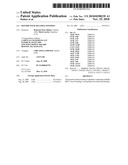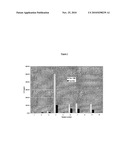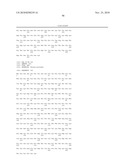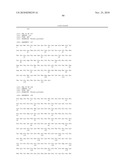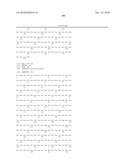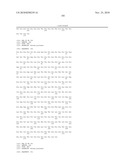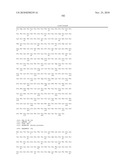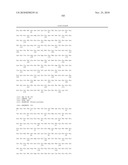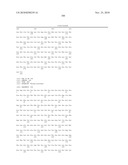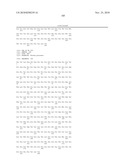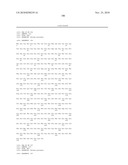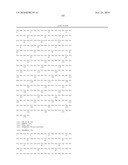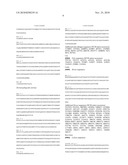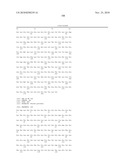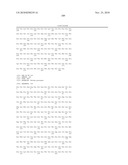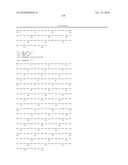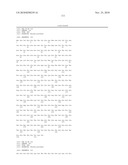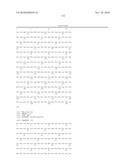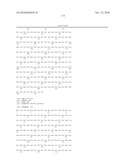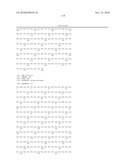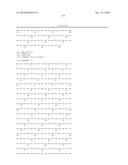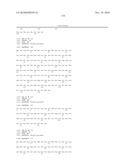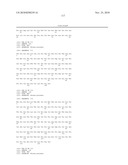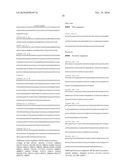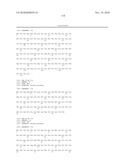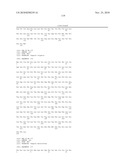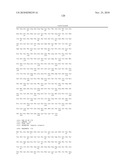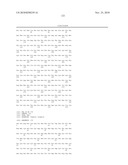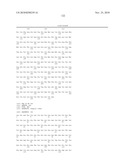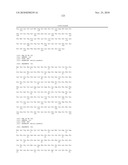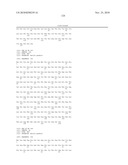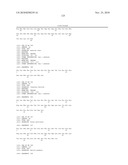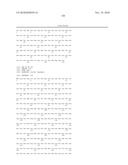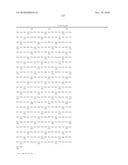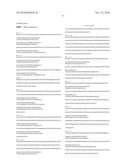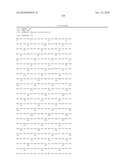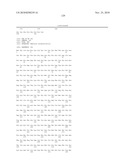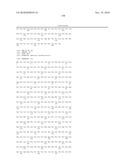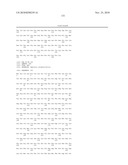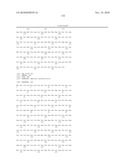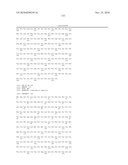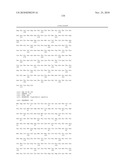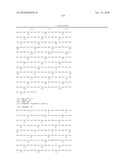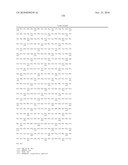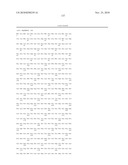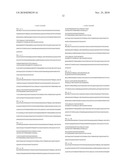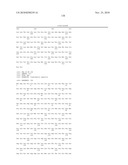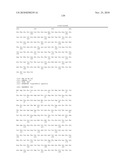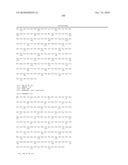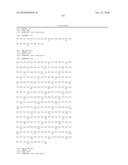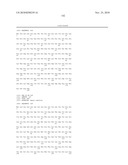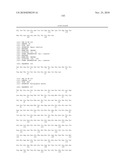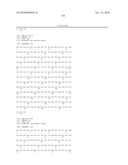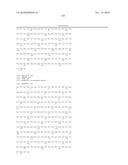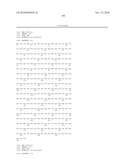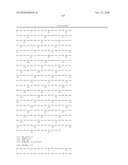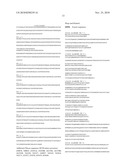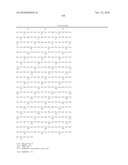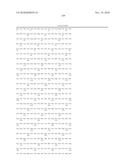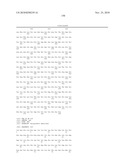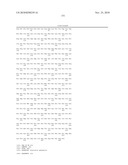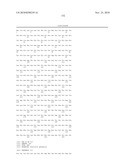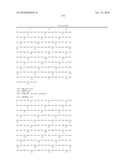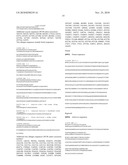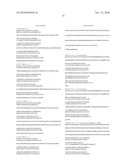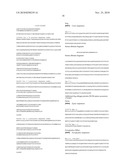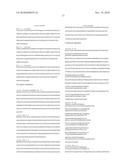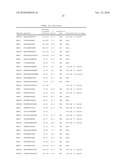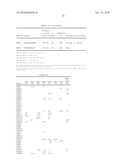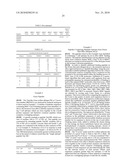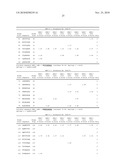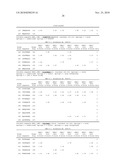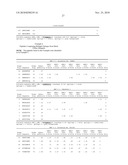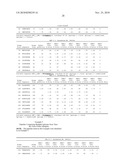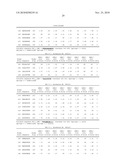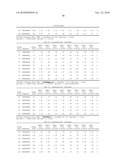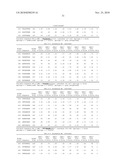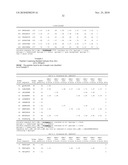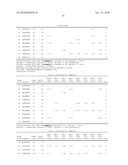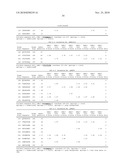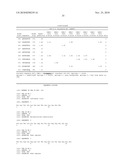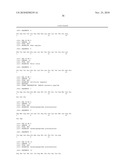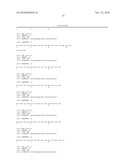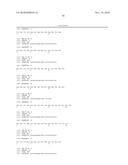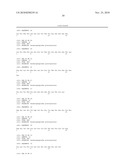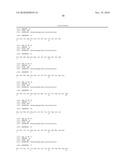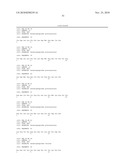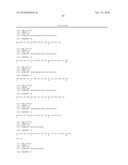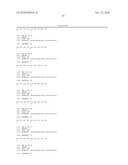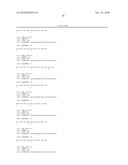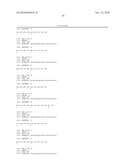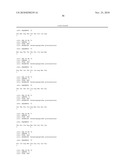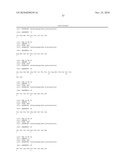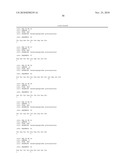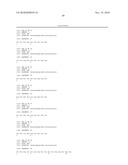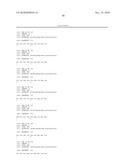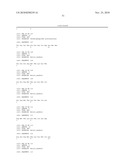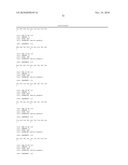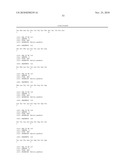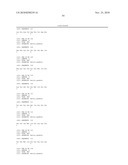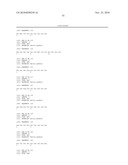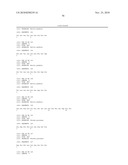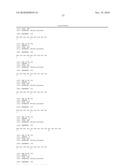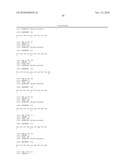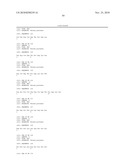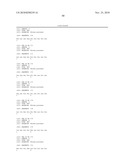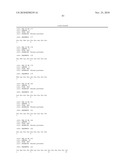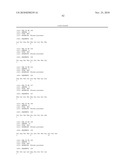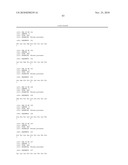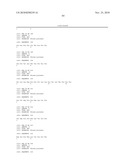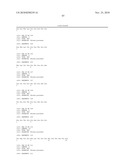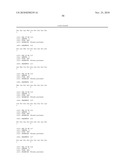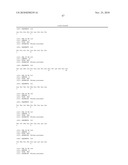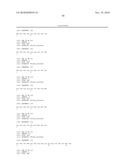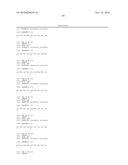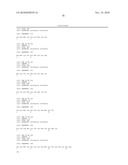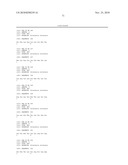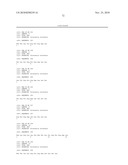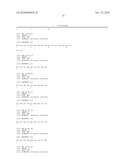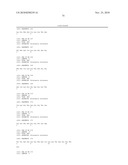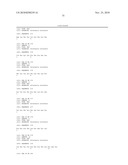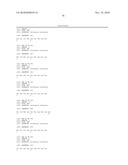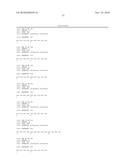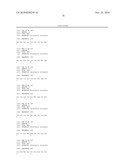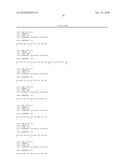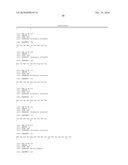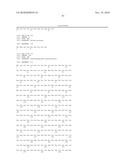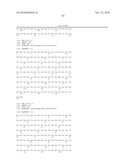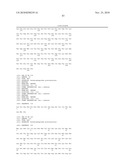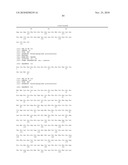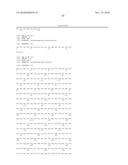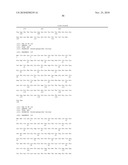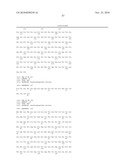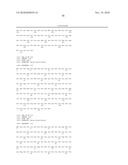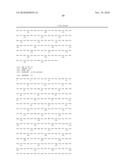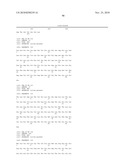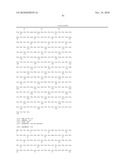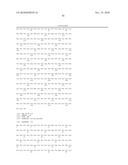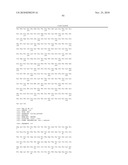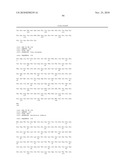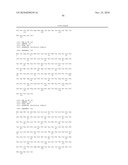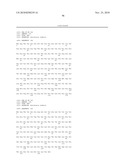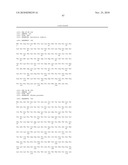Patent application title: PEPTIDE WITH MULTIPLE EPITOPES
Inventors:
Roderick Peter Hafner (Oxford, GB)
Roderick Peter Hafner (Oxford, GB)
Mark Larche (Hamilton, CA)
Mark Larche (Hamilton, CA)
Assignees:
CIRCASSIA LIMITED
IPC8 Class: AA61K3816FI
USPC Class:
514 213
Class name: Designated organic active ingredient containing (doai) peptide (e.g., protein, etc.) containing doai 25 to 99 amino acid residues in the peptide chain
Publication date: 2010-11-25
Patent application number: 20100298239
Claims:
1. A peptide which has a length of 10 to 25 amino acids, the peptide
comprising a region that comprises at least two different epitope
sequences, wherein the epitope sequences comprise at least 9 amino acids
and derive from an antigenic protein, and wherein each epitope sequence
binds to a different MHC molecule, and wherein the region is optionally
flanked at the N and/or C terminus by additional amino acids which are
not part of the epitope sequence.
2. A peptide according to claim 1, wherein:the region comprises the sequences of at least two different epitope sequences which overlap, such that 8, 7, 6, 5, 4, 3, 2 or 1 contiguous amino acids forming the N terminus of each epitope sequence after the most N terminal epitope sequence consist respectively of the 8, 7, 6, 5, 4, 3, 2 or 1 contiguous amino acids forming the C terminus of the epitope sequence immediately N terminal to each epitope sequence; and/or whereinthe region comprises the sequences of at least two different epitope sequences which overlap, such that 8, 7, 6, 5, 4, 3, 2 or 1 contiguous amino acids forming the C terminus of one epitope sequence consist respectively of the 8, 7, 6, 5, 4, 3, 2 or 1 contiguous amino acids forming the N terminus of the other epitope sequence.
3. A peptide according to claim 1, wherein the region comprises the sequences of at least two different epitope sequences separated by an additional amino acid sequence which is not comprised in the sequence of an epitope sequence, present between the C terminus of a first epitope sequence and the N terminus of a second epitope sequence, and wherein the additional amino acid sequence comprises less than 60% hydrophobic amino acids; and/or wherein the epitope sequences are T cell epitopes, optionally MHC Class II-binding T cell epitopes.
4. A peptide according to claim 2, wherein the region additionally comprises at least one further epitope sequence separated by an additional amino acid sequence which is not comprised in the sequence of an epitope sequence, present between the C terminus of a first epitope sequence and the N terminus of a second epitope sequence, and wherein the additional epitope sequence comprises less than 60% hydrophobic amino acids; and/or wherein the epitope sequence is a T cell epitope, optionally MHC Class II-binding T cell epitopes.
5. A peptide according to claim 1 comprising at least two epitope sequences which overlap, wherein the 6 contiguous amino acids forming the N terminus of each overlapping epitope after the most N terminal epitope consist of the 6 contiguous amino acids forming the C terminus of the epitope N terminal to each overlapping epitope.
6. A peptide according to claim 1 which has been engineered to be soluble and has a solubility of more than 3.5 mg/ml in an aqueous solution at a pH from 2.0 to 12.0, wherein the amino acids which flank the region are as follows:i) N terminal to the region: one to six contiguous amino acids that correspond to the one to six contiguous amino acids immediately N terminal to the region in the sequence of the native protein from which the region derives; and/orii) C terminal to the region: one to six contiguous amino acids corresponding to the one to six contiguous amino acids immediately C terminal to the region in the sequence of the protein from which the region derives; oriii) at both the N and C termini, at least one amino acid selected from arginine, lysine, histidine, glutamate and aspartate.
7. A peptide according to claim 6 wherein:i) one or more cysteine residues in the native sequence of the region are replaced with serine or 2-aminobutyric acid; and/orii) any hydrophobic residues in the upto three amino acids at the N or C terminus of the region, which are not comprised in the MHC class II-binding sequence of an epitope, are deleted; and/oriii) any two consecutive amino acids comprising the sequence Asp-Gly in the upto four amino acids at the N or C terminus of the region, which are not comprised in the MHC class II-binding sequence of an epitope, are deleted.
8. A peptide according to claim 1 where the peptide consists entirely of the region and/or wherein the peptide represents a fragment of a native protein comprising 5 or less substitutions compared to the corresponding sequence of the native protein.
9. A peptide according to claim 1 wherein the peptide does not comprise an epitope capable of cross-linking IgG expressed on the cell surface of B cells or IgE expressed on the surface of mast cells or basophils and/or wherein the region consists entirely of the minimal MHC Class II-binding sequences of the T cell epitopes.
10. A peptide according to claim 1 wherein the epitopes derive from:i) an allergen selected from: a plant allergen (particularly a grass allergen), animal dander allergens, a mold or fungal allergen, a dust allergen, an antibiotic or other drug, a stinging insect venom, an environmental allergen or a food allergen; orii) an antigen selected from the major antigens associated with Acute disseminated encephalomyelitis (ADEM); Addison's disease; Ankylosing spondylitis; Antiphospholipid antibody syndrome (APS); Aplastic anemia; Autoimmune hepatitis; Autoimmune Oophoritis; Coeliac disease; Crohn's disease; Diabetes mellitus type 1; Gestational pemphigoid; Goodpasture's syndrome; Graves' disease; Guillain-Barre syndrome (GBS); Hashimoto's disease; Idiopathic thrombocytopenic purpura; Kawasaki's Disease; Lupus erythematosus; Multiple sclerosis; Myasthenia gravis; Opsoclonus myoclonus syndrome (OMS); Optic neuritis; Ord's thyroiditis; Pemphigus; Pernicious anaemia; Polyarthritis in dogs; Primary biliary cirrhosis; Rheumatoid arthritis; Reiter's syndrome; Sjogren's syndrome; Takayasu's arteritis; Temporal arteritis (also known as "giant cell arteritis"); Warm autoimmune hemolytic anemia; or Wegener's granulomatosis.
11. A peptide according to claim 1 wherein the epitopes derive from: cat dander protein Fel d 1; House dust mite proteins Der P 1, Der P 2 and Der P 7; Ragweed protein amb a 1.1, a 1.2, a1.3 or a1.4; Rye grass proteins lol p1 and lol p5; Timothy grass proteins phi p1 and phi p5; Bermuda grass protein Cyn d 5; Alternaria alternate proteins Alt a 1, Alt a 2 and Enolase (Alt a 6); Birch protein Bet v1 and P14; German Cockroach proteins Bla g 1, Bla g 2, Bla g 3, Bla g 4, Bla g 5 and Bla g 6; Mugwort protein Art v 1; Russian thistle protein Sal k 1 and Sal k 2; peanut Ara h1, Ara h2, Ara h3, Ara h4, Ara h5, Ara h6, plant profilins or lipid transfer proteins or a human leukocyte antigen.
12. A peptide according to claim 1 which comprises or consists of the sequence of any of the following peptides: HDM01A; HDM207; Tim10B; HDM--1_Me1, 2, 3, 4, 5 or 6; BET--1_ME1, 2, 3, 4 or 5; Phl--1_ME1,2, 3 or 4; Phl--5_ME1, 2, 3, 4, 5 or 6; or HDM18_ME1 or 2; or a fragment or variant thereof.
13. A peptide according to claim 1 for use in tolerisation or for use in treating or preventing an allergic disease, an autoimmune disease, an alloimmune response or a maternal-foetal immune response by tolerisation or for use in tolerising an individual to a neoantigen or to a protein which is being provided to the individual in therapy.
14. The peptide according to claim 13 wherein the allergic disease or autoimmune disease comprises an immune response toi) an allergen selected from: a plant allergen (particularly a grass allergen), animal dander allergens, a mold or fungal allergen, a dust allergen, an antibiotic or other drug, a stinging insect venom, an environmental allergen or a food allergen; orii) an antigen selected from the major antigens associated with Acute disseminated encephalomyelitis (ADEM); Addison's disease; Ankylosing spondylitis; Antiphospholipid antibody syndrome (APS); Aplastic anemia; Autoimmune hepatitis; Autoimmune Oophoritis; Coeliac disease; Crohn's disease; Diabetes mellitus type 1; Gestational pemphigoid; Goodpasture's syndrome; Graves' disease; Guillain-Barre syndrome (GBS); Hashimoto's disease; Idiopathic thrombocytopenic purpura; Kawasaki's Disease; Lupus erythematosus; Multiple sclerosis; Myasthenia gravis; Opsoclonus myoclonus syndrome (OMS); Optic neuritis; Ord's thyroiditis; Pemphigus; Pernicious anaemia; Polyarthritis in dogs; Primary biliary cirrhosis; Rheumatoid arthritis; Reiter's syndrome; Sjogren's syndrome; Takayasu's arteritis; Temporal arteritis (also known as "giant cell arteritis"); Warm autoimmune hemolytic anemia; or Wegener's granulomatosis,or the alloimmune response is involved in transplant rejection or graft-versus-host disease, or the maternal-foetal immune response is Rhesus D Haemolytic Disease of the Newborn.
15. A peptide according to claim 1 for use in an in vitro method of diagnosing the presence or absence in a subject of a T-cell immune response to the protein from which the epitope derives, the method comprising: i) contacting the peptide with T cells in a sample taken from the subject, under conditions which allow the peptide and the T cells to interact; ii) determining whether or not any of the T cells are stimulated; and thereby determining whether or not a T-cell immune response is present or absent.
16. A peptide according to claim 15 wherein the T cells are present in a population of PBMCs isolated from a blood or serum sample taken from the subject.
17. A peptide according to claim 15 wherein step (ii) comprises measuring the production of interferon-gamma by the T cells.
18. A peptide according to claim 17 wherein the production of interferon-gamma is detected by an ELISPOT assay.
19. A nucleic acid sequence encoding the peptide according to claim 1, where the peptide is not the same as a fragment of the protein from which the T cell epitope sequences of claim 1 are derived.
20. A vector comprising the nucleic acid of claim 19.
21. The vector according to claim 20 for use in treating or preventing an allergic disease, an autoimmune disease, an alloimmune response or Rhesus D Haemolytic Disease of the Newborn by tolerisation.
22. The vector according to claim 21 wherein the allergic or autoimmune disease comprises an immune response toi) an allergen selected from: a plant allergen (particularly a grass allergen), animal dander allergens, a mold or fungal allergen, a dust allergen, an antibiotic or other drug, a stinging insect venom, an environmental allergen or a food allergen; orii) an antigen selected from the major antigens associated with Acute disseminated encephalomyelitis (ADEM); Addison's disease; Ankylosing spondylitis; Antiphospholipid antibody syndrome (APS); Aplastic anemia; Autoimmune hepatitis; Autoimmune Oophoritis; Coeliac disease; Crohn's disease; Diabetes mellitus type 1; Gestational pemphigoid; Goodpasture's syndrome; Graves' disease; Guillain-Barre syndrome (GBS); Hashimoto's disease; Idiopathic thrombocytopenic purpura; Kawasaki's Disease; Lupus erythematosus; Multiple sclerosis; Myasthenia gravis; Opsoclonus myoclonus syndrome (OMS); Optic neuritis; Ord's thyroiditis; Pemphigus; Pernicious anaemia; Polyarthritis in dogs; Primary biliary cirrhosis; Rheumatoid arthritis; Reiter's syndrome; Sjogren's syndrome; Takayasu's arteritis; Temporal arteritis (also known as "giant cell arteritis"); Warm autoimmune hemolytic anemia; or Wegener's granulomatosisor the alloimmune response is involved in transplant rejection or graft-versus-host disease.
23. An antibody which binds to the peptide according to claim 1.
24. An antibody which binds to the peptide according to claim 1 when the peptide is associated with an MHC Class II molecule.
25. A pharmaceutical composition comprising a peptide as defined in claim 1.
Description:
FIELD OF THE INVENTION
[0001]The present invention relates to peptides comprising multiple MHC Class II-binding T cell epitopes for tolerisation therapy.
BACKGROUND OF THE INVENTION
[0002]T-cell antigen recognition requires antigen presenting cells (APCs) to present antigen fragments (peptides) on their cell surface in association with molecules of the major histocompatibility complex (MHC). T cells use their antigen specific T-cell receptors (TCRs) to recognise with high specificity the antigen fragments presented by the APC. Such recognition acts as a trigger to the immune system to generate a range of responses to eradicate the antigen which has been recognized.
[0003]Most of the specificity of T cell recognition of the antigen fragments is provided by a smaller subsequence of amino acids within the fragments. This subsequence is known as the T cell epitope. In the case of extracellular allergens and auto- or allo-antigens, the peptides are presented on MHC Class II molecules, which are recognized by CD4 T cells. Accordingly, interest in allergic and auto- or allo-immune disorders has focused on MHC Class II-binding T cell epitopes.
[0004]Given their role in the immune system, there is considerable interest in such epitopes for use as therapeutic agents to modulate the immune systems of subjects. For example, administration of peptide epitopes to subjects has been demonstrated to result in the induction of tolerance to the antigen from which the epitope derives. Therapeutic agents based on such an effect have great potential in the prevention and treatment of allergy, and auto- or allo-immune diseases where the down-regulation of an immune response is desirable.
SUMMARY OF THE INVENTION
[0005]The minimal amino acid sequence of a T cell epitope required for binding to MHC Class II-molecules can be precisely identified and generally comprises approximately nine amino acids. An epitope sequence typically binds specifically to a particular class of MHC Class II molecule, and does not bind to other MHC Class II molecules. Accordingly, the efficacy of a given epitope sequence varies greatly depending on the MHC Class II type of the individual to whom it is administered. To utilise an epitope for, e.g. the induction of tolerance, it is therefore necessary to undertake time-consuming and costly steps to identify the MHC Class II type of the individual to be tolerised.
[0006]The present inventors have made the finding that by incorporating multiple different epitope sequences, it is possible to produce a peptide which binds to multiple different classes of MHC Class II and is therefore effective when administered to a wider range of individuals, reducing the requirement to identify the MHC Class II type of an individual. Two or more epitope sequences may be combined in a peptide in an overlapping configuration, or as two independent sequences separated by amino acids which are not comprised in either epitope, without producing a peptide large enough to possess significant tertiary structure that would enable it to retain the conformation of an IgG or IgE-cross-linking epitope. Consequently the downstream immune responses to antigen caused by such cross-linking do not occur.
[0007]Accordingly, the present invention provides:
[0008]a peptide which has a length of 10 to 25 amino acids, the peptide comprising a region that comprises at least two different MHC class II-binding T cell epitope sequences, wherein the epitope sequences comprise at least 9 amino acids and derive from an antigenic protein, and wherein each epitope sequence binds to a different MHC class II molecule, and wherein the region is optionally flanked at the N and/or C terminus by additional amino acids which are not part of the epitope sequence. The peptide is typically suitable for use in tolerisation therapy.
Polynucleotides, vectors and cells expressing the peptide of the invention, and methods of making the peptide of the invention are also provided.
DETAILED DESCRIPTION OF THE INVENTION
[0009]It is to be understood that references to inserting, deleting, replacing amino acids herein does not require the actual physical insertion, deletion or replacement of amino acids, and instead a peptide can be synthesized comprising sequence which represents (or is the end result of) the insertion, deletion or replacement having occurred.
Amino Acids
[0010]The table below shows the properties of amino acids.
TABLE-US-00001 Ala aliphatic, hydrophobic, neutral Cys polar, hydrophobic, neutral Asp polar, hydrophilic, charged (-) Glu polar, hydrophilic, charged (-) Phe aromatic, hydrophobic, neutral Gly aliphatic, neutral His aromatic, polar, hydrophilic, charged (+) Ile aliphatic, hydrophobic, neutral Lys polar, hydrophilic, charged(+) Leu aliphatic, hydrophobic, neutral Met hydrophobic, neutral Asn polar, hydrophilic, neutral Pro hydrophobic, neutral Gln polar, hydrophilic, neutral Arg polar, hydrophilic, charged (+) Ser polar, hydrophilic, neutral Thr polar, hydrophilic, neutral Val aliphatic, hydrophobic, neutral Trp aromatic, hydrophobic, neutral Tyr aromatic, polar, hydrophobic
MHC Class II-Binding T Cell Epitopes
[0011]The MHC Class II-binding T cell epitope comprised in the peptides of the invention is typically the minimal amino acid sequence that is capable of binding to Class II molecules and capable of stimulating T cells when presented in to T cells in association with Class II on the cell surface. The epitope is typically one that binds to a human MHC class II molecule.
[0012]An MHC Class II molecule consists of two proteins, α and β, each of which is encoded by a different gene. In humans, there are three clusters of genes encoding different α and β proteins. These are the Human Leukocyte Antigen (HLA) clusters, DR, DQ and DP. Each cluster comprises multiple different A genes encoding different variant of the αprotein and multiple different B genes encoding different variants of the β protein. The resulting MHC Class II heterodimers are therefore extremely diverse, and correspondingly so are the T cell epitopes that they bind.
[0013]The binding site of MHC Class II molecules is composed of two separate proteins which form a cleft. The cleft is open-ended, which in theory allows a peptide of any length to bind. However, only 9 amino acids can occupy the cleft itself. The identities of the up to 9 amino acids which occupy the cleft define whether or not a given peptide will bind to a given MHC Class II molecule and be available for presentation to T cells. These up to 9 amino acids therefore represent the minimal sequence that is required for MHC Class II-binding. It is generally assumed that such a sequence will be capable of stimulating T cells when presented to T cells in association with Class II on the cell surface. However, this may be confirmed experimentally by methods standard in the art.
[0014]Such methods may typically comprise contacting the epitope with T cells in a sample taken from a subject, under conditions which allow the epitope and the T cells to interact; and then determining whether or not any of the T cells are stimulated. Determining whether or not the T cells are stimulated may be achieved by any suitable method, for example by detecting the production of cytokines by the T cells, wherein cytokine production indicates that T cells have been stimulated. Suitable cytokines include interferon gamma and interleukin 13. Cytokine production may be detected by any suitable method, for example an ELISA, ELISPOT assay or a flow cytometric assay. Particularly preferred methods include Multiplex bead array assays as described in, for example de Jager et al; Clinical and Diagnostic Laboratory Immunology, 2003, Vol 10(1) p. 133-139 The T cells in a sample from a subject are typically present in a population of peripheral blood mononuclear cells (PBMCs) isolated from a blood or serum sample taken from the subject.
[0015]The MHC Class II-binding T cell epitope of the invention typically consists of 8 or 9 amino acids, but may consist of 7, 10, 11, 12, 13, 14, 15 or 16 amino acids. The amino acid sequence of the epitope may be broadly defined by further reference to the binding site of MHC Class II molecules. This binding site has specific binding pockets, which corresponding to primary and secondary anchor positions in the sequence of the binding peptide epitope. The binding pockets are defined by amino acid positions in the sequence of the MHC Class II molecule, and are generally not absolutely discriminatory for a specific amino acid in the epitope. Therefore the peptide binding specificity of any given MHC molecule is relatively broad. Thus, peptides binding to the same MHC allotype exhibit some degree of similarity, but there is no requirement for identity.
[0016]For the most common human MHC Class II type, HLA-DR, the key anchor positions for binding to the binding pockets are at positions 1, 4, 6, 7 and 9 of the peptide epitope (counting from the most N terminal residue occupying the cleft to the most C terminal). Different HLA-DR alleles which have similar amino acids in their binding pockets therefore typically bind peptides with similar amino acids at positions 1, 4, 6, 7 and 9. Accordingly, the region containing an MHC Class II binding T cell epitope preferably has amino acids at positions corresponding to positions 1, 4, 6, 7 and 9 that allow binding to the widest range of HLA-DR alleles. Examples of characteristic binding properties of different HLA-DR alleles are set out below:
[0017]DR alleles with Glycine at position 86 of the β chain show strong preferences for large hydrophobic side chains (Trp, Tyr, Phe) at peptide position 1, whereas Valine at position 86 restricts the pocket size and alters the preferences to small hydrophobic side chains (Val and Ala) at this position. Medium sized hydrophobic amino acids Leu and Ile are well accepted in all DR alleles.
[0018]DR alleles with Gln at position 70, Lysine at position 71, and Arginine or Gln at position 74 of the β chain have an overall positive charge within pocket 4, which requires negatively charged amino acids Asp and Glu at position 4 of the binding peptide (as in for example, DRB1*0301). DR alleles with this motif are associated with two autoimmune diseases: systematic lupus erythematosus and Hashimoto's thyroiditis.
[0019]DR alleles with Gln or Arg at position 70, Arg or Lys at position 71 and Glu or Ala at position 74 of the β chain bind similar peptides to those directly above since the only significant difference is at position 74. However, when Ala is present at position 74, pocket 4 increases in size and can accommodate larger amino acids such as Phe, Tip, and Ile (as in for example DRB1*0401, 04, 05). Alleles bearing Glu at position 74 are expected to allow small polar residues, like Ser and Thr at position 4 of the binding peptide. DR alleles with this motif are associated with a susceptibility to rheumatoid arthritis.
[0020]DR alleles with Asp at position 70, Glu or Arg at position 71, and Leu or Ala at position 74 of the β chain exclude peptides with negatively charged amino acids at peptide position 4 (for example DRB1*0402). This is due to the presence of Asp at position 70. DR alleles with this motif are associated with the autoimmune diseases Juvenile rheumatoid arthritis (JRA), pemphigus vulgaris, and allergic bronchopulmonary.
[0021]Polymorphisms at position 9 of the β chain define the size of binding pocket 9 in all DR alleles. Alleles with Trp at this position accept only small amino acids in position 9 of the binding peptide, e.g. Ala, Val, Gly, Ser, Thr, Pro (as in for example DRB1*0101 and *1501). Glu at position 9, in combination with Asp at position 57, makes pocket 9 negatively charged, facilitating the accommodation of positively charged amino acids, such as Lys (as in for example DRB1*0401 and *0404) and Histine (as in for example DRB1*0402). In most MHC class II alleles, Asp at position 57 makes a salt-bridged hydrogen bond with Arg at position 76, allowing the pocket to also accommodate aliphatic and polar amino acids. In cases where Asp at position 57 is replaced by Ser (for example DRB1*0405) or Ala (DQ8), the hydrogen bonding network is destroyed and Arg at position 76 can strongly attract negatively charged amino acids such as Asp or Glu at position 9 of the binding peptide (as in for example DRB1*0405).
[0022]An example of a preferred sequence for an epitope therefore has Trp, Tyr, Phe, Val or Ala at position 1; Asp, Glu, Ser or Thr at position 4; and Ala, Val, Gly, Ser, Thr, Pro at position 9. A further example of a preferred sequence for an epitope has a large aromatic or hydrophobic amino acid at position 1, for example Tyr, Phe, Trp, Leu, Ile or Val, and a small, non-charged amino acid at position 6, for example Ser, Thr, Ala, Pro, Val, Ile or Met. Approximately 87.5% of peptides binding to all or a combination of the MHC Class II molecules encoded by the DRB1*0101, *0401 and *0701 alleles contain this motif. Furthermore, since T cell epitopes derived from allergens and autoimmune antigens do not typically contain a large number of repeats of a given amino acid or amino acids, preferred epitopes of the invention typically comprise at least 5, 6, 7 or 8 different amino acids.
[0023]The precise amino sequence of an epitope may be predicted by computer-based algorithms and confirmed by in vitro biochemical analysis. Suitable commercially available algorithms include the EpiMatrix algorithm (EpiVax Inc.). Other algorithms are available at, for example http://www.imtech.res.in/raghava/propred/ and http://www.imtech.resin/raghava/mhc2pred/. Analysis with these algorithms typically comprises parsing a larger polypeptide sequence into multiple overlapping small peptides. The sequences of these small peptides are then analysed using the algorithm to identify those which are predicted to bind MHC Class II molecules. The overlapping small peptides are typically 9-mers.
[0024]The candidate peptides which score most highly in this analysis are then assessed for the ability to bind a panel of MHC Class II molecules encoded by different Class II alleles in vitro using standard binding assays. For example a competitive MHC class II binding assay may be used, wherein each peptide is analysed for its ability to displace a known control binder from each of the human MHC class II allotypes investigated. In such an assay each peptide is assigned an IC50 value (the concentration at which 50% inhibition of control peptide binding is achieved). The lower the IC50 the higher the affinity of a peptide for a given MHC class II allotype.
[0025]The epitope or epitopes in a polypeptide are taken to be those peptides which show the highest binding affinity to MHC Class II molecules. Particularly preferred epitopes show high affinity binding to different Class II molecules encoded by more than one preferably two, more preferably three, four or five MHC Class II alleles.
[0026]It will be appreciated that biochemical assays for the identification of a T cell epitope are not typically able to precisely define the position of the minimal epitope sequence within a larger sequence more accurately than to within approximately 12 amino acids, and more typically 15, 20 or more amino acids. The reason for this is that a large sequence must be physically fragmented into smaller overlapping peptides, or smaller overlapping peptides must be manufactured de novo prior to in vitro assessment of the ability of these peptides to bind MHC Class II molecules. The skilled person will recognise that the smaller the overlapping peptide fragments used, the more time-consuming and labour intensive is the process of manufacture. Hence epitopes are often identified as being contained within a larger polypeptide region. It is envisaged that the epitopes of the invention may be defined as such a larger region.
[0027]In all cases, it is envisaged that the epitope sequences of the invention also comprise functional variants of the epitope sequences. A functional variant epitope sequence is any homologous epitope sequence which is able to stimulate a T cell that specifically recognise the native epitope sequence from which the variant derives, or which is able to induce tolerance to the native epitope sequence in an individual. Such a variant typically has at least 55%, preferably 60%, 65%, 70%, 75%, 80%, 85%, 90%, 95% or 99% homology to the native epitope sequence. Suitable methods for determining the stimulatory effect of a variant epitope are known in the art. For example, a sample of peripheral blood mononuclear cells (PBMCs) can be stimulated with the protein from which the native epitope derives at various cell densities. After one week of culture, the T cell cultures are restimulated with autologous antigen presenting cells pulsed with peptides consisting of the native epitope sequence, which produces T cell lines specific for the native epitope sequence. The resulting lines can then be tested to see if they are stimulated by any variant epitope sequence, with stimulation being correlated with, e.g. proliferation or production of cytokines, in particular interferon-gamma, interleukin-13 and interleukin-17.
Regions Containing at Least Two MHC Class II-Binding T Cell Epitopes
[0028]As set out above, the bioinformatic techniques used to identify epitopes may identify multiple epitopes in the same polypeptide. Each of these multiple epitopes typically binds to different types of MHC Class II molecule. That is, a first epitope may bind Class II molecules encoded by alleles w, x, and y, whereas a second epitope binds Class II molecules encoded by alleles x, y and z. Since the region of the invention comprises at least two different epitope sequences, the peptides of the invention are capable of binding to a large number of different MHC Class II molecules.
[0029]The multiple different epitope sequences may be comprised in a region as two or more overlapping epitopes. For example, in a sequence of 12 amino acids, one epitope corresponds to amino acids 1 to 9 and a second epitope corresponds to amino acids 4 to 12. A peptide region comprising amino acids 1 to 12 will therefore comprise two overlapping epitope sequences since both epitopes comprise the contiguous sequence of amino acids 4 to 9.
[0030]The overlap of sequence between any two epitopes may typically comprise a contiguous sequence of upto approximately 10%, 20%, 30%, 40%, 50%, 60%, 65%, 70%, 80% or 90% of the amino acids from the N or C terminus either epitope. Therefore, assuming an epitope length of 9 amino acids, a second epitope may comprise the contiguous sequence of 1, 2, 3, 4, 5, 6, 7 or 8 amino acids at the N terminal of a first epitope, with additional amino acids present at the N terminus of this sequence which are not comprised in the first epitope, or may comprise the contiguous sequence of 1, 2, 3, 4, 5, 6, 7 or 8 amino acids at the C terminal of a first epitope, with additional amino acids present at the C terminus of this sequence which are not comprised in the first epitope.
[0031]A preferred overlap of sequence between any two epitopes typically comprises a contiguous sequence of upto approximately 65% of the amino acids from the N or C terminus either epitope. For an epitope length of 9 amino acids, a second epitope may therefore comprise the contiguous sequence of 6 amino acids at the N terminal of a first epitope, with additional amino acids present at the N terminus of this sequence which are not comprised in the first epitope, or may comprise the contiguous sequence of 6 amino acids at the C terminal of a first epitope, with additional amino acids present at the C terminus of this sequence which are not comprised in the first epitope.
[0032]Alternatively, the multiple epitopes in the region may be two or more independent sequences. The independent sequences may be consecutive or may be separated by additional amino acids which are not comprised in an epitope. As an example of the former case, in a sequence of 18 amino acids, one epitope corresponds to amino acids 1 to 9 and a second epitope corresponds to amino acids 10 to 18. As an example of the latter case, in a sequence of 19 amino acids, one epitope corresponds to amino acids 1 to 9 and a second epitope corresponds to amino acids 11 to 19. In this example, amino acid 10 is not comprised in either epitope. In general terms, two independent epitope sequences may typically be separated by 1, 2, 3, 4, 5, 6 or 7 additional amino acids which are not comprised in either epitope.
[0033]The amino acid sequence separating the epitope sequences ("the additional amino acid(s)") may comprise any amino acid sequence. It is particularly preferred that the additional amino acid(s) comprise a high proportion of hydrophilic amino acids (typically >60%) and comprise no cysteine residues.
[0034]In one preferred embodiment, the sequence of the additional amino acid(s) is identical to or homogolous to the sequence of the amino acid(s) which separates the epitope sequences in the native sequence of the protein from which the epitopes derive. If the additional amino acid(s) are homolgous to the native sequence, homology of greater than 55%, 60%, 75%, 80%, 85%, 90% or 95% with the native sequence is preferred. In an alternative embodiment, the sequence of the additional amino acid(s) is not related to the sequence of the amino acid(s) which separates the epitope sequences in the native sequence of the protein from which the epitopes derive. That is, the region may comprise a fusion protein comprising a first epitope, a sequence of additional amino acids, and at least a second epitope.
[0035]Alternatively the multiple epitopes may be present in the region as a combination of overlapping or independent epitope sequences.
[0036]It will be appreciated that the region may therefore consist entirely of amino acids which are comprised in at least one epitope. Typically, the proportion of amino acids in a region which are comprised in at least one epitope is approximately 70%, 71%, 72%, 73%, 74%, 75%, 80%, 85%, 90% or 95%, or 99%. Preferably, at least 70% of the amino acids in a region are comprised in at least one epitope.
[0037]The region therefore typically has a length of approximately 18 amino acids, but may be 10, 11, 12, 13, 14, 15, 16, 17, 18, 19, 20, 21, 22, 23, 24 or 25 amino acids in length.
Peptides
[0038]The peptides of the invention may consist entirely of the region as defined above. However, the peptides may optionally comprise additional amino acids flanking the N or C termini of the region. These amino acids are not comprised in an epitope. Typically, the proportion of amino acids in a peptide which are comprised in at least one epitope is approximately 70%, 71%, 72%, 73%, 74%, 75%, 80%, 85%, 90% or 95%, or 99%. Preferably, at least 70% of the amino acids in a peptide are comprised in at least one epitope.
[0039]The residues flanking the region typically result in the peptide having a solubility greater than 3.5 mg/ml in aqueous solution at pH 2.0 to 12.0, or pH 2.0 to 11.0, pH 2.0 to 10.0, pH 2.0 to 9.0, pH 2.0 to 8.0 or pH 2.0 to 7.0. The residues flanking the region are preferably:
[0040]at the N terminus, at least one, two, three, four, five or six contiguous amino acids corresponding to the at least one, two, three, four, five or six contiguous amino acids immediately N terminal to the region in the natural sequence of the protein from which the region derives; or
[0041]at the C terminus, at least one, two, three, four, five or six contiguous amino acids corresponding to the at least one, two, three, four, five or six contiguous amino acids immediately C terminal to the epitope sequence in the natural sequence of the protein from which the region derives; or
[0042]at both the N and C termini, at least one, preferably two, or three amino acids selected from arginine, lysine, histidine, glutamate and aspartate.
[0043]Further, the peptide may comprise the region as defined above, but incorporating modification of its native sequence. Particularly preferred modifications regions wherein:
[0044]any cysteine residues in the native sequence of the region are replaced with serine; and/or
[0045]any hydrophobic residues in the up to one, two, preferably three or four amino acids at the N or C terminus of the native sequence of the region which are not comprised in the epitope are deleted; and/or
[0046]any two consecutive amino acids comprising the sequence Asp-Gly in the up to three or preferably four amino acids at the N or C terminus of the native sequence of the region which are not comprised in the epitope are deleted.
[0047]The peptides of the invention typically contain from 10 to 25 amino acids, and may contain 11, 12, 13, 14, 15, 16, 17, 18, 19, 20, 21, 22, 23 or 24 amino acids. Peptides longer than 25 amino acids are likely to possess sufficient tertiary structure to cross-link IgG or IgE on cell surfaces resulting in undesirable immune responses such as B cell activation or mast cell degranulation. Peptides shorter than 10 amino acids are unlikely to contain more than one epitope.
Peptide Synthesis
[0048]The peptides of the invention are derived in an intellectual sense from the polypeptide which comprises the epitopes and regions as defined above with additional flanking residues or residues to separate independent epitope sequences. This is done by making use of the amino acid sequence of the region or epitope and synthesising peptides based on the sequence. Peptides may be synthesised using methods well known in the art. Preferred methods include solid-phase peptide synthesis techniques and most preferably preferably an automated or semiautomated peptide synthesizer. Typically, using such techniques, an α-N-carbamoyl protected amino acid and an amino acid attached to the growing peptide chain on a resin are coupled at room temperature in an inert solvent such as dimethylformamide, N-methylpyrrolidinone or methylene chloride in the presence of coupling agents such as dicyclohexylcarbodiimide and 1-hydroxybenzotriazole in the presence of a base such as diisopropyl-ethylamine. The α-N-carbamoyl protecting group is removed from the resulting peptide-resin using a reagent such as trifluoroacetic acid or piperidine, and the coupling reaction repeated with the next desired N-protected amino acid to be added to the peptide chain. Suitable N-protecting groups are well known in the art, and include t-butyloxycarbonyl (tBoc) and fluorenylmethoxycarbonyl (Fmoc).
[0049]The term "peptide" includes not only molecules in which amino acid residues are joined by peptide (--CO--NH--) linkages but also molecules in which the peptide bond is reversed. Such retro-inverso peptidomimetics may be made using methods known in the art, for example such as those described in Meziere et al (1997) J. Immunol. 159, 3230-3237. This approach involves making pseudopeptides containing changes involving the backbone, and not the orientation of side chains. Meziere et al (1997) show that, at least for MHC class II and T helper cell responses, these pseudopeptides are useful. Retro-inverse peptides, which contain NH--CO bonds instead of CO--NH peptide bonds, are much more resistant to proteolysis.
[0050]Similarly, the peptide bond may be dispensed with altogether provided that an appropriate linker moiety which retains the spacing between the carbon atoms of the amino acid residues is used; it is particularly preferred if the linker moiety has substantially the same charge distribution and substantially the same planarity as a peptide bond. It will also be appreciated that the peptide may conveniently be blocked at its N- or C-terminus so as to help reduce susceptibility to exoproteolytic digestion. For example, the N-terminal amino group of the peptides may be protected by reacting with a carboxylic acid and the C-terminal carboxyl group of the peptide may be protected by reacting with an amine. Other examples of modifications include glycosylation and phosphorylation. Another potential modification is that hydrogens on the side chain amines of R or K may be replaced with methylene groups (--NH2→--NH(Me) or --N(Me)2).
[0051]Analogues of peptides according to the invention may also include peptide variants that increase or decrease the peptide's half-life in vivo. Examples of analogues capable of increasing the half-life of peptides used according to the invention include peptoid analogues of the peptides, D-amino acid derivatives of the peptides, and peptide-peptoid hybrids. A further embodiment of the variant polypeptides used according to the invention comprises D-amino acid forms of the polypeptide. The preparation of polypeptides using D-amino acids rather than L-amino acids greatly decreases any unwanted breakdown of such an agent by normal metabolic processes, decreasing the amounts of agent which needs to be administered, along with the frequency of its administration.
Polynucleotides, Vectors and Cells
[0052]The terms "nucleic acid molecule" and "polynucleotide" are used interchangeably herein and refer to a polymeric form of nucleotides of any length, either deoxyribonucleotides or ribonucleotides, or analogs thereof. Non-limiting examples of polynucleotides include a gene, a gene fragment, messenger RNA (mRNA), cDNA, recombinant polynucleotides, plasmids, vectors, isolated DNA of any sequence, isolated RNA of any sequence, nucleic acid probes, and primers. A polynucleotide of the invention may be provided in isolated or purified form. A nucleic acid sequence which "encodes" a selected polypeptide is a nucleic acid molecule which is transcribed (in the case of DNA) and translated (in the case of mRNA) into a polypeptide in vivo when placed under the control of appropriate regulatory sequences. The boundaries of the coding sequence are determined by a start codon at the 5' (amino) terminus and a translation stop codon at the 3' (carboxy) terminus. For the purposes of the invention, such nucleic acid sequences can include, but are not limited to, cDNA from viral, prokaryotic or eukaryotic mRNA, genomic sequences from viral or prokaryotic DNA or RNA, and even synthetic DNA sequences. A transcription termination sequence may be located 3' to the coding sequence.
[0053]Polynucleotides of the invention can be synthesised according to methods well known in the art, as described by way of example in Sambrook et al (1989, Molecular Cloning--a laboratory manual; Cold Spring Harbor Press).
[0054]The polynucleotide molecules of the present invention may be provided in the form of an expression cassette which includes control sequences operably linked to the inserted sequence, thus allowing for expression of the peptide of the invention in vivo in a targeted subject. These expression cassettes, in turn, are typically provided within vectors (e.g., plasmids or recombinant viral vectors) which are suitable for use as reagents for nucleic acid immunization. Such an expression cassette may be administered directly to a host subject. Alternatively, a vector comprising a polynucleotide of the invention may be administered to a host subject. Preferably the polynucleotide is prepared and/or administered using a genetic vector. A suitable vector may be any vector which is capable of carrying a sufficient amount of genetic information, and allowing expression of a peptide of the invention.
[0055]The present invention thus includes expression vectors that comprise such polynucleotide sequences. Thus, the present invention provides a vector for use in preventing or treating allergy by tolerisation comprising four or more polynucleotide sequences which encode different polypeptides of the invention and optionally one or more further polynucleotide sequences which encode different polypeptides as defined herein. The vector may comprise 4, 5, 6 or 7 polynucleotide sequences which encode different polypeptides of the invention.
[0056]Furthermore, it will be appreciated that the compositions and products of the invention may comprise a mixture of polypeptides and polynucleotides. Accordingly, the invention provides a composition or product as defined herein, wherein in place of any one of the polypeptide is a polynucleotide capable of expressing said polypeptide.
[0057]Expression vectors are routinely constructed in the art of molecular biology and may for example involve the use of plasmid DNA and appropriate initiators, promoters, enhancers and other elements, such as for example polyadenylation signals which may be necessary, and which are positioned in the correct orientation, in order to allow for expression of a peptide of the invention. Other suitable vectors would be apparent to persons skilled in the art. By way of further example in this regard we refer to Sambrook et al.
[0058]Thus, a polypeptide of the invention may be provided by delivering such a vector to a cell and allowing transcription from the vector to occur. Preferably, a polynucleotide of the invention or for use in the invention in a vector is operably linked to a control sequence which is capable of providing for the expression of the coding sequence by the host cell, i.e. the vector is an expression vector.
[0059]"Operably linked" refers to an arrangement of elements wherein the components so described are configured so as to perform their usual function. Thus, a given regulatory sequence, such as a promoter, operably linked to a nucleic acid sequence is capable of effecting the expression of that sequence when the proper enzymes are present. The promoter need not be contiguous with the sequence, so long as it functions to direct the expression thereof. Thus, for example, intervening untranslated yet transcribed sequences can be present between the promoter sequence and the nucleic acid sequence and the promoter sequence can still be considered "operably linked" to the coding sequence.
[0060]A number of expression systems have been described in the art, each of which typically consists of a vector containing a gene or nucleotide sequence of interest operably linked to expression control sequences. These control sequences include transcriptional promoter sequences and transcriptional start and termination sequences. The vectors of the invention may be for example, plasmid, virus or phage vectors provided with an origin of replication, optionally a promoter for the expression of the said polynucleotide and optionally a regulator of the promoter. A "plasmid" is a vector in the form of an extrachromosomal genetic element. The vectors may contain one or more selectable marker genes, for example an ampicillin resistance gene in the case of a bacterial plasmid or a resistance gene for a fungal vector. Vectors may be used in vitro, for example for the production of DNA or RNA or used to transfect or transform a host cell, for example, a mammalian host cell. The vectors may also be adapted to be used in vivo, for example to allow in vivo expression of the polypeptide.
[0061]A "promoter" is a nucleotide sequence which initiates and regulates transcription of a polypeptide-encoding polynucleotide. Promoters can include inducible promoters (where expression of a polynucleotide sequence operably linked to the promoter is induced by an analyte, cofactor, regulatory protein, etc.), repressible promoters (where expression of a polynucleotide sequence operably linked to the promoter is repressed by an analyte, cofactor, regulatory protein, etc.), and constitutive promoters. It is intended that the term "promoter" or "control element" includes full-length promoter regions and functional (e.g., controls transcription or translation) segments of these regions.
[0062]A polynucleotide, expression cassette or vector according to the present invention may additionally comprise a signal peptide sequence. The signal peptide sequence is generally inserted in operable linkage with the promoter such that the signal peptide is expressed and facilitates secretion of a polypeptide encoded by coding sequence also in operable linkage with the promoter.
[0063]Typically a signal peptide sequence encodes a peptide of 10 to 30 amino acids for example 15 to 20 amino acids. Often the amino acids are predominantly hydrophobic. In a typical situation, a signal peptide targets a growing polypeptide chain bearing the signal peptide to the endoplasmic reticulum of the expressing cell. The signal peptide is cleaved off in the endoplasmic reticulum, allowing for secretion of the polypeptide via the Golgi apparatus. Thus, a peptide of the invention may be provided to an individual by expression from cells within the individual, and secretion from those cells.
[0064]Alternatively, polynucleotides of the invention may be expressed in a suitable manner to allow presentation of a peptide of the invention by an MHC class II molecule at the surface of an antigen presenting cell. For example, a polynucleotide, expression cassette or vector of the invention may be targeted to antigen presenting cells, or the expression of encoded peptide may be preferentially stimulated or induced in such cells.
[0065]In some embodiments, the polynucleotide, expression cassette or vector will encode an adjuvant, or an adjuvant will otherwise be provided. As used herein, the term "adjuvant" refers to any material or composition capable of specifically or non-specifically altering, enhancing, directing, redirecting, potentiating or initiating an antigen-specific immune response.
[0066]Polynucleotides of interest may be used in vitro, ex vivo or in vivo in the production of a peptide of the invention. Such polynucleotides may be administered or used in the prevention or treatment of allergy by tolerisation.
[0067]Methods for gene delivery are known in the art. See, e.g., U.S. Pat. Nos. 5,399,346, 5,580,859 and 5,589,466. The nucleic acid molecule can be introduced directly into the recipient subject, such as by standard intramuscular or intradermal injection; transdermal particle delivery; inhalation; topically, or by oral, intranasal or mucosal modes of administration. The molecule alternatively can be introduced ex vivo into cells that have been removed from a subject. For example, a polynucleotide, expression cassette or vector of the invention may be introduced into APCs of an individual ex vivo. Cells containing the nucleic acid molecule of interest are re-introduced into the subject such that an immune response can be mounted against the peptide encoded by the nucleic acid molecule. The nucleic acid molecules used in such immunization are generally referred to herein as "nucleic acid vaccines."
[0068]The polypeptides, polynucleotides, vectors or cells of the invention may be present in a substantially isolated form. They may be mixed with carriers or diluents which will not interfere with their intended use and still be regarded as substantially isolated. They may also be in a substantially purified form, in which case they will generally comprise at least 90%, e.g. at least 95%, 98% or 99%, of the proteins, polynucleotides, cells or dry mass of the preparation.
Formulations and Compositions
[0069]The peptides, polynucleotides, vectors and cells of the invention may be provided to an individual either singly or in combination. Each molecule or cell of the invention may be provided to an individual in an isolated, substantially isolated, purified or substantially purified form. For example, a peptide of the invention may be provided to an individual substantially free from the other peptides.
[0070]Whilst it may be possible for the peptides, polynucleotides or compositions according to the invention to be presented in raw form, it is preferable to present them as a pharmaceutical formulation. Thus, according to a further aspect of the invention, the present invention provides a pharmaceutical formulation for tolerising an individual to a protein from which a peptide of the invention derives, comprising a composition, vector or product according to the invention together with one or more pharmaceutically acceptable carriers or diluents and optionally one or more other therapeutic ingredients. The carrier (s) must be `acceptable` in the sense of being compatible with the other ingredients of the formulation and not deleterious to the recipient thereof. Typically, carriers for injection, and the final formulation, are sterile and pyrogen free. The high solubility of the peptide of the invention results in there being little or no requirement for the organic solvents usual in pharmaceutical compositions. Accordingly, the present invention provides a pharmaceutical formulation as defined above comprising less than 5% organic solvent. Subject to this limitation, formulation of a composition comprising the peptide, polynucleotide or cell of the invention can be carried out using standard pharmaceutical formulation chemistries and methodologies all of which are readily available to the reasonably skilled artisan.
[0071]For example, compositions containing one or more molecules or cells of the invention can be combined with one or more pharmaceutically acceptable excipients or vehicles. Auxiliary substances, such as wetting or emulsifying agents, pH buffering substances and the like, may be present in the excipient or vehicle. These excipients, vehicles and auxiliary substances are generally pharmaceutical agents that do not induce an immune response in the individual receiving the composition, and which may be administered without undue toxicity. Pharmaceutically acceptable excipients include, but are not limited to, liquids such as water, saline, polyethyleneglycol, hyaluronic acid, glycerol, and ethanol. Pharmaceutically acceptable salts can also be included therein, for example, mineral acid salts such as hydrochlorides, hydrobromides, phosphates, sulfates, and the like; and the salts of organic acids such as acetates, propionates, malonates, benzoates, and the like. A thorough discussion of pharmaceutically acceptable excipients, vehicles and auxiliary substances is available in Remington's Pharmaceutical Sciences (Mack Pub. Co., N.J. 1991).
[0072]Such compositions may be prepared, packaged, or sold in a form suitable for bolus administration or for continuous administration. Injectable compositions may be prepared, packaged, or sold in unit dosage form, such as in ampoules or in multi-dose containers containing a preservative. Compositions include, but are not limited to, suspensions, solutions, emulsions in oily or aqueous vehicles, pastes, and implantable sustained-release or biodegradable formulations. Such compositions may further comprise one or more additional ingredients including, but not limited to, suspending, stabilizing, or dispersing agents. In one embodiment of a composition for parenteral administration, the active ingredient is provided in dry (for e.g., a powder or granules) form for reconstitution with a suitable vehicle (e.g., sterile pyrogen-free water) prior to parenteral administration of the reconstituted composition. The pharmaceutical compositions may be prepared, packaged, or sold in the form of a sterile injectable aqueous or oily suspension or solution. This suspension or solution may be formulated according to the known art, and may comprise, in addition to the active ingredient, additional ingredients such as the dispersing agents, wetting agents, or suspending agents described herein. Such sterile injectable formulations may be prepared using a non-toxic parenterally-acceptable diluent or solvent, such as water or 1,3-butane diol, for example. Other acceptable diluents and solvents include, but are not limited to, Ringer's solution, isotonic sodium chloride solution, and fixed oils such as synthetic mono- or di-glycerides. Other parentally-administrable compositions which are useful include those which comprise the active ingredient in microcrystalline form, in a liposomal preparation, or as a component of a biodegradable polymer systems. Compositions for sustained release or implantation may comprise pharmaceutically acceptable polymeric or hydrophobic materials such as an emulsion, an ion exchange resin, a sparingly soluble polymer, or a sparingly soluble salt.
[0073]Alternatively, the peptides or polynucleotides of the present invention may be encapsulated, adsorbed to, or associated with, particulate carriers. Suitable particulate carriers include those derived from polymethyl methacrylate polymers, as well as PLG microparticles derived from poly(lactides) and poly(lactide-co-glycolides). See, e.g., Jeffery et al. (1993) Pharm. Res. 10:362-368. Other particulate systems and polymers can also be used, for example, polymers such as polylysine, polyarginine, polyornithine, spermine, spermidine, as well as conjugates of these molecules.
[0074]The formulation of any of the peptides, polynucleotides or cells mentioned herein will depend upon factors such as the nature of the substance and the method of delivery. Any such substance may be administered in a variety of dosage forms. It may be administered orally (e.g. as tablets, troches, lozenges, aqueous or oily suspensions, dispersible powders or granules), parenterally, subcutaneously, by inhalation, intravenously, intramuscularly, intrasternally, transdermally, intradermally, epicutaneously, sublingually, intranasally, buccally or by infusion techniques. The substance may also be administered as suppositories. A physician will be able to determine the required route of administration for each particular individual.
[0075]The compositions of formulations of the invention will comprise a suitable concentration of each peptide/polynucleotide/cell to be effective without causing adverse reaction. Typically, the concentration of each peptide in the composition will be in the range of 0.03 to 200 nmol/ml. More preferably in the range of 0.3 to 200 nmol/ml, 3 to 180 nmol/ml, 10 to 150 nmol/ml or 30 to 120 nmol/ml. Such concentrations are particularly favoured for intradermal administration since an effective dose may be administered in a volume of 60 μl, preferably 50 μl, and most preferably 30 μl. The composition or formulations should have a purity of greater than 95% or 98% or a purity of at least 99%.
[0076]A composition may therefore be formulated which comprises a molecule and/or cell of the invention and also one or more other therapeutic molecules. A composition of the invention may alternatively be used simultaneously, sequentially or separately with one or more other therapeutic compositions as part of a combined treatment.
Therapeutic Methods and Individual to be Treated
[0077]The present invention relates to peptides, polynucleotides, vectors and cells that are capable of desensitising or tolerising human individuals to proteins from which the peptides of the invention derive. Such proteins are typically allergens or other antigens to which an immune response is undesirable. Examples of such antigens include antigens associated with autoimmune diseases, antigens associated with graft-versus-host disease or transplant rejection (herein referred to as alloimmune conditions) and antigens associated with maternal-foetal immune responses, for example Rhesus D Haemolytic Disease of the Newborn. The peptides of the invention are therefore useful in the prevention or treatment an allergic disease, an autoimmune disease, an alloimmune condition or a maternal-foetal immune response. The invention provides compositions, products, vectors and formulations for use in preventing or treating the above conditions. The invention also provides a method of in preventing or treating a subject having the above conditions, comprising administering, either singly or in combination the polypeptides/polynucleotides/cells of the invention as described above.
[0078]The individual to be treated or provided with the composition or formulation of the invention is preferably human. It will be appreciated that the individual to be treated may be known to be sensitised to the particular allergen or antigen, at risk of being sensitised or suspected of being sensitised. The individual can be tested for sensitisation using techniques well known in the art and as described herein. Alternatively, the individual may have a family history of the conditions described above. It may not be necessary to test an individual for sensitisation to allergens because the individual may display symptoms of allergy when brought into proximity to a suitable allergen source. By proximity is meant 10 metres or less, 5 metres or less, 2 metres or less, 1 metre or less, or 0 metres from the source. Symptoms of allergy can include itchy eyes, runny nose, breathing difficulties, red itchy skin or rash. The individual to be treated may be of any age. However, preferably, the individual may be in the age group of 1 to 90, 5 to 60, 10 to 40, or more preferably 18 to 35. Preferably, the individual to be treated is from a population that has MHC allele frequencies within the range of frequencies that are representative of the Caucasian population. Reference population allele frequencies for 11 common DRB1 allele families are shown in Table 1 (Data from HLA Facts Book, Parham and Barber).
TABLE-US-00002 TABLE 1 DRB1 1 3 4 7 8 11 12 13 14 15 16 % 6.4 14.7 15.7 8.8 3.4 8.3 3.9 14.7 2.9 17.6 2.5 Reference 9.4 11.1 12.8 13.2 3.7 13.4 2.3 10.2 3.2 10.7 3.6 population %
Reference frequencies were obtained by analysis of multiple studies reporting frequencies and the figures shown are mean values. Preferably therefore, the individual to be treated is from a population that has equivalent MHC allele frequencies as the reference population for the alleles referred to Table 1 (such as for at least 1, 2, 3, 4, 5 or all of the alleles), for example within the ranges of those figures plus or minus 1, 2, 3, 5, 10, 15 or 20%.
[0079]Preferably the individual is from a population where the allele frequencies of the following DRB1 alleles is:
4--at least 9%7--at least 10%11--at least 8%.
[0080]The individual to be treated for allergic disease may have had allergy for at least 2 weeks, 1 month, 6 months, 1 year or 5 years. The individual may suffer from a rash, nasal congestion, nasal discharge and/or coughing caused by the allergy. The individual may or may not have been administered with other compositions/compounds which treat allergy.
Allergens and Antigens
[0081]Suitable allergens from which the region containing a MHC Class II-binding T cell epitope may derive can of course be obtained and/or produced using known methods. Classes of suitable allergens include, but are not limited to, pollens, animal dander (in particular cat dander), grasses, molds, dusts, antibiotics, stinging insect venoms, and a variety of environmental (including chemicals and metals), drug and food allergens. Common tree allergens include pollens from cottonwood, popular, ash, birch, maple, oak, elm, hickory, and pecan trees; common plant allergens include those from mugwort, ragweed, English plantain, sorrel-dock and pigweed; plant contact allergens include those from poison oak, poison ivy and nettles; common grass allergens include rye grass, Timothy, Johnson, Bermuda, fescue and bluegrass allergens; common allergens can also be obtained from molds or fungi such as Alternaria, Fusarium, Hormodendrum, Aspergillus, Micropolyspora, Mucor and thermophilic actinomycetes; epidermal allergens can be obtained from house or organic dusts (typically fungal in origin), from arthropods such as house mites (Dermatophagoides pteronyssinus), or from animal sources such as feathers, and dog dander; common food allergens include milk and cheese (diary), egg, wheat, nut (e.g., peanut), seafood (e.g., shellfish), pea, bean and gluten allergens; common environmental allergens include metals (nickel and gold), chemicals (formaldehyde, trinitrophenol and turpentine), Latex, rubber, fiber (cotton or wool), burlap, hair dye, cosmetic, detergent and perfume allergens; common drug allergens include local anesthetic and salicylate allergens; antibiotic allergens include penicillin, tetracycline and sulfonamide allergens; and common insect allergens include bee, wasp and ant venom, and cockroach calyx allergens. Particularly well characterized allergens include, but are not limited to, the major allergen produced by the domestic cat Felis catus (Felis domesticus) glycoprotein Fel d1, the major and cryptic epitopes of the Der p I allergen (Hoyne et al. (1994) Immunology 83190-195), bee venom phospholipase A2 (PLA) (Akdis et al. (1996) J. Clin. Invest. 98:1676-1683), birch pollen allergen Bet v 1 (Bauer et al. (1997) Clin. Exp. Immunol. 107:536-541), and the multi-epitopic recombinant grass allergen rKBG8.3 (Cao et al. (1997) Immunology 90:46-51). These and other suitable allergens are commercially available and/or can be readily prepared as extracts following known techniques.
[0082]Preferably, the allergen is selected from the list of allergen sequences and database accession numbers (NCBI Entrez accession numbers) below. NCBI is the National Center for Biotechnology information and is a division of the US National Institutes of Health. The NCBI web site, from which access to the database may be sought, is www.ncbi.nlm.nih.gov/. Allergen sequences and database accession numbers (NCBI Entrez accession numbers):
House Dust Mite
[0083]Dermatophagoides pteronyssinus
TABLE-US-00003 Der p 1 MKIVLAIASLLALSAVYARPSSIKTFEEYKKAFNKSYATFEDEEAARKNF LESVKYVQSNGGAINHLSDLSLDEFKNRFLMSAEAFEHLKTQFDLNAETN ACSINGNAPAEIDLRQMRTVTPIRMQGGCGSCWAFSGVAATESAYLAYRN QSLDLAEQELVDCASQHGCHGDTIPRGIEYIQHNGVVQESYYRYVAREQS CRRPNAQRFGISNYCQIYPPNVNKIREALAQTHSAIAVIIGIKDLDAFRH YDGRTIIQRDNGYQPNYHAVNIVGYSNAQGVDYWIVRNSWDTNWGDNGYG YFAANIDLMMIEEYPYVVIL Der p 2 MMYKILCLSLLVAAVARDQVDVKDCANHEIKKVLVPGCHGSEPCIIHRGK PFQLEAVFEANQNTKTAKIEIKASIDGLEVDVPGIDPNACHYMKCPLVKG QQYDIKYTWNVPKIAPKSENVVVTVKVMGDDGVLACAIATHAKIRD Der p 3 MIIYNILIVLLLAINTLANPILPASPNATIVGGEKALAGECPYQISLQSS SHFCGGTILDEYWILTAAHCVAGQTASKLSIRYNSLKHSLGGEKISVAKI FAHEKYDSYQIDNDIALIKLKSPMKLNQKNAKAVGLPAKGSDVKVGDQVR VSGWGYLEEGSYSLPSELRRVDIAVVSRKECNELYSKANAEVTDNMICGG DVANGGKDSCQGDSGGPVVDVKNNQVVGIVSWGYGCARKGYPGVYTRVGN FIDWIESKRSQ Der p 4 KYXNPHFIGXRSVITXLME Der p 5 MKFIIAFFVATLAVMTVSGEDKKHDYQNEFDFLLMERIHEQIKKGELALF YLQEQINHFEEKPTKEMKDKIVAEMDTIIAMIDGVRGVLDRLMQRKDLDI FEQYNLEMAKKSGDILERDLKKEEARVKKIEV Der p 6 AIGXQPAAEAEAPFQISLMK Der p 7 MMKLLLIAAAAFVAVSADPIHYDKITEEINKAVDEAVAAIEKSETFDPMK VPDHSDKFERHIGIIDLKGELDMRNIQVRGLKQMKRVGDANVKSEDGVVK AHLLVGVHDDVVSMEYDLAYKLGDLHPNTHVISDIQDFVVELSLEVSEEG NMTLTSFEVRQFANVVNHIGGLSILDPIFAVLSDVLTAIFQDTVRAEMTK VLAPAFKKELERNNQ Der p9 IVGGSNASPGDAVYQIAL
Dermatophagoides farinae
TABLE-US-00004 Der f 1 MKFVLAIASLLVLTVYARPASIKTFEFKKAFNKNYATVEEEEVARKNFLE SLKYVEANKGAINHLSDLSLDEFKNRYLMSAEAFEQLKTQFDLNAETSAC RINSVNVPSELDLRSLRTVTPIRMQGGCGSCWAFSGVAATESAYLAYRNT SLDLSEQELVDCASQHGCHGDTIPRGIEYIQQNGVVEERSYPYVAREQRC RRPNSQHYGISNYCQIYPPDVKQIREALTQTHTAIAVIIGIKDLRAFQHY DGRTIIQHDNGYQPNYHAVNIVGYGSTQGDDYWIVRNSWDTTWGDSGYGY FQAGNNLMMIEQYPYVVIM Der f 2 MISKILCLSLLVAAVVADQVDVKDCANNEIKKVMVDGCHGSDPCIIHRGK PFTLEALFDANQNTKTAKIEIKASLDGLEIDVPGIDTNACHFMKCPLVKG QQYDIKYTWNVPKIAPKSENVVVTVKLIGDNGVLACAIATHGKIRD Der f 3 MMILTIVVLLAANILATPILPSSPNATIVGGVKAQAGDCPYQISLQSSSH FCGGSILDEYWILTAAHCVNGQSAKKLSIRYNTLKHASGGEKIQVAEIYQ HENYDSMTIDNDVALIKLKTPMTLDQTNAKPVPLPAQGSDVKVGDKIRVS GWGYLQEGSYSLPSELQRVDIDVVSREQCDQLYSKAGADVSENMICGGDV ANGGVDSCQGDSGGPVVDVATKQIVGIVSWGYGCARKGYPGVYTRVGNFV DWIESKRSQ Der f 4 AVGGQDADLAEAPFQISLLK Der f 7 MMKFLLIAAVAFVAVSADPIHYDKITEEINKAIDDAIAAIEQSETIDPMK VPDHADKFERHVGIVDFKGELAMRNIEARGLKQMKRQGDANVKGEEGIVK AHLLIGVHDDIVSMEYDLAYKLGDLHPTTHVISDIQDFVVALSLEISDEG NITMTSFEVRQFANVVNHIGGLSILDPIFGVLSDVLTAIFQDTVRKEMTK VLAPAFKRELEKN
Additional mite allergen sequences (NCBI entrez accession):1170095; 1359436; 2440053; 666007; 487661; 1545803; 84702; 84699; 625532; 404370; 1091577; 1460058; 7413; 9072; 387592.
Cat
[0084]Felis sequences (NCBI entrez accession):539716; 539715; 423193; 423192; 423191; 423190; 1364213; 1364212; 395407; 163827; 163823; 163825; 1169665; 232086; 1169666.
Latex
[0085]Hevea sequences:
TABLE-US-00005 Hev b 1 MAEDEDNQQGQGEGLKYLGFVQDAATYAVTTFSNVYLFAKDKSGPLQPGV DIIEGPVKNVAVPLYNRFSYIPNGALKFVDSTVVASVTIIDRSLPPIVKD ASIQVVSAIRAAPEAARSLASSLPGQTKILAKVFYGEN Hev b 3 MAEEVEEERLKYLDFVRAAGVYAVDSFSTLYLYAKDISGPLKPGVDTIEN VVKTVVTPVYYIPLEAVKFVDKTVDVSVTSLDGVVPPVIKQVSAQTYSVA QDAPRIVLDVASSVFNTGVQEGAKALYANLEPKAEQYAVITWRALNKLPL VPQVANVVVPTAVYFSEKYNDVVRGTTEQGYRVSSYLPLLPTEKITKVFG DEAS
Additional Hevea sequences (NCBI entrez accession):3319923; 3319921; 3087805; 1493836; 1480457; 1223884; 3452147; 3451147; 1916805; 232267; 123335; 2501578; 3319662; 3288200; 1942537; 2392631; 2392630; 1421554; 1311006; 494093; 3183706; 3172534; 283243; 1170248; 1708278; 1706547; 464775; 266892; 231586; 123337; 116359; 123062; 2213877; 542013; 2144920; 1070656; 2129914; 2129913; 2129912; 100135; 82026; 1076559; 82028; 82027; 282933; 280399; 100138; 1086972; 108697; 1086976; 1086978; 1086978; 1086976; 1086974; 1086972; 913758; 913757; 913756; 234388; 1092500; 228691; 1177405; 18839; 18837; 18835; 18833; 18831; 1209317; 1184668; 168217; 168215; 168213; 168211; 168209; 348137.
Rye Grass
[0086]Lolium sequences:
TABLE-US-00006 126385 Lol p 1 MASSSSVLLVVALFAVFLGSAHGIAKVPPGPNITAEYGDKWLDAKSTWYG KPTGAGPKDNGGACGYKNVDKAPFNGMTGCGNTPIFKDGRGCGSCFEIKC TKPESCSGEAVTVTITDDNEEPIAPYHFDLSGHAFGSMAKKGEEQNVRSA GELELQFRRVKCKYPDDTKPTFHVEKASNPNYLAILVKYVDGDGDVVAVD IKEKGKDKWIELKESWGAVWRIDTPDKLTGPFTVRYTTEGGTKSEFEDVI PEGWKADTSYSAK 126386 Lol p 2a AAPVEFTVEKGSDEKNLALSIKYNKEGDSMAEVELKEHGSNEWLALKKNG DGVWEIKSDKPLKGPFNFRFVSEKGMRNVFDDVVPADFKVGTTYKPE 126387 Lol p 3 TKVDLTVEKGSDAKTLVLNIKYTRPGDTLAEVELRQHGSEEWEPMTKKGN LWEVKSAKPLTGPMNFRFLSKGGMKNVFDEVIPTAFTVGKTYTPEYN 2498581 Lol p 5a MAVQKYTVALFLRRGPRGGPGRSYAADAGYTPAAAATPATPAATPAGGWR EGDDRRAEAAGGRQRLASRQPWPPLPTPLRRTSSRSSRPPSPSPPRASSP TSAAKAPGLIPKLDTAYDVAYKAAEAHPRGQVRRLRHCPHRSLRVIAGAL EVHAVKPATEEVLAAKIPTGELQIVDKIDAAFKIAATAANAAPTNDKFTV FESAFNKALNECTGGAMRPTSSSPPSRPRSSRPTPPPSPAAPEVKYAVFE AALTKAITAMTQAQKAGKPAAAAATAAATVATAAATAAAVLPPPLLVVQS LISLLIYY 2498582 Lol p 5b MAVQKHTVALFLAVALVAGPAASYAADAGYAPATPATPAAPATAATPATP ATPATPAAVPSGKATTEEQKLIEKINAGFKAAVAAAAVVPPADKYKTFVE TFGTATNKAFVEGLASGYADQSKNQLTSKLDAALKLAYEAAQGATPEAKY DAYVATLTEALRVIAGTLEVHAVKPAAEEVKVGAIPAAEVQLIDKVDAAY RTAATAANAAPANDKFTVFENTFNNAIKVSLGAAYDSYKFIPTLVAAVKQ AYAAKQATAPEVKYTVSETALKKAVTAMSEAEKEATPAAAATATPTPAAA TATATPAAAYATATPAAATATATPAAATATPAAAGGYKV 455288 Lol p isoform 9 MAVQKHTVALFLAVALVAGPAASYAADAGYAPATPATPAAPATAATPATP ATPATPAAVPSGKATTEEQKLIEKINAGFKAAVAAAAVVPPADKYKTFVE TFGTATNKAFVEGLASGYADQSKNQLTSKLDAALKLAYEAAQGATPEAKY DAYVATLTEALRVIAGTLEVHAVKPAAEEVKVGAIPAAEVQLIDKVDAAY RTAATAANAAPANDKFTVFENTFNNAIKVSLGAAYDSYKFIPTLVAAVKQ AYAAKQATAPEVKYTVSETALKKAVTAMSEAEKEATPAAAATATPTPAAA TATATPAAAYATATPAAATATATPAAATATPAAAGGYKV 1582249 Lol p 11 DKGPGFVVTGRVYCDPCRAGFETNVSHNVEGATVAVDCRPFDGGESKLKA EATTDKDGWYKIEIDQDHQEEICEVVLAKSPDKSCSEIEEFRDRARVPLT SNXGIKQQGIRYANPIAFFRKEPLKECGGILQAY
Additional Lolium sequences (NCBI entrez accession):135480; 417103; 687261; 687259; 1771355; 2388662; 631955; 542131; 542130; 542129; 100636; 626029; 542132; 320616; 320615; 320614; 100638; 100634; 82450; 626028; 100639; 283345; 542133; 1771353; 1763163; 1040877; 1040875; 250525; 551047; 515377; 510911; 939932; 439950; 2718; 168316; 168314; 485371; 2388664; 2832717; 2828273; 548867.
Olive Tree
[0087]Olive sequences
TABLE-US-00007 416610 Ole e 1 EDIPQPPVSQFHIQGQVYCDTCRAGFITELSEFIPGASLRLQCKDKENGD VTFTEVGYTRAEGLYSMLVERDHKNEFCEITLISSGRKDCNEIPTEGWAK PSLKFKLNTVNGTTRTVNPLGFFKKEALPKCAQVYNKLGMYPPNM
Parietaria
[0088]Parietaria sequences:
TABLE-US-00008 2497750 Par j P2 MRTVSMAALVVIAAALAWTSSAEPAPAPAPGEEACGKVVQDIMPCLHFVK GEEKEPSKECCSGTKKLSEEVKTTEQKREACKCIVRATKGISGIKNELVA EVPKKCDIKTTLPPITADFDCSKIQSTIFRGYY 1352506 Par j P5 MVRALMPCLPFVQGKEKEPSKGCCSGAKRLDGETKTGPQRVHACECIQTA MKTYSDIDGKLVSEVPKHCGIVDSKLPPIDVNMDCKTVGVVPRQPQLPVS LRHGPVTGPSDPAHKARLERPQIRVPPPAPEKA 1532056 Par j P8 MRTVSMAALVVIAAALAWTSSAELASAPAPGEGPCGKVVHHIMPCLKFVK GEEKEPSKSCCSGTKKLSEEVKTTEQKREACKCIVAATKGISGIKNELVA EVPKKCGITTTLPPITADFDCSKIESTIFRGYY 1532058 Par j P9 MRTVSAPSAVALVVIVAAGLAWTSLASVAPPAPAPGSEETCGTVVRALMP CLPFVQGKEKEPSKGCCSGAKRLDGETKTGLQRVHACECIQTAMKTYSDI DGKLVSEVPKHCGIVDSKLPPIDVNMDCKTLGVVPRQPQLPVSLRHGPVT GPSDPAHKARLERPQIRVPPPAPEKA 2497749 Par j P9 MRTVSARSSVALVVIVAAVLVWTSSASVAPAPAPGSEETCGTVVGALMPC LPFVQGKEKEPSKGCCSGAKRLDGETKTGPQRVHACECIQTAMKTYSDID GKLVSEVPKHCGIVDSKLPPIDVNMDCKTLGVLHYKGN 1086003 Par j 1 MVRALMPCLPFVQGKEKEPSKGCCSGAKRLDGETKTGPQRVHACECIQTA MKTYSDIDGKLVSEVPKHCGIVDSKLPPIDVNMDCKTVGVVPRQPQLPVS LRHGPVTGPSRSRPPTKHGWRDPRLEFRPPHRKKPNPAFSTLG
Additional Parietaria sequences (NCBI entrez accession):543659; 1836011; 1836010; 1311513; 1311512; 1311511; 1311510; 1311509; 240971.
Timothy Grass
[0089]Phleum sequences:
TABLE-US-00009 Phl p 1 MASSSSVLLVVVLFAVFLGSAYGIPKVPPGPNITATYGDKWLDAKSTWYGK PTGAGPKDNGGACGYKDVDKPPFSGMTGCGNTPIFKSGRGCGSCFEIKCTKP EACSGEPVVVHITDDNEEPIAPYHFDLSGHAFGAMAKKGDEQKLRSAGELEL QFRRVKCKYPEGTKVTFHVEKGSNPNYLALLVKYVNGDGDVVAVDIKEKG KDKWIELKESWGAIWRIDTPDKLTGPFTVRYTTEGGTKTEAEDVIPEGWKADTSYESK Phl p 1 MASSSSVLLVVALFAVFLGSAHGIPKVPPGPNITATYGDKWLDAKSTWYGK PTAAGPKDNGGACGYKDVDKPPFSGMTGCGNTPIFKSGRGCGSCFEIKCTKP EACSGEPVVVHITDDNEEPIAAYHFDLSGIAFGSMAKKGDEQKLRSAGEVEI QFRRVKCKYPEGTKVTFHVEKGSNPNYLALLVKFSGDGDVVAVDIKEKGKD KWIALKESWGAIWRIDTPEVLKGPFTVRYTTEGGTKARAKDVIPEGWKADTAYESK Phlp 2 MSMASSSSSSLLAMAVLAALFAGAWCVPKVTFTVEKGSNEKHLAVLVKYE GDTMAEVELREHGSDEWVAMTKGEGGVWTFDSEEPLQGPFNFRFLTEKGM KNVFDDVVPEKYTIGATYAPEE Phl p 5 ADLGYGGPATPAAPAEAAPAGKATTEEQKLIEKINDGFKAALAAAAGVPPA DKYKTFVATFGAASNKAFAEGLSAEPKGAAESSSKAALTSKLDAAYKLAYK TAEGATPEAKYDAYVATLSEALRIIAGTLEVHAVKPAAEEVKVIPAGELQVIE KVDSAFKVAATAANAAPANDKFTVFEAAFNNAIKASTGGAYESYKFIPALEAA VKQAYAATVATAPEVKYTVFETALKKAFTAMSEAQKAAKPATEATATATAAVGAATGA ATAATGGYKV Phl p 5 ADLGYGGPATPAAPAEAAPAGKATTEEQKLIEKINDGFKAALAAAAGVPPA DKYKTFVATFGAASNKAFAEGLSAEPKGAAESSSKAALTSKLDAAYKLAYK TAEGATPEAKYDAYVATLSEALRIIAGTLEVHAVKPAAEEVKVIPAGELQVIE KVDSAFKVAATAANAAPANDKFTVFEAAFNNAIKASTGGAYESYKFIPALE AAVKQAYAATVATAPEVKYTVFETALKKAITAMSEAQKAAKPATEATATATAAVGAA TGAATAATGGYKV Phl p 5b AAAAVPRRGPRGGPGRSYTADAGYAPATPAAAGAAAGKATTEEQKLIEDIN VGFKAAVAAAASVPAADKFKTFEAAFTSSSKAAAAKAPGLVPKLDAAYSV AYKAAVGATPEAKFDSFVASLTEALRVIAGALEVHAVKPVTEEPGMAKIPA GELQIIDKIDAAFKVAATAAATAPADDKFTVFEAAFNKAIKESTGGAYDTYK CIPSLEAAVKQAYAATVAAAPQVKYAVFEAALTKAITAMSEVQKVSQPATG AATVAAGAATTAAGAASGAATVAAGGYKV Phl p 5a ADLGYGPATPAAPAAGYTPATPAAPAGADAAGKATTEEQKLIEKINAGFKA ALAGAGVQPADKYRTFVATFGPASNKAFAEGLSGEPKGAAESSSKAALTSK LDAAYKLAYKTAEGATPEAKYDAYVATLSEALRIIAGTLEVHAVKPAAEEV KVIPAGELQVIEKVDAAFKVAATAANAAPANDKFTVFEAAFNDEIKASTGG AYESYKFIPALEAAVKQAYAATVATAPEVKYTVFETALKKAITAMSEAQKA AKPAAAATATATAAVGAATGAATAATGGYKV Phl p 5 MAVQKYTVALFLAVALVAGPAASYAADAGYAPATPAAAGAEAGKATTEE QKLIEDINVGFKAAVAAAASVPAADKFKTFEAAFTSSSKAATAKAPGLVPKL DAAYSVSYKAAVGATPEAKFDSFVASLTEALRVIAGALEVHAVKPVTEEPG MAKIPAGELQIIDKIDAAFKVAATAAATAPADTVFEAAFNKAIKESTGGAYD TYKCIPSLEAAVKQAYAATVAAAPQVKYAVFEAALTKAITAMSEVQKVSQP ATGAATVAAGAATTAAGAASGAATVAAGGYKV Phl p 5 MAVQKYTVALFLAVALVAGPAASYAADAGYAPATPAAAGAEAGKATTEE QKLIEDINVGFKAAVAAAASVPAADKFKTFEAAFTSSSKAATAKAPGLVPKL DAAYSVAYKAAVGATPEAKFDSFVASLTEALRVIAGALEVHAVKPVTEDPA WPKIPAGELQIIDKIDAAFKVAATAAATAPADDKFTVFEAAFNKAIKESTGG AYDTYKCIPSLEAAVKQAYAATVAAAPQVKYAVFEAALTKAITAMSEVQK VSQPATGAATVAAGAATTATGAASGAATVAAGGYKV Phl p 5 ADAGYAPATPAAAGAEAGKATTEEQKLIEDINVGFKAAVAAAASVPAADKF KTFEAAFTSSSKAATAKAPGLVPKLDAAYSVAYKAAVGATPEAKFDSFVAS LTEALRVIAGALEVHAVKPVTEEPGMAKIPAGELQIIDKIDAAFKVAATAAA TAPADDKFTVFEAAFNKAIKESTGGAYDTYKCIPSLEAAVKQAYAATVAAA PQVKYAVFEAALTKAITAMSEVQKVSQPATGAATVAAGAATTAAGAASGA ATVAAGGYKV Phl p 5 SVKRSNGSAEVHRGAVPRRGPRGGPGRSYAADAGYAPATPAAAGAEAGKA TTEEQKLIEDINVGFKAAVAAAASVPAADKFKTFEAAFTSSSKAATAKAPGL VPKLDAAYSVAYKAAVGATPEAKFDSFVASLTEALRVIAGALEVHAVKPVT EEPGMAKIPAGELQIIDKIDAAFKVAATAAATAPADDKFTVFEAAFNKAIKES TGGAYDTYKCIPSLEAAVKQAYAATVAAAPQVKYAVFEAALTKAITAMSEV QKVSQPATGAATVAAGAATTAAGAASGAATVAAGGYKV Phl p 5 MAVHQYTVALFLAVALVAGPAGSYAADLGYGPATPAAPAAGYTPATPAAP AGAEPAGKATTEEQKLIEKINAGFKAALAAAAGVPPADKYRTFVATFGAAS NKAFAEGLSGEPKGAAESSSKAALTSKLDAAYKLAYKTAEGATPEAKYDAY VATVSEALRIIAGTLEVHAVKPAAEEVKVIPAGELQVIEKVDAAFKVAATAA NAAPANDKFTVFEAAFNDAIKASTGGAYESYKFIPALEAAVKQAYAATVAT APEVKYTVFETALKKAITAMSEAQKAAKPAAAATATATAAVGAATGAATA ATGGYKV Phl p 5 ADLGYGGPATPAAPAEAAPAGKATTEEQKLIEKINDGFKAALAAAAGVPPA DKYKTFVATFGAASNKAFAEGLSAEPKGAAESSSKAALTSKLDAAYKLAYK TAEGATPEAKYDAYVATLSEALRIIAGTLEVHAVKPAAEEVKVIPAGELQVIE KVDSAFKVAATAANAAPANDKFTVFEAAFNNAIKASTGGAYESYKFIPALE AAVKQAYAATVATAPEVKYTVFETALKKAFTAMSEAQKAAKPATEATATA TAAVGAATGAATAATGGYKV Phl p 5b AAAAVPRRGPRGGPGRSYTADAGYAPATPAAAGAAAGKATTEEQKLIEDIN VGFKAAVAAAASVPAADKFKTFEAAFTSSSKAAAAKAPGLVPKLDAAYSV AYKAAVGATPEAKFDSFVASLTEALRVIAGALEVHAVKPVTEEPGMAKIPA GELQIIDKIDAAFKVAATAAATAPADDKFTVFEAAFNKAIKESTGGAYDTYK CIPSLEAAVKQAYAATVAAAPQVKYAVFEAALTKAITAMSEVQKVSQPATG AATVAAGAATTAAGAASGAATVAAGGYKV Phl p 5a ADLGYGPATPAAPAAGYTPATPAAPAGADAAGKATTEEQKLIEKINAGFKA ALAGAGVQPADKYRTFVATFGPASNKAFAEGLSGEPKGAAESSSKAALTSK LDAAYKLAYKTAEGATPEAKYDAYVATLSEALRIIAGTLEVHAVKPAAEEV KVIPAGELQVIEKVDAAFKVAATAANAAPANDKFTVFEAAFNDEIKASTGG AYESYKFIPALEAAVKQAYAATVATAPEVKYTVFETALKKAITAMSEAQKA AKPAAAATATATAAVGAATGAATAATGGYKV Phl p 5 AVPRRGPRGGPGRSYAADAGYAPATPAAAGAEAGKATTEEQKLIEDINVGF KAAVAAAASVPAGDKFKTFEAAFTSSSKAATAKAPGLVPKLDAAYSVAYK AAVGATPEAKFDSFVASLTEALRVIAGALEVHAVKPVTEEPGMAKIPAGELQ IIDKIDAAFKVAATAAATAPADDKFTVFEAAFNKAIKESTGGAYDTYKCIPSL EAAVKQAYAATVAAAPQVKYAVFEAALTKAITAMSEVQKVSQPATGAATV AAGAATTATGAASGAATVAAGGYKV Phl p 5b MAVPRRGPRGGPGRSYTADAGYAPATPAAAGAAAGKATTEEQKLIEDINVG FKAAVAARQRPAADKFKTFEAASPRHPRPLRQGAGLVPKLDAAYSVAYKA AVGATPEAKFDSFVASLTEALRVIAGALEVHAVKPVTEEPGMAKIPAGELQII DKIDAAFKVAATAAATAPADDKFTVFEAAFNKAIKESTGGAYDTYKCIPSLE AAVKQAYAATVAAAAEVKYAVFEAALTKAITAMSEVQKVSQPATGAATVA AGAATTAAGAASGAATVAAGGYKV Phl p 5 MAVHQYTVALFLAVALVAGPAASYAADLGYGPATPAAPAAGYTPATPAAP AEAAPAGKATTEEQKLIEKINAGFKAALAAAAGVQPADKYRTFVATFGAAS NKAFAEGLSGEPKGAAESSSKAALTSKLDAAYKLAYKTAEGATPEAKYDAY VATLSEALRIIAGTLEVHAVKPAAEEVKVIPAGELQVIEKVDAAFKVAATAA NAAPANDKFTVFEAAFNDAIKASTGGAYESYKFIPALEAAVKQAYAATVAT APEVKYTVFETALKKAITAMSEAQKAAKPAAAATATATAAVGAATGAATA ATGGYKV Phl p 5 EAPAGKATTEEQKLIEKINAGFKAALARRLQPADKYRTFVATFGPASNKAFA EGLSGEPKGAAESSSKAALTSKLDAAYKLAYKTAEGATPEAKYDAYVATLS EALRIIAGTLEVHAVKPAAEEVKVIPAAELQVIEKVDAAFKVAATAANAAPA NDKFTVFEAAFNDEIKASTGGAYESYKFIPALEAAVKQAYAATVATAPEVK YTVFETALKKAITAMSEAQKAAKPPPLPPPPQPPPLAATGAATAATGGYKV Phl p 5 MAVHQYTVALFLAVALVAGPAASYAADLGYGPATPAAPAAGYTPATPAAP AEAAPAGKATTEEQKLIEKINAGFKAALAAAAGVQPADKYRTFVATFGAAS NKAFAEGLSGEPKGAAESSSKAALTSKLDAAYKLAYKTAEGATPEAKYDAY VATLSEALRIIAGTLEVHAVKPAAEEVKVIPAGELQVIEKVDAAFKVAATAA NAAPANDKFTVFEAAFNDAIKASTGGAYESYKFIPALEAAVKQAYAATVAT
APEVKYTVFETALKKAITAMSEAQKAAKPAAAATATATAAVGAATGAATA ATGGYKV Phl p 5b MAVPRRGPRGGPGRSYTADAGYAPATPAAAGAAAGKATTEEQKLIEDINVG FKAAVAARQRPAADKFKTFEAASPRHPRPLRQGAGLVPKLDAAYSVAYKA AVGATPEAKFDSFVASLTEALRVIAGALEVHAVKPVTEEPGMAKIPAGELQII DKIDAAFKVAATAAATAPADDKFTVFEAAFNKAIKESTGGAYDTYKCIPSLE AAVKQAYAATVAAAAEVKYAVFEAALTKAITAMSEVQKVSQPATGAATVA AGAATTAAGAASGAATVAAGGYKV Phl p 5a ADLGYGPATPAAPAAGYTPATPAAPAGADAAGKATTEEQKLIEKINAGFKA ALAGAGVQPADKYRTFVATFGPASNKAFAEGLSGEPKGAAESSSKAALTSK LDAAYKLAYKTAEGATPEAKYDAYVATLSEALRIIAGTLEVHAVKPAAEEV KVIPAGELQVIEKVDAAFKVAATAANAAPANDKFTVFEAAFNDEIKASTGG AYESYKFIPALEAAVKQAYAATVATAPEVKYTVFETALKKAITAMSEAQKA AKPPPLPPPPQPPPLAATGAATAATGGYKV Phl p 5 MAVHQYTVALFLAVALVAGPAASYAADLGYGPATPAAPAAGYTPATPAAP AEAAPAGKATTEEQKLIEKINAGFKAALAAAAGVQPADKYRTFVATFGAAS NKAFAEGLSGEPKGAAESSSKAALTSKLDAAYKLAYKTAEGATPEAKYDAY VATLSEALRIIAGTLEVHAVKPAAEEVKVIPAGELQVIEKVDAAFKVAATAA NAAPANDKFTVFEAAFNDAIKASTGGAYESYKFIPALEAAVKQAYAATVAT APEVKYTVFETALKKAITAMSEAQKAAKPAAAATATATAAVGAATGAATA ATGGYKV Phl p 6 MAAHKFMVAMFLAVAVVLGLATSPTAEGGKATTEEQKLIEDVNASFRAAM ATTANVPPADKYKTFEAAFTVSSKRNLADAVSKAPQLVPKLDEVYNAAYN AADHAAPEDKYEAFVLHFSEALRIIAGTPEVHAVKPGA Phl p 6 SKAPQLVPKLDEVYNAAYNAADHAAPEDKYEAFVLHFSEALHIIAGTPEVH AVKPGA Phl p 6 ADKYKTFEAAFTVSSKRNLADAVSKAPQLVPKLDEVYNAAYNAADHAAPE DKYEAFVLHFSEALHIIAGTPEVHAVKPGA Phl p 6 TEEQKLIEDVNASFRAAMATTANVPPADKYKTLEAAFTVSSKRNLADAVSK APQLVPKLDEVYNAAYNAADHAAPEDKYEAFVLHFSEALRIIAGTPEVHAV KPGA Phl p 6 MAAHKFMVAMFLAVAVVLGLATSPTAEGGKATTEEQKLIEDINASFRAAM ATTANVPPADKYKTFEAAFTVSSKRNLADAVSKAPQLVPKLDEVYNAAYN AADHAAPEDKYEAFVLHFSEALHIIAGTPEVHAVKPGA Phl p 6 MVAMFLAVAVVLGLATSPTAEGGKATTEEQKLIEDVNASFRAAMATTANV PPADKYKTFEAAFTVSSKRNLADAVSKAPQLVPKLDEVYNAAYNAADHAA PEDKYEAFVLHFSEALRIIAGTPEVHAVKPGA Phl p 7 MADDMERIFKRFDTNGDGKISLSELTDALRTLGSTSADEVQRMMAEIDTDG DGFIDFNEFISFCNANPGLMKDVAKVF Phl p 11 MSWQTYVDEHLMCEIEGHHLASAAILGHDGTVWAQSADFPQFKPEEITGIM KDFDEPGHLAPTGMFVAGAKYMVIQGEPGRVIRGKKGAGGITIKKTGQALV VGIYDEPMTPGQCNMVVERLGDYLVEQGM
Additional Phleum sequences (NCBI entrez accession):458878; 548863; 2529314; 2529308; 2415702; 2415700; 2415698; 542168; 542167; 626037; 542169; 541814; 542171; 253337; 253336; 453976; 439960.
Wasp (and Related)
[0090]Vespula sequences:
TABLE-US-00010 465054 ALLERGEN VES V 5 MEISGLVYLIIIVTIIDLPYGKANNYCKIKCLKGGVHTACKYGSLKPNCGNKV VVSYGLTKQEKQDILKEHNDFRQKIARGLETRGNPGPQPPAKNMKNLVWN DELAYVAQVWANQCQYGHDTCRDVAKYQVGQNVALTGSTAAKYDDPVK LVKMWEDEVKDYNPKKKFSGNDFLKTGHYTQMVWANTKEVGCGSIKYIQEKWHKHY LVCNYGPSGNFMNEELYQTK 1709545 ALLERGEN VES M 1 GPKCPFNSDTVSIIIETRENRNRDLYTLQTLQNHPEFKKKTITRPVVFITHGFTS SASEKNFINLAKALVDKDNYMVISIDWQTAACTNEYPGLKYAYYPTAASNT RLVGQYIATITQKLVKDYKISMANIRLIGHSLGAHVSGFAGKRVQELKLGKY SEIIGLDPARPSFDSNHCSERLCETDAEYVQIIHTSNYLGTEKILGTVDFYMNN GKNNPGCGRFFSEVCSHTRAVIYMAECIKHECCLIGIPRSKSSQPISRCTKQEC VCVGLNAKKYPSRGSFYVPVESTAPFCNNKGKII 1352699 ALLERGEN VES V 1 MEENMNLKYLLLFVYFVQVLNCCYGHGDPLSYELDRGPKCPFNSDTVSIIIE TRENRNRDLYTLQTLQNHPEFKKKTITRPVVFITHGFTSSASETNFINLAKAL VDKDNYMVISIDWQTAACTNEAAGLKYLYYPTAARNTRLVGQYIATITQKL VKHYKISMANIRLIGHSLGAHASGFAGKKVQELKLGKYSEIIGLDPARPSFDS NHCSERLCETDAEYVQIIHTSNYLGTEKTLGTVDFYMNNGKNQPGCGRFFSE VCSHSRAVIYMAECIKHECCLIGIPKSKSSQPISSCTKQECVCVGLNAKKYPSRGSFY VPVESTAPFCNNKGKII 1346323 ALLERGEN VES V 2 SERPKRVFNIYWNVPTFMCHQYDLYFDEVTNFNIKRNSKDDFQGDKIAIFYD PGEFPALLSLKDGKYKKRNGGVPQEGNITIHLQKFIENLDKIYPNRNFSGIGVI DFERWRPIFRQNWGNMKIHKNFSIDLVRNEHPTWNKKMIELEASKRFEKYA RFFMEETLKLAKKTRKQADWGYYGYPYCFNMSPNNLVPECDVTAMHEND KMSWLFNNQNVLLPSVYVRQELTPDQRIGLVQGRVKEAVRISNNLKHSPKV LSYWWYVYQDETNTFLTETDVKKTFQEIVINGGDGIIIWGSSSDVNSLSKCK RLQDYLLTVLGPIAINVTEAVN 549194 ALLERGEN VES VI 5KVNYCKIKCLKGGVHTACKYGTSTKPNCGKMVVKAYGLTEAEKQEILKV HNDFRQKVAKGLETRGNPGPQPPAKNMNNLVWNDELANIAQVWASQCNY GHDTCKDTEKYPVGQNIAKRSTTAALFDSPGKLVKMWENEVKDFNPNIEWS KNNLKKTGHYTQMVWAKTKEIGCGSVKYVKDEWYTHYLVCNYGPSGNFRNEKLYEKK
Additional vespula sequences (NCBI entrez accession):549193; 549192; 549191; 549190; 549189; 117414; 126761; 69576; 625255; 627189; 627188; 627187; 482382; 112561; 627186; 627185; 1923233; 897645; 897647; 745570; 225764; 162551.Tree allergen sequences (mainly birch) sequences:
TABLE-US-00011 114922 Bet v 1 MGVFNYETETTSVIPAARLFKAFILDGDNLFPKVAPQAISSVENIEGNGGPGTI KKISFPEGFPFKYVKDRVDEVDHTNFKYNYSVIEGGPIGDTLEKISNEIKIVAT PDGGSILKISNKYHTKGDHEVKAEQVKASKEMGETLLRAVESYLLAHSDAYN 130975 Bet v 2 MSWQTYVDEHLMCDIDGQASNSLASAIVGHDGSVWAQSSSFPQFKPQEITGI MKDFEEPGHLAPTGLHLGGIKYMVIQGEAGAVIRGKKGSGGITIKKTGQALV FGIYEEPVTPGQCNMVVERLGDYLIDQGL 1168696 Bet v 3 MPCSTEAMEKAGHGHASTPRKRSLSNSSFRLRSESLNTLRLRRIFDLFDKNSD GIITVDELSRALNLLGLETDLSELESTVKSFTREGNIGLQFEDFISLHQSLNDSY FAYGGEDEDDNEEDMRKSILSQEEADSFGGFKVFDEDGDGYISARELQMVL GKLGFSEGSEIDRVEKMIVSVDSNRDGRVDFFEFKDMMRSVLVRSS 809536 Bet v 4 MADDHPQDKAERERIFKRFDANGDGKISAAELGEALKTLGSITPDEVKHMM AEIDTDGDGFISFQEFTDFGRANRGLLKDVAKIF 543675 Que a I - Quercus alba = oak trees (fragment) GVFTXESQETSVIAPAXLFKALFL 543509 Car b I - Carpinus betulus = hornbeam trees (fragment) GVFNYEAETPSVIPAARLFKSYVLDGDKLIPKVAPQAIXK 543491 Aln g I - Alnus glutinosa = alder trees (fragment) GVFNYEAETPSVIPAARLFKAFILDGDKLLPKVAPEAVSSVENI 1204056 Rubisco VQCMQVWPPLGLKKFETLSYLPPLSSEQLAKEVDYLLRKNLIPCLEFELEHG FVYREHNRSPGYYDGRYWTMWKLPMFGCNDSSQVLKELEECKKAYPSAFI RIIGFDDK
Additional tree allergen sequences (NCBI entrez accession number):131919; 128193; 585564; 1942360; 2554672; 2392209; 2414158; 1321728; 1321726; 1321724; 1321722; 1321720; 1321718; 1321716; 1321714; 1321712; 3015520; 2935416; 464576; 1705843; 1168701; 1168710; 1168709; 1168708; 1168707; 1168706; 1168705; 1168704; 1168703; 1168702; 1842188; 2564228; 2564226; 2564224; 2564222; 2564220; 2051993; 1813891; 1536889; 534910; 534900; 534898; 1340000; 1339998; 2149808; 66207; 2129477; 1076249; 1076247; 629480; 481805; 81443; 1361968; 1361967; 1361966; 1361965; 1361964; 1361963; 1361962; 1361961; 1361960; 1361959; 320546; 629483; 629482; 629481; 541804; 320545; 81444; 541814; 629484; 474911; 452742; 1834387; 298737; 298736; 1584322; 1584321; 584320; 1542873; 1542871; 1542869; 1542867; 1542865; 1542863; 1542861; 1542859; 1542857; 1483232; 1483230; 1483228; 558561; 551640; 488605; 452746; 452744; 452740; 452738; 452736; 452734; 452732; 452730; 452728; 450885; 17938; 17927; 17925; 17921; 297538; 510951; 289331; 289329; 166953.
Peanut
[0091]Peanut sequences
TABLE-US-00012 1168391 Ara h 1 MRGRVSPLMLLLGILVLASVSATHAKSSPYQKKTENPCAQRCLQSCQQEP DDLKQKACESRCTKLEYDPRCVYDPRGHTGTTNQRSPPGERTRGRQPGDY DDDRRQPRREEGGRWGPAGPREREREEDWRQPREDWRRPSHQQPRKIRPE GREGEQEWGTPGSHVREETSRNNPFYFPSRRFSTRYGNQNGRIRVLQRFD QRSRQFQNLQNHRIVQIEAKPNTLVLPKHADADNILVIQQGQATVTVANG NNRKSFNLDEGHALRIPSGFISYILNRHDNQNLRVAKISMPVNTPGQFED FFPASSRDQSSYLQGFSRNTLEAAFNAEFNEIRRVLLEENAGGEQEERGQ RRWSTRSSENNEGVIVKVSKEHVEELTKHAKSVSKKGSEEEGDITNPIN LREGEPDLSNNFGKLFEVKPDKKNPQLQDLDMMLTCVEIKEGALMLPH FNSKAMVIVVVNKGTGNLELVAVRKEQQQRGRREEEEDEDEEEEGSNR EVRRYTARLKEGDVFIMPAAHPVAINASSELHLLGFGINAENNHRIFLAG DKDNVIDQIEKQAKDLAFPGSGEQVEKLIKNQKESHFVSARPQSQSQSP SSPEKESPEKEDQEEENQGGKGPLLSILKAFN
Ragweed
[0092]Ambrosia sequences
TABLE-US-00013 113478 Amb a 1 MGIKHCCYILYFTLALVTLLQPVRSAEDLQQILPSANETRSLTTCGTYNIIDGC WRGKADWAENRKALADCAQGFAKGTIGGKDGDIYTVTSELDDDVANPKEG TLRFGAAQNRPLWIIFARDMVIRLDRELAINNDKTIDGRGAKVEIINAGFAIY NVKNIIIHNIIMHDIVVNPGGLIKSHDGPPVPRKGSDGDAIGISGGSQIWIDHCS LSKAVDGLIDAKHGSTHFTVSNCLFTQHQYLLLFWDFDERGMLCTVAFNKF TDNVDQRMPNLRHGFVQVVNNNYERWGSYALGGSAGPTILSQGNRFLASDI KKEVVGRYGESAMSESINWNWRSYMDVFENGAIFVPSGVDPVLTPEQNAGMIPAEPG EAVLRLTSSAGVLSCQPGAPC 113479 Amb a 2 MGIKHCCYILYFTLALVTLVQAGRLGEEVDILPSPNDTRRSLQGCEAHNIIDK CWRCKPDWAENRQALGNCAQGFGKATHGGKWGDIYMVTSDQDDDVVNP KEGTLRFGATQDRPLWIIFQRDMIIYLQQEMVVTSDKTIDGRGAKVELVYGG ITLMNVKNVIIHNIDIHDVRVLPGGRIKSNGGPAIPRHQSDGDAIHVTGSSDIW IDHCTLSKSFDGLVDVNWGSTGVTISNCKFTHHEKAVLLGASDTHFQDLKM HVTLAYNIFTNTVHERMPRCRFGFFQIVNNFYDRWDKYAIGGSSNPTILSQG NKFVAPDFIYKKNVCLRTGAQEPEWMTWNWRTQNDVLENGAIFVASGSDPVLTAEQ NAGMMQAEPGDMVPQLTMNAGVLTCSPGAPC 113477 Amb a 1.3 MGIKQCCYILYFTLALVALLQPVRSAEGVGEILPSVNETRSLQACEALNIIDK CWRGKADWENNRQALADCAQGFAKGTYGGKWGDVYTVTSNLDDDVANP KEGTLRFAAAQNRPLWIIFKNDMVINLNQELVVNSDKTIDGRGVKVEIINGG LTLMNVKNIIIHNINIHDVKVLPGGMIKSNDGPPILRQASDGDTINVAGSSQIW IDHCSLSKSFDGLVDVTLGSTHVTISNCKFTQQSKAILLGADDTHVQDKGML ATVAFNMFTDNVDQRMPRCRFGFFQVVNNNYDRWGTYAIGGSSAPTILCQG NRFLAPDDQIKKNVLARTGTGAAESMAWNWRSDKDLLENGAIFVTSGSDPVLTPVQ SAGMIPAEPGEAAIKLTSSAGVFSCHPGAPC 1113476 Amb a 1.2 MGIKHCCYILYFTLALVTLLQPVRSAEDVEEFLPSANETRRSLKACEAHNIID KCWRCKADWANNRQALADCAQGFAKGTYGGKHGDVYTVTSDKDDDVAN PKEGTLRFAAAQNRPLWIIFKRNMVIHLNQELVVNSDKTIDGRGVKVNIVNA GLTLMNVKNIIIHNINIHDIKVCPGGMIKSNDGPPILRQQSDGDAINVAGSSQI WIDHCSLSKASDGLLDITLGSSHVTVSNCKFTQHQFVLLLGADDTHYQDKG MLATVAFNMFTDHVDQRMPRCRFGFFQVVNNNYDRWGTYAIGGSSAPTILS QGNRFFAPDDIIKKNVLARTGTGNAESMSWNWRTDRDLLENGAIFLPSGSDPVLTPEQ KAGMIPAEPGEAVLRLTSSAGVLSCHQGAPC 113475 Amb a 1.1 MGIKHCCYILYFTLALVTLLQPVRSAEDLQEILPVNETRRLTTSGAYNIIDGC WRGKADWAENRKALADCAQGFGKGTVGGKDGDIYTVTSELDDDVANPKE GTLRFGAAQNRPLWIIFERDMVIRLDKEMVVNSDKTIDGRGAKVEIINAGFT LNGVKNVIIHNINMHDVKVNPGGLIKSNDGPAAPRAGSDGDAISISGSSQIWI DHCSLSKSVDGLVDAKLGTTRLTVSNSLFTQHQFVLLFGAGDENIEDRGML ATVAFNTFTDNVDQRMPRCRHGFFQVVNNNYDKWGSYAIGGSASPTILSQG NRFCAPDERSKKNVLGRHGEAAAESMKWNWRTNKDVLENGAIFVASGVDP VLTPEQSAGMIPAEPGESALSLTSSAGVLSCQPGAPC
Cedar sequences
TABLE-US-00014 493634 Cry j IB precursor MDSPCLVALLVFSFVIGSCFSDNPIDSCWRGDSNWAQNRMKLADCAVGFGS STMGGKGGDLYTVTNSDDDPVNPPGTLRYGATRDRPLWIIFSGNMNIKLKM PMYIAGYKTFDGRGAQVYIGNGGPCVFIKRVSNVIIHGLYLYGCSTSVLGNV LINESFGVEPVHPQDGDALTLRTATNIWIDHNSFSNSSDGLVDVTLTSTGVTIS NNLFFNHHKVMSLGHDDAYSDDKSMKVTVAFNQFGPNCGQRMPRARYGL VHVANNNYDPWTIYAIGGSSNPTILSEGNSFTAPNESYKKQVTIRIGCKTSSSC SNWVWQSTQDVFYNGAYFVSSGKYEGGNIYTKKEAFNVENGNATPHLTQNAGVLTCSL SKRC 493634 Cry j IA precursor MDSPCLVALLVLSFVIGSCFSDNPIDSCWRGDSNWAQNRMKLADCAVGFGS STMGGKGGDLYTVTNSDDDPVNPAPGTLRYGATRDRPLWIIFSGNMNIKLK MPMYIAGYKTFDGRGAQVYIGNGGPCVFIKRVSNVIIHGLHLYGCSTSVLGN VLINESFGVEPVHPQDGDALTLRTATNIWIDHNSFSNSSDGLVDVTLSSTGVT ISNNLFFNHHKVMLLGHDDAYSDDKSMKVTVAFNQFGPNCGQRMPRARYG LVHVANNNYDPWTIYAIGGSSNPTILSEGNSFTAPNESYKKQVTIRIGCKTSSS CSNWVWQSTQDVFYNGAYFVSSGKYEGGNIYTKKEAFNVENGNATPQLTKNAGVLTC SLSKRC 1076242 Cry j II precursor-Japanese cedar MAMKLIAPMAFLAMQLIIMAAAEDQSAQIMLDSVVEKYLRSNRSLRKVEHS RHDAINIFNVEKYGAVGDGKHDCTEAFSTAWQAACKNPSAMLLVPGSKKF VVNNLFFNGPCQPHFTFKVDGIIAAYQNPASWKNNRIWLQFAKLTGFTLMG KGVIDGQGKQWWAGQCKWVNGREICNDRDRPTAIKFDFSTGLIIQGLKLMN SPEFHLVFGNCEGVKIIGISITAPRDSPNTDGIDIFASKNFHLQKNTIGTGDDCV AIGTGSSNIVIEDLICGPGHGISIGSLGRENSRAEVSYVHVNGAKFIDTQNGLRI KTWQGGSGMASHIIYENVEMINSENPILINQFYCTSASACQNQRSAVQIQDVT YKNIRGTSATAAAIQLKCSDSMPCKDIKLSDISLKLTSGKIASCLNDNANGYF SGHVIPACKNLSPSAKRKESKSHKHPKTVMVENMRAYDKGNRTRILLGSRPP NCTNKCHGCSPCKAKLVIVHRIMPQEYYPQRWICSCHGKIYHP 1076241 Cry j II protein-Japanese cedar MAMKFIAPMAFVAMQLIIMAAAEDQSAQIMLDSDIEQYLRSNRSLRKVEHS RHDAINIFNVEKYGAVGDGKHDCTEAFSTAWQAACKKPSAMLLVPGNKKF VVNNLFFNGPCQPHFTFKVDGIIAAYQNPASWKNNRIWLQFAKLTGFTLMG KGVIDGQGKQWWAGQCKWVNGREICNDRDRPTAIKFDFSTGLIIQGLKLMN SPEFHLVFGNCEGVKIIGISITAPRDSPNTDGIDIFASKNFHLQKNTIGTGDDCV AIGTGSSNIVIEDLICGPGHGISIGSLGRENSRAEVSYVHVNGAKFIDTQNGLRI KTWQGGSGMASHIIYENVEMINSENPILINQFYCTSASACQNQRSAVQIQDVT YKNIRGTSATAAAIQLKCSDSMPCKDIKLSDISLKLTSGKIASCLNDNANGYF SGHVIPACKNLSPSAKRKESKSHKHPKTVMVKNMGAYDKGNRTRILLGSRP PNCTNKCHGCSPCKAKLVIVHRIMPQEYYPQRWMCSRHGKIYHP 541803 Cry j I precursor-Japanese cedar MDSPCLVALLVLSFVIGSCFSDNPIDSCWRGDSNWAQNRMKLADCAVGFGS STMGGKGGDLYTVTNSDDDPVNPPGTLRYGATRDRPLWIIFSGNMNIKLKM PMYIAGYKTFDGRGAQVYIGNGGPCVFIKRVSNVIIHGLHLYGCSTSVLGNV LINESFGVEPVHPQDGDALTLRTATNIWIDHNSFSNSSDGLVDVTLSSTGVTIS NNLFFNHHKVMLLGHDDAYSDDKSMKVTVAFNQFGPNCGQRMPRARYGL VHVANNNYDPWTIYAIGGSSNPTILSEGNSFTAPNESYKKQVTIRIGCKTSSSC SNWVWQSTQDVFYNGAYFVSSGKYEGGNIYTKKEAFNVENGNATPQLTKNAGVLTC SLSKRC 541802 Cry j I precursor-Japanese cedar MDSPCLVALLVFSFVIGSCFSDNPIDSCWRGDSNWAQNRMKLADCAVGFGS STMGGKGGDLYTVTNSDDDPVNPAPGTLRYGATRDRPLWIIFSGNMNIKLK MPMYIAGYKTFDGRGAQVYIGNGGPCVFIKRVSNVIIHGLYLYGCSTSVLGN VLINESFGVEPVHPQDGDALTLRTATNIWIDHNSFSNSSDGLVDVTLTSTGVT ISNNLFFNHHKVMSLGHDDAYSDDKSMKVTVAFNQFGPNCGQRMPRARYG LVHVANNNYDPWTIYAIGGSSNPTILSEGNSFTAPNESYKKQVTIRIGCKTSSS CSNWVWQSTQDVFYNGAYFVSSGKYEGGNIYTKKEAFNVENGNATPHLTQNAGVLTC SLSKRC
Dog
[0093]Canis sequences:
TABLE-US-00015 Can f 1 MKTLLLTIGFSLIAILQAQDTPALGKDTVAVSGKWYLKAMTADQEVPEKP DSVTPMILKAQKGGNLEAKITMLTNGQCQNITVVLHKTSEPGKYTAYEGQ RVVFIQPSPVRDHYILYCEGELHGRQIRMAKLLGRDPEQSQEALEDFREF SRAKGLNQEILELAQSETCSPGGQ
Serum albumin fragment
TABLE-US-00016 EAYKSEIAHRYNDLGEEHFRGLVL
Serum albumin fragment
TABLE-US-00017 LSSAKERFKCASLQKFGDRAFKAWSVARLSQRFPKADFAEISKVVTDLTK VHKECCHGDLLECADDRADLAKYMCENQDSISTKLKECCDKPVLEKSQCL AEVERDELPGDLPSLAADFVEDKEVCKNYQEAKDVFLGTFLYEYSRRHPE YSVSLLLRLAKEYEATLEKCCATDDPPTCYAKVLDEFKPLVDEPQNLVKT NCELFEKLGEYGFQNALLVRYTKKAPQVSTPTLVVEVSRKLGKVGTKCCK KPESERMSCADDFLS Can f 2 MQLLLLTVGLALICGLQAQEGNHEEPQGGLEELSGRWHSVALASNKSDLI KPWGHFRVFIHSMSAKDGNLHGDILIPQDGQCEKVSLTAFKTATSNKFDL EYWGHNDLYLAEVDPKSYLILYMINQYNDDTSLVAHLMVRDLSRQQDFLP AFESVCEDIGLHKDQIVVLSDDDRCQGSRD
Additional dog allergen protein (NCBI entrez accession):1731859
Horse
[0094]Equus sequences:
TABLE-US-00018 1575778 Equ c1 MKLLLLCLGLILVCAQQEENSDVAIRNFDISKISGEWYSIFLASDVKEKI EENGSMRVFVDVIRALDNSSLYAEYQTKVNGECTEFPMVFDKTEEDGVYS LNYDGYNVFRISEFENDEHIILYLVNFDKDRPFQLFEFYAREPDVSPEIK EEFVKIVQKRGIVKENIIDLTKIDRCFQLRGNGVAQA 3121755 Equ c 2 SQXPQSETDYSQLSGEWNTIYGAASNIXK
Euroglyphus (Mite)
[0095]Euroglyphus sequences:
TABLE-US-00019 Eur m 1 (variant) TYACSINSVSLPSELDLRSLRTVTPIRMQGGCGSCWAFSGVASTESAYLA YRNMSLDLAEQELVDCASQNGCHGDTIPRGIEYIQQNGVVQEHYYPYVAR EQSCHRPNAQRYGLKNYCQISPPDSNKIRQALTQTHTAVAVIIGIKDLNA FRHYDGRTIMQHDNGYQPNYHAVNIVGYGNTQGVDYWIVRNSWDTTW GDNGYGYFAANINL Eur m 1 (variant) TYACSINSVSLPSELDLRSLRTVTPIRMQGGCGSCWAFSGVASTESAYLA YRNMSLDLAEQELVDCASQNGCHGDTIPRGIEYIQQNGVVQEHYYPYVAR EQSCHRPNAQRYGLKNYCQISPPDSNKIRQALTQTHTAVAVIIGIKDLNA FRHYDGRTIMQHDNGYQPNYHAVNIVGYGNTQGVDYWIVRNSWDTTWG DNGYGYFAANINL Eur m 1 (variant) ETNACSINGNAPAEIDLRQMRTVTPIRMQGGCGSCWAFSGVAATESAYLA YRNQSLDLAEQELVDCASQHGCHGDTIPRGIEYIQHNGVVQESYYRYVAR EQSCRRPNAQRFGISNYCQIYPPNANKIREALAQTHSAIAVIIGIKDLDA FRHYDGRTIIQRDNGYQPNYHAVNIVGYSNAQGVDYWIVRNSWDTNW GDNGYGYFAANIDL Eur m 1 (variant) ETSACRINSVNVPSELDLRSLRTVTPIRMQGGCGSCWAFSGVAATESAYL AYRNTSLDLSEQELVDCASQHGCHGDTIPRGIEYIQQNGVVEERSYPYVA REQQCRRPNSQHYGISNYCQIYPPDVKQIREALTQTHTAIAVIIGIKDLR AFQHYDGRTIIQHDNGYQPNYHAVNIVGYGSTQGVDYWIVRNSWDTT WGDSGYGYFQAGNNL
Poa (grass) sequences
TABLE-US-00020 113562 POLLEN ALLERGEN POA P 9 MAVQKYTVALFLVALVVGPAASYAADLSYGAPATPAAPAAGYTPAAPAGA APKATTDEQKMIEKINVGFKAAVAAAGGVPAANKYKTFVATFGAASNKAF AEALSTEPKGAAVDSSKAALTSKLDAAYKLAYKSAEGATPEAKYDDYVAT LSEALRIIAGTLEVHGVKPAAEEVKATPAGELQVIDKVDAAFKVAATAAN AAPANDKFTVFEAAFNDAIKASTGGAYQSYKFIPALEAAVKQSYAATVAT APAVKYTVFETALKKAITAMSQAQKAAKPAAAATGTATAAVGAATGAATA AAGGYKV 113561 POA P 9 MAVHQYTVALFLAVALVAGPAASYAADVGYGAPATLATPATPAAPAAGYT PAAPAGAAPKATTDEQKLIEKINAGFKAAVAAAAGVPAVDKYKTFVATFG TASNKAFAEALSTEPKGAAAASSNAVLTSKLDAAYKLAYKSAEGATPEAK YDAYVATLSEALRIIAGTLEVHAVKPAGEEVKAIPAGELQVIDKVDAAFK VAATAANAAPANDKFTVFEAAFNDAIKASTGGAYQSYKFIPALEAAVKQS YAATVATAPAVKYTVFETALKKAITAMSQAQKAAKPAAAVTATATGAVG AATGAVGAATGAATAAAGGYKTGAATPTAGGYKV 113560 POA P 9 MDKANGAYKTALKAASAVAPAEKFPVFQATFDKNLKEGLSGPDAVGFAKK LDAFIQTSYLSTKAAEPKEKFDLFVLSLTEVLRFMAGAVKAPPASKFPAK PAPKVAAYTPAAPAGAAPKATTDEQKLIEKINVGFKAAVAAAAGVPAASK YKTFVATFGAASNKAFAEALSTEPKGAAVASSKAVLTSKLDAAYKLAYKS AEGATPEAKYDAYVATLSEALRIIAGTLEVHGVKPAAEEVKAIPAGELQV IDKVDAAFKVAATAANAAPANDKFTVFEAAFNDAIKASTGGAYQSYKFI PALEAAVKQSYAATVATAPAVKYTVFETALKKAITAMSQAQKAAKPAAA VTGTATSAVGAATGAATAAAGGYKV
Cockroach sequences
TABLE-US-00021 2833325 Cr p1 MKTALVFAAVVAFVAARFPDHKDYKQLADKQFLAKQRDVLRLFHRVHQH NILNDQVEVGIPMTSKQTSATTVPPSGEAVHGVLQEGHARPRGEPFSVNYEK HREQAIMLYDLLYFANDYDTFYKTACWARDRVNEGMFMYSFSIAVFHRDD MQGVMLPPPYEVYPYLFVDHDVIHMAQKYWMKNAGSGEHHSHVIPVNFTL RTQDHLLAYFTSDVNLNAFNTYYRYYYPSWYNTTLYGHNIDRRGEQFYYTY KQIYARYFLERLSNDLPDVYPFYYSKPVKSAYNPNLRYHNGEEMPVRPSNM YVTNFDLYYIADIKNYEKRVEDAIDFGYAFDEHMKPHSLYHDVHGMEYLAD MIEGNMDSPNFYFYGSIYHMYHSMIGHIVDPYHKMGLAPSLEHPETVLRDPV FYQLWKRVDHLFQKYKNRLPRYTHDELAFEGVKVENVDVGKLYTYFEQYD MSLDMAVYVNNVDQISNVDVQLAVRLNHKPFTYNIEVSSDKAQDVYVAVF LGPKYDYLGREYDLNDRRHYFVEMDRFPYHVGAGKTVIERNSHDSNIIAPER DSYRTFYKKVQEAYEGKSQYYVDKGHNYCGYPENLLIPKGKKGGQAYTFY VIVTPYVKQDEHDFEPYNYKAFSYCGVGSERKYPDNKPLGYPFDRKIYSNDF YTPNMYFKDVIIFHKKYDEVGVQGH 2231297 Cr p2 INEIHSIIGLPPFVPPSRRHARRGVGINGLIDDVIAILPVDELKALFQEKLETSPD FKALYDAIRSPEFQSIISTLNAMQRSEHHQNLRDKGVDVDHFIQLIRALFGLS RAARNLQDDLNDFLHSLEPISPRHRHGLPRQRRRSARVSAYLHADDFHKIITT IEALPEFANFYNFLKEHGLDVVDYINEIHSIIGLPPFVPPSRRHARRGVGINGLI DDVIAILPVDELKALFQEKLETSPDFKALYDAIRSPEFQSIISTLNAMPEYQEL LQNLRDKGVDVDHFIRVDQGTLRTLSSGQRNLQDDLNDFLALIPTDQILAIA MDYLANDAEVQELVAYLQSDDFHKIITTIEALPEFANFYNFLKEHGLDVVDY INEIHSIIGLPPFVPPSQRHARRGVGINGLIDDVIAILPVDELKALFQEKLETSPD FKALYDAIDLRSSRA 1703445 Bla g 2 MIGLKLVTVLFAVATITHAAELQRVPLYKLVHVFINTQYAGITKIGNQNFLTV FDSTSCNVVVASQECVGGACVCPNLQKYEKLKPKYISDGNVQVKFFDTGSA VGRGIEDSLTISNLTTSQQDIVLADELSQEVCILSADVVVGIAAPGCPNALKG KTVLENFVEENLIAPVFSIHHARFQDGEHFGEIIFGGSDWKYVDGEFTYVPLV GDDSWKFRLDGVKIGDTTVAPAGTQAIIDTSKAIIVGPKAYVNPINEAIGCVV EKTTTRRICKLDCSKIPSLPDVTFVINGRNFNISSQYYIQQNGNLCYSGFQPCGHSDH FFIGDFFVDHYYSEFNWENKTMGFGRSVE SV 1705483 Bla g 4 AVLALCATDTLANEDCFRHESLVPNLDYERFRGSWIIAAGTSEALTQYKCWI DRFSYDDALVSKYTDSQGKNRTTIRGRTKFEGNKFTIDYNDKGKAFSAPYSV LATDYENYAIVEGCPAAANGHVIYVQIRFSVRRFHPKLGDKEMIQHYTLDQV NQHKKAIEEDLKHFNLKYEDLHSTCH 2326190 Bla g 5 YKLTYCPVKALGEPIRFLLSYGEKDFEDYRFQEGDWPNLKPSMPFGKTPVLE IDGKQTHQSVAISRYLGKQFGLSGKDDWENLEIDMIVDTISDFRAAIANYHY DADENSKQKKWDPLKKETIPYYTKKFDEVVKANGGYLAAGKLTWADFYFV AILDYLNHMAKEDLVANQPNLKALREKVLGLPAIKAWVAKRPPTDL
Additional cockroach sequences (NCBI Entrez accession numbers):2580504; 1580797; 1580794; 1362590; 544619; 544618; 1531589; 1580792; 1166573; 1176397; 2897849.Allergen (general) sequences:NCBI accession numbers2739154; 3719257; 3703107; 3687326; 3643813; 3087805; 1864024; 1493836; 1480457; 2598976; 2598974; 1575778; 763532; 746485; 163827; 163823; 3080761; 163825; 3608493; 3581965; 2253610; 2231297; 2897849; 3409499; 3409498; 3409497; 3409496; 3409495; 3409494; 3409493; 3409492; 3409491; 3409490; 3409489; 3409488; 3409487; 3409486; 3409485; 3409484; 3409483; 3409482; 3409481; 3409480; 3409479; 3409478; 3409477; 3409476; 3409475; 3409474; 3409473; 3409472; 3409471; 3409470; 3409469; 3409468; 3409467; 3409466; 3409465; 3409464; 3409463; 3409462; 3409461; 3409460; 3409459; 3409458; 3409457; 3409456; 3318885; 3396070; 3367732; 1916805; 3337403; 2851457; 2851456; 1351295; 549187; 136467; 1173367; 2499810; 2498582; 2498581; 1346478; 1171009; 126608; 114091; 2506771; 1706660; 1169665; 1169531; 232086; 416898; 114922; 2497701; 1703232; 1703233; 1703233; 1703232; 3287877; 3122132; 3182907; 3121758; 3121756; 3121755; 3121746; 3121745; 3319925; 3319923; 3319921; 3319651; 3318789; 3318779; 3309647; 3309047; 3309045; 3309043; 3309041; 3309039; 3288200; 3288068; 2924494; 3256212; 3256210; 3243234; 3210053; 3210052; 3210051; 3210050; 3210049; 3210048; 3210047; 3210046; 3210045; 3210044; 3210043; 3210042; 3210041; 3210040; 3210039; 3210038; 3210037; 3210036; 3210035; 3210034; 3210033; 3210032; 3210031; 3210030; 3210029; 3210028; 3210027; 3210026; 3210025; 3210024; 3210023; 3210022; 3210021; 3210020; 3210019; 3210018; 3210017; 3210016; 3210015; 3210014; 3210013; 3210012; 3210011; 3210010; 3210009; 3210008; 3210007; 3210006; 3210005; 3210004; 3210003; 3210002; 3210001; 3210000; 3209999; 3201547; 2781152; 2392605; 2392604; 2781014; 1942360; 2554672; 2392209; 3114481; 3114480; 2981657; 3183706; 3152922; 3135503; 3135501; 3135499; 3135497; 2414158; 1321733; 1321731; 1321728; 1321726; 1321724; 1321722; 1321720; 1321718; 1321716; 1321714; 1321712; 3095075; 3062795; 3062793; 3062791; 2266625; 2266623; 2182106; 3044216; 2154736; 3021324; 3004467; 3005841; 3005839; 3004485; 3004473; 3004471; 3004469; 3004465; 2440053; 1805730; 2970629; 2959898; 2935527; 2935416; 809536; 730091; 585279; 584968; 2498195; 2833325; 2498604; 2498317; 2498299; 2493414; 2498586; 2498585; 2498576; 2497749; 2493446; 2493445; 1513216; 729944; 2498099; 548449; 465054; 465053; 465052; 548671; 548670; 548660; 548658; 548657; 2832430; 232084; 2500822; 2498118; 2498119; 2498119; 2498118; 1708296; 1708793; 416607; 416608; 416608; 416607; 2499791; 2498580; 2498579; 2498578; 2498577; 2497750; 1705483; 1703445; 1709542; 1709545; 1710589; 1352699; 1346568; 1346323; 1346322; 2507248; 11352240; 1352239; 1352237; 1352229; 1351935; 1350779; 1346806; 1346804; 1346803; 1170095; 1168701; 1352506; 1171011; 1171008; 1171005; 1171004; 1171002; 1171001; 1168710; 1168709; 1168708; 1168707; 1168706; 1168705; 1168704; 1168703; 1168702; 1168696; 1168391; 1168390; 1168348; 1173075; 1173074; 1173071; 1169290; 1168970; 1168402; 729764; 729320; 729979; 729970; 729315; 730050; 730049; 730048; 549194; 549193; 549192; 549191; 549190; 549189; 549188; 549185; 549184; 549183; 549182; 549181; 549180; 549179; 464471; 585290; 416731; 1169666; 113478; 113479; 113477; 113476; 113475; 130975; 119656; 113562; 113561; 113560; 416610; 126387; 126386; 126385; 132270; 416611; 416612; 416612; 416611; 730035; 127205; 1352238; 125887; 549186; 137395; 730036; 133174; 114090; 131112; 126949; 129293; 124757; 129501; 416636; 2801531; 2796177; 2796175; 2677826; 2735118; 2735116; 2735114; 2735112; 2735110; 2735108; 2735106; 2735104; 2735102; 2735100; 2735098; 2735096; 2707295; 2154730; 2154728; 1684720; 2580504; 2465137; 2465135; 2465133; 2465131; 2465129; 2465127; 2564228; 2564226; 2564224; 2564222; 2564220; 2051993; 1313972; 1313970; 1313968; 1313966; 2443824; 2488684; 2488683; 2488682; 2488681; 2488680; 2488679; 2488678; 2326190; 2464905; 2415702; 2415700; 2415698; 2398759; 2398757; 2353266; 2338288; 1167836; 414703; 2276458; 1684718; 2293571; 1580797; 1580794; 2245508; 2245060; 1261972; 2190552; 1881574; 511953; 1532058; 1532056; 1532054; 1359436; 666007; 487661; 217308; 1731859; 217306; 217304; 1545803; 1514943; 577696; 516728; 506858; 493634; 493632; 2154734; 2154732; 543659; 1086046; 1086045; 2147643; 2147642; 1086003; 1086002; 1086001; 543675; 543623; 543509; 543491; 1364099; 2147108; 2147107; 1364001; 1085628; 631913; 631912; 631911; 2147092; 477301; 543482; 345521; 542131; 542130; 542129; 100636; 2146809; 480443; 2114497; 2144915; 72355; 71728; 319828; 1082946; 1082945; 1082944; 539716; 539715; 423193; 423192; 423191; 423190; 1079187; 627190; 627189; 627188; 627187; 482382; 1362656; 627186; 627185; 627182; 482381; 85299; 85298; 2133756; 2133755; 1079186; 627181; 321044; 321043; 112559; 112558; 1362590; 2133564; 1085122; 1078971; 627144; 627143; 627142; 627141; 280576; 102835; 102834; 102833; 102832; 84703; 84702; 84700; 84699; 84698; 84696; 477888; 477505; 102575; 102572; 478272; 2130094; 629813; 629812; 542172; 542168; 542167; 481432; 320620; 280414; 626029; 542132; 320615; 320614; 100638; 100637; 100635; 82449; 320611; 320610; 280409; 320607; 320606; 539051; 539050; 539049; 539048; 322803; 280407; 100501; 100498; 100497; 100496; 1362137; 1362136; 1362135; 1362134; 1362133; 1362132; 1362131; 1362130; 1362129; 1362128; 100478; 2129891; 1076531; 1362049; 1076486; 2129817; 2129816; 2129815; 2129814; 2129813; 2129812; 2129805; 2129804; 2129802; 2129801; 2129800; 2129799; 479902; 479901; 2129477; 1076247; 629480; 1076242; 1076241; 541803; 541802; 280372; 280371; 1361968; 1361967; 1361966; 1361965; 1361964; 1361963; 1361962; 1361961; 1361960; 1361959; 320546; 2119763; 543622; 541804; 478825; 478824; 478823; 421788; 320545; 81444; 626037; 626028; 539056; 483123; 481398; 481397; 100733; 100732; 100639; 625532; 1083651; 322674; 322673; 81719; 81718; 2118430; 2118429; 2118428; 2118427; 419801; 419800; 419799; 419798; 282991; 100691; 322995; 322994; 101824; 626077; 414553; 398830; 1311457; 1916292; 1911819; 1911818; 1911659; 1911582; 467629; 467627; 467619; 467617; 915347; 1871507; 1322185; 1322183; 897645; 897647; 1850544; 1850542; 1850540; 288917; 452742; 1842045; 1839305; 1836011; 1836010; 1829900; 1829899; 1829898; 1829897; 1829896; 1829895; 1829894; 1825459; 1808987; 159653; 1773369; 1769849; 1769847; 608690; 1040877; 1040875; 1438761; 1311513; 1311512; 1311511; 1311510; 1311509; 1311689; 1246120; 1246119; 1246118; 1246117; 1246116; 1478293; 1478292; 1311642; 1174278; 1174276; 1086972; 1086974; 1086976; 1086978; 1086978; 1086976; 1086974; 1086972; 999009; 999356; 999355; 994866; 994865; 913758; 913757; 913756; 913285; 913283; 926885; 807138; 632782; 601807; 546852; 633938; 544619; 544618; 453094; 451275; 451274; 407610; 407609; 404371; 409328; 299551; 299550; 264742; 261407; 255657; 250902; 250525; 1613674; 1613673; 1613672; 1613671; 1613670; 1613304; 1613303; 1613302; 1613240; 1613239; 1613238; 1612181; 1612180; 1612179; 1612178; 1612177; 1612176; 1612175; 1612174; 1612173; 1612172; 1612171; 1612170; 1612169; 1612168; 1612167; 1612166; 1612165; 1612164; 1612163; 1612162; 1612161; 1612160; 1612159; 1612158; 1612157; 1612156; 1612155; 1612154; 1612153; 1612152; 1612151; 1612150; 1612149; 1612148; 1612147; 1612146; 1612145; 1612144; 1612143; 1612142; 1612141; 1612140; 1612139; 1093120; 447712; 447711; 447710; 1587177; 158542; 1582223; 1582222; 1531589; 1580792; 886215; 1545897; 1545895; 1545893; 1545891; 1545889; 1545887; 1545885; 1545883; 1545881; 1545879; 1545877; 1545875; 166486; 1498496; 1460058; 972513; 1009442; 1009440; 1009438; 1009436; 1009434; 7413; 1421808; 551228; 452606; 32905; 1377859; 1364213; 1364212; 395407; 22690; 22688; 22686; 22684; 488605; 17680; 1052817; 1008445; 1008443; 992612; 706811; 886683; 747852; 939932; 19003; 1247377; 1247375; 1247373; 862307; 312284; 999462; 999460; 999458; 587450; 763064; 886209; 1176397; 1173557; 902012; 997915; 997914; 997913; 997912; 997911; 997910; 99790; 997908; 997907; 997906; 997905; 997904; 997903; 997902; 997901; 997900; 997899; 997898; 997897; 997896; 997895; 997894; 997893; 997892; 910984; 910983; 910982; 910981; 511604; 169631; 169629; 169627; 168316; 168314; 607633; 555616; 293902; 485371; 455288; 166447; 166445; 166443; 166435; 162551; 160780; 552080; 156719; 156715; 515957; 515956; 515955; 515954; 515953; 459163; 166953; 386678; 169865.
[0096]Particularly preferred T cell epitopes are derived from the allergens: cat dander protein Fel d1; House dust mite proteins Der P1, Der P2 and Der P7; Ragweed protein amb a 1.1, a 1.2, a1.3 or a1.4; Rye grass proteins lol p1 and lol p5; Timothy grass proteins phl p1 and phl p5; Bermuda grass protein Cyn d 5; Alternaria alternate proteins Alt a 1, Alt a 2 and Enolase (Alt a 6); Birch protein Bet v1 and P14; German Cockroach proteins Bla g 1, Bla g 2, Bla g 3, Bla g 4, Bla g 5 and Bla g 6; Mugwort protein Art v 1; Russian thistle protein Sal k 1 and Sal k 2; peanut Ara h1, Ara h2, Ara h3, Ara h4, Ara h5, Ara h6, plant profilins or lipid transfer proteins or a human leukocyte antigen.
[0097]Suitable autoimmune antigens from which the MHC Class II-binding T cell epitope may derive can of course be obtained and/or produced using known methods. Suitable autoimmune antigens include the major antigens in the following autoimmune diseases: Acute disseminated encephalomyelitis (ADEM); Addison's disease; Ankylosing spondylitis; Antiphospholipid antibody syndrome (APS); Aplastic anemia; Autoimmune hepatitis; Autoimmune Oophoritis; Coeliac disease; Crohn's disease; Diabetes mellitus type 1; Gestational pemphigoid; Goodpasture's syndrome; Graves' disease; Guillain-Barre syndrome (GBS); Hashimoto's disease; Idiopathic thrombocytopenic purpura; Kawasaki's Disease; Lupus erythematosus; Multiple sclerosis; Myasthenia gravis; Opsoclonus myoclonus syndrome (OMS); Optic neuritis; Ord's thyroiditis; Pemphigus; Pernicious anaemia; Polyarthritis in dogs; Primary biliary cirrhosis; Rheumatoid arthritis; Reiter's syndrome; Sjogren's syndrome; Takayasu's arteritis; Temporal arteritis (also known as "giant cell arteritis"); Warm autoimmune hemolytic anemia; Wegener's granulomatosis.
[0098]Other preferred eptiopes may be derived from antigens involved with maternal-foetal immunes responses, for example Rhesus D antigens involved in Rhesus D Haemolytic Disease of the Newborn.
[0099]Other preferred epitopes may be derived from antigens involved in graft-versus-host disease or transplant rejection (alloimmune responses), for example from MHC Class I molecules (otherwise referred to as human leukocyte antigens--HLA), preferably from the α3 domain and/or transmembrane domain of MHC Class I molecules, most preferably from the human MHC Class I molecule HLA-A2.
[0100]The epitopes may be of proteins which are administered to the individual, for example for therapy. Such proteins may act as neoantigens in the individual, such as for example in the situation where the individual does not express the protein. The therapeutic protein may be factor IIX or salcatonin.
[0101]Particularly suitable proteins from which to derive the epitope sequences of the invention are those which have a low frequency of epitopes per amino acid residue, i.e. the ratio of amino acids in the minimal binding sequence of an epitope, relative to the total number of amino acids in the protein ("the epitope ratio") is low. A protein with a low frequency of epitopes per amino acid residue typically has an epitope ratio of 1:35, 1:40, 1:45, 1:50, 1:55, 1:60 or 1:65. These proteins are preferred sources of epitope sequences of the invention because a high proportion of the different epitope sequences derived from such proteins typically overlap. In general, the percentage of epitope sequences which overlap with at least one other epitope sequence, as a proportion of the total number of epitopes in a protein with a low epitope ratio as defined above, is greater than 60%, 65%, 70%, 80% or 90%.
[0102]The following Examples illustrate the invention:
Example 1
House Dust Mite Peptides from Der p 1, Der p2 and Der p 7
MHC Class II Binding Search
[0103]The aim of this study is to identify peptides with strong affinities for the seven most common human MHC Class II HLA-DRB1* allotypes (covering in total around 63% of the allotypes found in the average Caucasian population). In order to identify binding peptides in the House Dust Mite (HDM) allergens, Der p 1, Der p 2 and Der p 7, in vitro binding assays have been performed on a subset of peptides from these allergenic proteins. Peptides for testing in the binding assays were initially identified by an in silico approach known as "peptide threading" (carried out by Biovation, Ltd., Aberdeen, Scotland, UK). This is a bioinformatic analysis of consecutive peptides from a sequence for the potential to be accommodated within the binding groove of MHC class II HLA-DR molecules. This subset of peptides was pre-screened for solubility in an aqueous, acidic milieu and a final panel of 44 peptides selected for testing in an in vitro MHC Class II binding assay.
Methods
[0104]The assay employed is a competitive MHC class II binding assay, wherein each peptide is analysed for its ability to displace a known control binder from each of the human MHC class II allotypes investigated. The allotypes and control peptides used in this study are shown in the table below.
Control Peptides Used in the In Vitro Binding Assays
TABLE-US-00022 [0105]Allotype Control Peptide Sequence DRB1*0101 Influenza haemagglutinin 307-319 PKYVKQNTLKLAT DRB1*0301 Myco. tuberculosis/leprae hsp 65 2-16 AKTIAYDEEARRGLE DRB1*0401 Influenza haemagglutinin 307-319 PKYVKQNTLKLAT DRB1*0701 Influenza haemagglutinin 307-319 PKYVKQNTLKLAT DRB1*1101 Influenza haemagglutinin 307-319 PKYVKQNTLKLAT DRB1*1301 HLA-DQB1*0603 21-36 TERVRLVTRHIYNREE DRB1*1501 Human myelin basic protein 85-99 ENPVVHFFKNIVTPR DQB1*0602 Human Insulin B 1-15 FVNQHLCGSHLVEAL
[0106]Each of the 44 HDM peptides (which are shown in Tables A and B) were analysed in the competition assay and screened for relative binding compared to the control peptide. Due to the nature of the competitive assay the data for each peptide is represented as a ratio of its own IC50 to that of the control peptide. Thus, a peptide that has an IC50 value that is parity to the control peptide has an identical binding affinity, while peptides with a ratio less than one have a higher affinity and those with a ratio greater than one have a lower affinity.
Results
[0107]Solubility in aqueous solution is an essential criterion for a peptide to be an effective therapeutic agent. Therefore, as a consequence of the solubility screen we will have eliminated very hydrophobic peptides with a high frequency of large hydrophobic amino acid residues in multiple binding registers. This is a characteristic of promiscuous HLA-DRB1* binders. The data from the binding assays is shown in Table 3B. The relative binding of each peptide is shown for each of the allotypes in the study. The data shows that 24 of the 44 peptides tested bound to one or more of the MHC Class II allotypes. A range of cross-reactivity is seen with 5 peptides binding only one allotype, 8 peptides binding two, 9 peptides binding three and two peptides binding four different MHC Class II allotypes (red). It would also be expected that such peptides would have the ability to bind similar allotypes that have not been tested through the homology of MHC structures. This can be seen in the cross-reactivity of peptides for DRB1*0101, *0401, *0701 and *1101 in several cases here. Also shown is the solubility status of the peptide at the highest concentrations in the aqueous solution of the binding assay. The value illustrates the lowest concentration at which an insoluble white precipitate is seen. There appears to be no significant nonspecific effect of the formation of precipitate in the assays. Several peptides that precipitate at high concentrations also bind to MHC class II; however, several also show no ability to compete with the control peptides. It is to be expected that peptides liable to form precipitates may exhibit high affinity and promiscuous binding due to the presence of many hydrophobic residues.
[0108]The % purity of the peptides is indicated in Table 3A. This is of significance as purities were seen to vary from 60-90%. This would have a considerable effect on the ability of a peptide to compete if it is relatively impure. For example, HDM23A and HDM32 show low affinity binding; however, they are of reduced purity (66.7% and 68.7% respectively) compared to other HDM peptides. Therefore, if purity is taken into consideration, they may in fact have an equivalent affinity to a peptide of a higher purity.
[0109]It can be seen that some MHC Class II allotypes bind to more peptides than others; this is probably to be expected as there is variability between the pocket positions in the different MHC class II binding grooves. There are however, also a number of well-characterised differences between the affinities of the various control peptides. Clearly a high affinity control peptide will be more difficult to displace by the competing HDM peptide resulting in the identification of fewer binding peptides. This can be illustrated by the data presented here. For example, the Influenza Haemagglutinin 307-319 control peptide, has varying affinity according to the allotype, where DRB1*0101>*0401>*0701>*1101. This is reflected in the number of binders to each of the allotypes, where DRB1*0101 has the lowest number of binders (5) and DRB1*1101 has the highest (14). Furthermore, the binding assay for DRB1*1501 is very stringent due to the high affinity of Myelin Basic Protein 85-99 for this allotype. In the high stringency screen the Fel d 1 peptide EQVAQYKALPVVLENA, that was tested in an earlier study, gave a ratio of 0.97 indicating that high affinity binders could be identified at this stringency.
[0110]In addition, to identify lower affinity binders, the assay was also carried out under less stringent conditions. All the Der p binding peptides were seen to have a high ratio when tested against this allotype, showing they were low affinity binders compared to the control peptide. The DQA1*0102/DQB1*0602 binding assay uses a peptide from the B-chain of human insulin which is of lower affinity compared to those used in the DR assays. This dictates that the DQ assay is very sensitive and tends to produce very low ratio values for the strongest binders to this MHC Class II allotype. This sensitivity also accounts for the relatively higher number of DQ binding peptides within the panel screened. Finally, on closer analysis, the peptides identified as ligands for the DRB1*0101,*0401, *0701 superfamily, are found to incorporate a motif that is characteristic of promiscuous binders to this family of allotypes where: P1=Y, F, W, L, I, V, or M (Large aromatic or hydrophobic residue), P6=S, T, C, A, P, V, I, M (small, non-charged residue)
[0111]Out of the 16 peptides (e.g. HDM 21B RGKPFQLEAVFEANQNT) identified as binders to all or a combination of these 3 allotypes, 14 (87.5%) contain this motif, which suggests that these are promiscuous binders with a range of affinities for the 1-4-7 allotypes.
Conclusions
[0112]A range of peptides have been shown to have the capacity to bind the MHC Class II allotypes and are considered to represent T cell epitopes. Thus the inventors were able to identify sequences comprising T cell epitopes which are close together in the overall protein sequence and therefore construct peptides which comprise overlapping epitopes. A number of such sequences will be apparent to the skilled person when considering Tables 1A and 1B. Specific illustrative examples include:
[0113]HDM01 (residues 112-124) and HDM02 (118-130). Providing a combination of these two sequences, the inventors devised a longer sequence spanning residues 112 to 130. In order to reduce dimer formation by this longer peptide, the cysteine at position 129 is replaced with serine to give new peptide HDM01A: IDLROMRTVTPIRMQGGSG (HDM01=underlined, HDM02=bold).
[0114]HDM34 (residues 74-88) and HDM35 (79-91). Providing a combination of these two sequences, the inventors devised a longer sequence spanning residues 72 to 89. Residues 72 and 73 were added, and residues 90 and 91 removed in order to improve solubility for the new peptide, HDM207: DMRNIOVRGLKOMKRVGD (HDM34=underlined, HDM35=bold).
[0115]Evidence that these new peptides are suitable for tolerisation to house dust mite allergens is shown in Table 1C. Table 1C presents results from a cytokine release assay performed on four house dust mite allergic individuals for HDM01A compared to HDM01 and HDM02, and on three house dust mite allergic individuals for HDM34, HDM35 and HDM207.
[0116]Cytokine secretion profiles from PBMC's were analysed in response to the peptide stimulation using the above peptides. Supernatants from the cytokine release assay were tested for the presence of 2 cytokines, IFN-γ and IL-13, using either an ELISA assay or a multiplex bead array assay.
[0117]A typical cytokine release assay requires 40×106 PBMC's per subject. In more detail, 250 μl of a 200 μg/ml solution of the appropriate antigen or peptide concentration is distributed into the appropriate wells of 48 well plates. Plates are the incubated in a humidified 5% CO2 incubator at 37° C. for a maximum of 4 hours. 250 μl of a 5×106 PBMC suspension is then added to each well and the plates returned to the incubator for 5 days. Following stimulation, samples of culture supernatant are harvested for testing by ELISA or multiplex bead assay according to standard protocols.
[0118]As can be seen, the new peptides HDM01A and HDM207 give rise to significantly higher cytokine production in all patients tested than the original "single epitope" peptides from which they derive.
TABLE-US-00023 TABLE 1A Residues in parent % Solubility Peptide Sequence molecule purity test Precipitation in assay HDM01 IDLRQMRTVTPIR 112-124 79.2 YES None HDM02 RTVTPIRMQGGCG 118-130 79.6 YES None HDM03C RNQSLDLAEQELVDCASQH 149-167 60.1 YES None HDM05 EYIQHNGVVQESY 179-191 77.5 YES None HDM06 RYVAREQSCRRPN 193-205 79.7 YES None HDM07 PNVNKIREALAQT 220-232 88.6 YES None HDM08 NKIREALAQTHSA 223-235 87.6 YES None HDM09A REALAQTHSAIAVI 226-239 69.6 YES 1000 μM (2.9 mg/ml) HDM11 IGIKDLDAFRHYD 240-252 77.6 YES None HDM12 KDLDAFRHYDGRT 243-255 72.9 YES None HDM13 RTIIQRDNGYQPNY 254-267 70.7 NO None HDM16A RNSWDTNWGDNGYG 287-300 70.0 YES None HDM17 NSVNVPSELDLRSLRT 105-120 74.5 YES None HDM19 DQVDVKDCANHEIKK 18-32 81.4 YES None HDM20 CIIHRGKPFQLEA 44-56 77.4 YES None HDM21 KPFQLEAVFEANQNT 50-64 88.7 YES 200 μM (0.3 mg/ml) HDM21A KPFQLEAVFEANQNTK 50-65 90.1 YES 5000 μM (9.3 mg/ml) HDM21B RGKPFQLEAVFEANQNT 48-64 82.6 YES 1000 μM (1.98 mg/ml) HDM22A EAVFEANQNTKTAK 55-68 90.3 YES None HDM23A DGLEVDVPGIDPNACH 76-88 66.7 YES None HDM26A DGVLACAIATHAKIR 131-145 1000 μM (1.5 mg/ml) HDM27 AKIEIKASLDGLE 67-79 65.9 YES 1000 μM (1.4 mg/ml) HDM28 KAVDEAVAAIEKS 31-43 86.8 YES 1000 μM (1.3 mg/ml) HDM29 ETFDPMKVPDHSD 44-56 84.7 YES None HDM29A ETFDPMKVPDHSDK 44-57 91.7 YES None HDM29B KSETFDPMKVPDHSD 42-56 92.5 YES 1000 μM (1.7 mg/ml) HDM30 DKFERHIGIIDLK 56-68 81.4 YES 5000 μM (7.9 mg/ml) HDM31 IGIIDLKGELDMRN 62-75 1000 μM (1.8 mg/ml) HDM31A HIGIIDLKGELDMRN 61-75 66.4 YES 1000 μM (1.7 mg/ml) HDM32 IDLKGELDMRNIQ 65-77 68.7 YES 5000 μM (7.7 mg/ml) HDM32A IDLKGELDMRNIQVR 65-79 85.2 YES 5000 μM (9.0 mg/ml) HDM33 LDMRNIQVRGLKQ 71-83 70.3 YES None HDM34 RNIQVRGLKQMKRVG 74-88 74.7 YES None HDM35 RGLKQMKRVGDAN 79-91 84.0 YES None HDM36 KRVGDANVKSEDG 85-97 82.9 YES None HDM37 ANVKSEDGVVKAH 90-102 76.5 YES None HDM39 DDVVSMEYDLAYK 109-121 84.9 NO* None HDM39A HDDVVSMEYDLAYKL 108-121 80.9 YES 1000 μM (1.8 mg/ml) HDM40A VSMEYDLAYKLGDLH 112-124 66.9 YES 1000 μM (1.8 mg/ml) HDM48 TAIFQDTVRAEMTK 187-200 79.1 YES 1000 μM (1.6 mg/ml) HDM49 DTVRAEMTKVLAP 192-204 69.5 YES None Peptides HDM01 to 116A are from Der p1; peptide HDM17 is from Der f1. Peptides HDM19 to 26A are from Der p 2; peptide HDM37 is from Der f2. Peptides HDM 28 to 49 are from Der p 7. The sequence of Der p 1 from which the "residues in parent" positions are derived is the publically available sequence with NCBI Accession No. P08176. The corresponding sequences for Der p 2 and Der p 7 are NCBI Accession Nos. P49278 and P49273, respectively.
TABLE-US-00024 TABLE 1B DQA1* 0102 DRB1 DRB1* DRB1* DRB1* DRB1* DRB1* DRB1* DQB1* Peptide *0101 0301 0401 0701 1101 1301 1501 0602 HDM01 19.23 16 HDM02 80 0.03 HDM03C 0.16 HDM05 HDM06 30.36 0.86 HDM07 HDM08 HDM09A 0.49 21.15 200 HDM11 HDM12 HDM13 HDM16A HDM17 HDM19 HDM20 1.1 28 242.11 2.37 HDM21 92 11.15 11.73 HDM21A 200 52.17 10.27 HDM21B 13.5 0.78 4.1 HDM22A 328.6 80 HDM23A 347 0.76 HDM26A 42.3 16.28 0.61 HDM27 HDM28 HDM29 HDM29A HDM29B HDM30 6.2 HDM31 HDM31A HDM32A HDM33 46.51 41.5 263.16 HDM34 3.38 3.7 769.23 HDM35 1.26 HDM36 HDM37 HDM39 HDM39A 76.19 0.71 0.1 HDM40A 2.29 6 HDM48 211.26 15.71 13.57 HDM49 671.43 1.7 HDM50 HDM51 20.93 30.91
TABLE-US-00025 TABLE 1C (cytokine levels shown in pg/ml) Subject Cytokine HDM01 HDM02 HDM01A 1 Il-13 73 61 502 IFN-γ 139 350 459 2 Il-13 47 11 82 IFN-γ 63 58 166 3 Il-13 26 24 57 IFN-γ 0 22 44 4 Il-13 81 37 135 IFN-γ 31 0 44 HDM34 HDM35A HDM207 A Il-13 0 0 11 IFN-γ 0 0 72 B Il-13 0 0 169 IFN-γ 26 20 341 C Il-13 4 25 676 IFN-γ 113 247 609
Example 2
Grass Peptides
[0119]The Timothy Grass pollen allergen Ph1 p 5 Accession number 2003342A was analysed by methods analogous to those used in Example 1. A number of peptides sequences containing MHC Class II binding epitopes were identified. As above, the inventors were able to identify sequences comprising T cell epitopes which are close together in the overall protein sequence and therefore construct peptides which comprise overlapping epitopes.
[0120]A specific example is peptide Tim10B, which consists of residues 260 to 277 of Ph1 p5. This peptide was constructed by extending peptide Tim10C (residues 268 to 276 of Ph1 p5) to include a second, third and fourth T cell epitope (As confirmed in the further in silico analysis of Ph1 p 5 in Example 5). Production of IL13 in response to both peptides was measured as in Example 1. As shown in FIG. 1, Tim 10B demonstrates consistently greater cytokine production in the panel of subjects tested than the "single epitope" peptide Tim 10C.
TABLE-US-00026 Start position End position Tim 10B 260 KYTVFETALKKAITAMSE 277 Tim 10C 268 LKKAITAMS 276
Example 3
Peptides Comprising Multiple Epitopes from House Dust Mite Allergens der p1
[0121]The peptides listed in this Example were identified as containing T cell epitopes by an in silico MHC binding analysis. The peptides identified have strong affinities for the seven most common human MHC Class II HLA-DRB1* allotypes (covering in total around 63% of the allotypes found in the average Caucasian population).
[0122]In order to identify additional binding peptides in the House dust mite allergen der p 1, the inventors used an in silico approach known as "peptide threading" using the commercially available EpiMatrix algorithm (EpiVax Inc.) This is a bioinformatic analysis of peptides from a sequence for the potential to be accommodated within the binding groove of MHC class II HLA-DR molecules. EpiMatrix is a matrix-based algorithm that ranks amino acid segments from any polypeptide sequence by estimated probability of binding to each of the selected MHC molecules. (De Groot et al., AIDS Research and Human Retroviruses 13:539-41 (1997)). The procedure for developing matrix motifs was published by Schafer et al, 16 Vaccine 1998 (1998). In this Example, binding potential for HLA DR1, DR2, DR3, DR4, DR7, DR8, DR11, DR13 and DR15 is assessed. Putative MHC ligands are selected by scoring each 9-mer frame in a protein sequence. This score is derived by comparing the sequence of the 9-mer to the matrix of amino acid sequences known to bind to each MHC allele. Retrospective studies have demonstrated that EpiMatrix accurately predicts published MHC ligands (Jesdale et al., in Vaccines '97 (Cold Spring Harbor Press, Cold Spring Harbor, N.Y., 1997)). Successful prediction of peptides which bind to multiple MHC molecules has also been confirmed. The tables shown below show Epivax data for consecutive 9-mers in specific regions of each of the above allergen proteins. The regions are identified by "Frame start" and "Frame stop" values, which refer to the amino acid positions in the published sequences of each protein (the protein concerned and the relevant public database accession number for its sequence is shown at the top of each table). Flanking amino acids, added to stabilize the cluster during in-vitro testing, are shown underlined. Epivax also analysed hydrophobicity of peptides containing epitopes. Scores of greater than 1 are considered to be unsuitable for administration and/or manufacture.
[0123]The "Z-score" under each HLA allele indicates the potential of a given 9-mer to bind to that HLA allele. All scores in the Top 5% (Z-Score >=1.64) are considered "Hits". "Hits" in each 9 mer scoring above 1.64 are considered to comprise T cell epitopes (summarised in the "Hits" column). Thus the inventors were able to identify sequences which are close together in the overall protein sequence and therefore construct peptides which comprise overlapping epitopes. Examples of such sequences are provided beneath the Table for the relevant section of each protein. Where such sequences comprise greater than two epitopes, it will be appreciated that any fragment of these sequences comprising at least two overlapping epitopes would also be suitable.
TABLE-US-00027 DER P 1: Accession No. P08176 DRB1* DRB1* DRB1* DRB1* DRB1* DRB1* DRB1* DRB1* Frame Frame 0101 0301 0401 0701 0801 1101 1301 1501 Start sequence Stop Z-Score Z-Score Z-Score Z-Score Z-Score Z-Score Z-Score Z-Score Hits 51 LESVKYVQS 59 1.31 0 52 ESVKYVQSN 60 0 53 SVKYVQSNG 61 1.37 0 54 VKYVQSNGG 62 1.43 1.84 1.97 1.63 1.53 1.28 2.37 3 55 KYVQSNGGA 63 0 56 YVQSNGGAI 64 2.24 2.88 1.45 2.04 3 57 VQSNGGAIN 65 1.54 0 58 QSNGGAINH 66 0 Suitable sequence HDM_1_ME1 = VKYVOSNGGAI (residues 54-64) [epitope 1 = bold, epitope 2 = underlined] DER P 1: Accession No. P08176 DRB1* DRB1* DRB1* DRB1* DRB1* DRB1* DRB1* DRB1* Frame Frame 0101 0301 0401 0701 0801 1101 1301 1501 Start sequence Stop Z-Score Z-Score Z-Score Z-Score Z-Score Z-Score Z-Score Z-Score Hits 72 LDEFKNRFL 80 0 73 DEFKNRFLM 81 1.61 1.49 0 74 EFKNRFLMS 82 0 75 FKNRFLMSA 83 2.19 2.20 2.28 3 76 KNRFLMSAE 84 0 77 NRFLMSAEA 85 2.21 2.26 1.87 3 78 RFLMSAEAF 86 0 79 FLMSAEAFE 87 1.53 1.56 1.28 0 Suitable sequence HDM_1_ME2 = FKNRFLMSAEA (residues 75-85) [epitope 1 = bold, epitope 2 = underlined] DER P 1: Accession No. P08176 DRB1* DRB1* DRB1* DRB1* DRB1* DRB1* DRB1* DRB1* Frame Frame 0101 0301 0401 0701 0801 1101 1301 1501 Start sequence Stop Z-Score Z-Score Z-Score Z-Score Z-Score Z-Score Z-Score Z-Score Hits 114 LRQMRTVTP 122 2.44 2.22 2.66 1.37 1.77 2.45 1.78 6 115 RQMRTVTPI 123 0 116 QMRTVTPIR 124 0 117 MRTVTPIRM 125 1.78 2.04 1.37 2.16 1.97 2.36 5 118 RTVTPIRMQ 126 0 119 TVTPIRMQG 127 1.28 0 120 VTPIRMQGG 128 0 121 TPIRMQGGC 129 0 122 PIRMQGGCG 130 1.29 0 123 IRMQGGCGS 131 2.85 2.26 1.36 1.98 2.22 1.65 5 124 RMQGGCGSC 132 0 Suitable sequence HDM_1_ME3 = LRQMRTVTPIRMQGGCGS (residues 114-131) [epitope 1 = bold, epitope 2 = underlined, epitope 3 = italic] DER P 1: Accession No. P08176 DRB1* DRB1* DRB1* DRB1* DRB1* DRB1* DRB1* DRB1* Frame Frame 0101 0301 0401 0701 0801 1101 1301 1501 Start sequence Stop Z-Score Z-Score Z-Score Z-Score Z-Score Z-Score Z-Score Z-Score Hits 144 AYLAYRNQS 152 1.95 1.39 1 145 YLAYRNQSL 153 1.95 1.52 1.81 1.81 3.13 4 146 LAYRNQSLD 154 2.22 1 147 AYRNQSLDL 155 1.42 1.79 1.67 2 148 YRNQSLDLA 156 1.52 1.80 1.87 1.69 1.36 3 149 RNQSLDLAE 157 0 Suitable sequence HDM_1_ME4 = (residues 144-156) [epitope 1 = bold, epitope 2 = underlined, epitope 3 = italic, epitope 4 = grey background, epitope 5 = last 9 amino acids] DER P 1: Accession No. P08176 DRB1* DRB1* DRB1* DRB1* DRB1* DRB1* DRB1* DRB1* Frame Frame 0101 0301 0401 0701 0801 1101 1301 1501 Start sequence Stop Z-Score Z-Score Z-Score Z-Score Z-Score Z-Score Z-Score Z-Score Hits 190 SYYRYVARE 198 0 191 YYRYVAREQ 199 1.96 1.51 1.41 2.67 2.08 1.38 1.49 3 192 YRYVAREQS 200 1.90 2.57 1.85 1.90 2.92 3.69 2.31 7 193 RYVAREQSC 201 0 194 YVAREQSCR 202 1.29 1.28 2.24 1.68 2 195 VAREQSCRR 203 0 196 AREQSCRRP 204 0 197 REQSCRRPN 205 0 198 EQSCRRPNA 206 2.03 1.29 1.71 2 199 QSCRRPNAQ 207 0 Suitable sequence HDM_1_ME5 = (residues 191-206) [epitope 1 = bold, epitope 2 = underlined, epitope 3 = italic, epitope 4 = grey background] DER P 1: Accession No. P08176 DRB1* DRB1* DRB1* DRB1* DRB1* DRB1* DRB1* DRB1* Frame Frame 0101 0301 0401 0701 0801 1101 1301 1501 Start sequence Stop Z-Score Z-Score Z-Score Z-Score Z-Score Z-Score Z-Score Z-Score Hits 298 GYGYFAANI 306 0 299 YGYFAANID 307 1.44 2.74 1.65 2 300 GYFAANIDL 308 1.40 1.78 1.94 2 301 YFAANIDLM 309 1.55 1.53 0 302 FAANIDLMM 310 1.41 1.50 1.87 1.46 1.74 1.83 3 303 AANIDLMMI 311 0 304 ANIDLMMIE 312 0 Suitable sequence HDM_1_ME6 = (residues 299-310) [epitope 1 = bold, epitope 2 = underlined, epitope 3 = italic, epitope 4 = grey background]
Example 4
Peptides Comprising Multiple Epitopes from Birch Pollen Allergens
[0124]The peptides listed in this Example were identified as in Example 3.
TABLE-US-00028 BET V 1: Accession No. 1FM4A DRB1* DRB1* DRB1* DRB1* DRB1* DRB1* DRB1* DRB1* Frame Frame Hydro- 0101 0301 0401 0701 0801 1101 1301 1501 Start Sequence Stop phobicity Z-Score Z-Score Z-Score Z-Score Z-Score Z-Score Z-Score Z-Score Hits 14 PAARMFKAF 22 .07 0 15 AARMFKAFI 23 1.00 1.41 1.86 1.33 1.91 2 16 ARMFKAFIL 24 1.22 2.26 1.99 1.68 3.25 4 17 RMFKAFILD 25 .14 0 Suitable sequence BET_1_ME1 = AARMFKAFIL (residues 15-24) [epitope 1 = bold, epitope 2 = underlined] BET V 1: CAA04829.1 DRB1* DRB1* DRB1* DRB1* DRB1* DRB1* DRB1* DRB1* Frame Frame Hydro- 0101 0301 0401 0701 0801 1101 1301 1501 Start Sequence Stop phobicity Z-Score Z-Score Z-Score Z-Score Z-Score Z-Score Z-Score Z-Score Hits 2 VFNYEIGAT 10 .09 2.11 1 3 FNYEIGATS 11 -.12 2.27 2.09 1.46 2 4 NYEIGATSV 12 .03 0 5 YEIGATSVI 13 .92 2.11 1.91 1.87 1.77 1.69 5 6 EIGATSVIP 14 .19 0 7 IGATSVIPA 15 .32 1.90 1.42 1.45 1 8 GATSVIPAA 16 .25 0 Suitable sequence BET_1_ME2 = (residues 2-15) [epitope 1 = bold, epitope 2 = underlined, epitope 3 = italic, epitope 4 = grey background] BET V 1: Accession No. P43186 DRB1* DRB1* DRB1* DRB1* DRB1* DRB1* DRB1* DRB1* Frame Frame Hydro- 0101 0301 0401 0701 0801 1101 1301 1501 Start Sequence Stop phobicity Z-Score Z-Score Z-Score Z-Score Z-Score Z-Score Z-Score Z-Score Hits 63 SPFKYVKER 71 -.86 -1.47 -1.35 -.95 -.31 -1.42 -.48 -1.14 0 64 PFKYVKERV 72 -.85 .85 -1.38 -.65 .85 -.16 1.15 .85 0 65 FKYVKERVD 73 .71 .71 .05 .62 2.34 1.79 1.15 .15 2 66 KYVKERVDE 74 -.77 .51 -1.53 -.65 2.29 .47 .86 -.47 1 67 YVKERVDEV 75 1.89 .79 2.27 1.72 .09 .42 -.83 -.09 3 68 VKERVDEVD 76 -1.55 -.39 -.95 -.52 1.50 -.80 .28 .19 0 69 KERVDEVDH 77 -.75 -.15 .00 -.26 .20 .99 -.28 -.35 0 Suitable sequence BET_1_ME3 = (residues 65-75) [epitope 1 = bold, epitope 2 = underlined, epitope 3 = italic] BET V 1: Accession No. P43186 DRB1* DRB1* DRB1* DRB1* DRB1* DRB1* DRB1* DRB1* Frame Frame Hydro- 0101 0301 0401 0701 0801 1101 1301 1501 Start Sequence Stop phobicity Z-Score Z-Score Z-Score Z-Score Z-Score Z-Score Z-Score Z-Score Hits 79 NFKYSYSMI 87 -.16 -.59 -1.04 -.25 -.18 -1.28 -.47 1.09 0 80 FKYSYSMIE 88 .81 .41 1.87 1.30 1.46 1.32 -.15 1.43 1 81 KYSYSMIEG 89 -1.13 -.38 -.95 -1.37 .65 -1.20 .13 .41 0 82 YSYSMIEGG 90 .26 .69 1.34 1.35 .56 .82 -.05 -.51 0 83 SYSMIEGGA 91 .21 .42 -.24 -.94 .28 1.51 -1.01 .48 0 84 YSMIEGGAL 92 .11 .67 .28 1.26 -.63 1.93 3 85 SMIEGGALG 93 1.26 .23 .75 -1.29 .23 .14 -.86 -.68 0 Suitable sequence BET_1_ME4 = FKYSYSMIEGGAL (residues 80-92) [epitope 1 = bold, epitope 2 = underlined] BET V 1: Accession No. P43177 DRB1* DRB1* DRB1* DRB1* DRB1* DRB1* DRB1* DRB1* Frame Frame Hydro- 0101 0301 0401 0701 0801 1101 1301 1501 Start Sequence Stop phobicity Z-Score Z-Score Z-Score Z-Score Z-Score Z-Score Z-Score Z-Score Hits 143 ALLRAVESY 151 -.81 .35 -.34 .29 -.06 -.84 1.00 -.32 0 144 LLRAVESYL 152 1.26 1.52 .46 1.47 .78 .46 .90 1.73 1 145 LRAVESYLL 153 1.91 1.66 1.36 1.73 1.51 6 146 RAVESYLLA 154 .65 -.01 .83 -.65 -.88 -.23 -.76 .09 0 147 AVESYLLAH 155 -1.28 -.03 .05 -.69 -.71 .28 -.36 -.38 0 148 VESYLLAHS 156 -.53 .94 -.18 -2.13 1.08 .59 1.28 1.06 0 149 ESYLLAHSD 157 .75 -1.02 .25 .44 1.28 .13 -.18 -1.41 0 150 SYLLAHSDA 158 .44 .48 .81 -.78 .66 1.33 .17 .28 0 151 YLLAHSDAY 159 1.61 1.73 1.83 1.48 .14 .13 .88 .83 2 Suitable sequence BET_1_ME5 = (residues 144-151) [epitope 1 = bold, epitope 2 = underlined, epitope 3 = italic]
Example 5
Peptides Comprising Multiple Epitopes from Timothy Grass Pollen Allergens
[0125]The peptides listed in this Example were identified as in Example 3.
TABLE-US-00029 Phl P 1: Accession No. P43213 DRB1* DRB1* DRB1* DRB1* DRB1* DRB1* DRB1* DRB1* Frame Frame 0101 0301 0401 0701 0801 1101 1301 1501 Start Sequence Stop Z-Score Z-Score Z-Score Z-Score Z-Score Z-Score Z-Score Z-Score Hits 142 GDEQKLRSA 150 -.62 -.54 -1.14 -2.14 -1.22 -.15 .20 -1.31 0 143 DEQKLRSAG 151 -.71 .34 -1.29 -1.40 1.88 .74 .42 -.25 1 144 EQKLRSAGE 152 1.04 .00 1.00 -.03 1.42 .61 -.03 -.85 0 145 QKLRSAGEL 153 .85 .25 -.69 2.11 1.23 .54 .74 2.14 2 146 KLRSAGELE 154 -.07 -.03 -.17 .56 -.13 -.63 -.74 -.84 0 147 LRSAGELEL 155 1.80 1.91 1.14 2.02 1.17 .86 1.89 2.40 5 148 RSAGELELQ 156 -1.14 .12 -.35 -.95 -.18 -.28 -1.20 -.57 0 Suitable sequence Phl_1_ME1 = (residues 143-155) [epitope 1 = bold, epitope 2 = underlined, epitope 3 = italic] Phl P 1: Accession No. P43213 DRB1* DRB1* DRB1* DRB1* DRB1* DRB1* DRB1* DRB1* Frame Frame 0101 0301 0401 0701 0801 1101 1301 1501 Start Sequence Stop Z-Score Z-Score Z-Score Z-Score Z-Score Z-Score Z-Score Z-Score Hits 181 NYLALLVKY 189 .08 1.23 -.26 -.23 -.14 -.20 .89 .20 0 182 YLALLVKYV 190 2.74 -.32 1.97 2.80 1.32 1.50 .23 .48 3 183 LALLVKYVN 191 1.27 1.27 -.08 -.19 2.09 1.78 .99 .97 2 184 ALLVKYVNG 192 .65 .48 .31 .38 .43 .57 .33 .98 0 Suitable sequence Phl_1_ME2 = YLALLVKYVN (residues 182-191) [epitope 1 = bold, epitope 2 = underlined] Phl P 1: Accession No. P43213 DRB1* DRB1* DRB1* DRB1* DRB1* DRB1* DRB1* DRB1* Frame Frame 0101 0301 0401 0701 0801 1101 1301 1501 Start Sequence Stop Z-Score Z-Score Z-Score Z-Score Z-Score Z-Score Z-Score Z-Score Hits 215 SWGAIWRID 223 -.68 -1.26 -1.15 -.21 .08 -1.12 -.91 -1.80 0 216 WGAIWRIDT 224 1.95 1.28 1.03 2.16 1.37 1.93 .83 1.35 3 217 GAIWRIDTP 225 -1.73 -1.00 .04 -.45 -1.91 -.96 -.46 -1.40 0 218 AIWRIDTPD 226 -1.52 -1.01 -1.25 -1.34 .35 -1.57 -.66 .32 0 219 IWRIDTPDK 227 .79 .96 1.81 .21 .13 1.44 .52 .69 1 220 WRIDTPDKL 228 1.97 2.87 2.36 2.86 1.13 .63 .28 1.09 4 221 RIDTPDKLT 229 -.75 -2.52 -1.02 -.36 -1.45 -1.27 -1.42 -.12 0 Suitable sequence Phl_1_ME3 = (residues 216-228) [epitope 1 = bold, epitope 2 = underlined, epitope 3 = italic] Phl P 1: Accession No. P43213 DRB1* DRB1* DRB1* DRB1* DRB1* DRB1* DRB1* DRB1* Frame Frame 0101 0301 0401 0701 0801 1101 1301 1501 Start Sequence Stop Z-Score Z-Score Z-Score Z-Score Z-Score Z-Score Z-Score Z-Score Hits 142 GDEQKLRSA 150 -.62 -.54 -1.14 -2.14 -1.22 -.15 .20 -1.31 0 143 DEQKLRSAG 151 -.71 .34 -1.29 -1.40 1.88 .74 .42 -.25 1 144 EQKLRSAGE 152 1.04 .00 1.00 -.03 1.42 .61 -.03 -.85 0 145 QKLRSAGEL 153 .85 .25 -.69 2.11 1.23 .54 .74 2.14 2 146 KLRSAGELE 154 -.07 -.03 -.17 .56 -.13 -.63 -.74 -.84 0 147 LRSAGELEL 155 1.80 1.91 1.14 2.02 1.17 .86 1.89 2.40 5 148 RSAGELELQ 156 -1.14 .12 -.35 -.95 -.18 -.28 -1.20 -.57 0 Suitable sequence Phl_1_ME4 = (residues 143-155) [epitope 1 = bold, epitope 2 = underlined, epitope 3 = italic] Phl P 5: Accession No. 2003342A DRB1* DRB1* DRB1* DRB1* DRB1* DRB1* DRB1* DRB1* Frame Frame 0101 0301 0401 0701 0801 1101 1301 1501 Start Sequence Stop Z-Score Z-Score Z-Score Z-Score Z-Score Z-Score Z-Score Z-Score Hits 69 KINAGFKAA 77 .34 -.85 .04 -.03 -.48 -.24 -.55 -.41 0 70 INAGFKAAL 78 1.39 2.68 -.06 -.20 1.06 1.08 1.32 1.38 1 71 NAGFKAALA 79 1.10 -.02 .67 -1.09 .41 .72 .23 .50 0 72 AGFKAALAA 80 .67 .42 .52 -.36 .93 .68 1.11 1.15 0 73 GFKAALAAA 81 .26 .83 .22 -1.54 .06 .51 .51 -.07 0 74 FKAALAAAA 82 3.20 2.30 2.70 1.16 1.80 2.26 1.93 1.53 6 75 KAALAAAAG 83 1.74 .29 1.03 -.47 1.34 1.29 .25 -.64 1 76 AALAAAAGV 84 1.74 .84 .69 .63 .24 .26 .52 .51 1 77 ALAAAAGVQ 85 1.05 .43 .84 1.31 1.09 1.08 -.09 1.39 0 Suitable sequence Phl_5_ME1 = (residues 70-84) [epitope 1 = bold, epitope 2 = underlined, epitope 3 = italic, epitope 4 = grey background] Phl P 5: Accession No. 2003342A DRB1* DRB1* DRB1* DRB1* DRB1* DRB1* DRB1* DRB1* Frame Frame 0101 0301 0401 0701 0801 1101 1301 1501 Start Sequence Stop Z-Score Z-Score Z-Score Z-Score Z-Score Z-Score Z-Score Z-Score Hits 89 KYRTFVATF 97 .31 -.73 .91 .36 -.58 -.03 -.25 -.91 0 90 YRTFVATFG 98 2.56 1.50 2.20 1.06 1.84 1.45 1.32 2.45 4 91 RTFVATFGA 99 1.13 .96 1.02 .76 .59 1.08 1.23 1.74 1 92 TFVATFGAA 100 -.30 -.25 -.40 -.34 -.54 -.03 -.74 .03 0 93 FVATFGAAS 101 2.41 .66 2.30 .87 1.30 1.96 1.09 1.34 3 94 VATFGAASN 102 1.00 .22 .20 -.81 .98 .25 .45 1.07 0 Suitable sequence Phl_5_ME2 = (residues 90-101) [epitope 1 = bold, epitope 2 = underlined, epitope 3 = italic] Phl P 5: Accession No. 2003342A DRB1* DRB1* DRB1* DRB1* DRB1* DRB1* DRB1* DRB1* Frame Frame 0101 0301 0401 0701 0801 1101 1301 1501 Start Sequence Stop Z-Score Z-Score Z-Score Z-Score Z-Score Z-Score Z-Score Z-Score Hits 126 TSKLDAAYK 134 .83 -.45 .60 -.78 .26 .86 -.47 -1.50 0 127 SKLDAAYKL 135 1.53 2.11 1.00 1.99 .61 .03 -.16 1.07 2 128 KLDAAYKLA 136 .44 -1.45 -.32 -.26 -1.06 -.83 -1.13 -.32 0 129 LDAAYKLAY 137 .53 2.43 .00 -.42 .69 .59 2.39 1.24 2 130 DAAYKLAYK 138 -1.58 -.35 -1.07 -2.56 .28 -.30 .03 -.49 0 131 AAYKLAYKT 139 .54 -.12 -.68 -.01 .70 .09 .05 .80 0 132 AYKLAYKTA 140 1.09 -.95 .16 .08 -.27 .33 -.38 -.04 0 133 YKLAYKTAE 141 1.65 2.54 1.18 .69 2.43 1.44 1.79 1.30 4 134 KLAYKTAEG 142 .38 .66 .85 -1.04 1.73 .49 1.01 .72 1 135 LAYKTAEGA 143 .64 1.05 .61 .12 1.26 .93 1.35 .61 0 Suitable sequence Phl_5_ME3 = (residues 127-142) [epitope 1 = bold, epitope 2 = underlined, epitope 3 = italic, epitope 4 = grey background] Phl P 5: Accession No. 2003342A DRB1* DRB1* DRB1* DRB1* DRB1* DRB1* DRB1* DRB1* Frame Frame 0101 0301 0401 0701 0801 1101 1301 1501 Start Sequence Stop Z-Score Z-Score Z-Score Z-Score Z-Score Z-Score Z-Score Z-Score Hits 192 KVDAAFKVA 200 .00 -1.20 -.30 -.37 -.82 -.58 -.89 -.73 0 193 VDAAFKVAA 201 .90 2.21 .46 -.23 .91 1.28 1.84 1.53 2 194 DAAFKVAAT 202 .48 -.86 .42 -.65 -.18 -.26 -.59 .03 0 195 AAFKVAATA 203 .70 .50 .26 -1.24 1.02 .90 .86 .09 0 196 AFKVAATAA 204 1.13 .81 .68 -.03 -.78 .50 .28 1.14 0 197 FKVAATAAN 205 2.18 1.37 2.22 .91 1.95 1.38 1.03 .89 3 198 KVAATAANA 206 2.23 1.24 1.72 .20 .84 1.29 .91 .57 2 199 VAATAANAA 207 1.63 1.24 1.78 1.50 .63 .94 1.23 2.07 2 200 AATAANAAP 208 .33 .10 .73 -1.15 -.38 -.33 -.20 -.12 0 Suitable sequence Phl_5_ME4 = (residues 193-207) [epitope 1= bold, epitope 2 = underlined, epitope 3 = italic, epitope 4 = grey background] Phl P 5: Accession No. 2003342A DRB1* DRB1* DRB1* DRB1* DRB1* DRB1* DRB1* DRB1* Frame Frame 0101 0301 0401 0701 0801 1101 1301 1501 Start Sequence Stop Z-Score Z-Score Z-Score Z-Score Z-Score Z-Score Z-Score Z-Score Hits 234 SYKFIPALE 242 .10 -.05 -.16 -1.19 1.21 -.12 .19 -.10 0 235 YKFIPALEA 243 3.30 1.48 3.23 2.19 1.37 2.79 1.24 2.12 5 236 KFIPALEAA 244 -1.07 -.16 -.36 -.59 -.58 -.16 .31 -.52 0 237 FIPALEAAV 245 1.33 1.18 .76 .60 .94 .96 .84 .47 0 238 IPALEAAVK 246 1.26 .59 1.04 -.36 .69 1.29 .54 -.55 0 239 PALEAAVKQ 247 1.37 .40 1.65 .90 .74 .92 -.70 .20 1 240 ALEAAVKQA 248 .50 -.89 .43 -.03 -.94 -.71 -.58 -.17 0 241 LEAAVKQAY 249 .95 2.96 .15 -.19 1.07 .99 1.71 1.41 2 242 EAAVKQAYA 250 .83 .63 .22 -.67 .51 1.62 .47 -.66 0 Suitable sequence Phl_5_ME5 = (residues 235-249) [epitope 1 = bold, epitope 2 = underlined, epitope 3 = italic] Phl P 5: Accession No. 2003342A DRB1* DRB1* DRB1* DRB1* DRB1* DRB1* DRB1* DRB1* Frame Frame 0101 0301 0401 0701 0801 1101 1301 1501 Start Sequence Stop Z-Score Z-Score Z-Score Z-Score Z-Score Z-Score Z-Score Z-Score Hits 260 KYTVFETAL 268 .18 .07 -.69 .38 -.89 -.24 -.44 .55 0 261 YTVFETALK 269 1.27 .76 2.24 .19 1.77 1.87 .98 .70 3 262 TVFETALKK 270 1.34 .66 1.84 .52 .44 .87 -.11 .09 1 263 VFETALKKA 271 -.26 -.71 -.35 -.32 -.39 .18 .33 .53 0 264 FETALKKAI 272 1.66 1.28 .09 1.25 1.50 1.16 1.52 1.32 1 265 ETALKKAIT 273 1.19 .67 .08 -.69 1.38 1.82 .62 -.43 1 266 TALKKAITA 274 .51 -.01 .23 -.09 .89 .16 .48 .62 0 267 ALKKAITAM 275 -.55 .17 -.37 -.50 -.39 -.70 .15 .32 0 268 LKKAITAMS 276 2.13 2.14 2.85 .58 1.67 2.00 1.77 1.25 6 269 KKAITAMSE 277 .70 -.73 .82 -.09 .93 .99 -1.11 .57 0 Suitable sequence Phl_5_ME6 = (residues 261-276) [epitope 1 = bold, epitope 2 = underlined, epitope 3 = italic, epitope 4 = grey background, epitope 5 = last 9 amino acids]
Example 6
Peptides Comprising Multiple Epitopes from Alternaria Allergens
[0126]The peptides listed in this Example were identified as in Example 3.
TABLE-US-00030 ALT A 1: Accession No. AAD00097 DRB1* DRB1* DRB1* DRB1* DRB1* DRB1* DRB1* DRB1* Frame Frame Hydro- 0101 0301 0401 0701 0801 1101 1301 1501 Start Sequence Stop phobicity Z-Score Z-Score Z-Score Z-Score Z-Score Z-Score Z-Score Z-Score Hits 40 QLLMLSAKR 48 .06 1.52 0 41 LLMLSAKRM 49 .87 2.83 1.44 2.17 1.46 1.71 1.47 1.33 3 42 LMLSAKRMK 50 .01 1.62 2.04 1.49 1 43 MLSAKRMKV 51 .06 1.29 1.49 1.65 1.83 1.28 2.34 3 44 LSAKRMKVA 52 .04 0 45 SAKRMKVAF 53 -.07 0 46 AKRMKVAFK 54 -.41 1.67 1.38 1 47 KRMKVAFKL 55 -.19 1.81 1.79 1.81 1.37 1.96 4 48 RMKVAFKLD 56 -.14 0 49 MKVAFKLDI 57 .86 1.82 2.87 1.74 1.49 2.82 2.60 5 50 KVAFKLDIE 58 .05 0 Suitable sequence ALT_1_ME1 = (residues 41-51) [epitope 1 = bold, epitope 2 = underlined, epitope 3 = italic] Suitable sequence ALT_1_ME2 = (residues 46-57) [epitope 1 = bold, epitope 2 = underlined, epitope 3 = italic] Sequences ALT_1_ME1 and ALT_1_ME2 may also be combined to create ALT_1_ME3 = LLMLSAKRMKVAFKLDI containing 6 epitopes ALT A 1: Accession No. AAD00097 DRB1* DRB1* DRB1* DRB1* DRB1* DRB1* DRB1* DRB1* Frame Frame Hydro- 0101 0301 0401 0701 0801 1101 1301 1501 Start Sequence Stop phobicity Z-Score Z-Score Z-Score Z-Score Z-Score Z-Score Z-Score Z-Score Hits 77 GFKRCLQFT 85 -.03 0 78 FKRCLQFTL 86 .34 1.63 1.84 2.35 1.96 3 79 KRCLQFTLY 87 -.11 0 80 RCLQFTLYR 88 -.18 1.31 0 81 CLQFTLYRP 89 .14 0 82 LQFTLYRPR 90 -.63 1.31 1.73 1 83 QFTLYRPRD 91 -1.44 2.03 1 84 FTLYRPRDL 92 -.63 1.92 1.65 1.57 1.92 1.97 4 85 TLYRPRDLL 93 -.52 0 86 LYRPRDLLS 94 -.53 1.28 1.71 1 87 YRPRDLLSL 95 -.53 1.37 2.34 2.46 1.58 1.93 2.44 4 88 RPRDLLSLL 96 .01 0 Suitable sequence ALT_1_ME4 = (residues 78-92) [epitope 1 = bold, epitope 2 = underlined, epitope 3 = italic, epitope 4 = grey background] Suitable sequence ALT_1_ME5 = (residues 84-95) [epitope 1 = bold, epitope 2 = underlined, epitope 3 = italic] Sequences ALT_1_ME4 and ALT_1_ME5 may also be combined to create ALT_1_ME6 = FKRCLQFTLYRPRDLLSL (residues 78-95) containing 6 epitopes ALT A 2: Accession No. AAM90320 DRB1* DRB1* DRB1* DRB1* DRB1* DRB1* DRB1* DRB1* Frame Frame Hydro- 0101 0301 0401 0701 0801 1101 1301 1501 Start Sequence Stop phobicity Z-Score Z-Score Z-Score Z-Score Z-Score Z-Score Z-Score Z-Score Hits 53 TYYNSLGFN 61 -.12 0 54 YYNSLGFNI 62 .03 2.47 2.66 1.94 3 55 YNSLGFNIK 63 -.26 1.48 0 56 NSLGFNIKA 64 .09 0 57 SLGFNIKAT 65 .40 0 58 LGFNIKATN 66 .10 1.72 2.04 1.82 1.62 3 59 GFNIKATNG 67 -.37 0 60 FNIKATNGG 68 -.37 1.58 1.92 2.97 1.50 1.48 1.55 2 61 NIKATNGGT 69 -.76 0 62 IKATNGGTL 70 .06 1.96 2.71 2.94 3 63 KATNGGTLD 71 -.18 0 Suitable sequence ALT_1_ME7 = (residues 54-70) [epitope 1 = bold, epitope 2 = underlined, epitope 3 = italic, epitope 4 = grey background,] ALT A 2: Accession No. AAM90320 DRB1* DRB1* DRB1* DRB1* DRB1* DRB1* DRB1* DRB1* Frame Frame Hydro- 0101 0301 0401 0701 0801 1101 1301 1501 Start Sequence Stop phobicity Z-Score Z-Score Z-Score Z-Score Z-Score Z-Score Z-Score Z-Score Hits 115 DITYVATAT 123 .13 0 116 ITYVATATL 124 1.41 2.04 1.81 1.54 1.65 1.73 1.62 1.59 4 117 TYVATATLP 125 .73 0 118 YVATATLPN 126 .42 2.17 2.84 2.45 2.11 1.74 1.92 6 119 VATATLPNY 127 .42 2.10 1.87 2 120 ATATLPNYC 128 .23 0 Suitable sequence ALT_1_ME8 = (residues 116-127) [epitope 1 = bold, epitope 2 = underlined, epitope 3 = italic] ALT A 2: Accession No. AAM90320 DRB1* DRB1* DRB1* DRB1* DRB1* DRB1* DRB1* DRB1* Frame Frame Hydro- 0101 0301 0401 0701 0801 1101 1301 1501 Start Sequence Stop phobicity Z-Score Z-Score Z-Score Z-Score Z-Score Z-Score Z-Score Z-Score Hits 146 AYITLVTLP 154 .33 0 147 YITLVTLPK 155 .90 1.80 2.79 1.47 1.67 2.15 4 148 ITLVTLPKS 156 .96 1.70 2.21 1.63 1.66 3 149 TLVTLPKSS 157 .08 0 Suitable sequence ALT_1_ME9 = YITLVTLPKS (residues 147-156) [epitope 1 = bold, epitope 2 = underlined] ALT A 6: Accession No. Q9HDT3 DRB1* DRB1* DRB1* DRB1* DRB1* DRB1* DRB1* DRB1* Frame Frame Hydro- 0101 0301 0401 0701 0801 1101 1301 1501 Start Sequence Stop phobicity Z-Score Z-Score Z-Score Z-Score Z-Score Z-Score Z-Score Z-Score Hits 188 EVYQKLKAL 196 -.06 0 189 VYQKLKALA 197 .31 1.90 2.13 2.02 2.21 4 190 YQKLKALAK 198 -.59 2.57 2.63 1.84 1.92 2.40 5 191 QKLKALAKK 199 -.88 0 192 KLKALAKKT 200 -.57 1.74 1.47 1 193 LKALAKKTY 201 -.28 1.49 1.97 1.69 1.87 2.45 4 194 KALAKKTYG 202 -.16 1.44 0 Suitable sequence ALT_1_ME10 = (residues 189-201) [epitope 1 = bold, epitope 2 = underlined, epitope 3 = italic, epitope 4 = grey background] ALT A 6: Accession No. Q9HDT3 DRB1* DRB1* DRB1* DRB1* DRB1* DRB1* DRB1* DRB1* Frame Frame Hydro- 0101 0301 0401 0701 0801 1101 1301 1501 Start Sequence Stop phobicity Z-Score Z-Score Z-Score Z-Score Z-Score Z-Score Z-Score Z-Score Hits 236 GYTGKIKIA 244 .00 0 237 YTGKIKIAM 245 .28 1.57 2.68 1.60 2.02 2 238 TGKIKIAMD 246 .03 0 239 GKIKIAMDV 247 .58 1.40 1.65 1 240 KIKIAMDVA 248 .82 0 241 IKIAMDVAS 249 1.17 1.56 1.88 2.15 1.39 1.52 2.28 3 242 KIAMDVASS 250 .58 1.53 1.92 1.63 1 243 IAMDVASSE 251 .62 2.53 1.54 1 244 AMDVASSEF 252 .09 0 Suitable sequence ALT_1_ME11 = (residues 237-251) [epitope 1 = bold, epitope 2 = underlined, epitope 3 = italic, epitope 4 = grey background, epitope 5 = last nine amino acids] ALT A 6: Accession No. Q9HDT3 DRB1* DRB1* DRB1* DRB1* DRB1* DRB1* DRB1* DRB1* Frame Frame Hydro- 0101 0301 0401 0701 0801 1101 1301 1501 Start Sequence Stop phobicity Z-Score Z-Score Z-Score Z-Score Z-Score Z-Score Z-Score Z-Score Hits 364 AFGAGWGVM 372 .25 0 365 FGAGWGVMV 373 1.42 2.11 1.55 1.90 2 366 GAGWGVMVS 374 1.02 1.47 0 367 AGWGVMVSH 375 .71 0 368 GWGVMVSHR 376 .01 0 369 WGVMVSHRS 377 -.03 2.54 3.16 1.50 1.56 2.57 3 370 GVMVSHRSG 378 .02 1.44 1.97 1.59 1 371 VMVSHRSGE 379 -.32 1.85 1 372 MVSHRSGET 380 -.87 2.20 1.65 2 373 VSHRSGETE 381 -.31 0 Suitable sequence ALT_1_ME11 = (residues 365-381) [epitope 1 = bold, epitope 2 = underlined, epitope 3 = italic, epitope 4 = grey background, epitope 5 = last nine amino acids]
Sequence CWU
1
SEQUENCE LISTING
<160> NUMBER OF SEQ ID NOS: 418
<210> SEQ ID NO 1
<211> LENGTH: 13
<212> TYPE: PRT
<213> ORGANISM: Influenza virus
<400> SEQUENCE: 1
Pro Lys Tyr Val Lys Gln Asn Thr Leu Lys Leu Ala Thr
1 5 10
<210> SEQ ID NO 2
<211> LENGTH: 15
<212> TYPE: PRT
<213> ORGANISM: Mycobacterium tuberculosis
<400> SEQUENCE: 2
Ala Lys Thr Ile Ala Tyr Asp Glu Glu Ala Arg Arg Gly Leu Glu
1 5 10 15
<210> SEQ ID NO 3
<211> LENGTH: 16
<212> TYPE: PRT
<213> ORGANISM: Homo sapiens
<400> SEQUENCE: 3
Thr Glu Arg Val Arg Leu Val Thr Arg His Ile Tyr Asn Arg Glu Glu
1 5 10 15
<210> SEQ ID NO 4
<211> LENGTH: 15
<212> TYPE: PRT
<213> ORGANISM: Homo sapiens
<400> SEQUENCE: 4
Glu Asn Pro Val Val His Phe Phe Lys Asn Ile Val Thr Pro Arg
1 5 10 15
<210> SEQ ID NO 5
<211> LENGTH: 15
<212> TYPE: PRT
<213> ORGANISM: Homo sapiens
<400> SEQUENCE: 5
Phe Val Asn Gln His Leu Cys Gly Ser His Leu Val Glu Ala Leu
1 5 10 15
<210> SEQ ID NO 6
<211> LENGTH: 16
<212> TYPE: PRT
<213> ORGANISM: Felis catus
<400> SEQUENCE: 6
Glu Gln Val Ala Gln Tyr Lys Ala Leu Pro Val Val Leu Glu Asn Ala
1 5 10 15
<210> SEQ ID NO 7
<211> LENGTH: 19
<212> TYPE: PRT
<213> ORGANISM: Artificial sequence
<220> FEATURE:
<223> OTHER INFORMATION: HDM01B synthetic peptide
<400> SEQUENCE: 7
Ile Asp Leu Arg Gln Met Arg Thr Val Thr Pro Ile Arg Met Gln Gly
1 5 10 15
Gly Ser Gly
<210> SEQ ID NO 8
<211> LENGTH: 18
<212> TYPE: PRT
<213> ORGANISM: Dermatophagoides pteronyssinus
<400> SEQUENCE: 8
Asp Met Arg Asn Ile Gln Val Arg Gly Leu Lys Gln Met Lys Arg Val
1 5 10 15
Gly Asp
<210> SEQ ID NO 9
<211> LENGTH: 13
<212> TYPE: PRT
<213> ORGANISM: Dermatophagoides pteronyssinus
<400> SEQUENCE: 9
Ile Asp Leu Arg Gln Met Arg Thr Val Thr Pro Ile Arg
1 5 10
<210> SEQ ID NO 10
<211> LENGTH: 13
<212> TYPE: PRT
<213> ORGANISM: Dermatophagoides pteronyssinus
<400> SEQUENCE: 10
Arg Thr Val Thr Pro Ile Arg Met Gln Gly Gly Cys Gly
1 5 10
<210> SEQ ID NO 11
<211> LENGTH: 19
<212> TYPE: PRT
<213> ORGANISM: Dermatophagoides pteronyssinus
<400> SEQUENCE: 11
Arg Asn Gln Ser Leu Asp Leu Ala Glu Gln Glu Leu Val Asp Cys Ala
1 5 10 15
Ser Gln His
<210> SEQ ID NO 12
<211> LENGTH: 13
<212> TYPE: PRT
<213> ORGANISM: Dermatophagoides pteronyssinus
<400> SEQUENCE: 12
Glu Tyr Ile Gln His Asn Gly Val Val Gln Glu Ser Tyr
1 5 10
<210> SEQ ID NO 13
<211> LENGTH: 13
<212> TYPE: PRT
<213> ORGANISM: Dermatophagoides pteronyssinus
<400> SEQUENCE: 13
Arg Tyr Val Ala Arg Glu Gln Ser Cys Arg Arg Pro Asn
1 5 10
<210> SEQ ID NO 14
<211> LENGTH: 13
<212> TYPE: PRT
<213> ORGANISM: Dermatophagoides pteronyssinus
<400> SEQUENCE: 14
Pro Asn Val Asn Lys Ile Arg Glu Ala Leu Ala Gln Thr
1 5 10
<210> SEQ ID NO 15
<211> LENGTH: 13
<212> TYPE: PRT
<213> ORGANISM: Dermatophagoides pteronyssinus
<400> SEQUENCE: 15
Asn Lys Ile Arg Glu Ala Leu Ala Gln Thr His Ser Ala
1 5 10
<210> SEQ ID NO 16
<211> LENGTH: 14
<212> TYPE: PRT
<213> ORGANISM: Dermatophagoides pteronyssinus
<400> SEQUENCE: 16
Arg Glu Ala Leu Ala Gln Thr His Ser Ala Ile Ala Val Ile
1 5 10
<210> SEQ ID NO 17
<211> LENGTH: 13
<212> TYPE: PRT
<213> ORGANISM: Dermatophagoides pteronyssinus
<400> SEQUENCE: 17
Ile Gly Ile Lys Asp Leu Asp Ala Phe Arg His Tyr Asp
1 5 10
<210> SEQ ID NO 18
<211> LENGTH: 13
<212> TYPE: PRT
<213> ORGANISM: Dermatophagoides pteronyssinus
<400> SEQUENCE: 18
Lys Asp Leu Asp Ala Phe Arg His Tyr Asp Gly Arg Thr
1 5 10
<210> SEQ ID NO 19
<211> LENGTH: 14
<212> TYPE: PRT
<213> ORGANISM: Dermatophagoides pteronyssinus
<400> SEQUENCE: 19
Arg Thr Ile Ile Gln Arg Asp Asn Gly Tyr Gln Pro Asn Tyr
1 5 10
<210> SEQ ID NO 20
<211> LENGTH: 14
<212> TYPE: PRT
<213> ORGANISM: Dermatophagoides pteronyssinus
<400> SEQUENCE: 20
Arg Asn Ser Trp Asp Thr Asn Trp Gly Asp Asn Gly Tyr Gly
1 5 10
<210> SEQ ID NO 21
<211> LENGTH: 16
<212> TYPE: PRT
<213> ORGANISM: Dermatophagoides farinae
<400> SEQUENCE: 21
Asn Ser Val Asn Val Pro Ser Glu Leu Asp Leu Arg Ser Leu Arg Thr
1 5 10 15
<210> SEQ ID NO 22
<211> LENGTH: 15
<212> TYPE: PRT
<213> ORGANISM: Dermatophagoides pteronyssinus
<400> SEQUENCE: 22
Asp Gln Val Asp Val Lys Asp Cys Ala Asn His Glu Ile Lys Lys
1 5 10 15
<210> SEQ ID NO 23
<211> LENGTH: 13
<212> TYPE: PRT
<213> ORGANISM: Dermatophagoides pteronyssinus
<400> SEQUENCE: 23
Cys Ile Ile His Arg Gly Lys Pro Phe Gln Leu Glu Ala
1 5 10
<210> SEQ ID NO 24
<211> LENGTH: 15
<212> TYPE: PRT
<213> ORGANISM: Dermatophagoides pteronyssinus
<400> SEQUENCE: 24
Lys Pro Phe Gln Leu Glu Ala Val Phe Glu Ala Asn Gln Asn Thr
1 5 10 15
<210> SEQ ID NO 25
<211> LENGTH: 16
<212> TYPE: PRT
<213> ORGANISM: Dermatophagoides pteronyssinus
<400> SEQUENCE: 25
Lys Pro Phe Gln Leu Glu Ala Val Phe Glu Ala Asn Gln Asn Thr Lys
1 5 10 15
<210> SEQ ID NO 26
<211> LENGTH: 17
<212> TYPE: PRT
<213> ORGANISM: Dermatophagoides pteronyssinus
<400> SEQUENCE: 26
Arg Gly Lys Pro Phe Gln Leu Glu Ala Val Phe Glu Ala Asn Gln Asn
1 5 10 15
Thr
<210> SEQ ID NO 27
<211> LENGTH: 14
<212> TYPE: PRT
<213> ORGANISM: Dermatophagoides pteronyssinus
<400> SEQUENCE: 27
Glu Ala Val Phe Glu Ala Asn Gln Asn Thr Lys Thr Ala Lys
1 5 10
<210> SEQ ID NO 28
<211> LENGTH: 16
<212> TYPE: PRT
<213> ORGANISM: Dermatophagoides pteronyssinus
<400> SEQUENCE: 28
Asp Gly Leu Glu Val Asp Val Pro Gly Ile Asp Pro Asn Ala Cys His
1 5 10 15
<210> SEQ ID NO 29
<211> LENGTH: 15
<212> TYPE: PRT
<213> ORGANISM: Dermatophagoides pteronyssinus
<400> SEQUENCE: 29
Asp Gly Val Leu Ala Cys Ala Ile Ala Thr His Ala Lys Ile Arg
1 5 10 15
<210> SEQ ID NO 30
<211> LENGTH: 13
<212> TYPE: PRT
<213> ORGANISM: Dermatophagoides pteronyssinus
<400> SEQUENCE: 30
Ala Lys Ile Glu Ile Lys Ala Ser Leu Asp Gly Leu Glu
1 5 10
<210> SEQ ID NO 31
<211> LENGTH: 13
<212> TYPE: PRT
<213> ORGANISM: Dermatophagoides pteronyssinus
<400> SEQUENCE: 31
Lys Ala Val Asp Glu Ala Val Ala Ala Ile Glu Lys Ser
1 5 10
<210> SEQ ID NO 32
<211> LENGTH: 13
<212> TYPE: PRT
<213> ORGANISM: Dermatophagoides pteronyssinus
<400> SEQUENCE: 32
Glu Thr Phe Asp Pro Met Lys Val Pro Asp His Ser Asp
1 5 10
<210> SEQ ID NO 33
<211> LENGTH: 14
<212> TYPE: PRT
<213> ORGANISM: Dermatophagoides pteronyssinus
<400> SEQUENCE: 33
Glu Thr Phe Asp Pro Met Lys Val Pro Asp His Ser Asp Lys
1 5 10
<210> SEQ ID NO 34
<211> LENGTH: 15
<212> TYPE: PRT
<213> ORGANISM: Dermatophagoides pteronyssinus
<400> SEQUENCE: 34
Lys Ser Glu Thr Phe Asp Pro Met Lys Val Pro Asp His Ser Asp
1 5 10 15
<210> SEQ ID NO 35
<211> LENGTH: 13
<212> TYPE: PRT
<213> ORGANISM: Dermatophagoides pteronyssinus
<400> SEQUENCE: 35
Asp Lys Phe Glu Arg His Ile Gly Ile Ile Asp Leu Lys
1 5 10
<210> SEQ ID NO 36
<211> LENGTH: 14
<212> TYPE: PRT
<213> ORGANISM: Dermatophagoides pteronyssinus
<400> SEQUENCE: 36
Ile Gly Ile Ile Asp Leu Lys Gly Glu Leu Asp Met Arg Asn
1 5 10
<210> SEQ ID NO 37
<211> LENGTH: 15
<212> TYPE: PRT
<213> ORGANISM: Dermatophagoides pteronyssinus
<400> SEQUENCE: 37
His Ile Gly Ile Ile Asp Leu Lys Gly Glu Leu Asp Met Arg Asn
1 5 10 15
<210> SEQ ID NO 38
<211> LENGTH: 13
<212> TYPE: PRT
<213> ORGANISM: Dermatophagoides pteronyssinus
<400> SEQUENCE: 38
Ile Asp Leu Lys Gly Glu Leu Asp Met Arg Asn Ile Gln
1 5 10
<210> SEQ ID NO 39
<211> LENGTH: 15
<212> TYPE: PRT
<213> ORGANISM: Dermatophagoides pteronyssinus
<400> SEQUENCE: 39
Ile Asp Leu Lys Gly Glu Leu Asp Met Arg Asn Ile Gln Val Arg
1 5 10 15
<210> SEQ ID NO 40
<211> LENGTH: 13
<212> TYPE: PRT
<213> ORGANISM: Dermatophagoides pteronyssinus
<400> SEQUENCE: 40
Leu Asp Met Arg Asn Ile Gln Val Arg Gly Leu Lys Gln
1 5 10
<210> SEQ ID NO 41
<211> LENGTH: 15
<212> TYPE: PRT
<213> ORGANISM: Dermatophagoides pteronyssinus
<400> SEQUENCE: 41
Arg Asn Ile Gln Val Arg Gly Leu Lys Gln Met Lys Arg Val Gly
1 5 10 15
<210> SEQ ID NO 42
<211> LENGTH: 13
<212> TYPE: PRT
<213> ORGANISM: Dermatophagoides pteronyssinus
<400> SEQUENCE: 42
Arg Gly Leu Lys Gln Met Lys Arg Val Gly Asp Ala Asn
1 5 10
<210> SEQ ID NO 43
<211> LENGTH: 13
<212> TYPE: PRT
<213> ORGANISM: Dermatophagoides pteronyssinus
<400> SEQUENCE: 43
Lys Arg Val Gly Asp Ala Asn Val Lys Ser Glu Asp Gly
1 5 10
<210> SEQ ID NO 44
<211> LENGTH: 13
<212> TYPE: PRT
<213> ORGANISM: Dermatophagoides farinae
<400> SEQUENCE: 44
Ala Asn Val Lys Ser Glu Asp Gly Val Val Lys Ala His
1 5 10
<210> SEQ ID NO 45
<211> LENGTH: 13
<212> TYPE: PRT
<213> ORGANISM: Dermatophagoides pteronyssinus
<400> SEQUENCE: 45
Asp Asp Val Val Ser Met Glu Tyr Asp Leu Ala Tyr Lys
1 5 10
<210> SEQ ID NO 46
<211> LENGTH: 15
<212> TYPE: PRT
<213> ORGANISM: Dermatophagoides pteronyssinus
<400> SEQUENCE: 46
His Asp Asp Val Val Ser Met Glu Tyr Asp Leu Ala Tyr Lys Leu
1 5 10 15
<210> SEQ ID NO 47
<211> LENGTH: 15
<212> TYPE: PRT
<213> ORGANISM: Dermatophagoides pteronyssinus
<400> SEQUENCE: 47
Val Ser Met Glu Tyr Asp Leu Ala Tyr Lys Leu Gly Asp Leu His
1 5 10 15
<210> SEQ ID NO 48
<211> LENGTH: 14
<212> TYPE: PRT
<213> ORGANISM: Dermatophagoides pteronyssinus
<400> SEQUENCE: 48
Thr Ala Ile Phe Gln Asp Thr Val Arg Ala Glu Met Thr Lys
1 5 10
<210> SEQ ID NO 49
<211> LENGTH: 13
<212> TYPE: PRT
<213> ORGANISM: Dermatophagoides pteronyssinus
<400> SEQUENCE: 49
Asp Thr Val Arg Ala Glu Met Thr Lys Val Leu Ala Pro
1 5 10
<210> SEQ ID NO 50
<211> LENGTH: 18
<212> TYPE: PRT
<213> ORGANISM: Phleum pratense
<400> SEQUENCE: 50
Lys Tyr Thr Val Phe Glu Thr Ala Leu Lys Lys Ala Ile Thr Ala Met
1 5 10 15
Ser Glu
<210> SEQ ID NO 51
<211> LENGTH: 9
<212> TYPE: PRT
<213> ORGANISM: Phleum pratense
<400> SEQUENCE: 51
Leu Lys Lys Ala Ile Thr Ala Met Ser
1 5
<210> SEQ ID NO 52
<211> LENGTH: 9
<212> TYPE: PRT
<213> ORGANISM: Dermatophagoides pteronyssinus
<400> SEQUENCE: 52
Leu Glu Ser Val Lys Tyr Val Gln Ser
1 5
<210> SEQ ID NO 53
<211> LENGTH: 9
<212> TYPE: PRT
<213> ORGANISM: Dermatophagoides pteronyssinus
<400> SEQUENCE: 53
Glu Ser Val Lys Tyr Val Gln Ser Asn
1 5
<210> SEQ ID NO 54
<211> LENGTH: 9
<212> TYPE: PRT
<213> ORGANISM: Dermatophagoides pteronyssinus
<400> SEQUENCE: 54
Ser Val Lys Tyr Val Gln Ser Asn Gly
1 5
<210> SEQ ID NO 55
<211> LENGTH: 9
<212> TYPE: PRT
<213> ORGANISM: Dermatophagoides pteronyssinus
<400> SEQUENCE: 55
Val Lys Tyr Val Gln Ser Asn Gly Gly
1 5
<210> SEQ ID NO 56
<211> LENGTH: 9
<212> TYPE: PRT
<213> ORGANISM: Dermatophagoides pteronyssinus
<400> SEQUENCE: 56
Lys Tyr Val Gln Ser Asn Gly Gly Ala
1 5
<210> SEQ ID NO 57
<211> LENGTH: 9
<212> TYPE: PRT
<213> ORGANISM: Dermatophagoides pteronyssinus
<400> SEQUENCE: 57
Tyr Val Gln Ser Asn Gly Gly Ala Ile
1 5
<210> SEQ ID NO 58
<211> LENGTH: 9
<212> TYPE: PRT
<213> ORGANISM: Dermatophagoides pteronyssinus
<400> SEQUENCE: 58
Val Gln Ser Asn Gly Gly Ala Ile Asn
1 5
<210> SEQ ID NO 59
<211> LENGTH: 9
<212> TYPE: PRT
<213> ORGANISM: Dermatophagoides pteronyssinus
<400> SEQUENCE: 59
Gln Ser Asn Gly Gly Ala Ile Asn His
1 5
<210> SEQ ID NO 60
<211> LENGTH: 11
<212> TYPE: PRT
<213> ORGANISM: Dermatophagoides pteronyssinus
<400> SEQUENCE: 60
Val Lys Tyr Val Gln Ser Asn Gly Gly Ala Ile
1 5 10
<210> SEQ ID NO 61
<211> LENGTH: 9
<212> TYPE: PRT
<213> ORGANISM: Dermatophagoides pteronyssinus
<400> SEQUENCE: 61
Leu Asp Glu Phe Lys Asn Arg Phe Leu
1 5
<210> SEQ ID NO 62
<211> LENGTH: 9
<212> TYPE: PRT
<213> ORGANISM: Dermatophagoides pteronyssinus
<400> SEQUENCE: 62
Asp Glu Phe Lys Asn Arg Phe Leu Met
1 5
<210> SEQ ID NO 63
<211> LENGTH: 9
<212> TYPE: PRT
<213> ORGANISM: Dermatophagoides pteronyssinus
<400> SEQUENCE: 63
Glu Phe Lys Asn Arg Phe Leu Met Ser
1 5
<210> SEQ ID NO 64
<211> LENGTH: 9
<212> TYPE: PRT
<213> ORGANISM: Dermatophagoides pteronyssinus
<400> SEQUENCE: 64
Phe Lys Asn Arg Phe Leu Met Ser Ala
1 5
<210> SEQ ID NO 65
<211> LENGTH: 9
<212> TYPE: PRT
<213> ORGANISM: Dermatophagoides pteronyssinus
<400> SEQUENCE: 65
Lys Asn Arg Phe Leu Met Ser Ala Glu
1 5
<210> SEQ ID NO 66
<211> LENGTH: 9
<212> TYPE: PRT
<213> ORGANISM: Dermatophagoides pteronyssinus
<400> SEQUENCE: 66
Asn Arg Phe Leu Met Ser Ala Glu Ala
1 5
<210> SEQ ID NO 67
<211> LENGTH: 9
<212> TYPE: PRT
<213> ORGANISM: Dermatophagoides pteronyssinus
<400> SEQUENCE: 67
Arg Phe Leu Met Ser Ala Glu Ala Phe
1 5
<210> SEQ ID NO 68
<211> LENGTH: 9
<212> TYPE: PRT
<213> ORGANISM: Dermatophagoides pteronyssinus
<400> SEQUENCE: 68
Phe Leu Met Ser Ala Glu Ala Phe Glu
1 5
<210> SEQ ID NO 69
<211> LENGTH: 11
<212> TYPE: PRT
<213> ORGANISM: Dermatophagoides pteronyssinus
<400> SEQUENCE: 69
Phe Lys Asn Arg Phe Leu Met Ser Ala Glu Ala
1 5 10
<210> SEQ ID NO 70
<211> LENGTH: 9
<212> TYPE: PRT
<213> ORGANISM: Dermatophagoides pteronyssinus
<400> SEQUENCE: 70
Leu Arg Gln Met Arg Thr Val Thr Pro
1 5
<210> SEQ ID NO 71
<211> LENGTH: 9
<212> TYPE: PRT
<213> ORGANISM: Dermatophagoides pteronyssinus
<400> SEQUENCE: 71
Arg Gln Met Arg Thr Val Thr Pro Ile
1 5
<210> SEQ ID NO 72
<211> LENGTH: 9
<212> TYPE: PRT
<213> ORGANISM: Dermatophagoides pteronyssinus
<400> SEQUENCE: 72
Gln Met Arg Thr Val Thr Pro Ile Arg
1 5
<210> SEQ ID NO 73
<211> LENGTH: 9
<212> TYPE: PRT
<213> ORGANISM: Dermatophagoides pteronyssinus
<400> SEQUENCE: 73
Met Arg Thr Val Thr Pro Ile Arg Met
1 5
<210> SEQ ID NO 74
<211> LENGTH: 9
<212> TYPE: PRT
<213> ORGANISM: Dermatophagoides pteronyssinus
<400> SEQUENCE: 74
Arg Thr Val Thr Pro Ile Arg Met Gln
1 5
<210> SEQ ID NO 75
<211> LENGTH: 9
<212> TYPE: PRT
<213> ORGANISM: Dermatophagoides pteronyssinus
<400> SEQUENCE: 75
Thr Val Thr Pro Ile Arg Met Gln Gly
1 5
<210> SEQ ID NO 76
<211> LENGTH: 9
<212> TYPE: PRT
<213> ORGANISM: Dermatophagoides pteronyssinus
<400> SEQUENCE: 76
Val Thr Pro Ile Arg Met Gln Gly Gly
1 5
<210> SEQ ID NO 77
<211> LENGTH: 9
<212> TYPE: PRT
<213> ORGANISM: Dermatophagoides pteronyssinus
<400> SEQUENCE: 77
Thr Pro Ile Arg Met Gln Gly Gly Cys
1 5
<210> SEQ ID NO 78
<211> LENGTH: 9
<212> TYPE: PRT
<213> ORGANISM: Dermatophagoides pteronyssinus
<400> SEQUENCE: 78
Pro Ile Arg Met Gln Gly Gly Cys Gly
1 5
<210> SEQ ID NO 79
<211> LENGTH: 9
<212> TYPE: PRT
<213> ORGANISM: Dermatophagoides pteronyssinus
<400> SEQUENCE: 79
Ile Arg Met Gln Gly Gly Cys Gly Ser
1 5
<210> SEQ ID NO 80
<211> LENGTH: 9
<212> TYPE: PRT
<213> ORGANISM: Dermatophagoides pteronyssinus
<400> SEQUENCE: 80
Arg Met Gln Gly Gly Cys Gly Ser Cys
1 5
<210> SEQ ID NO 81
<211> LENGTH: 18
<212> TYPE: PRT
<213> ORGANISM: Dermatophagoides pteronyssinus
<400> SEQUENCE: 81
Leu Arg Gln Met Arg Thr Val Thr Pro Ile Arg Met Gln Gly Gly Cys
1 5 10 15
Gly Ser
<210> SEQ ID NO 82
<211> LENGTH: 9
<212> TYPE: PRT
<213> ORGANISM: Dermatophagoides pteronyssinus
<400> SEQUENCE: 82
Ala Tyr Leu Ala Tyr Arg Asn Gln Ser
1 5
<210> SEQ ID NO 83
<211> LENGTH: 9
<212> TYPE: PRT
<213> ORGANISM: Dermatophagoides pteronyssinus
<400> SEQUENCE: 83
Tyr Leu Ala Tyr Arg Asn Gln Ser Leu
1 5
<210> SEQ ID NO 84
<211> LENGTH: 9
<212> TYPE: PRT
<213> ORGANISM: Dermatophagoides pteronyssinus
<400> SEQUENCE: 84
Leu Ala Tyr Arg Asn Gln Ser Leu Asp
1 5
<210> SEQ ID NO 85
<211> LENGTH: 9
<212> TYPE: PRT
<213> ORGANISM: Dermatophagoides pteronyssinus
<400> SEQUENCE: 85
Ala Tyr Arg Asn Gln Ser Leu Asp Leu
1 5
<210> SEQ ID NO 86
<211> LENGTH: 9
<212> TYPE: PRT
<213> ORGANISM: Dermatophagoides pteronyssinus
<400> SEQUENCE: 86
Tyr Arg Asn Gln Ser Leu Asp Leu Ala
1 5
<210> SEQ ID NO 87
<211> LENGTH: 9
<212> TYPE: PRT
<213> ORGANISM: Dermatophagoides pteronyssinus
<400> SEQUENCE: 87
Arg Asn Gln Ser Leu Asp Leu Ala Glu
1 5
<210> SEQ ID NO 88
<211> LENGTH: 13
<212> TYPE: PRT
<213> ORGANISM: Dermatophagoides pteronyssinus
<400> SEQUENCE: 88
Ala Tyr Leu Ala Tyr Arg Asn Gln Ser Leu Asp Leu Ala
1 5 10
<210> SEQ ID NO 89
<211> LENGTH: 9
<212> TYPE: PRT
<213> ORGANISM: Dermatophagoides pteronyssinus
<400> SEQUENCE: 89
Ser Tyr Tyr Arg Tyr Val Ala Arg Glu
1 5
<210> SEQ ID NO 90
<211> LENGTH: 9
<212> TYPE: PRT
<213> ORGANISM: Dermatophagoides pteronyssinus
<400> SEQUENCE: 90
Tyr Tyr Arg Tyr Val Ala Arg Glu Gln
1 5
<210> SEQ ID NO 91
<211> LENGTH: 9
<212> TYPE: PRT
<213> ORGANISM: Dermatophagoides pteronyssinus
<400> SEQUENCE: 91
Tyr Arg Tyr Val Ala Arg Glu Gln Ser
1 5
<210> SEQ ID NO 92
<211> LENGTH: 9
<212> TYPE: PRT
<213> ORGANISM: Dermatophagoides pteronyssinus
<400> SEQUENCE: 92
Arg Tyr Val Ala Arg Glu Gln Ser Cys
1 5
<210> SEQ ID NO 93
<211> LENGTH: 9
<212> TYPE: PRT
<213> ORGANISM: Dermatophagoides pteronyssinus
<400> SEQUENCE: 93
Tyr Val Ala Arg Glu Gln Ser Cys Arg
1 5
<210> SEQ ID NO 94
<211> LENGTH: 9
<212> TYPE: PRT
<213> ORGANISM: Dermatophagoides pteronyssinus
<400> SEQUENCE: 94
Val Ala Arg Glu Gln Ser Cys Arg Arg
1 5
<210> SEQ ID NO 95
<211> LENGTH: 9
<212> TYPE: PRT
<213> ORGANISM: Dermatophagoides pteronyssinus
<400> SEQUENCE: 95
Ala Arg Glu Gln Ser Cys Arg Arg Pro
1 5
<210> SEQ ID NO 96
<211> LENGTH: 9
<212> TYPE: PRT
<213> ORGANISM: Dermatophagoides pteronyssinus
<400> SEQUENCE: 96
Arg Glu Gln Ser Cys Arg Arg Pro Asn
1 5
<210> SEQ ID NO 97
<211> LENGTH: 9
<212> TYPE: PRT
<213> ORGANISM: Dermatophagoides pteronyssinus
<400> SEQUENCE: 97
Glu Gln Ser Cys Arg Arg Pro Asn Ala
1 5
<210> SEQ ID NO 98
<211> LENGTH: 9
<212> TYPE: PRT
<213> ORGANISM: Dermatophagoides pteronyssinus
<400> SEQUENCE: 98
Gln Ser Cys Arg Arg Pro Asn Ala Gln
1 5
<210> SEQ ID NO 99
<211> LENGTH: 16
<212> TYPE: PRT
<213> ORGANISM: Dermatophagoides pteronyssinus
<400> SEQUENCE: 99
Tyr Tyr Arg Tyr Val Ala Arg Glu Gln Ser Cys Arg Arg Pro Asn Ala
1 5 10 15
<210> SEQ ID NO 100
<211> LENGTH: 9
<212> TYPE: PRT
<213> ORGANISM: Dermatophagoides pteronyssinus
<400> SEQUENCE: 100
Gly Tyr Gly Tyr Phe Ala Ala Asn Ile
1 5
<210> SEQ ID NO 101
<211> LENGTH: 9
<212> TYPE: PRT
<213> ORGANISM: Dermatophagoides pteronyssinus
<400> SEQUENCE: 101
Tyr Gly Tyr Phe Ala Ala Asn Ile Asp
1 5
<210> SEQ ID NO 102
<211> LENGTH: 9
<212> TYPE: PRT
<213> ORGANISM: Dermatophagoides pteronyssinus
<400> SEQUENCE: 102
Gly Tyr Phe Ala Ala Asn Ile Asp Leu
1 5
<210> SEQ ID NO 103
<211> LENGTH: 9
<212> TYPE: PRT
<213> ORGANISM: Dermatophagoides pteronyssinus
<400> SEQUENCE: 103
Tyr Phe Ala Ala Asn Ile Asp Leu Met
1 5
<210> SEQ ID NO 104
<211> LENGTH: 9
<212> TYPE: PRT
<213> ORGANISM: Dermatophagoides pteronyssinus
<400> SEQUENCE: 104
Phe Ala Ala Asn Ile Asp Leu Met Met
1 5
<210> SEQ ID NO 105
<211> LENGTH: 9
<212> TYPE: PRT
<213> ORGANISM: Dermatophagoides pteronyssinus
<400> SEQUENCE: 105
Ala Ala Asn Ile Asp Leu Met Met Ile
1 5
<210> SEQ ID NO 106
<211> LENGTH: 9
<212> TYPE: PRT
<213> ORGANISM: Dermatophagoides pteronyssinus
<400> SEQUENCE: 106
Ala Asn Ile Asp Leu Met Met Ile Glu
1 5
<210> SEQ ID NO 107
<211> LENGTH: 12
<212> TYPE: PRT
<213> ORGANISM: Dermatophagoides pteronyssinus
<400> SEQUENCE: 107
Tyr Gly Tyr Phe Ala Ala Asn Ile Asp Leu Met Met
1 5 10
<210> SEQ ID NO 108
<211> LENGTH: 9
<212> TYPE: PRT
<213> ORGANISM: Betula pendula
<400> SEQUENCE: 108
Pro Ala Ala Arg Met Phe Lys Ala Phe
1 5
<210> SEQ ID NO 109
<211> LENGTH: 9
<212> TYPE: PRT
<213> ORGANISM: Betula pendula
<400> SEQUENCE: 109
Ala Ala Arg Met Phe Lys Ala Phe Ile
1 5
<210> SEQ ID NO 110
<211> LENGTH: 9
<212> TYPE: PRT
<213> ORGANISM: Betula pendula
<400> SEQUENCE: 110
Ala Arg Met Phe Lys Ala Phe Ile Leu
1 5
<210> SEQ ID NO 111
<211> LENGTH: 9
<212> TYPE: PRT
<213> ORGANISM: Betula pendula
<400> SEQUENCE: 111
Arg Met Phe Lys Ala Phe Ile Leu Asp
1 5
<210> SEQ ID NO 112
<211> LENGTH: 10
<212> TYPE: PRT
<213> ORGANISM: Betula pendula
<400> SEQUENCE: 112
Ala Ala Arg Met Phe Lys Ala Phe Ile Leu
1 5 10
<210> SEQ ID NO 113
<211> LENGTH: 9
<212> TYPE: PRT
<213> ORGANISM: Betula pendula
<400> SEQUENCE: 113
Val Phe Asn Tyr Glu Ile Gly Ala Thr
1 5
<210> SEQ ID NO 114
<211> LENGTH: 9
<212> TYPE: PRT
<213> ORGANISM: Betula pendula
<400> SEQUENCE: 114
Phe Asn Tyr Glu Ile Gly Ala Thr Ser
1 5
<210> SEQ ID NO 115
<211> LENGTH: 9
<212> TYPE: PRT
<213> ORGANISM: Betula pendula
<400> SEQUENCE: 115
Asn Tyr Glu Ile Gly Ala Thr Ser Val
1 5
<210> SEQ ID NO 116
<211> LENGTH: 9
<212> TYPE: PRT
<213> ORGANISM: Betula pendula
<400> SEQUENCE: 116
Tyr Glu Ile Gly Ala Thr Ser Val Ile
1 5
<210> SEQ ID NO 117
<211> LENGTH: 9
<212> TYPE: PRT
<213> ORGANISM: Betula pendula
<400> SEQUENCE: 117
Glu Ile Gly Ala Thr Ser Val Ile Pro
1 5
<210> SEQ ID NO 118
<211> LENGTH: 9
<212> TYPE: PRT
<213> ORGANISM: Betula pendula
<400> SEQUENCE: 118
Ile Gly Ala Thr Ser Val Ile Pro Ala
1 5
<210> SEQ ID NO 119
<211> LENGTH: 9
<212> TYPE: PRT
<213> ORGANISM: Betula pendula
<400> SEQUENCE: 119
Gly Ala Thr Ser Val Ile Pro Ala Ala
1 5
<210> SEQ ID NO 120
<211> LENGTH: 14
<212> TYPE: PRT
<213> ORGANISM: Betula pendula
<400> SEQUENCE: 120
Val Phe Asn Tyr Glu Ile Gly Ala Thr Ser Val Ile Pro Ala
1 5 10
<210> SEQ ID NO 121
<211> LENGTH: 9
<212> TYPE: PRT
<213> ORGANISM: Betula pendula
<400> SEQUENCE: 121
Ser Pro Phe Lys Tyr Val Lys Glu Arg
1 5
<210> SEQ ID NO 122
<211> LENGTH: 9
<212> TYPE: PRT
<213> ORGANISM: Betula pendula
<400> SEQUENCE: 122
Pro Phe Lys Tyr Val Lys Glu Arg Val
1 5
<210> SEQ ID NO 123
<211> LENGTH: 9
<212> TYPE: PRT
<213> ORGANISM: Betula pendula
<400> SEQUENCE: 123
Phe Lys Tyr Val Lys Glu Arg Val Asp
1 5
<210> SEQ ID NO 124
<211> LENGTH: 9
<212> TYPE: PRT
<213> ORGANISM: Betula pendula
<400> SEQUENCE: 124
Lys Tyr Val Lys Glu Arg Val Asp Glu
1 5
<210> SEQ ID NO 125
<211> LENGTH: 9
<212> TYPE: PRT
<213> ORGANISM: Betula pendula
<400> SEQUENCE: 125
Tyr Val Lys Glu Arg Val Asp Glu Val
1 5
<210> SEQ ID NO 126
<211> LENGTH: 9
<212> TYPE: PRT
<213> ORGANISM: Betula pendula
<400> SEQUENCE: 126
Val Lys Glu Arg Val Asp Glu Val Asp
1 5
<210> SEQ ID NO 127
<211> LENGTH: 9
<212> TYPE: PRT
<213> ORGANISM: Betula pendula
<400> SEQUENCE: 127
Lys Glu Arg Val Asp Glu Val Asp His
1 5
<210> SEQ ID NO 128
<211> LENGTH: 9
<212> TYPE: PRT
<213> ORGANISM: Betula pendula
<400> SEQUENCE: 128
Asn Phe Lys Tyr Ser Tyr Ser Met Ile
1 5
<210> SEQ ID NO 129
<211> LENGTH: 9
<212> TYPE: PRT
<213> ORGANISM: Betula pendula
<400> SEQUENCE: 129
Phe Lys Tyr Ser Tyr Ser Met Ile Glu
1 5
<210> SEQ ID NO 130
<211> LENGTH: 9
<212> TYPE: PRT
<213> ORGANISM: Betula pendula
<400> SEQUENCE: 130
Lys Tyr Ser Tyr Ser Met Ile Glu Gly
1 5
<210> SEQ ID NO 131
<211> LENGTH: 9
<212> TYPE: PRT
<213> ORGANISM: Betula pendula
<400> SEQUENCE: 131
Tyr Ser Tyr Ser Met Ile Glu Gly Gly
1 5
<210> SEQ ID NO 132
<211> LENGTH: 9
<212> TYPE: PRT
<213> ORGANISM: Betula pendula
<400> SEQUENCE: 132
Ser Tyr Ser Met Ile Glu Gly Gly Ala
1 5
<210> SEQ ID NO 133
<211> LENGTH: 9
<212> TYPE: PRT
<213> ORGANISM: Betula pendula
<400> SEQUENCE: 133
Tyr Ser Met Ile Glu Gly Gly Ala Leu
1 5
<210> SEQ ID NO 134
<211> LENGTH: 9
<212> TYPE: PRT
<213> ORGANISM: Betula pendula
<400> SEQUENCE: 134
Ser Met Ile Glu Gly Gly Ala Leu Gly
1 5
<210> SEQ ID NO 135
<211> LENGTH: 13
<212> TYPE: PRT
<213> ORGANISM: Betula pendula
<400> SEQUENCE: 135
Phe Lys Tyr Ser Tyr Ser Met Ile Glu Gly Gly Ala Leu
1 5 10
<210> SEQ ID NO 136
<211> LENGTH: 9
<212> TYPE: PRT
<213> ORGANISM: Betula pendula
<400> SEQUENCE: 136
Ala Leu Leu Arg Ala Val Glu Ser Tyr
1 5
<210> SEQ ID NO 137
<211> LENGTH: 9
<212> TYPE: PRT
<213> ORGANISM: Betula pendula
<400> SEQUENCE: 137
Leu Leu Arg Ala Val Glu Ser Tyr Leu
1 5
<210> SEQ ID NO 138
<211> LENGTH: 9
<212> TYPE: PRT
<213> ORGANISM: Betula pendula
<400> SEQUENCE: 138
Leu Arg Ala Val Glu Ser Tyr Leu Leu
1 5
<210> SEQ ID NO 139
<211> LENGTH: 9
<212> TYPE: PRT
<213> ORGANISM: Betula pendula
<400> SEQUENCE: 139
Arg Ala Val Glu Ser Tyr Leu Leu Ala
1 5
<210> SEQ ID NO 140
<211> LENGTH: 9
<212> TYPE: PRT
<213> ORGANISM: Betula pendula
<400> SEQUENCE: 140
Ala Val Glu Ser Tyr Leu Leu Ala His
1 5
<210> SEQ ID NO 141
<211> LENGTH: 9
<212> TYPE: PRT
<213> ORGANISM: Betula pendula
<400> SEQUENCE: 141
Val Glu Ser Tyr Leu Leu Ala His Ser
1 5
<210> SEQ ID NO 142
<211> LENGTH: 9
<212> TYPE: PRT
<213> ORGANISM: Betula pendula
<400> SEQUENCE: 142
Glu Ser Tyr Leu Leu Ala His Ser Asp
1 5
<210> SEQ ID NO 143
<211> LENGTH: 9
<212> TYPE: PRT
<213> ORGANISM: Betula pendula
<400> SEQUENCE: 143
Ser Tyr Leu Leu Ala His Ser Asp Ala
1 5
<210> SEQ ID NO 144
<211> LENGTH: 9
<212> TYPE: PRT
<213> ORGANISM: Betula pendula
<400> SEQUENCE: 144
Tyr Leu Leu Ala His Ser Asp Ala Tyr
1 5
<210> SEQ ID NO 145
<211> LENGTH: 16
<212> TYPE: PRT
<213> ORGANISM: Betula pendula
<400> SEQUENCE: 145
Leu Leu Arg Ala Val Glu Ser Tyr Leu Leu Ala His Ser Asp Ala Tyr
1 5 10 15
<210> SEQ ID NO 146
<211> LENGTH: 9
<212> TYPE: PRT
<213> ORGANISM: Phleum pratense
<400> SEQUENCE: 146
Gly Asp Glu Gln Lys Leu Arg Ser Ala
1 5
<210> SEQ ID NO 147
<211> LENGTH: 9
<212> TYPE: PRT
<213> ORGANISM: Phleum pratense
<400> SEQUENCE: 147
Asp Glu Gln Lys Leu Arg Ser Ala Gly
1 5
<210> SEQ ID NO 148
<211> LENGTH: 9
<212> TYPE: PRT
<213> ORGANISM: Phleum pratense
<400> SEQUENCE: 148
Glu Gln Lys Leu Arg Ser Ala Gly Glu
1 5
<210> SEQ ID NO 149
<211> LENGTH: 9
<212> TYPE: PRT
<213> ORGANISM: Phleum pratense
<400> SEQUENCE: 149
Gln Lys Leu Arg Ser Ala Gly Glu Leu
1 5
<210> SEQ ID NO 150
<211> LENGTH: 9
<212> TYPE: PRT
<213> ORGANISM: Phleum pratense
<400> SEQUENCE: 150
Lys Leu Arg Ser Ala Gly Glu Leu Glu
1 5
<210> SEQ ID NO 151
<211> LENGTH: 9
<212> TYPE: PRT
<213> ORGANISM: Phleum pratense
<400> SEQUENCE: 151
Leu Arg Ser Ala Gly Glu Leu Glu Leu
1 5
<210> SEQ ID NO 152
<211> LENGTH: 9
<212> TYPE: PRT
<213> ORGANISM: Phleum pratense
<400> SEQUENCE: 152
Arg Ser Ala Gly Glu Leu Glu Leu Gln
1 5
<210> SEQ ID NO 153
<211> LENGTH: 13
<212> TYPE: PRT
<213> ORGANISM: Phleum pratense
<400> SEQUENCE: 153
Asp Glu Gln Lys Leu Arg Ser Ala Gly Glu Leu Glu Leu
1 5 10
<210> SEQ ID NO 154
<211> LENGTH: 9
<212> TYPE: PRT
<213> ORGANISM: Phleum pratense
<400> SEQUENCE: 154
Asn Tyr Leu Ala Leu Leu Val Lys Tyr
1 5
<210> SEQ ID NO 155
<211> LENGTH: 9
<212> TYPE: PRT
<213> ORGANISM: Phleum pratense
<400> SEQUENCE: 155
Tyr Leu Ala Leu Leu Val Lys Tyr Val
1 5
<210> SEQ ID NO 156
<211> LENGTH: 9
<212> TYPE: PRT
<213> ORGANISM: Phleum pratense
<400> SEQUENCE: 156
Leu Ala Leu Leu Val Lys Tyr Val Asn
1 5
<210> SEQ ID NO 157
<211> LENGTH: 9
<212> TYPE: PRT
<213> ORGANISM: Phleum pratense
<400> SEQUENCE: 157
Ala Leu Leu Val Lys Tyr Val Asn Gly
1 5
<210> SEQ ID NO 158
<211> LENGTH: 10
<212> TYPE: PRT
<213> ORGANISM: Phleum pratense
<400> SEQUENCE: 158
Tyr Leu Ala Leu Leu Val Lys Tyr Val Asn
1 5 10
<210> SEQ ID NO 159
<211> LENGTH: 9
<212> TYPE: PRT
<213> ORGANISM: Phleum pratense
<400> SEQUENCE: 159
Ser Trp Gly Ala Ile Trp Arg Ile Asp
1 5
<210> SEQ ID NO 160
<211> LENGTH: 9
<212> TYPE: PRT
<213> ORGANISM: Phleum pratense
<400> SEQUENCE: 160
Trp Gly Ala Ile Trp Arg Ile Asp Thr
1 5
<210> SEQ ID NO 161
<211> LENGTH: 9
<212> TYPE: PRT
<213> ORGANISM: Phleum pratense
<400> SEQUENCE: 161
Gly Ala Ile Trp Arg Ile Asp Thr Pro
1 5
<210> SEQ ID NO 162
<211> LENGTH: 9
<212> TYPE: PRT
<213> ORGANISM: Phleum pratense
<400> SEQUENCE: 162
Ala Ile Trp Arg Ile Asp Thr Pro Asp
1 5
<210> SEQ ID NO 163
<211> LENGTH: 9
<212> TYPE: PRT
<213> ORGANISM: Phleum pratense
<400> SEQUENCE: 163
Ile Trp Arg Ile Asp Thr Pro Asp Lys
1 5
<210> SEQ ID NO 164
<211> LENGTH: 9
<212> TYPE: PRT
<213> ORGANISM: Phleum pratense
<400> SEQUENCE: 164
Trp Arg Ile Asp Thr Pro Asp Lys Leu
1 5
<210> SEQ ID NO 165
<211> LENGTH: 9
<212> TYPE: PRT
<213> ORGANISM: Phleum pratense
<400> SEQUENCE: 165
Arg Ile Asp Thr Pro Asp Lys Leu Thr
1 5
<210> SEQ ID NO 166
<211> LENGTH: 13
<212> TYPE: PRT
<213> ORGANISM: Phleum pratense
<400> SEQUENCE: 166
Trp Gly Ala Ile Trp Arg Ile Asp Thr Pro Asp Lys Leu
1 5 10
<210> SEQ ID NO 167
<211> LENGTH: 9
<212> TYPE: PRT
<213> ORGANISM: Phleum pratense
<400> SEQUENCE: 167
Gly Asp Glu Gln Lys Leu Arg Ser Ala
1 5
<210> SEQ ID NO 168
<211> LENGTH: 9
<212> TYPE: PRT
<213> ORGANISM: Phleum pratense
<400> SEQUENCE: 168
Asp Glu Gln Lys Leu Arg Ser Ala Gly
1 5
<210> SEQ ID NO 169
<211> LENGTH: 9
<212> TYPE: PRT
<213> ORGANISM: Phleum pratense
<400> SEQUENCE: 169
Glu Gln Lys Leu Arg Ser Ala Gly Glu
1 5
<210> SEQ ID NO 170
<211> LENGTH: 9
<212> TYPE: PRT
<213> ORGANISM: Phleum pratense
<400> SEQUENCE: 170
Gln Lys Leu Arg Ser Ala Gly Glu Leu
1 5
<210> SEQ ID NO 171
<211> LENGTH: 9
<212> TYPE: PRT
<213> ORGANISM: Phleum pratense
<400> SEQUENCE: 171
Lys Leu Arg Ser Ala Gly Glu Leu Glu
1 5
<210> SEQ ID NO 172
<211> LENGTH: 9
<212> TYPE: PRT
<213> ORGANISM: Phleum pratense
<400> SEQUENCE: 172
Leu Arg Ser Ala Gly Glu Leu Glu Leu
1 5
<210> SEQ ID NO 173
<211> LENGTH: 9
<212> TYPE: PRT
<213> ORGANISM: Phleum pratense
<400> SEQUENCE: 173
Arg Ser Ala Gly Glu Leu Glu Leu Gln
1 5
<210> SEQ ID NO 174
<211> LENGTH: 9
<212> TYPE: PRT
<213> ORGANISM: Phleum pratense
<400> SEQUENCE: 174
Lys Ile Asn Ala Gly Phe Lys Ala Ala
1 5
<210> SEQ ID NO 175
<211> LENGTH: 9
<212> TYPE: PRT
<213> ORGANISM: Phleum pratense
<400> SEQUENCE: 175
Ile Asn Ala Gly Phe Lys Ala Ala Leu
1 5
<210> SEQ ID NO 176
<211> LENGTH: 9
<212> TYPE: PRT
<213> ORGANISM: Phleum pratense
<400> SEQUENCE: 176
Asn Ala Gly Phe Lys Ala Ala Leu Ala
1 5
<210> SEQ ID NO 177
<211> LENGTH: 9
<212> TYPE: PRT
<213> ORGANISM: Phleum pratense
<400> SEQUENCE: 177
Ala Gly Phe Lys Ala Ala Leu Ala Ala
1 5
<210> SEQ ID NO 178
<211> LENGTH: 9
<212> TYPE: PRT
<213> ORGANISM: Phleum pratense
<400> SEQUENCE: 178
Gly Phe Lys Ala Ala Leu Ala Ala Ala
1 5
<210> SEQ ID NO 179
<211> LENGTH: 9
<212> TYPE: PRT
<213> ORGANISM: Phleum pratense
<400> SEQUENCE: 179
Phe Lys Ala Ala Leu Ala Ala Ala Ala
1 5
<210> SEQ ID NO 180
<211> LENGTH: 9
<212> TYPE: PRT
<213> ORGANISM: Phleum pratense
<400> SEQUENCE: 180
Lys Ala Ala Leu Ala Ala Ala Ala Gly
1 5
<210> SEQ ID NO 181
<211> LENGTH: 9
<212> TYPE: PRT
<213> ORGANISM: Phleum pratense
<400> SEQUENCE: 181
Ala Ala Leu Ala Ala Ala Ala Gly Val
1 5
<210> SEQ ID NO 182
<211> LENGTH: 9
<212> TYPE: PRT
<213> ORGANISM: Phleum pratense
<400> SEQUENCE: 182
Ala Leu Ala Ala Ala Ala Gly Val Gln
1 5
<210> SEQ ID NO 183
<211> LENGTH: 15
<212> TYPE: PRT
<213> ORGANISM: Phleum pratense
<400> SEQUENCE: 183
Ile Asn Ala Gly Phe Lys Ala Ala Leu Ala Ala Ala Ala Gly Val
1 5 10 15
<210> SEQ ID NO 184
<211> LENGTH: 9
<212> TYPE: PRT
<213> ORGANISM: Phleum pratense
<400> SEQUENCE: 184
Lys Tyr Arg Thr Phe Val Ala Thr Phe
1 5
<210> SEQ ID NO 185
<211> LENGTH: 9
<212> TYPE: PRT
<213> ORGANISM: Phleum pratense
<400> SEQUENCE: 185
Tyr Arg Thr Phe Val Ala Thr Phe Gly
1 5
<210> SEQ ID NO 186
<211> LENGTH: 9
<212> TYPE: PRT
<213> ORGANISM: Phleum pratense
<400> SEQUENCE: 186
Arg Thr Phe Val Ala Thr Phe Gly Ala
1 5
<210> SEQ ID NO 187
<211> LENGTH: 9
<212> TYPE: PRT
<213> ORGANISM: Phleum pratense
<400> SEQUENCE: 187
Phe Val Ala Thr Phe Gly Ala Ala Ser
1 5
<210> SEQ ID NO 188
<211> LENGTH: 9
<212> TYPE: PRT
<213> ORGANISM: Phleum pratense
<400> SEQUENCE: 188
Val Ala Thr Phe Gly Ala Ala Ser Asn
1 5
<210> SEQ ID NO 189
<211> LENGTH: 12
<212> TYPE: PRT
<213> ORGANISM: Phleum pratense
<400> SEQUENCE: 189
Tyr Arg Thr Phe Val Ala Thr Phe Gly Ala Ala Ser
1 5 10
<210> SEQ ID NO 190
<211> LENGTH: 9
<212> TYPE: PRT
<213> ORGANISM: Phleum pratense
<400> SEQUENCE: 190
Thr Ser Lys Leu Asp Ala Ala Tyr Lys
1 5
<210> SEQ ID NO 191
<211> LENGTH: 9
<212> TYPE: PRT
<213> ORGANISM: Phleum pratense
<400> SEQUENCE: 191
Ser Lys Leu Asp Ala Ala Tyr Lys Leu
1 5
<210> SEQ ID NO 192
<211> LENGTH: 9
<212> TYPE: PRT
<213> ORGANISM: Phleum pratense
<400> SEQUENCE: 192
Lys Leu Asp Ala Ala Tyr Lys Leu Ala
1 5
<210> SEQ ID NO 193
<211> LENGTH: 9
<212> TYPE: PRT
<213> ORGANISM: Phleum pratense
<400> SEQUENCE: 193
Leu Asp Ala Ala Tyr Lys Leu Ala Tyr
1 5
<210> SEQ ID NO 194
<211> LENGTH: 9
<212> TYPE: PRT
<213> ORGANISM: Phleum pratense
<400> SEQUENCE: 194
Asp Ala Ala Tyr Lys Leu Ala Tyr Lys
1 5
<210> SEQ ID NO 195
<211> LENGTH: 9
<212> TYPE: PRT
<213> ORGANISM: Phleum pratense
<400> SEQUENCE: 195
Ala Ala Tyr Lys Leu Ala Tyr Lys Thr
1 5
<210> SEQ ID NO 196
<211> LENGTH: 9
<212> TYPE: PRT
<213> ORGANISM: Phleum pratense
<400> SEQUENCE: 196
Ala Tyr Lys Leu Ala Tyr Lys Thr Ala
1 5
<210> SEQ ID NO 197
<211> LENGTH: 9
<212> TYPE: PRT
<213> ORGANISM: Phleum pratense
<400> SEQUENCE: 197
Tyr Lys Leu Ala Tyr Lys Thr Ala Glu
1 5
<210> SEQ ID NO 198
<211> LENGTH: 9
<212> TYPE: PRT
<213> ORGANISM: Phleum pratense
<400> SEQUENCE: 198
Lys Leu Ala Tyr Lys Thr Ala Glu Gly
1 5
<210> SEQ ID NO 199
<211> LENGTH: 9
<212> TYPE: PRT
<213> ORGANISM: Phleum pratense
<400> SEQUENCE: 199
Leu Ala Tyr Lys Thr Ala Glu Gly Ala
1 5
<210> SEQ ID NO 200
<211> LENGTH: 16
<212> TYPE: PRT
<213> ORGANISM: Phleum pratense
<400> SEQUENCE: 200
Ser Lys Leu Asp Ala Ala Tyr Lys Leu Ala Tyr Lys Thr Ala Glu Gly
1 5 10 15
<210> SEQ ID NO 201
<211> LENGTH: 9
<212> TYPE: PRT
<213> ORGANISM: Phleum pratense
<400> SEQUENCE: 201
Lys Val Asp Ala Ala Phe Lys Val Ala
1 5
<210> SEQ ID NO 202
<211> LENGTH: 9
<212> TYPE: PRT
<213> ORGANISM: Phleum pratense
<400> SEQUENCE: 202
Val Asp Ala Ala Phe Lys Val Ala Ala
1 5
<210> SEQ ID NO 203
<211> LENGTH: 9
<212> TYPE: PRT
<213> ORGANISM: Phleum pratense
<400> SEQUENCE: 203
Asp Ala Ala Phe Lys Val Ala Ala Thr
1 5
<210> SEQ ID NO 204
<211> LENGTH: 9
<212> TYPE: PRT
<213> ORGANISM: Phleum pratense
<400> SEQUENCE: 204
Ala Ala Phe Lys Val Ala Ala Thr Ala
1 5
<210> SEQ ID NO 205
<211> LENGTH: 9
<212> TYPE: PRT
<213> ORGANISM: Phleum pratense
<400> SEQUENCE: 205
Ala Phe Lys Val Ala Ala Thr Ala Ala
1 5
<210> SEQ ID NO 206
<211> LENGTH: 9
<212> TYPE: PRT
<213> ORGANISM: Phleum pratense
<400> SEQUENCE: 206
Phe Lys Val Ala Ala Thr Ala Ala Asn
1 5
<210> SEQ ID NO 207
<211> LENGTH: 9
<212> TYPE: PRT
<213> ORGANISM: Phleum pratense
<400> SEQUENCE: 207
Lys Val Ala Ala Thr Ala Ala Asn Ala
1 5
<210> SEQ ID NO 208
<211> LENGTH: 9
<212> TYPE: PRT
<213> ORGANISM: Phleum pratense
<400> SEQUENCE: 208
Val Ala Ala Thr Ala Ala Asn Ala Ala
1 5
<210> SEQ ID NO 209
<211> LENGTH: 9
<212> TYPE: PRT
<213> ORGANISM: Phleum pratense
<400> SEQUENCE: 209
Ala Ala Thr Ala Ala Asn Ala Ala Pro
1 5
<210> SEQ ID NO 210
<211> LENGTH: 15
<212> TYPE: PRT
<213> ORGANISM: Phleum pratense
<400> SEQUENCE: 210
Val Asp Ala Ala Phe Lys Val Ala Ala Thr Ala Ala Asn Ala Ala
1 5 10 15
<210> SEQ ID NO 211
<211> LENGTH: 9
<212> TYPE: PRT
<213> ORGANISM: Phleum pratense
<400> SEQUENCE: 211
Ser Tyr Lys Phe Ile Pro Ala Leu Glu
1 5
<210> SEQ ID NO 212
<211> LENGTH: 9
<212> TYPE: PRT
<213> ORGANISM: Phleum pratense
<400> SEQUENCE: 212
Tyr Lys Phe Ile Pro Ala Leu Glu Ala
1 5
<210> SEQ ID NO 213
<211> LENGTH: 9
<212> TYPE: PRT
<213> ORGANISM: Phleum pratense
<400> SEQUENCE: 213
Lys Phe Ile Pro Ala Leu Glu Ala Ala
1 5
<210> SEQ ID NO 214
<211> LENGTH: 9
<212> TYPE: PRT
<213> ORGANISM: Phleum pratense
<400> SEQUENCE: 214
Phe Ile Pro Ala Leu Glu Ala Ala Val
1 5
<210> SEQ ID NO 215
<211> LENGTH: 9
<212> TYPE: PRT
<213> ORGANISM: Phleum pratense
<400> SEQUENCE: 215
Ile Pro Ala Leu Glu Ala Ala Val Lys
1 5
<210> SEQ ID NO 216
<211> LENGTH: 9
<212> TYPE: PRT
<213> ORGANISM: Phleum pratense
<400> SEQUENCE: 216
Pro Ala Leu Glu Ala Ala Val Lys Gln
1 5
<210> SEQ ID NO 217
<211> LENGTH: 9
<212> TYPE: PRT
<213> ORGANISM: Phleum pratense
<400> SEQUENCE: 217
Ala Leu Glu Ala Ala Val Lys Gln Ala
1 5
<210> SEQ ID NO 218
<211> LENGTH: 9
<212> TYPE: PRT
<213> ORGANISM: Phleum pratense
<400> SEQUENCE: 218
Leu Glu Ala Ala Val Lys Gln Ala Tyr
1 5
<210> SEQ ID NO 219
<211> LENGTH: 9
<212> TYPE: PRT
<213> ORGANISM: Phleum pratense
<400> SEQUENCE: 219
Glu Ala Ala Val Lys Gln Ala Tyr Ala
1 5
<210> SEQ ID NO 220
<211> LENGTH: 15
<212> TYPE: PRT
<213> ORGANISM: Phleum pratense
<400> SEQUENCE: 220
Tyr Lys Phe Ile Pro Ala Leu Glu Ala Ala Val Lys Gln Ala Tyr
1 5 10 15
<210> SEQ ID NO 221
<211> LENGTH: 9
<212> TYPE: PRT
<213> ORGANISM: Phleum pratense
<400> SEQUENCE: 221
Lys Tyr Thr Val Phe Glu Thr Ala Leu
1 5
<210> SEQ ID NO 222
<211> LENGTH: 9
<212> TYPE: PRT
<213> ORGANISM: Phleum pratense
<400> SEQUENCE: 222
Tyr Thr Val Phe Glu Thr Ala Leu Lys
1 5
<210> SEQ ID NO 223
<211> LENGTH: 9
<212> TYPE: PRT
<213> ORGANISM: Phleum pratense
<400> SEQUENCE: 223
Thr Val Phe Glu Thr Ala Leu Lys Lys
1 5
<210> SEQ ID NO 224
<211> LENGTH: 9
<212> TYPE: PRT
<213> ORGANISM: Phleum pratense
<400> SEQUENCE: 224
Val Phe Glu Thr Ala Leu Lys Lys Ala
1 5
<210> SEQ ID NO 225
<211> LENGTH: 9
<212> TYPE: PRT
<213> ORGANISM: Phleum pratense
<400> SEQUENCE: 225
Phe Glu Thr Ala Leu Lys Lys Ala Ile
1 5
<210> SEQ ID NO 226
<211> LENGTH: 9
<212> TYPE: PRT
<213> ORGANISM: Phleum pratense
<400> SEQUENCE: 226
Glu Thr Ala Leu Lys Lys Ala Ile Thr
1 5
<210> SEQ ID NO 227
<211> LENGTH: 9
<212> TYPE: PRT
<213> ORGANISM: Phleum pratense
<400> SEQUENCE: 227
Thr Ala Leu Lys Lys Ala Ile Thr Ala
1 5
<210> SEQ ID NO 228
<211> LENGTH: 9
<212> TYPE: PRT
<213> ORGANISM: Phleum pratense
<400> SEQUENCE: 228
Ala Leu Lys Lys Ala Ile Thr Ala Met
1 5
<210> SEQ ID NO 229
<211> LENGTH: 9
<212> TYPE: PRT
<213> ORGANISM: Phleum pratense
<400> SEQUENCE: 229
Leu Lys Lys Ala Ile Thr Ala Met Ser
1 5
<210> SEQ ID NO 230
<211> LENGTH: 9
<212> TYPE: PRT
<213> ORGANISM: Phleum pratense
<400> SEQUENCE: 230
Lys Lys Ala Ile Thr Ala Met Ser Glu
1 5
<210> SEQ ID NO 231
<211> LENGTH: 16
<212> TYPE: PRT
<213> ORGANISM: Phleum pratense
<400> SEQUENCE: 231
Tyr Thr Val Phe Glu Thr Ala Leu Lys Lys Ala Ile Thr Ala Met Ser
1 5 10 15
<210> SEQ ID NO 232
<211> LENGTH: 9
<212> TYPE: PRT
<213> ORGANISM: Alternaria alternata
<400> SEQUENCE: 232
Gln Leu Leu Met Leu Ser Ala Lys Arg
1 5
<210> SEQ ID NO 233
<211> LENGTH: 9
<212> TYPE: PRT
<213> ORGANISM: Alternaria alternata
<400> SEQUENCE: 233
Leu Leu Met Leu Ser Ala Lys Arg Met
1 5
<210> SEQ ID NO 234
<211> LENGTH: 9
<212> TYPE: PRT
<213> ORGANISM: Alternaria alternata
<400> SEQUENCE: 234
Leu Met Leu Ser Ala Lys Arg Met Lys
1 5
<210> SEQ ID NO 235
<211> LENGTH: 9
<212> TYPE: PRT
<213> ORGANISM: Alternaria alternata
<400> SEQUENCE: 235
Met Leu Ser Ala Lys Arg Met Lys Val
1 5
<210> SEQ ID NO 236
<211> LENGTH: 9
<212> TYPE: PRT
<213> ORGANISM: Alternaria alternata
<400> SEQUENCE: 236
Leu Ser Ala Lys Arg Met Lys Val Ala
1 5
<210> SEQ ID NO 237
<211> LENGTH: 9
<212> TYPE: PRT
<213> ORGANISM: Alternaria alternata
<400> SEQUENCE: 237
Ser Ala Lys Arg Met Lys Val Ala Phe
1 5
<210> SEQ ID NO 238
<211> LENGTH: 9
<212> TYPE: PRT
<213> ORGANISM: Alternaria alternata
<400> SEQUENCE: 238
Ala Lys Arg Met Lys Val Ala Phe Lys
1 5
<210> SEQ ID NO 239
<211> LENGTH: 9
<212> TYPE: PRT
<213> ORGANISM: Alternaria alternata
<400> SEQUENCE: 239
Lys Arg Met Lys Val Ala Phe Lys Leu
1 5
<210> SEQ ID NO 240
<211> LENGTH: 9
<212> TYPE: PRT
<213> ORGANISM: Alternaria alternata
<400> SEQUENCE: 240
Arg Met Lys Val Ala Phe Lys Leu Asp
1 5
<210> SEQ ID NO 241
<211> LENGTH: 9
<212> TYPE: PRT
<213> ORGANISM: Alternaria alternata
<400> SEQUENCE: 241
Met Lys Val Ala Phe Lys Leu Asp Ile
1 5
<210> SEQ ID NO 242
<211> LENGTH: 9
<212> TYPE: PRT
<213> ORGANISM: Alternaria alternata
<400> SEQUENCE: 242
Lys Val Ala Phe Lys Leu Asp Ile Glu
1 5
<210> SEQ ID NO 243
<211> LENGTH: 11
<212> TYPE: PRT
<213> ORGANISM: Alternaria alternata
<400> SEQUENCE: 243
Leu Leu Met Leu Ser Ala Lys Arg Met Lys Val
1 5 10
<210> SEQ ID NO 244
<211> LENGTH: 12
<212> TYPE: PRT
<213> ORGANISM: Alternaria alternata
<400> SEQUENCE: 244
Ala Lys Arg Met Lys Val Ala Phe Lys Leu Asp Ile
1 5 10
<210> SEQ ID NO 245
<211> LENGTH: 17
<212> TYPE: PRT
<213> ORGANISM: Alternaria alternata
<400> SEQUENCE: 245
Leu Leu Met Leu Ser Ala Lys Arg Met Lys Val Ala Phe Lys Leu Asp
1 5 10 15
Ile
<210> SEQ ID NO 246
<211> LENGTH: 9
<212> TYPE: PRT
<213> ORGANISM: Alternaria alternata
<400> SEQUENCE: 246
Gly Phe Lys Arg Cys Leu Gln Phe Thr
1 5
<210> SEQ ID NO 247
<211> LENGTH: 9
<212> TYPE: PRT
<213> ORGANISM: Alternaria alternata
<400> SEQUENCE: 247
Phe Lys Arg Cys Leu Gln Phe Thr Leu
1 5
<210> SEQ ID NO 248
<211> LENGTH: 9
<212> TYPE: PRT
<213> ORGANISM: Alternaria alternata
<400> SEQUENCE: 248
Lys Arg Cys Leu Gln Phe Thr Leu Tyr
1 5
<210> SEQ ID NO 249
<211> LENGTH: 9
<212> TYPE: PRT
<213> ORGANISM: Alternaria alternata
<400> SEQUENCE: 249
Arg Cys Leu Gln Phe Thr Leu Tyr Arg
1 5
<210> SEQ ID NO 250
<211> LENGTH: 9
<212> TYPE: PRT
<213> ORGANISM: Alternaria alternata
<400> SEQUENCE: 250
Cys Leu Gln Phe Thr Leu Tyr Arg Pro
1 5
<210> SEQ ID NO 251
<211> LENGTH: 9
<212> TYPE: PRT
<213> ORGANISM: Alternaria alternata
<400> SEQUENCE: 251
Leu Gln Phe Thr Leu Tyr Arg Pro Arg
1 5
<210> SEQ ID NO 252
<211> LENGTH: 9
<212> TYPE: PRT
<213> ORGANISM: Alternaria alternata
<400> SEQUENCE: 252
Gln Phe Thr Leu Tyr Arg Pro Arg Asp
1 5
<210> SEQ ID NO 253
<211> LENGTH: 9
<212> TYPE: PRT
<213> ORGANISM: Alternaria alternata
<400> SEQUENCE: 253
Phe Thr Leu Tyr Arg Pro Arg Asp Leu
1 5
<210> SEQ ID NO 254
<211> LENGTH: 9
<212> TYPE: PRT
<213> ORGANISM: Alternaria alternata
<400> SEQUENCE: 254
Thr Leu Tyr Arg Pro Arg Asp Leu Leu
1 5
<210> SEQ ID NO 255
<211> LENGTH: 9
<212> TYPE: PRT
<213> ORGANISM: Alternaria alternata
<400> SEQUENCE: 255
Leu Tyr Arg Pro Arg Asp Leu Leu Ser
1 5
<210> SEQ ID NO 256
<211> LENGTH: 9
<212> TYPE: PRT
<213> ORGANISM: Alternaria alternata
<400> SEQUENCE: 256
Tyr Arg Pro Arg Asp Leu Leu Ser Leu
1 5
<210> SEQ ID NO 257
<211> LENGTH: 9
<212> TYPE: PRT
<213> ORGANISM: Alternaria alternata
<400> SEQUENCE: 257
Arg Pro Arg Asp Leu Leu Ser Leu Leu
1 5
<210> SEQ ID NO 258
<211> LENGTH: 15
<212> TYPE: PRT
<213> ORGANISM: Alternaria alternata
<400> SEQUENCE: 258
Phe Lys Arg Cys Leu Gln Phe Thr Leu Tyr Arg Pro Arg Asp Leu
1 5 10 15
<210> SEQ ID NO 259
<211> LENGTH: 12
<212> TYPE: PRT
<213> ORGANISM: Alternaria alternata
<400> SEQUENCE: 259
Phe Thr Leu Tyr Arg Pro Arg Asp Leu Leu Ser Leu
1 5 10
<210> SEQ ID NO 260
<211> LENGTH: 18
<212> TYPE: PRT
<213> ORGANISM: Alternaria alternata
<400> SEQUENCE: 260
Phe Lys Arg Cys Leu Gln Phe Thr Leu Tyr Arg Pro Arg Asp Leu Leu
1 5 10 15
Ser Leu
<210> SEQ ID NO 261
<211> LENGTH: 9
<212> TYPE: PRT
<213> ORGANISM: Alternaria alternata
<400> SEQUENCE: 261
Thr Tyr Tyr Asn Ser Leu Gly Phe Asn
1 5
<210> SEQ ID NO 262
<211> LENGTH: 9
<212> TYPE: PRT
<213> ORGANISM: Alternaria alternata
<400> SEQUENCE: 262
Tyr Tyr Asn Ser Leu Gly Phe Asn Ile
1 5
<210> SEQ ID NO 263
<211> LENGTH: 9
<212> TYPE: PRT
<213> ORGANISM: Alternaria alternata
<400> SEQUENCE: 263
Tyr Asn Ser Leu Gly Phe Asn Ile Lys
1 5
<210> SEQ ID NO 264
<211> LENGTH: 9
<212> TYPE: PRT
<213> ORGANISM: Alternaria alternata
<400> SEQUENCE: 264
Asn Ser Leu Gly Phe Asn Ile Lys Ala
1 5
<210> SEQ ID NO 265
<211> LENGTH: 9
<212> TYPE: PRT
<213> ORGANISM: Alternaria alternata
<400> SEQUENCE: 265
Ser Leu Gly Phe Asn Ile Lys Ala Thr
1 5
<210> SEQ ID NO 266
<211> LENGTH: 9
<212> TYPE: PRT
<213> ORGANISM: Alternaria alternata
<400> SEQUENCE: 266
Leu Gly Phe Asn Ile Lys Ala Thr Asn
1 5
<210> SEQ ID NO 267
<211> LENGTH: 9
<212> TYPE: PRT
<213> ORGANISM: Alternaria alternata
<400> SEQUENCE: 267
Gly Phe Asn Ile Lys Ala Thr Asn Gly
1 5
<210> SEQ ID NO 268
<211> LENGTH: 9
<212> TYPE: PRT
<213> ORGANISM: Alternaria alternata
<400> SEQUENCE: 268
Phe Asn Ile Lys Ala Thr Asn Gly Gly
1 5
<210> SEQ ID NO 269
<211> LENGTH: 9
<212> TYPE: PRT
<213> ORGANISM: Alternaria alternata
<400> SEQUENCE: 269
Asn Ile Lys Ala Thr Asn Gly Gly Thr
1 5
<210> SEQ ID NO 270
<211> LENGTH: 9
<212> TYPE: PRT
<213> ORGANISM: Alternaria alternata
<400> SEQUENCE: 270
Ile Lys Ala Thr Asn Gly Gly Thr Leu
1 5
<210> SEQ ID NO 271
<211> LENGTH: 9
<212> TYPE: PRT
<213> ORGANISM: Alternaria alternata
<400> SEQUENCE: 271
Lys Ala Thr Asn Gly Gly Thr Leu Asp
1 5
<210> SEQ ID NO 272
<211> LENGTH: 17
<212> TYPE: PRT
<213> ORGANISM: Alternaria alternata
<400> SEQUENCE: 272
Tyr Tyr Asn Ser Leu Gly Phe Asn Ile Lys Ala Thr Asn Gly Gly Thr
1 5 10 15
Leu
<210> SEQ ID NO 273
<211> LENGTH: 9
<212> TYPE: PRT
<213> ORGANISM: Alternaria alternata
<400> SEQUENCE: 273
Asp Ile Thr Tyr Val Ala Thr Ala Thr
1 5
<210> SEQ ID NO 274
<211> LENGTH: 9
<212> TYPE: PRT
<213> ORGANISM: Alternaria alternata
<400> SEQUENCE: 274
Ile Thr Tyr Val Ala Thr Ala Thr Leu
1 5
<210> SEQ ID NO 275
<211> LENGTH: 9
<212> TYPE: PRT
<213> ORGANISM: Alternaria alternata
<400> SEQUENCE: 275
Thr Tyr Val Ala Thr Ala Thr Leu Pro
1 5
<210> SEQ ID NO 276
<211> LENGTH: 9
<212> TYPE: PRT
<213> ORGANISM: Alternaria alternata
<400> SEQUENCE: 276
Tyr Val Ala Thr Ala Thr Leu Pro Asn
1 5
<210> SEQ ID NO 277
<211> LENGTH: 9
<212> TYPE: PRT
<213> ORGANISM: Alternaria alternata
<400> SEQUENCE: 277
Val Ala Thr Ala Thr Leu Pro Asn Tyr
1 5
<210> SEQ ID NO 278
<211> LENGTH: 9
<212> TYPE: PRT
<213> ORGANISM: Alternaria alternata
<400> SEQUENCE: 278
Ala Thr Ala Thr Leu Pro Asn Tyr Cys
1 5
<210> SEQ ID NO 279
<211> LENGTH: 12
<212> TYPE: PRT
<213> ORGANISM: Alternaria alternata
<400> SEQUENCE: 279
Ile Thr Tyr Val Ala Thr Ala Thr Leu Pro Asn Tyr
1 5 10
<210> SEQ ID NO 280
<211> LENGTH: 9
<212> TYPE: PRT
<213> ORGANISM: Alternaria alternata
<400> SEQUENCE: 280
Ala Tyr Ile Thr Leu Val Thr Leu Pro
1 5
<210> SEQ ID NO 281
<211> LENGTH: 9
<212> TYPE: PRT
<213> ORGANISM: Alternaria alternata
<400> SEQUENCE: 281
Tyr Ile Thr Leu Val Thr Leu Pro Lys
1 5
<210> SEQ ID NO 282
<211> LENGTH: 9
<212> TYPE: PRT
<213> ORGANISM: Alternaria alternata
<400> SEQUENCE: 282
Ile Thr Leu Val Thr Leu Pro Lys Ser
1 5
<210> SEQ ID NO 283
<211> LENGTH: 9
<212> TYPE: PRT
<213> ORGANISM: Alternaria alternata
<400> SEQUENCE: 283
Thr Leu Val Thr Leu Pro Lys Ser Ser
1 5
<210> SEQ ID NO 284
<211> LENGTH: 10
<212> TYPE: PRT
<213> ORGANISM: Alternaria alternata
<400> SEQUENCE: 284
Tyr Ile Thr Leu Val Thr Leu Pro Lys Ser
1 5 10
<210> SEQ ID NO 285
<211> LENGTH: 9
<212> TYPE: PRT
<213> ORGANISM: Alternaria alternata
<400> SEQUENCE: 285
Glu Val Tyr Gln Lys Leu Lys Ala Leu
1 5
<210> SEQ ID NO 286
<211> LENGTH: 9
<212> TYPE: PRT
<213> ORGANISM: Alternaria alternata
<400> SEQUENCE: 286
Val Tyr Gln Lys Leu Lys Ala Leu Ala
1 5
<210> SEQ ID NO 287
<211> LENGTH: 9
<212> TYPE: PRT
<213> ORGANISM: Alternaria alternata
<400> SEQUENCE: 287
Tyr Gln Lys Leu Lys Ala Leu Ala Lys
1 5
<210> SEQ ID NO 288
<211> LENGTH: 9
<212> TYPE: PRT
<213> ORGANISM: Alternaria alternata
<400> SEQUENCE: 288
Gln Lys Leu Lys Ala Leu Ala Lys Lys
1 5
<210> SEQ ID NO 289
<211> LENGTH: 9
<212> TYPE: PRT
<213> ORGANISM: Alternaria alternata
<400> SEQUENCE: 289
Lys Leu Lys Ala Leu Ala Lys Lys Thr
1 5
<210> SEQ ID NO 290
<211> LENGTH: 9
<212> TYPE: PRT
<213> ORGANISM: Alternaria alternata
<400> SEQUENCE: 290
Leu Lys Ala Leu Ala Lys Lys Thr Tyr
1 5
<210> SEQ ID NO 291
<211> LENGTH: 9
<212> TYPE: PRT
<213> ORGANISM: Alternaria alternata
<400> SEQUENCE: 291
Lys Ala Leu Ala Lys Lys Thr Tyr Gly
1 5
<210> SEQ ID NO 292
<211> LENGTH: 13
<212> TYPE: PRT
<213> ORGANISM: Alternaria alternata
<400> SEQUENCE: 292
Val Tyr Gln Lys Leu Lys Ala Leu Ala Lys Lys Thr Tyr
1 5 10
<210> SEQ ID NO 293
<211> LENGTH: 9
<212> TYPE: PRT
<213> ORGANISM: Alternaria alternata
<400> SEQUENCE: 293
Gly Tyr Thr Gly Lys Ile Lys Ile Ala
1 5
<210> SEQ ID NO 294
<211> LENGTH: 9
<212> TYPE: PRT
<213> ORGANISM: Alternaria alternata
<400> SEQUENCE: 294
Tyr Thr Gly Lys Ile Lys Ile Ala Met
1 5
<210> SEQ ID NO 295
<211> LENGTH: 9
<212> TYPE: PRT
<213> ORGANISM: Alternaria alternata
<400> SEQUENCE: 295
Thr Gly Lys Ile Lys Ile Ala Met Asp
1 5
<210> SEQ ID NO 296
<211> LENGTH: 9
<212> TYPE: PRT
<213> ORGANISM: Alternaria alternata
<400> SEQUENCE: 296
Gly Lys Ile Lys Ile Ala Met Asp Val
1 5
<210> SEQ ID NO 297
<211> LENGTH: 9
<212> TYPE: PRT
<213> ORGANISM: Alternaria alternata
<400> SEQUENCE: 297
Lys Ile Lys Ile Ala Met Asp Val Ala
1 5
<210> SEQ ID NO 298
<211> LENGTH: 9
<212> TYPE: PRT
<213> ORGANISM: Alternaria alternata
<400> SEQUENCE: 298
Ile Lys Ile Ala Met Asp Val Ala Ser
1 5
<210> SEQ ID NO 299
<211> LENGTH: 9
<212> TYPE: PRT
<213> ORGANISM: Alternaria alternata
<400> SEQUENCE: 299
Lys Ile Ala Met Asp Val Ala Ser Ser
1 5
<210> SEQ ID NO 300
<211> LENGTH: 9
<212> TYPE: PRT
<213> ORGANISM: Alternaria alternata
<400> SEQUENCE: 300
Ile Ala Met Asp Val Ala Ser Ser Glu
1 5
<210> SEQ ID NO 301
<211> LENGTH: 9
<212> TYPE: PRT
<213> ORGANISM: Alternaria alternata
<400> SEQUENCE: 301
Ala Met Asp Val Ala Ser Ser Glu Phe
1 5
<210> SEQ ID NO 302
<211> LENGTH: 15
<212> TYPE: PRT
<213> ORGANISM: Alternaria alternata
<400> SEQUENCE: 302
Tyr Thr Gly Lys Ile Lys Ile Ala Met Asp Val Ala Ser Ser Glu
1 5 10 15
<210> SEQ ID NO 303
<211> LENGTH: 9
<212> TYPE: PRT
<213> ORGANISM: Alternaria alternata
<400> SEQUENCE: 303
Ala Phe Gly Ala Gly Trp Gly Val Met
1 5
<210> SEQ ID NO 304
<211> LENGTH: 9
<212> TYPE: PRT
<213> ORGANISM: Alternaria alternata
<400> SEQUENCE: 304
Phe Gly Ala Gly Trp Gly Val Met Val
1 5
<210> SEQ ID NO 305
<211> LENGTH: 9
<212> TYPE: PRT
<213> ORGANISM: Alternaria alternata
<400> SEQUENCE: 305
Gly Ala Gly Trp Gly Val Met Val Ser
1 5
<210> SEQ ID NO 306
<211> LENGTH: 9
<212> TYPE: PRT
<213> ORGANISM: Alternaria alternata
<400> SEQUENCE: 306
Ala Gly Trp Gly Val Met Val Ser His
1 5
<210> SEQ ID NO 307
<211> LENGTH: 9
<212> TYPE: PRT
<213> ORGANISM: Alternaria alternata
<400> SEQUENCE: 307
Gly Trp Gly Val Met Val Ser His Arg
1 5
<210> SEQ ID NO 308
<211> LENGTH: 9
<212> TYPE: PRT
<213> ORGANISM: Alternaria alternata
<400> SEQUENCE: 308
Trp Gly Val Met Val Ser His Arg Ser
1 5
<210> SEQ ID NO 309
<211> LENGTH: 9
<212> TYPE: PRT
<213> ORGANISM: Alternaria alternata
<400> SEQUENCE: 309
Gly Val Met Val Ser His Arg Ser Gly
1 5
<210> SEQ ID NO 310
<211> LENGTH: 9
<212> TYPE: PRT
<213> ORGANISM: Alternaria alternata
<400> SEQUENCE: 310
Val Met Val Ser His Arg Ser Gly Glu
1 5
<210> SEQ ID NO 311
<211> LENGTH: 9
<212> TYPE: PRT
<213> ORGANISM: Alternaria alternata
<400> SEQUENCE: 311
Met Val Ser His Arg Ser Gly Glu Thr
1 5
<210> SEQ ID NO 312
<211> LENGTH: 9
<212> TYPE: PRT
<213> ORGANISM: Alternaria alternata
<400> SEQUENCE: 312
Val Ser His Arg Ser Gly Glu Thr Glu
1 5
<210> SEQ ID NO 313
<211> LENGTH: 16
<212> TYPE: PRT
<213> ORGANISM: Alternaria alternata
<400> SEQUENCE: 313
Phe Gly Ala Gly Trp Gly Val Met Val Ser His Arg Ser Gly Glu Thr
1 5 10 15
<210> SEQ ID NO 314
<211> LENGTH: 11
<212> TYPE: PRT
<213> ORGANISM: Betula pendula
<400> SEQUENCE: 314
Phe Lys Tyr Val Lys Glu Arg Val Asp Glu Val
1 5 10
<210> SEQ ID NO 315
<211> LENGTH: 9
<212> TYPE: PRT
<213> ORGANISM: Phleum pratense
<400> SEQUENCE: 315
Thr Phe Val Ala Thr Phe Gly Ala Ala
1 5
<210> SEQ ID NO 316
<211> LENGTH: 320
<212> TYPE: PRT
<213> ORGANISM: Dermatophagoides pteronyssinus
<400> SEQUENCE: 316
Met Lys Ile Val Leu Ala Ile Ala Ser Leu Leu Ala Leu Ser Ala Val
1 5 10 15
Tyr Ala Arg Pro Ser Ser Ile Lys Thr Phe Glu Glu Tyr Lys Lys Ala
20 25 30
Phe Asn Lys Ser Tyr Ala Thr Phe Glu Asp Glu Glu Ala Ala Arg Lys
35 40 45
Asn Phe Leu Glu Ser Val Lys Tyr Val Gln Ser Asn Gly Gly Ala Ile
50 55 60
Asn His Leu Ser Asp Leu Ser Leu Asp Glu Phe Lys Asn Arg Phe Leu
65 70 75 80
Met Ser Ala Glu Ala Phe Glu His Leu Lys Thr Gln Phe Asp Leu Asn
85 90 95
Ala Glu Thr Asn Ala Cys Ser Ile Asn Gly Asn Ala Pro Ala Glu Ile
100 105 110
Asp Leu Arg Gln Met Arg Thr Val Thr Pro Ile Arg Met Gln Gly Gly
115 120 125
Cys Gly Ser Cys Trp Ala Phe Ser Gly Val Ala Ala Thr Glu Ser Ala
130 135 140
Tyr Leu Ala Tyr Arg Asn Gln Ser Leu Asp Leu Ala Glu Gln Glu Leu
145 150 155 160
Val Asp Cys Ala Ser Gln His Gly Cys His Gly Asp Thr Ile Pro Arg
165 170 175
Gly Ile Glu Tyr Ile Gln His Asn Gly Val Val Gln Glu Ser Tyr Tyr
180 185 190
Arg Tyr Val Ala Arg Glu Gln Ser Cys Arg Arg Pro Asn Ala Gln Arg
195 200 205
Phe Gly Ile Ser Asn Tyr Cys Gln Ile Tyr Pro Pro Asn Val Asn Lys
210 215 220
Ile Arg Glu Ala Leu Ala Gln Thr His Ser Ala Ile Ala Val Ile Ile
225 230 235 240
Gly Ile Lys Asp Leu Asp Ala Phe Arg His Tyr Asp Gly Arg Thr Ile
245 250 255
Ile Gln Arg Asp Asn Gly Tyr Gln Pro Asn Tyr His Ala Val Asn Ile
260 265 270
Val Gly Tyr Ser Asn Ala Gln Gly Val Asp Tyr Trp Ile Val Arg Asn
275 280 285
Ser Trp Asp Thr Asn Trp Gly Asp Asn Gly Tyr Gly Tyr Phe Ala Ala
290 295 300
Asn Ile Asp Leu Met Met Ile Glu Glu Tyr Pro Tyr Val Val Ile Leu
305 310 315 320
<210> SEQ ID NO 317
<211> LENGTH: 146
<212> TYPE: PRT
<213> ORGANISM: Dermatophagoides pteronyssinus
<400> SEQUENCE: 317
Met Met Tyr Lys Ile Leu Cys Leu Ser Leu Leu Val Ala Ala Val Ala
1 5 10 15
Arg Asp Gln Val Asp Val Lys Asp Cys Ala Asn His Glu Ile Lys Lys
20 25 30
Val Leu Val Pro Gly Cys His Gly Ser Glu Pro Cys Ile Ile His Arg
35 40 45
Gly Lys Pro Phe Gln Leu Glu Ala Val Phe Glu Ala Asn Gln Asn Thr
50 55 60
Lys Thr Ala Lys Ile Glu Ile Lys Ala Ser Ile Asp Gly Leu Glu Val
65 70 75 80
Asp Val Pro Gly Ile Asp Pro Asn Ala Cys His Tyr Met Lys Cys Pro
85 90 95
Leu Val Lys Gly Gln Gln Tyr Asp Ile Lys Tyr Thr Trp Asn Val Pro
100 105 110
Lys Ile Ala Pro Lys Ser Glu Asn Val Val Val Thr Val Lys Val Met
115 120 125
Gly Asp Asp Gly Val Leu Ala Cys Ala Ile Ala Thr His Ala Lys Ile
130 135 140
Arg Asp
145
<210> SEQ ID NO 318
<211> LENGTH: 261
<212> TYPE: PRT
<213> ORGANISM: Dermatophagoides pteronyssinus
<400> SEQUENCE: 318
Met Ile Ile Tyr Asn Ile Leu Ile Val Leu Leu Leu Ala Ile Asn Thr
1 5 10 15
Leu Ala Asn Pro Ile Leu Pro Ala Ser Pro Asn Ala Thr Ile Val Gly
20 25 30
Gly Glu Lys Ala Leu Ala Gly Glu Cys Pro Tyr Gln Ile Ser Leu Gln
35 40 45
Ser Ser Ser His Phe Cys Gly Gly Thr Ile Leu Asp Glu Tyr Trp Ile
50 55 60
Leu Thr Ala Ala His Cys Val Ala Gly Gln Thr Ala Ser Lys Leu Ser
65 70 75 80
Ile Arg Tyr Asn Ser Leu Lys His Ser Leu Gly Gly Glu Lys Ile Ser
85 90 95
Val Ala Lys Ile Phe Ala His Glu Lys Tyr Asp Ser Tyr Gln Ile Asp
100 105 110
Asn Asp Ile Ala Leu Ile Lys Leu Lys Ser Pro Met Lys Leu Asn Gln
115 120 125
Lys Asn Ala Lys Ala Val Gly Leu Pro Ala Lys Gly Ser Asp Val Lys
130 135 140
Val Gly Asp Gln Val Arg Val Ser Gly Trp Gly Tyr Leu Glu Glu Gly
145 150 155 160
Ser Tyr Ser Leu Pro Ser Glu Leu Arg Arg Val Asp Ile Ala Val Val
165 170 175
Ser Arg Lys Glu Cys Asn Glu Leu Tyr Ser Lys Ala Asn Ala Glu Val
180 185 190
Thr Asp Asn Met Ile Cys Gly Gly Asp Val Ala Asn Gly Gly Lys Asp
195 200 205
Ser Cys Gln Gly Asp Ser Gly Gly Pro Val Val Asp Val Lys Asn Asn
210 215 220
Gln Val Val Gly Ile Val Ser Trp Gly Tyr Gly Cys Ala Arg Lys Gly
225 230 235 240
Tyr Pro Gly Val Tyr Thr Arg Val Gly Asn Phe Ile Asp Trp Ile Glu
245 250 255
Ser Lys Arg Ser Gln
260
<210> SEQ ID NO 319
<211> LENGTH: 19
<212> TYPE: PRT
<213> ORGANISM: Dermatophagoides pteronyssinus
<220> FEATURE:
<221> NAME/KEY: UNSURE
<222> LOCATION: (3)..(3)
<223> OTHER INFORMATION: Xaa = unknown
<220> FEATURE:
<221> NAME/KEY: UNSURE
<222> LOCATION: (10)..(10)
<223> OTHER INFORMATION: Xaa = unknown
<220> FEATURE:
<221> NAME/KEY: UNSURE
<222> LOCATION: (16)..(16)
<223> OTHER INFORMATION: Xaa = unknown
<400> SEQUENCE: 319
Lys Tyr Xaa Asn Pro His Phe Ile Gly Xaa Arg Ser Val Ile Thr Xaa
1 5 10 15
Leu Met Glu
<210> SEQ ID NO 320
<211> LENGTH: 132
<212> TYPE: PRT
<213> ORGANISM: Dermatophagoides pteronyssinus
<400> SEQUENCE: 320
Met Lys Phe Ile Ile Ala Phe Phe Val Ala Thr Leu Ala Val Met Thr
1 5 10 15
Val Ser Gly Glu Asp Lys Lys His Asp Tyr Gln Asn Glu Phe Asp Phe
20 25 30
Leu Leu Met Glu Arg Ile His Glu Gln Ile Lys Lys Gly Glu Leu Ala
35 40 45
Leu Phe Tyr Leu Gln Glu Gln Ile Asn His Phe Glu Glu Lys Pro Thr
50 55 60
Lys Glu Met Lys Asp Lys Ile Val Ala Glu Met Asp Thr Ile Ile Ala
65 70 75 80
Met Ile Asp Gly Val Arg Gly Val Leu Asp Arg Leu Met Gln Arg Lys
85 90 95
Asp Leu Asp Ile Phe Glu Gln Tyr Asn Leu Glu Met Ala Lys Lys Ser
100 105 110
Gly Asp Ile Leu Glu Arg Asp Leu Lys Lys Glu Glu Ala Arg Val Lys
115 120 125
Lys Ile Glu Val
130
<210> SEQ ID NO 321
<211> LENGTH: 20
<212> TYPE: PRT
<213> ORGANISM: Dermatophagoides pteronyssinus
<220> FEATURE:
<221> NAME/KEY: UNSURE
<222> LOCATION: (4)..(4)
<223> OTHER INFORMATION: Xaa = unknown
<400> SEQUENCE: 321
Ala Ile Gly Xaa Gln Pro Ala Ala Glu Ala Glu Ala Pro Phe Gln Ile
1 5 10 15
Ser Leu Met Lys
20
<210> SEQ ID NO 322
<211> LENGTH: 215
<212> TYPE: PRT
<213> ORGANISM: Dermatophagoides pteronyssinus
<400> SEQUENCE: 322
Met Met Lys Leu Leu Leu Ile Ala Ala Ala Ala Phe Val Ala Val Ser
1 5 10 15
Ala Asp Pro Ile His Tyr Asp Lys Ile Thr Glu Glu Ile Asn Lys Ala
20 25 30
Val Asp Glu Ala Val Ala Ala Ile Glu Lys Ser Glu Thr Phe Asp Pro
35 40 45
Met Lys Val Pro Asp His Ser Asp Lys Phe Glu Arg His Ile Gly Ile
50 55 60
Ile Asp Leu Lys Gly Glu Leu Asp Met Arg Asn Ile Gln Val Arg Gly
65 70 75 80
Leu Lys Gln Met Lys Arg Val Gly Asp Ala Asn Val Lys Ser Glu Asp
85 90 95
Gly Val Val Lys Ala His Leu Leu Val Gly Val His Asp Asp Val Val
100 105 110
Ser Met Glu Tyr Asp Leu Ala Tyr Lys Leu Gly Asp Leu His Pro Asn
115 120 125
Thr His Val Ile Ser Asp Ile Gln Asp Phe Val Val Glu Leu Ser Leu
130 135 140
Glu Val Ser Glu Glu Gly Asn Met Thr Leu Thr Ser Phe Glu Val Arg
145 150 155 160
Gln Phe Ala Asn Val Val Asn His Ile Gly Gly Leu Ser Ile Leu Asp
165 170 175
Pro Ile Phe Ala Val Leu Ser Asp Val Leu Thr Ala Ile Phe Gln Asp
180 185 190
Thr Val Arg Ala Glu Met Thr Lys Val Leu Ala Pro Ala Phe Lys Lys
195 200 205
Glu Leu Glu Arg Asn Asn Gln
210 215
<210> SEQ ID NO 323
<211> LENGTH: 18
<212> TYPE: PRT
<213> ORGANISM: Dermatophagoides pteronyssinus
<400> SEQUENCE: 323
Ile Val Gly Gly Ser Asn Ala Ser Pro Gly Asp Ala Val Tyr Gln Ile
1 5 10 15
Ala Leu
<210> SEQ ID NO 324
<211> LENGTH: 319
<212> TYPE: PRT
<213> ORGANISM: Dermatophagoides farinae
<400> SEQUENCE: 324
Met Lys Phe Val Leu Ala Ile Ala Ser Leu Leu Val Leu Thr Val Tyr
1 5 10 15
Ala Arg Pro Ala Ser Ile Lys Thr Phe Glu Phe Lys Lys Ala Phe Asn
20 25 30
Lys Asn Tyr Ala Thr Val Glu Glu Glu Glu Val Ala Arg Lys Asn Phe
35 40 45
Leu Glu Ser Leu Lys Tyr Val Glu Ala Asn Lys Gly Ala Ile Asn His
50 55 60
Leu Ser Asp Leu Ser Leu Asp Glu Phe Lys Asn Arg Tyr Leu Met Ser
65 70 75 80
Ala Glu Ala Phe Glu Gln Leu Lys Thr Gln Phe Asp Leu Asn Ala Glu
85 90 95
Thr Ser Ala Cys Arg Ile Asn Ser Val Asn Val Pro Ser Glu Leu Asp
100 105 110
Leu Arg Ser Leu Arg Thr Val Thr Pro Ile Arg Met Gln Gly Gly Cys
115 120 125
Gly Ser Cys Trp Ala Phe Ser Gly Val Ala Ala Thr Glu Ser Ala Tyr
130 135 140
Leu Ala Tyr Arg Asn Thr Ser Leu Asp Leu Ser Glu Gln Glu Leu Val
145 150 155 160
Asp Cys Ala Ser Gln His Gly Cys His Gly Asp Thr Ile Pro Arg Gly
165 170 175
Ile Glu Tyr Ile Gln Gln Asn Gly Val Val Glu Glu Arg Ser Tyr Pro
180 185 190
Tyr Val Ala Arg Glu Gln Arg Cys Arg Arg Pro Asn Ser Gln His Tyr
195 200 205
Gly Ile Ser Asn Tyr Cys Gln Ile Tyr Pro Pro Asp Val Lys Gln Ile
210 215 220
Arg Glu Ala Leu Thr Gln Thr His Thr Ala Ile Ala Val Ile Ile Gly
225 230 235 240
Ile Lys Asp Leu Arg Ala Phe Gln His Tyr Asp Gly Arg Thr Ile Ile
245 250 255
Gln His Asp Asn Gly Tyr Gln Pro Asn Tyr His Ala Val Asn Ile Val
260 265 270
Gly Tyr Gly Ser Thr Gln Gly Asp Asp Tyr Trp Ile Val Arg Asn Ser
275 280 285
Trp Asp Thr Thr Trp Gly Asp Ser Gly Tyr Gly Tyr Phe Gln Ala Gly
290 295 300
Asn Asn Leu Met Met Ile Glu Gln Tyr Pro Tyr Val Val Ile Met
305 310 315
<210> SEQ ID NO 325
<211> LENGTH: 146
<212> TYPE: PRT
<213> ORGANISM: Dermatophagoides farinae
<400> SEQUENCE: 325
Met Ile Ser Lys Ile Leu Cys Leu Ser Leu Leu Val Ala Ala Val Val
1 5 10 15
Ala Asp Gln Val Asp Val Lys Asp Cys Ala Asn Asn Glu Ile Lys Lys
20 25 30
Val Met Val Asp Gly Cys His Gly Ser Asp Pro Cys Ile Ile His Arg
35 40 45
Gly Lys Pro Phe Thr Leu Glu Ala Leu Phe Asp Ala Asn Gln Asn Thr
50 55 60
Lys Thr Ala Lys Ile Glu Ile Lys Ala Ser Leu Asp Gly Leu Glu Ile
65 70 75 80
Asp Val Pro Gly Ile Asp Thr Asn Ala Cys His Phe Met Lys Cys Pro
85 90 95
Leu Val Lys Gly Gln Gln Tyr Asp Ile Lys Tyr Thr Trp Asn Val Pro
100 105 110
Lys Ile Ala Pro Lys Ser Glu Asn Val Val Val Thr Val Lys Leu Ile
115 120 125
Gly Asp Asn Gly Val Leu Ala Cys Ala Ile Ala Thr His Gly Lys Ile
130 135 140
Arg Asp
145
<210> SEQ ID NO 326
<211> LENGTH: 259
<212> TYPE: PRT
<213> ORGANISM: Dermatophagoides farinae
<400> SEQUENCE: 326
Met Met Ile Leu Thr Ile Val Val Leu Leu Ala Ala Asn Ile Leu Ala
1 5 10 15
Thr Pro Ile Leu Pro Ser Ser Pro Asn Ala Thr Ile Val Gly Gly Val
20 25 30
Lys Ala Gln Ala Gly Asp Cys Pro Tyr Gln Ile Ser Leu Gln Ser Ser
35 40 45
Ser His Phe Cys Gly Gly Ser Ile Leu Asp Glu Tyr Trp Ile Leu Thr
50 55 60
Ala Ala His Cys Val Asn Gly Gln Ser Ala Lys Lys Leu Ser Ile Arg
65 70 75 80
Tyr Asn Thr Leu Lys His Ala Ser Gly Gly Glu Lys Ile Gln Val Ala
85 90 95
Glu Ile Tyr Gln His Glu Asn Tyr Asp Ser Met Thr Ile Asp Asn Asp
100 105 110
Val Ala Leu Ile Lys Leu Lys Thr Pro Met Thr Leu Asp Gln Thr Asn
115 120 125
Ala Lys Pro Val Pro Leu Pro Ala Gln Gly Ser Asp Val Lys Val Gly
130 135 140
Asp Lys Ile Arg Val Ser Gly Trp Gly Tyr Leu Gln Glu Gly Ser Tyr
145 150 155 160
Ser Leu Pro Ser Glu Leu Gln Arg Val Asp Ile Asp Val Val Ser Arg
165 170 175
Glu Gln Cys Asp Gln Leu Tyr Ser Lys Ala Gly Ala Asp Val Ser Glu
180 185 190
Asn Met Ile Cys Gly Gly Asp Val Ala Asn Gly Gly Val Asp Ser Cys
195 200 205
Gln Gly Asp Ser Gly Gly Pro Val Val Asp Val Ala Thr Lys Gln Ile
210 215 220
Val Gly Ile Val Ser Trp Gly Tyr Gly Cys Ala Arg Lys Gly Tyr Pro
225 230 235 240
Gly Val Tyr Thr Arg Val Gly Asn Phe Val Asp Trp Ile Glu Ser Lys
245 250 255
Arg Ser Gln
<210> SEQ ID NO 327
<211> LENGTH: 20
<212> TYPE: PRT
<213> ORGANISM: Dermatophagoides farinae
<400> SEQUENCE: 327
Ala Val Gly Gly Gln Asp Ala Asp Leu Ala Glu Ala Pro Phe Gln Ile
1 5 10 15
Ser Leu Leu Lys
20
<210> SEQ ID NO 328
<211> LENGTH: 213
<212> TYPE: PRT
<213> ORGANISM: Dermatophagoides farinae
<400> SEQUENCE: 328
Met Met Lys Phe Leu Leu Ile Ala Ala Val Ala Phe Val Ala Val Ser
1 5 10 15
Ala Asp Pro Ile His Tyr Asp Lys Ile Thr Glu Glu Ile Asn Lys Ala
20 25 30
Ile Asp Asp Ala Ile Ala Ala Ile Glu Gln Ser Glu Thr Ile Asp Pro
35 40 45
Met Lys Val Pro Asp His Ala Asp Lys Phe Glu Arg His Val Gly Ile
50 55 60
Val Asp Phe Lys Gly Glu Leu Ala Met Arg Asn Ile Glu Ala Arg Gly
65 70 75 80
Leu Lys Gln Met Lys Arg Gln Gly Asp Ala Asn Val Lys Gly Glu Glu
85 90 95
Gly Ile Val Lys Ala His Leu Leu Ile Gly Val His Asp Asp Ile Val
100 105 110
Ser Met Glu Tyr Asp Leu Ala Tyr Lys Leu Gly Asp Leu His Pro Thr
115 120 125
Thr His Val Ile Ser Asp Ile Gln Asp Phe Val Val Ala Leu Ser Leu
130 135 140
Glu Ile Ser Asp Glu Gly Asn Ile Thr Met Thr Ser Phe Glu Val Arg
145 150 155 160
Gln Phe Ala Asn Val Val Asn His Ile Gly Gly Leu Ser Ile Leu Asp
165 170 175
Pro Ile Phe Gly Val Leu Ser Asp Val Leu Thr Ala Ile Phe Gln Asp
180 185 190
Thr Val Arg Lys Glu Met Thr Lys Val Leu Ala Pro Ala Phe Lys Arg
195 200 205
Glu Leu Glu Lys Asn
210
<210> SEQ ID NO 329
<211> LENGTH: 138
<212> TYPE: PRT
<213> ORGANISM: Hevea brasiliensis
<400> SEQUENCE: 329
Met Ala Glu Asp Glu Asp Asn Gln Gln Gly Gln Gly Glu Gly Leu Lys
1 5 10 15
Tyr Leu Gly Phe Val Gln Asp Ala Ala Thr Tyr Ala Val Thr Thr Phe
20 25 30
Ser Asn Val Tyr Leu Phe Ala Lys Asp Lys Ser Gly Pro Leu Gln Pro
35 40 45
Gly Val Asp Ile Ile Glu Gly Pro Val Lys Asn Val Ala Val Pro Leu
50 55 60
Tyr Asn Arg Phe Ser Tyr Ile Pro Asn Gly Ala Leu Lys Phe Val Asp
65 70 75 80
Ser Thr Val Val Ala Ser Val Thr Ile Ile Asp Arg Ser Leu Pro Pro
85 90 95
Ile Val Lys Asp Ala Ser Ile Gln Val Val Ser Ala Ile Arg Ala Ala
100 105 110
Pro Glu Ala Ala Arg Ser Leu Ala Ser Ser Leu Pro Gly Gln Thr Lys
115 120 125
Ile Leu Ala Lys Val Phe Tyr Gly Glu Asn
130 135
<210> SEQ ID NO 330
<211> LENGTH: 204
<212> TYPE: PRT
<213> ORGANISM: Hevea brasiliensis
<400> SEQUENCE: 330
Met Ala Glu Glu Val Glu Glu Glu Arg Leu Lys Tyr Leu Asp Phe Val
1 5 10 15
Arg Ala Ala Gly Val Tyr Ala Val Asp Ser Phe Ser Thr Leu Tyr Leu
20 25 30
Tyr Ala Lys Asp Ile Ser Gly Pro Leu Lys Pro Gly Val Asp Thr Ile
35 40 45
Glu Asn Val Val Lys Thr Val Val Thr Pro Val Tyr Tyr Ile Pro Leu
50 55 60
Glu Ala Val Lys Phe Val Asp Lys Thr Val Asp Val Ser Val Thr Ser
65 70 75 80
Leu Asp Gly Val Val Pro Pro Val Ile Lys Gln Val Ser Ala Gln Thr
85 90 95
Tyr Ser Val Ala Gln Asp Ala Pro Arg Ile Val Leu Asp Val Ala Ser
100 105 110
Ser Val Phe Asn Thr Gly Val Gln Glu Gly Ala Lys Ala Leu Tyr Ala
115 120 125
Asn Leu Glu Pro Lys Ala Glu Gln Tyr Ala Val Ile Thr Trp Arg Ala
130 135 140
Leu Asn Lys Leu Pro Leu Val Pro Gln Val Ala Asn Val Val Val Pro
145 150 155 160
Thr Ala Val Tyr Phe Ser Glu Lys Tyr Asn Asp Val Val Arg Gly Thr
165 170 175
Thr Glu Gln Gly Tyr Arg Val Ser Ser Tyr Leu Pro Leu Leu Pro Thr
180 185 190
Glu Lys Ile Thr Lys Val Phe Gly Asp Glu Ala Ser
195 200
<210> SEQ ID NO 331
<211> LENGTH: 263
<212> TYPE: PRT
<213> ORGANISM: Lolium perenne
<400> SEQUENCE: 331
Met Ala Ser Ser Ser Ser Val Leu Leu Val Val Ala Leu Phe Ala Val
1 5 10 15
Phe Leu Gly Ser Ala His Gly Ile Ala Lys Val Pro Pro Gly Pro Asn
20 25 30
Ile Thr Ala Glu Tyr Gly Asp Lys Trp Leu Asp Ala Lys Ser Thr Trp
35 40 45
Tyr Gly Lys Pro Thr Gly Ala Gly Pro Lys Asp Asn Gly Gly Ala Cys
50 55 60
Gly Tyr Lys Asn Val Asp Lys Ala Pro Phe Asn Gly Met Thr Gly Cys
65 70 75 80
Gly Asn Thr Pro Ile Phe Lys Asp Gly Arg Gly Cys Gly Ser Cys Phe
85 90 95
Glu Ile Lys Cys Thr Lys Pro Glu Ser Cys Ser Gly Glu Ala Val Thr
100 105 110
Val Thr Ile Thr Asp Asp Asn Glu Glu Pro Ile Ala Pro Tyr His Phe
115 120 125
Asp Leu Ser Gly His Ala Phe Gly Ser Met Ala Lys Lys Gly Glu Glu
130 135 140
Gln Asn Val Arg Ser Ala Gly Glu Leu Glu Leu Gln Phe Arg Arg Val
145 150 155 160
Lys Cys Lys Tyr Pro Asp Asp Thr Lys Pro Thr Phe His Val Glu Lys
165 170 175
Ala Ser Asn Pro Asn Tyr Leu Ala Ile Leu Val Lys Tyr Val Asp Gly
180 185 190
Asp Gly Asp Val Val Ala Val Asp Ile Lys Glu Lys Gly Lys Asp Lys
195 200 205
Trp Ile Glu Leu Lys Glu Ser Trp Gly Ala Val Trp Arg Ile Asp Thr
210 215 220
Pro Asp Lys Leu Thr Gly Pro Phe Thr Val Arg Tyr Thr Thr Glu Gly
225 230 235 240
Gly Thr Lys Ser Glu Phe Glu Asp Val Ile Pro Glu Gly Trp Lys Ala
245 250 255
Asp Thr Ser Tyr Ser Ala Lys
260
<210> SEQ ID NO 332
<211> LENGTH: 97
<212> TYPE: PRT
<213> ORGANISM: Lolium perenne
<400> SEQUENCE: 332
Ala Ala Pro Val Glu Phe Thr Val Glu Lys Gly Ser Asp Glu Lys Asn
1 5 10 15
Leu Ala Leu Ser Ile Lys Tyr Asn Lys Glu Gly Asp Ser Met Ala Glu
20 25 30
Val Glu Leu Lys Glu His Gly Ser Asn Glu Trp Leu Ala Leu Lys Lys
35 40 45
Asn Gly Asp Gly Val Trp Glu Ile Lys Ser Asp Lys Pro Leu Lys Gly
50 55 60
Pro Phe Asn Phe Arg Phe Val Ser Glu Lys Gly Met Arg Asn Val Phe
65 70 75 80
Asp Asp Val Val Pro Ala Asp Phe Lys Val Gly Thr Thr Tyr Lys Pro
85 90 95
Glu
<210> SEQ ID NO 333
<211> LENGTH: 97
<212> TYPE: PRT
<213> ORGANISM: Lolium perenne
<400> SEQUENCE: 333
Thr Lys Val Asp Leu Thr Val Glu Lys Gly Ser Asp Ala Lys Thr Leu
1 5 10 15
Val Leu Asn Ile Lys Tyr Thr Arg Pro Gly Asp Thr Leu Ala Glu Val
20 25 30
Glu Leu Arg Gln His Gly Ser Glu Glu Trp Glu Pro Met Thr Lys Lys
35 40 45
Gly Asn Leu Trp Glu Val Lys Ser Ala Lys Pro Leu Thr Gly Pro Met
50 55 60
Asn Phe Arg Phe Leu Ser Lys Gly Gly Met Lys Asn Val Phe Asp Glu
65 70 75 80
Val Ile Pro Thr Ala Phe Thr Val Gly Lys Thr Tyr Thr Pro Glu Tyr
85 90 95
Asn
<210> SEQ ID NO 334
<211> LENGTH: 308
<212> TYPE: PRT
<213> ORGANISM: Lolium perenne
<400> SEQUENCE: 334
Met Ala Val Gln Lys Tyr Thr Val Ala Leu Phe Leu Arg Arg Gly Pro
1 5 10 15
Arg Gly Gly Pro Gly Arg Ser Tyr Ala Ala Asp Ala Gly Tyr Thr Pro
20 25 30
Ala Ala Ala Ala Thr Pro Ala Thr Pro Ala Ala Thr Pro Ala Gly Gly
35 40 45
Trp Arg Glu Gly Asp Asp Arg Arg Ala Glu Ala Ala Gly Gly Arg Gln
50 55 60
Arg Leu Ala Ser Arg Gln Pro Trp Pro Pro Leu Pro Thr Pro Leu Arg
65 70 75 80
Arg Thr Ser Ser Arg Ser Ser Arg Pro Pro Ser Pro Ser Pro Pro Arg
85 90 95
Ala Ser Ser Pro Thr Ser Ala Ala Lys Ala Pro Gly Leu Ile Pro Lys
100 105 110
Leu Asp Thr Ala Tyr Asp Val Ala Tyr Lys Ala Ala Glu Ala His Pro
115 120 125
Arg Gly Gln Val Arg Arg Leu Arg His Cys Pro His Arg Ser Leu Arg
130 135 140
Val Ile Ala Gly Ala Leu Glu Val His Ala Val Lys Pro Ala Thr Glu
145 150 155 160
Glu Val Leu Ala Ala Lys Ile Pro Thr Gly Glu Leu Gln Ile Val Asp
165 170 175
Lys Ile Asp Ala Ala Phe Lys Ile Ala Ala Thr Ala Ala Asn Ala Ala
180 185 190
Pro Thr Asn Asp Lys Phe Thr Val Phe Glu Ser Ala Phe Asn Lys Ala
195 200 205
Leu Asn Glu Cys Thr Gly Gly Ala Met Arg Pro Thr Ser Ser Ser Pro
210 215 220
Pro Ser Arg Pro Arg Ser Ser Arg Pro Thr Pro Pro Pro Ser Pro Ala
225 230 235 240
Ala Pro Glu Val Lys Tyr Ala Val Phe Glu Ala Ala Leu Thr Lys Ala
245 250 255
Ile Thr Ala Met Thr Gln Ala Gln Lys Ala Gly Lys Pro Ala Ala Ala
260 265 270
Ala Ala Thr Ala Ala Ala Thr Val Ala Thr Ala Ala Ala Thr Ala Ala
275 280 285
Ala Val Leu Pro Pro Pro Leu Leu Val Val Gln Ser Leu Ile Ser Leu
290 295 300
Leu Ile Tyr Tyr
305
<210> SEQ ID NO 335
<211> LENGTH: 339
<212> TYPE: PRT
<213> ORGANISM: Lolium perenne
<400> SEQUENCE: 335
Met Ala Val Gln Lys His Thr Val Ala Leu Phe Leu Ala Val Ala Leu
1 5 10 15
Val Ala Gly Pro Ala Ala Ser Tyr Ala Ala Asp Ala Gly Tyr Ala Pro
20 25 30
Ala Thr Pro Ala Thr Pro Ala Ala Pro Ala Thr Ala Ala Thr Pro Ala
35 40 45
Thr Pro Ala Thr Pro Ala Thr Pro Ala Ala Val Pro Ser Gly Lys Ala
50 55 60
Thr Thr Glu Glu Gln Lys Leu Ile Glu Lys Ile Asn Ala Gly Phe Lys
65 70 75 80
Ala Ala Val Ala Ala Ala Ala Val Val Pro Pro Ala Asp Lys Tyr Lys
85 90 95
Thr Phe Val Glu Thr Phe Gly Thr Ala Thr Asn Lys Ala Phe Val Glu
100 105 110
Gly Leu Ala Ser Gly Tyr Ala Asp Gln Ser Lys Asn Gln Leu Thr Ser
115 120 125
Lys Leu Asp Ala Ala Leu Lys Leu Ala Tyr Glu Ala Ala Gln Gly Ala
130 135 140
Thr Pro Glu Ala Lys Tyr Asp Ala Tyr Val Ala Thr Leu Thr Glu Ala
145 150 155 160
Leu Arg Val Ile Ala Gly Thr Leu Glu Val His Ala Val Lys Pro Ala
165 170 175
Ala Glu Glu Val Lys Val Gly Ala Ile Pro Ala Ala Glu Val Gln Leu
180 185 190
Ile Asp Lys Val Asp Ala Ala Tyr Arg Thr Ala Ala Thr Ala Ala Asn
195 200 205
Ala Ala Pro Ala Asn Asp Lys Phe Thr Val Phe Glu Asn Thr Phe Asn
210 215 220
Asn Ala Ile Lys Val Ser Leu Gly Ala Ala Tyr Asp Ser Tyr Lys Phe
225 230 235 240
Ile Pro Thr Leu Val Ala Ala Val Lys Gln Ala Tyr Ala Ala Lys Gln
245 250 255
Ala Thr Ala Pro Glu Val Lys Tyr Thr Val Ser Glu Thr Ala Leu Lys
260 265 270
Lys Ala Val Thr Ala Met Ser Glu Ala Glu Lys Glu Ala Thr Pro Ala
275 280 285
Ala Ala Ala Thr Ala Thr Pro Thr Pro Ala Ala Ala Thr Ala Thr Ala
290 295 300
Thr Pro Ala Ala Ala Tyr Ala Thr Ala Thr Pro Ala Ala Ala Thr Ala
305 310 315 320
Thr Ala Thr Pro Ala Ala Ala Thr Ala Thr Pro Ala Ala Ala Gly Gly
325 330 335
Tyr Lys Val
<210> SEQ ID NO 336
<211> LENGTH: 339
<212> TYPE: PRT
<213> ORGANISM: Lolium perenne
<400> SEQUENCE: 336
Met Ala Val Gln Lys His Thr Val Ala Leu Phe Leu Ala Val Ala Leu
1 5 10 15
Val Ala Gly Pro Ala Ala Ser Tyr Ala Ala Asp Ala Gly Tyr Ala Pro
20 25 30
Ala Thr Pro Ala Thr Pro Ala Ala Pro Ala Thr Ala Ala Thr Pro Ala
35 40 45
Thr Pro Ala Thr Pro Ala Thr Pro Ala Ala Val Pro Ser Gly Lys Ala
50 55 60
Thr Thr Glu Glu Gln Lys Leu Ile Glu Lys Ile Asn Ala Gly Phe Lys
65 70 75 80
Ala Ala Val Ala Ala Ala Ala Val Val Pro Pro Ala Asp Lys Tyr Lys
85 90 95
Thr Phe Val Glu Thr Phe Gly Thr Ala Thr Asn Lys Ala Phe Val Glu
100 105 110
Gly Leu Ala Ser Gly Tyr Ala Asp Gln Ser Lys Asn Gln Leu Thr Ser
115 120 125
Lys Leu Asp Ala Ala Leu Lys Leu Ala Tyr Glu Ala Ala Gln Gly Ala
130 135 140
Thr Pro Glu Ala Lys Tyr Asp Ala Tyr Val Ala Thr Leu Thr Glu Ala
145 150 155 160
Leu Arg Val Ile Ala Gly Thr Leu Glu Val His Ala Val Lys Pro Ala
165 170 175
Ala Glu Glu Val Lys Val Gly Ala Ile Pro Ala Ala Glu Val Gln Leu
180 185 190
Ile Asp Lys Val Asp Ala Ala Tyr Arg Thr Ala Ala Thr Ala Ala Asn
195 200 205
Ala Ala Pro Ala Asn Asp Lys Phe Thr Val Phe Glu Asn Thr Phe Asn
210 215 220
Asn Ala Ile Lys Val Ser Leu Gly Ala Ala Tyr Asp Ser Tyr Lys Phe
225 230 235 240
Ile Pro Thr Leu Val Ala Ala Val Lys Gln Ala Tyr Ala Ala Lys Gln
245 250 255
Ala Thr Ala Pro Glu Val Lys Tyr Thr Val Ser Glu Thr Ala Leu Lys
260 265 270
Lys Ala Val Thr Ala Met Ser Glu Ala Glu Lys Glu Ala Thr Pro Ala
275 280 285
Ala Ala Ala Thr Ala Thr Pro Thr Pro Ala Ala Ala Thr Ala Thr Ala
290 295 300
Thr Pro Ala Ala Ala Tyr Ala Thr Ala Thr Pro Ala Ala Ala Thr Ala
305 310 315 320
Thr Ala Thr Pro Ala Ala Ala Thr Ala Thr Pro Ala Ala Ala Gly Gly
325 330 335
Tyr Lys Val
<210> SEQ ID NO 337
<211> LENGTH: 134
<212> TYPE: PRT
<213> ORGANISM: Lolium perenne
<220> FEATURE:
<221> NAME/KEY: UNSURE
<222> LOCATION: (103)..(103)
<223> OTHER INFORMATION: Xaa = unknown
<400> SEQUENCE: 337
Asp Lys Gly Pro Gly Phe Val Val Thr Gly Arg Val Tyr Cys Asp Pro
1 5 10 15
Cys Arg Ala Gly Phe Glu Thr Asn Val Ser His Asn Val Glu Gly Ala
20 25 30
Thr Val Ala Val Asp Cys Arg Pro Phe Asp Gly Gly Glu Ser Lys Leu
35 40 45
Lys Ala Glu Ala Thr Thr Asp Lys Asp Gly Trp Tyr Lys Ile Glu Ile
50 55 60
Asp Gln Asp His Gln Glu Glu Ile Cys Glu Val Val Leu Ala Lys Ser
65 70 75 80
Pro Asp Lys Ser Cys Ser Glu Ile Glu Glu Phe Arg Asp Arg Ala Arg
85 90 95
Val Pro Leu Thr Ser Asn Xaa Gly Ile Lys Gln Gln Gly Ile Arg Tyr
100 105 110
Ala Asn Pro Ile Ala Phe Phe Arg Lys Glu Pro Leu Lys Glu Cys Gly
115 120 125
Gly Ile Leu Gln Ala Tyr
130
<210> SEQ ID NO 338
<211> LENGTH: 145
<212> TYPE: PRT
<213> ORGANISM: Olea europaea
<400> SEQUENCE: 338
Glu Asp Ile Pro Gln Pro Pro Val Ser Gln Phe His Ile Gln Gly Gln
1 5 10 15
Val Tyr Cys Asp Thr Cys Arg Ala Gly Phe Ile Thr Glu Leu Ser Glu
20 25 30
Phe Ile Pro Gly Ala Ser Leu Arg Leu Gln Cys Lys Asp Lys Glu Asn
35 40 45
Gly Asp Val Thr Phe Thr Glu Val Gly Tyr Thr Arg Ala Glu Gly Leu
50 55 60
Tyr Ser Met Leu Val Glu Arg Asp His Lys Asn Glu Phe Cys Glu Ile
65 70 75 80
Thr Leu Ile Ser Ser Gly Arg Lys Asp Cys Asn Glu Ile Pro Thr Glu
85 90 95
Gly Trp Ala Lys Pro Ser Leu Lys Phe Lys Leu Asn Thr Val Asn Gly
100 105 110
Thr Thr Arg Thr Val Asn Pro Leu Gly Phe Phe Lys Lys Glu Ala Leu
115 120 125
Pro Lys Cys Ala Gln Val Tyr Asn Lys Leu Gly Met Tyr Pro Pro Asn
130 135 140
Met
145
<210> SEQ ID NO 339
<211> LENGTH: 133
<212> TYPE: PRT
<213> ORGANISM: Parietaria judaica
<400> SEQUENCE: 339
Met Arg Thr Val Ser Met Ala Ala Leu Val Val Ile Ala Ala Ala Leu
1 5 10 15
Ala Trp Thr Ser Ser Ala Glu Pro Ala Pro Ala Pro Ala Pro Gly Glu
20 25 30
Glu Ala Cys Gly Lys Val Val Gln Asp Ile Met Pro Cys Leu His Phe
35 40 45
Val Lys Gly Glu Glu Lys Glu Pro Ser Lys Glu Cys Cys Ser Gly Thr
50 55 60
Lys Lys Leu Ser Glu Glu Val Lys Thr Thr Glu Gln Lys Arg Glu Ala
65 70 75 80
Cys Lys Cys Ile Val Arg Ala Thr Lys Gly Ile Ser Gly Ile Lys Asn
85 90 95
Glu Leu Val Ala Glu Val Pro Lys Lys Cys Asp Ile Lys Thr Thr Leu
100 105 110
Pro Pro Ile Thr Ala Asp Phe Asp Cys Ser Lys Ile Gln Ser Thr Ile
115 120 125
Phe Arg Gly Tyr Tyr
130
<210> SEQ ID NO 340
<211> LENGTH: 133
<212> TYPE: PRT
<213> ORGANISM: Parietaria judaica
<400> SEQUENCE: 340
Met Val Arg Ala Leu Met Pro Cys Leu Pro Phe Val Gln Gly Lys Glu
1 5 10 15
Lys Glu Pro Ser Lys Gly Cys Cys Ser Gly Ala Lys Arg Leu Asp Gly
20 25 30
Glu Thr Lys Thr Gly Pro Gln Arg Val His Ala Cys Glu Cys Ile Gln
35 40 45
Thr Ala Met Lys Thr Tyr Ser Asp Ile Asp Gly Lys Leu Val Ser Glu
50 55 60
Val Pro Lys His Cys Gly Ile Val Asp Ser Lys Leu Pro Pro Ile Asp
65 70 75 80
Val Asn Met Asp Cys Lys Thr Val Gly Val Val Pro Arg Gln Pro Gln
85 90 95
Leu Pro Val Ser Leu Arg His Gly Pro Val Thr Gly Pro Ser Asp Pro
100 105 110
Ala His Lys Ala Arg Leu Glu Arg Pro Gln Ile Arg Val Pro Pro Pro
115 120 125
Ala Pro Glu Lys Ala
130
<210> SEQ ID NO 341
<211> LENGTH: 133
<212> TYPE: PRT
<213> ORGANISM: Parietaria judaica
<400> SEQUENCE: 341
Met Arg Thr Val Ser Met Ala Ala Leu Val Val Ile Ala Ala Ala Leu
1 5 10 15
Ala Trp Thr Ser Ser Ala Glu Leu Ala Ser Ala Pro Ala Pro Gly Glu
20 25 30
Gly Pro Cys Gly Lys Val Val His His Ile Met Pro Cys Leu Lys Phe
35 40 45
Val Lys Gly Glu Glu Lys Glu Pro Ser Lys Ser Cys Cys Ser Gly Thr
50 55 60
Lys Lys Leu Ser Glu Glu Val Lys Thr Thr Glu Gln Lys Arg Glu Ala
65 70 75 80
Cys Lys Cys Ile Val Ala Ala Thr Lys Gly Ile Ser Gly Ile Lys Asn
85 90 95
Glu Leu Val Ala Glu Val Pro Lys Lys Cys Gly Ile Thr Thr Thr Leu
100 105 110
Pro Pro Ile Thr Ala Asp Phe Asp Cys Ser Lys Ile Glu Ser Thr Ile
115 120 125
Phe Arg Gly Tyr Tyr
130
<210> SEQ ID NO 342
<211> LENGTH: 176
<212> TYPE: PRT
<213> ORGANISM: Parietaria judaica
<400> SEQUENCE: 342
Met Arg Thr Val Ser Ala Pro Ser Ala Val Ala Leu Val Val Ile Val
1 5 10 15
Ala Ala Gly Leu Ala Trp Thr Ser Leu Ala Ser Val Ala Pro Pro Ala
20 25 30
Pro Ala Pro Gly Ser Glu Glu Thr Cys Gly Thr Val Val Arg Ala Leu
35 40 45
Met Pro Cys Leu Pro Phe Val Gln Gly Lys Glu Lys Glu Pro Ser Lys
50 55 60
Gly Cys Cys Ser Gly Ala Lys Arg Leu Asp Gly Glu Thr Lys Thr Gly
65 70 75 80
Leu Gln Arg Val His Ala Cys Glu Cys Ile Gln Thr Ala Met Lys Thr
85 90 95
Tyr Ser Asp Ile Asp Gly Lys Leu Val Ser Glu Val Pro Lys His Cys
100 105 110
Gly Ile Val Asp Ser Lys Leu Pro Pro Ile Asp Val Asn Met Asp Cys
115 120 125
Lys Thr Leu Gly Val Val Pro Arg Gln Pro Gln Leu Pro Val Ser Leu
130 135 140
Arg His Gly Pro Val Thr Gly Pro Ser Asp Pro Ala His Lys Ala Arg
145 150 155 160
Leu Glu Arg Pro Gln Ile Arg Val Pro Pro Pro Ala Pro Glu Lys Ala
165 170 175
<210> SEQ ID NO 343
<211> LENGTH: 138
<212> TYPE: PRT
<213> ORGANISM: Parietaria judaica
<400> SEQUENCE: 343
Met Arg Thr Val Ser Ala Arg Ser Ser Val Ala Leu Val Val Ile Val
1 5 10 15
Ala Ala Val Leu Val Trp Thr Ser Ser Ala Ser Val Ala Pro Ala Pro
20 25 30
Ala Pro Gly Ser Glu Glu Thr Cys Gly Thr Val Val Gly Ala Leu Met
35 40 45
Pro Cys Leu Pro Phe Val Gln Gly Lys Glu Lys Glu Pro Ser Lys Gly
50 55 60
Cys Cys Ser Gly Ala Lys Arg Leu Asp Gly Glu Thr Lys Thr Gly Pro
65 70 75 80
Gln Arg Val His Ala Cys Glu Cys Ile Gln Thr Ala Met Lys Thr Tyr
85 90 95
Ser Asp Ile Asp Gly Lys Leu Val Ser Glu Val Pro Lys His Cys Gly
100 105 110
Ile Val Asp Ser Lys Leu Pro Pro Ile Asp Val Asn Met Asp Cys Lys
115 120 125
Thr Leu Gly Val Leu His Tyr Lys Gly Asn
130 135
<210> SEQ ID NO 344
<211> LENGTH: 143
<212> TYPE: PRT
<213> ORGANISM: Parietaria judaica
<400> SEQUENCE: 344
Met Val Arg Ala Leu Met Pro Cys Leu Pro Phe Val Gln Gly Lys Glu
1 5 10 15
Lys Glu Pro Ser Lys Gly Cys Cys Ser Gly Ala Lys Arg Leu Asp Gly
20 25 30
Glu Thr Lys Thr Gly Pro Gln Arg Val His Ala Cys Glu Cys Ile Gln
35 40 45
Thr Ala Met Lys Thr Tyr Ser Asp Ile Asp Gly Lys Leu Val Ser Glu
50 55 60
Val Pro Lys His Cys Gly Ile Val Asp Ser Lys Leu Pro Pro Ile Asp
65 70 75 80
Val Asn Met Asp Cys Lys Thr Val Gly Val Val Pro Arg Gln Pro Gln
85 90 95
Leu Pro Val Ser Leu Arg His Gly Pro Val Thr Gly Pro Ser Arg Ser
100 105 110
Arg Pro Pro Thr Lys His Gly Trp Arg Asp Pro Arg Leu Glu Phe Arg
115 120 125
Pro Pro His Arg Lys Lys Pro Asn Pro Ala Phe Ser Thr Leu Gly
130 135 140
<210> SEQ ID NO 345
<211> LENGTH: 263
<212> TYPE: PRT
<213> ORGANISM: Phleum pratense
<400> SEQUENCE: 345
Met Ala Ser Ser Ser Ser Val Leu Leu Val Val Val Leu Phe Ala Val
1 5 10 15
Phe Leu Gly Ser Ala Tyr Gly Ile Pro Lys Val Pro Pro Gly Pro Asn
20 25 30
Ile Thr Ala Thr Tyr Gly Asp Lys Trp Leu Asp Ala Lys Ser Thr Trp
35 40 45
Tyr Gly Lys Pro Thr Gly Ala Gly Pro Lys Asp Asn Gly Gly Ala Cys
50 55 60
Gly Tyr Lys Asp Val Asp Lys Pro Pro Phe Ser Gly Met Thr Gly Cys
65 70 75 80
Gly Asn Thr Pro Ile Phe Lys Ser Gly Arg Gly Cys Gly Ser Cys Phe
85 90 95
Glu Ile Lys Cys Thr Lys Pro Glu Ala Cys Ser Gly Glu Pro Val Val
100 105 110
Val His Ile Thr Asp Asp Asn Glu Glu Pro Ile Ala Pro Tyr His Phe
115 120 125
Asp Leu Ser Gly His Ala Phe Gly Ala Met Ala Lys Lys Gly Asp Glu
130 135 140
Gln Lys Leu Arg Ser Ala Gly Glu Leu Glu Leu Gln Phe Arg Arg Val
145 150 155 160
Lys Cys Lys Tyr Pro Glu Gly Thr Lys Val Thr Phe His Val Glu Lys
165 170 175
Gly Ser Asn Pro Asn Tyr Leu Ala Leu Leu Val Lys Tyr Val Asn Gly
180 185 190
Asp Gly Asp Val Val Ala Val Asp Ile Lys Glu Lys Gly Lys Asp Lys
195 200 205
Trp Ile Glu Leu Lys Glu Ser Trp Gly Ala Ile Trp Arg Ile Asp Thr
210 215 220
Pro Asp Lys Leu Thr Gly Pro Phe Thr Val Arg Tyr Thr Thr Glu Gly
225 230 235 240
Gly Thr Lys Thr Glu Ala Glu Asp Val Ile Pro Glu Gly Trp Lys Ala
245 250 255
Asp Thr Ser Tyr Glu Ser Lys
260
<210> SEQ ID NO 346
<211> LENGTH: 262
<212> TYPE: PRT
<213> ORGANISM: Phleum pratense
<400> SEQUENCE: 346
Met Ala Ser Ser Ser Ser Val Leu Leu Val Val Ala Leu Phe Ala Val
1 5 10 15
Phe Leu Gly Ser Ala His Gly Ile Pro Lys Val Pro Pro Gly Pro Asn
20 25 30
Ile Thr Ala Thr Tyr Gly Asp Lys Trp Leu Asp Ala Lys Ser Thr Trp
35 40 45
Tyr Gly Lys Pro Thr Ala Ala Gly Pro Lys Asp Asn Gly Gly Ala Cys
50 55 60
Gly Tyr Lys Asp Val Asp Lys Pro Pro Phe Ser Gly Met Thr Gly Cys
65 70 75 80
Gly Asn Thr Pro Ile Phe Lys Ser Gly Arg Gly Cys Gly Ser Cys Phe
85 90 95
Glu Ile Lys Cys Thr Lys Pro Glu Ala Cys Ser Gly Glu Pro Val Val
100 105 110
Val His Ile Thr Asp Asp Asn Glu Glu Pro Ile Ala Ala Tyr His Phe
115 120 125
Asp Leu Ser Gly Ile Ala Phe Gly Ser Met Ala Lys Lys Gly Asp Glu
130 135 140
Gln Lys Leu Arg Ser Ala Gly Glu Val Glu Ile Gln Phe Arg Arg Val
145 150 155 160
Lys Cys Lys Tyr Pro Glu Gly Thr Lys Val Thr Phe His Val Glu Lys
165 170 175
Gly Ser Asn Pro Asn Tyr Leu Ala Leu Leu Val Lys Phe Ser Gly Asp
180 185 190
Gly Asp Val Val Ala Val Asp Ile Lys Glu Lys Gly Lys Asp Lys Trp
195 200 205
Ile Ala Leu Lys Glu Ser Trp Gly Ala Ile Trp Arg Ile Asp Thr Pro
210 215 220
Glu Val Leu Lys Gly Pro Phe Thr Val Arg Tyr Thr Thr Glu Gly Gly
225 230 235 240
Thr Lys Ala Arg Ala Lys Asp Val Ile Pro Glu Gly Trp Lys Ala Asp
245 250 255
Thr Ala Tyr Glu Ser Lys
260
<210> SEQ ID NO 347
<211> LENGTH: 122
<212> TYPE: PRT
<213> ORGANISM: Phleum pratense
<400> SEQUENCE: 347
Met Ser Met Ala Ser Ser Ser Ser Ser Ser Leu Leu Ala Met Ala Val
1 5 10 15
Leu Ala Ala Leu Phe Ala Gly Ala Trp Cys Val Pro Lys Val Thr Phe
20 25 30
Thr Val Glu Lys Gly Ser Asn Glu Lys His Leu Ala Val Leu Val Lys
35 40 45
Tyr Glu Gly Asp Thr Met Ala Glu Val Glu Leu Arg Glu His Gly Ser
50 55 60
Asp Glu Trp Val Ala Met Thr Lys Gly Glu Gly Gly Val Trp Thr Phe
65 70 75 80
Asp Ser Glu Glu Pro Leu Gln Gly Pro Phe Asn Phe Arg Phe Leu Thr
85 90 95
Glu Lys Gly Met Lys Asn Val Phe Asp Asp Val Val Pro Glu Lys Tyr
100 105 110
Thr Ile Gly Ala Thr Tyr Ala Pro Glu Glu
115 120
<210> SEQ ID NO 348
<211> LENGTH: 276
<212> TYPE: PRT
<213> ORGANISM: Phleum pratense
<400> SEQUENCE: 348
Ala Asp Leu Gly Tyr Gly Gly Pro Ala Thr Pro Ala Ala Pro Ala Glu
1 5 10 15
Ala Ala Pro Ala Gly Lys Ala Thr Thr Glu Glu Gln Lys Leu Ile Glu
20 25 30
Lys Ile Asn Asp Gly Phe Lys Ala Ala Leu Ala Ala Ala Ala Gly Val
35 40 45
Pro Pro Ala Asp Lys Tyr Lys Thr Phe Val Ala Thr Phe Gly Ala Ala
50 55 60
Ser Asn Lys Ala Phe Ala Glu Gly Leu Ser Ala Glu Pro Lys Gly Ala
65 70 75 80
Ala Glu Ser Ser Ser Lys Ala Ala Leu Thr Ser Lys Leu Asp Ala Ala
85 90 95
Tyr Lys Leu Ala Tyr Lys Thr Ala Glu Gly Ala Thr Pro Glu Ala Lys
100 105 110
Tyr Asp Ala Tyr Val Ala Thr Leu Ser Glu Ala Leu Arg Ile Ile Ala
115 120 125
Gly Thr Leu Glu Val His Ala Val Lys Pro Ala Ala Glu Glu Val Lys
130 135 140
Val Ile Pro Ala Gly Glu Leu Gln Val Ile Glu Lys Val Asp Ser Ala
145 150 155 160
Phe Lys Val Ala Ala Thr Ala Ala Asn Ala Ala Pro Ala Asn Asp Lys
165 170 175
Phe Thr Val Phe Glu Ala Ala Phe Asn Asn Ala Ile Lys Ala Ser Thr
180 185 190
Gly Gly Ala Tyr Glu Ser Tyr Lys Phe Ile Pro Ala Leu Glu Ala Ala
195 200 205
Val Lys Gln Ala Tyr Ala Ala Thr Val Ala Thr Ala Pro Glu Val Lys
210 215 220
Tyr Thr Val Phe Glu Thr Ala Leu Lys Lys Ala Phe Thr Ala Met Ser
225 230 235 240
Glu Ala Gln Lys Ala Ala Lys Pro Ala Thr Glu Ala Thr Ala Thr Ala
245 250 255
Thr Ala Ala Val Gly Ala Ala Thr Gly Ala Ala Thr Ala Ala Thr Gly
260 265 270
Gly Tyr Lys Val
275
<210> SEQ ID NO 349
<211> LENGTH: 276
<212> TYPE: PRT
<213> ORGANISM: Phleum pratense
<400> SEQUENCE: 349
Ala Asp Leu Gly Tyr Gly Gly Pro Ala Thr Pro Ala Ala Pro Ala Glu
1 5 10 15
Ala Ala Pro Ala Gly Lys Ala Thr Thr Glu Glu Gln Lys Leu Ile Glu
20 25 30
Lys Ile Asn Asp Gly Phe Lys Ala Ala Leu Ala Ala Ala Ala Gly Val
35 40 45
Pro Pro Ala Asp Lys Tyr Lys Thr Phe Val Ala Thr Phe Gly Ala Ala
50 55 60
Ser Asn Lys Ala Phe Ala Glu Gly Leu Ser Ala Glu Pro Lys Gly Ala
65 70 75 80
Ala Glu Ser Ser Ser Lys Ala Ala Leu Thr Ser Lys Leu Asp Ala Ala
85 90 95
Tyr Lys Leu Ala Tyr Lys Thr Ala Glu Gly Ala Thr Pro Glu Ala Lys
100 105 110
Tyr Asp Ala Tyr Val Ala Thr Leu Ser Glu Ala Leu Arg Ile Ile Ala
115 120 125
Gly Thr Leu Glu Val His Ala Val Lys Pro Ala Ala Glu Glu Val Lys
130 135 140
Val Ile Pro Ala Gly Glu Leu Gln Val Ile Glu Lys Val Asp Ser Ala
145 150 155 160
Phe Lys Val Ala Ala Thr Ala Ala Asn Ala Ala Pro Ala Asn Asp Lys
165 170 175
Phe Thr Val Phe Glu Ala Ala Phe Asn Asn Ala Ile Lys Ala Ser Thr
180 185 190
Gly Gly Ala Tyr Glu Ser Tyr Lys Phe Ile Pro Ala Leu Glu Ala Ala
195 200 205
Val Lys Gln Ala Tyr Ala Ala Thr Val Ala Thr Ala Pro Glu Val Lys
210 215 220
Tyr Thr Val Phe Glu Thr Ala Leu Lys Lys Ala Ile Thr Ala Met Ser
225 230 235 240
Glu Ala Gln Lys Ala Ala Lys Pro Ala Thr Glu Ala Thr Ala Thr Ala
245 250 255
Thr Ala Ala Val Gly Ala Ala Thr Gly Ala Ala Thr Ala Ala Thr Gly
260 265 270
Gly Tyr Lys Val
275
<210> SEQ ID NO 350
<211> LENGTH: 284
<212> TYPE: PRT
<213> ORGANISM: Phleum pratense
<400> SEQUENCE: 350
Ala Ala Ala Ala Val Pro Arg Arg Gly Pro Arg Gly Gly Pro Gly Arg
1 5 10 15
Ser Tyr Thr Ala Asp Ala Gly Tyr Ala Pro Ala Thr Pro Ala Ala Ala
20 25 30
Gly Ala Ala Ala Gly Lys Ala Thr Thr Glu Glu Gln Lys Leu Ile Glu
35 40 45
Asp Ile Asn Val Gly Phe Lys Ala Ala Val Ala Ala Ala Ala Ser Val
50 55 60
Pro Ala Ala Asp Lys Phe Lys Thr Phe Glu Ala Ala Phe Thr Ser Ser
65 70 75 80
Ser Lys Ala Ala Ala Ala Lys Ala Pro Gly Leu Val Pro Lys Leu Asp
85 90 95
Ala Ala Tyr Ser Val Ala Tyr Lys Ala Ala Val Gly Ala Thr Pro Glu
100 105 110
Ala Lys Phe Asp Ser Phe Val Ala Ser Leu Thr Glu Ala Leu Arg Val
115 120 125
Ile Ala Gly Ala Leu Glu Val His Ala Val Lys Pro Val Thr Glu Glu
130 135 140
Pro Gly Met Ala Lys Ile Pro Ala Gly Glu Leu Gln Ile Ile Asp Lys
145 150 155 160
Ile Asp Ala Ala Phe Lys Val Ala Ala Thr Ala Ala Ala Thr Ala Pro
165 170 175
Ala Asp Asp Lys Phe Thr Val Phe Glu Ala Ala Phe Asn Lys Ala Ile
180 185 190
Lys Glu Ser Thr Gly Gly Ala Tyr Asp Thr Tyr Lys Cys Ile Pro Ser
195 200 205
Leu Glu Ala Ala Val Lys Gln Ala Tyr Ala Ala Thr Val Ala Ala Ala
210 215 220
Pro Gln Val Lys Tyr Ala Val Phe Glu Ala Ala Leu Thr Lys Ala Ile
225 230 235 240
Thr Ala Met Ser Glu Val Gln Lys Val Ser Gln Pro Ala Thr Gly Ala
245 250 255
Ala Thr Val Ala Ala Gly Ala Ala Thr Thr Ala Ala Gly Ala Ala Ser
260 265 270
Gly Ala Ala Thr Val Ala Ala Gly Gly Tyr Lys Val
275 280
<210> SEQ ID NO 351
<211> LENGTH: 286
<212> TYPE: PRT
<213> ORGANISM: Phleum pratense
<400> SEQUENCE: 351
Ala Asp Leu Gly Tyr Gly Pro Ala Thr Pro Ala Ala Pro Ala Ala Gly
1 5 10 15
Tyr Thr Pro Ala Thr Pro Ala Ala Pro Ala Gly Ala Asp Ala Ala Gly
20 25 30
Lys Ala Thr Thr Glu Glu Gln Lys Leu Ile Glu Lys Ile Asn Ala Gly
35 40 45
Phe Lys Ala Ala Leu Ala Gly Ala Gly Val Gln Pro Ala Asp Lys Tyr
50 55 60
Arg Thr Phe Val Ala Thr Phe Gly Pro Ala Ser Asn Lys Ala Phe Ala
65 70 75 80
Glu Gly Leu Ser Gly Glu Pro Lys Gly Ala Ala Glu Ser Ser Ser Lys
85 90 95
Ala Ala Leu Thr Ser Lys Leu Asp Ala Ala Tyr Lys Leu Ala Tyr Lys
100 105 110
Thr Ala Glu Gly Ala Thr Pro Glu Ala Lys Tyr Asp Ala Tyr Val Ala
115 120 125
Thr Leu Ser Glu Ala Leu Arg Ile Ile Ala Gly Thr Leu Glu Val His
130 135 140
Ala Val Lys Pro Ala Ala Glu Glu Val Lys Val Ile Pro Ala Gly Glu
145 150 155 160
Leu Gln Val Ile Glu Lys Val Asp Ala Ala Phe Lys Val Ala Ala Thr
165 170 175
Ala Ala Asn Ala Ala Pro Ala Asn Asp Lys Phe Thr Val Phe Glu Ala
180 185 190
Ala Phe Asn Asp Glu Ile Lys Ala Ser Thr Gly Gly Ala Tyr Glu Ser
195 200 205
Tyr Lys Phe Ile Pro Ala Leu Glu Ala Ala Val Lys Gln Ala Tyr Ala
210 215 220
Ala Thr Val Ala Thr Ala Pro Glu Val Lys Tyr Thr Val Phe Glu Thr
225 230 235 240
Ala Leu Lys Lys Ala Ile Thr Ala Met Ser Glu Ala Gln Lys Ala Ala
245 250 255
Lys Pro Ala Ala Ala Ala Thr Ala Thr Ala Thr Ala Ala Val Gly Ala
260 265 270
Ala Thr Gly Ala Ala Thr Ala Ala Thr Gly Gly Tyr Lys Val
275 280 285
<210> SEQ ID NO 352
<211> LENGTH: 287
<212> TYPE: PRT
<213> ORGANISM: Phleum pratense
<400> SEQUENCE: 352
Met Ala Val Gln Lys Tyr Thr Val Ala Leu Phe Leu Ala Val Ala Leu
1 5 10 15
Val Ala Gly Pro Ala Ala Ser Tyr Ala Ala Asp Ala Gly Tyr Ala Pro
20 25 30
Ala Thr Pro Ala Ala Ala Gly Ala Glu Ala Gly Lys Ala Thr Thr Glu
35 40 45
Glu Gln Lys Leu Ile Glu Asp Ile Asn Val Gly Phe Lys Ala Ala Val
50 55 60
Ala Ala Ala Ala Ser Val Pro Ala Ala Asp Lys Phe Lys Thr Phe Glu
65 70 75 80
Ala Ala Phe Thr Ser Ser Ser Lys Ala Ala Thr Ala Lys Ala Pro Gly
85 90 95
Leu Val Pro Lys Leu Asp Ala Ala Tyr Ser Val Ser Tyr Lys Ala Ala
100 105 110
Val Gly Ala Thr Pro Glu Ala Lys Phe Asp Ser Phe Val Ala Ser Leu
115 120 125
Thr Glu Ala Leu Arg Val Ile Ala Gly Ala Leu Glu Val His Ala Val
130 135 140
Lys Pro Val Thr Glu Glu Pro Gly Met Ala Lys Ile Pro Ala Gly Glu
145 150 155 160
Leu Gln Ile Ile Asp Lys Ile Asp Ala Ala Phe Lys Val Ala Ala Thr
165 170 175
Ala Ala Ala Thr Ala Pro Ala Asp Thr Val Phe Glu Ala Ala Phe Asn
180 185 190
Lys Ala Ile Lys Glu Ser Thr Gly Gly Ala Tyr Asp Thr Tyr Lys Cys
195 200 205
Ile Pro Ser Leu Glu Ala Ala Val Lys Gln Ala Tyr Ala Ala Thr Val
210 215 220
Ala Ala Ala Pro Gln Val Lys Tyr Ala Val Phe Glu Ala Ala Leu Thr
225 230 235 240
Lys Ala Ile Thr Ala Met Ser Glu Val Gln Lys Val Ser Gln Pro Ala
245 250 255
Thr Gly Ala Ala Thr Val Ala Ala Gly Ala Ala Thr Thr Ala Ala Gly
260 265 270
Ala Ala Ser Gly Ala Ala Thr Val Ala Ala Gly Gly Tyr Lys Val
275 280 285
<210> SEQ ID NO 353
<211> LENGTH: 290
<212> TYPE: PRT
<213> ORGANISM: Phleum pratense
<400> SEQUENCE: 353
Met Ala Val Gln Lys Tyr Thr Val Ala Leu Phe Leu Ala Val Ala Leu
1 5 10 15
Val Ala Gly Pro Ala Ala Ser Tyr Ala Ala Asp Ala Gly Tyr Ala Pro
20 25 30
Ala Thr Pro Ala Ala Ala Gly Ala Glu Ala Gly Lys Ala Thr Thr Glu
35 40 45
Glu Gln Lys Leu Ile Glu Asp Ile Asn Val Gly Phe Lys Ala Ala Val
50 55 60
Ala Ala Ala Ala Ser Val Pro Ala Ala Asp Lys Phe Lys Thr Phe Glu
65 70 75 80
Ala Ala Phe Thr Ser Ser Ser Lys Ala Ala Thr Ala Lys Ala Pro Gly
85 90 95
Leu Val Pro Lys Leu Asp Ala Ala Tyr Ser Val Ala Tyr Lys Ala Ala
100 105 110
Val Gly Ala Thr Pro Glu Ala Lys Phe Asp Ser Phe Val Ala Ser Leu
115 120 125
Thr Glu Ala Leu Arg Val Ile Ala Gly Ala Leu Glu Val His Ala Val
130 135 140
Lys Pro Val Thr Glu Asp Pro Ala Trp Pro Lys Ile Pro Ala Gly Glu
145 150 155 160
Leu Gln Ile Ile Asp Lys Ile Asp Ala Ala Phe Lys Val Ala Ala Thr
165 170 175
Ala Ala Ala Thr Ala Pro Ala Asp Asp Lys Phe Thr Val Phe Glu Ala
180 185 190
Ala Phe Asn Lys Ala Ile Lys Glu Ser Thr Gly Gly Ala Tyr Asp Thr
195 200 205
Tyr Lys Cys Ile Pro Ser Leu Glu Ala Ala Val Lys Gln Ala Tyr Ala
210 215 220
Ala Thr Val Ala Ala Ala Pro Gln Val Lys Tyr Ala Val Phe Glu Ala
225 230 235 240
Ala Leu Thr Lys Ala Ile Thr Ala Met Ser Glu Val Gln Lys Val Ser
245 250 255
Gln Pro Ala Thr Gly Ala Ala Thr Val Ala Ala Gly Ala Ala Thr Thr
260 265 270
Ala Thr Gly Ala Ala Ser Gly Ala Ala Thr Val Ala Ala Gly Gly Tyr
275 280 285
Lys Val
290
<210> SEQ ID NO 354
<211> LENGTH: 265
<212> TYPE: PRT
<213> ORGANISM: Phleum pratense
<400> SEQUENCE: 354
Ala Asp Ala Gly Tyr Ala Pro Ala Thr Pro Ala Ala Ala Gly Ala Glu
1 5 10 15
Ala Gly Lys Ala Thr Thr Glu Glu Gln Lys Leu Ile Glu Asp Ile Asn
20 25 30
Val Gly Phe Lys Ala Ala Val Ala Ala Ala Ala Ser Val Pro Ala Ala
35 40 45
Asp Lys Phe Lys Thr Phe Glu Ala Ala Phe Thr Ser Ser Ser Lys Ala
50 55 60
Ala Thr Ala Lys Ala Pro Gly Leu Val Pro Lys Leu Asp Ala Ala Tyr
65 70 75 80
Ser Val Ala Tyr Lys Ala Ala Val Gly Ala Thr Pro Glu Ala Lys Phe
85 90 95
Asp Ser Phe Val Ala Ser Leu Thr Glu Ala Leu Arg Val Ile Ala Gly
100 105 110
Ala Leu Glu Val His Ala Val Lys Pro Val Thr Glu Glu Pro Gly Met
115 120 125
Ala Lys Ile Pro Ala Gly Glu Leu Gln Ile Ile Asp Lys Ile Asp Ala
130 135 140
Ala Phe Lys Val Ala Ala Thr Ala Ala Ala Thr Ala Pro Ala Asp Asp
145 150 155 160
Lys Phe Thr Val Phe Glu Ala Ala Phe Asn Lys Ala Ile Lys Glu Ser
165 170 175
Thr Gly Gly Ala Tyr Asp Thr Tyr Lys Cys Ile Pro Ser Leu Glu Ala
180 185 190
Ala Val Lys Gln Ala Tyr Ala Ala Thr Val Ala Ala Ala Pro Gln Val
195 200 205
Lys Tyr Ala Val Phe Glu Ala Ala Leu Thr Lys Ala Ile Thr Ala Met
210 215 220
Ser Glu Val Gln Lys Val Ser Gln Pro Ala Thr Gly Ala Ala Thr Val
225 230 235 240
Ala Ala Gly Ala Ala Thr Thr Ala Ala Gly Ala Ala Ser Gly Ala Ala
245 250 255
Thr Val Ala Ala Gly Gly Tyr Lys Val
260 265
<210> SEQ ID NO 355
<211> LENGTH: 295
<212> TYPE: PRT
<213> ORGANISM: Phleum pratense
<400> SEQUENCE: 355
Ser Val Lys Arg Ser Asn Gly Ser Ala Glu Val His Arg Gly Ala Val
1 5 10 15
Pro Arg Arg Gly Pro Arg Gly Gly Pro Gly Arg Ser Tyr Ala Ala Asp
20 25 30
Ala Gly Tyr Ala Pro Ala Thr Pro Ala Ala Ala Gly Ala Glu Ala Gly
35 40 45
Lys Ala Thr Thr Glu Glu Gln Lys Leu Ile Glu Asp Ile Asn Val Gly
50 55 60
Phe Lys Ala Ala Val Ala Ala Ala Ala Ser Val Pro Ala Ala Asp Lys
65 70 75 80
Phe Lys Thr Phe Glu Ala Ala Phe Thr Ser Ser Ser Lys Ala Ala Thr
85 90 95
Ala Lys Ala Pro Gly Leu Val Pro Lys Leu Asp Ala Ala Tyr Ser Val
100 105 110
Ala Tyr Lys Ala Ala Val Gly Ala Thr Pro Glu Ala Lys Phe Asp Ser
115 120 125
Phe Val Ala Ser Leu Thr Glu Ala Leu Arg Val Ile Ala Gly Ala Leu
130 135 140
Glu Val His Ala Val Lys Pro Val Thr Glu Glu Pro Gly Met Ala Lys
145 150 155 160
Ile Pro Ala Gly Glu Leu Gln Ile Ile Asp Lys Ile Asp Ala Ala Phe
165 170 175
Lys Val Ala Ala Thr Ala Ala Ala Thr Ala Pro Ala Asp Asp Lys Phe
180 185 190
Thr Val Phe Glu Ala Ala Phe Asn Lys Ala Ile Lys Glu Ser Thr Gly
195 200 205
Gly Ala Tyr Asp Thr Tyr Lys Cys Ile Pro Ser Leu Glu Ala Ala Val
210 215 220
Lys Gln Ala Tyr Ala Ala Thr Val Ala Ala Ala Pro Gln Val Lys Tyr
225 230 235 240
Ala Val Phe Glu Ala Ala Leu Thr Lys Ala Ile Thr Ala Met Ser Glu
245 250 255
Val Gln Lys Val Ser Gln Pro Ala Thr Gly Ala Ala Thr Val Ala Ala
260 265 270
Gly Ala Ala Thr Thr Ala Ala Gly Ala Ala Ser Gly Ala Ala Thr Val
275 280 285
Ala Ala Gly Gly Tyr Lys Val
290 295
<210> SEQ ID NO 356
<211> LENGTH: 312
<212> TYPE: PRT
<213> ORGANISM: Phleum pratense
<400> SEQUENCE: 356
Met Ala Val His Gln Tyr Thr Val Ala Leu Phe Leu Ala Val Ala Leu
1 5 10 15
Val Ala Gly Pro Ala Gly Ser Tyr Ala Ala Asp Leu Gly Tyr Gly Pro
20 25 30
Ala Thr Pro Ala Ala Pro Ala Ala Gly Tyr Thr Pro Ala Thr Pro Ala
35 40 45
Ala Pro Ala Gly Ala Glu Pro Ala Gly Lys Ala Thr Thr Glu Glu Gln
50 55 60
Lys Leu Ile Glu Lys Ile Asn Ala Gly Phe Lys Ala Ala Leu Ala Ala
65 70 75 80
Ala Ala Gly Val Pro Pro Ala Asp Lys Tyr Arg Thr Phe Val Ala Thr
85 90 95
Phe Gly Ala Ala Ser Asn Lys Ala Phe Ala Glu Gly Leu Ser Gly Glu
100 105 110
Pro Lys Gly Ala Ala Glu Ser Ser Ser Lys Ala Ala Leu Thr Ser Lys
115 120 125
Leu Asp Ala Ala Tyr Lys Leu Ala Tyr Lys Thr Ala Glu Gly Ala Thr
130 135 140
Pro Glu Ala Lys Tyr Asp Ala Tyr Val Ala Thr Val Ser Glu Ala Leu
145 150 155 160
Arg Ile Ile Ala Gly Thr Leu Glu Val His Ala Val Lys Pro Ala Ala
165 170 175
Glu Glu Val Lys Val Ile Pro Ala Gly Glu Leu Gln Val Ile Glu Lys
180 185 190
Val Asp Ala Ala Phe Lys Val Ala Ala Thr Ala Ala Asn Ala Ala Pro
195 200 205
Ala Asn Asp Lys Phe Thr Val Phe Glu Ala Ala Phe Asn Asp Ala Ile
210 215 220
Lys Ala Ser Thr Gly Gly Ala Tyr Glu Ser Tyr Lys Phe Ile Pro Ala
225 230 235 240
Leu Glu Ala Ala Val Lys Gln Ala Tyr Ala Ala Thr Val Ala Thr Ala
245 250 255
Pro Glu Val Lys Tyr Thr Val Phe Glu Thr Ala Leu Lys Lys Ala Ile
260 265 270
Thr Ala Met Ser Glu Ala Gln Lys Ala Ala Lys Pro Ala Ala Ala Ala
275 280 285
Thr Ala Thr Ala Thr Ala Ala Val Gly Ala Ala Thr Gly Ala Ala Thr
290 295 300
Ala Ala Thr Gly Gly Tyr Lys Val
305 310
<210> SEQ ID NO 357
<211> LENGTH: 276
<212> TYPE: PRT
<213> ORGANISM: Phleum pratense
<400> SEQUENCE: 357
Ala Asp Leu Gly Tyr Gly Gly Pro Ala Thr Pro Ala Ala Pro Ala Glu
1 5 10 15
Ala Ala Pro Ala Gly Lys Ala Thr Thr Glu Glu Gln Lys Leu Ile Glu
20 25 30
Lys Ile Asn Asp Gly Phe Lys Ala Ala Leu Ala Ala Ala Ala Gly Val
35 40 45
Pro Pro Ala Asp Lys Tyr Lys Thr Phe Val Ala Thr Phe Gly Ala Ala
50 55 60
Ser Asn Lys Ala Phe Ala Glu Gly Leu Ser Ala Glu Pro Lys Gly Ala
65 70 75 80
Ala Glu Ser Ser Ser Lys Ala Ala Leu Thr Ser Lys Leu Asp Ala Ala
85 90 95
Tyr Lys Leu Ala Tyr Lys Thr Ala Glu Gly Ala Thr Pro Glu Ala Lys
100 105 110
Tyr Asp Ala Tyr Val Ala Thr Leu Ser Glu Ala Leu Arg Ile Ile Ala
115 120 125
Gly Thr Leu Glu Val His Ala Val Lys Pro Ala Ala Glu Glu Val Lys
130 135 140
Val Ile Pro Ala Gly Glu Leu Gln Val Ile Glu Lys Val Asp Ser Ala
145 150 155 160
Phe Lys Val Ala Ala Thr Ala Ala Asn Ala Ala Pro Ala Asn Asp Lys
165 170 175
Phe Thr Val Phe Glu Ala Ala Phe Asn Asn Ala Ile Lys Ala Ser Thr
180 185 190
Gly Gly Ala Tyr Glu Ser Tyr Lys Phe Ile Pro Ala Leu Glu Ala Ala
195 200 205
Val Lys Gln Ala Tyr Ala Ala Thr Val Ala Thr Ala Pro Glu Val Lys
210 215 220
Tyr Thr Val Phe Glu Thr Ala Leu Lys Lys Ala Phe Thr Ala Met Ser
225 230 235 240
Glu Ala Gln Lys Ala Ala Lys Pro Ala Thr Glu Ala Thr Ala Thr Ala
245 250 255
Thr Ala Ala Val Gly Ala Ala Thr Gly Ala Ala Thr Ala Ala Thr Gly
260 265 270
Gly Tyr Lys Val
275
<210> SEQ ID NO 358
<211> LENGTH: 284
<212> TYPE: PRT
<213> ORGANISM: Phleum pratense
<400> SEQUENCE: 358
Ala Ala Ala Ala Val Pro Arg Arg Gly Pro Arg Gly Gly Pro Gly Arg
1 5 10 15
Ser Tyr Thr Ala Asp Ala Gly Tyr Ala Pro Ala Thr Pro Ala Ala Ala
20 25 30
Gly Ala Ala Ala Gly Lys Ala Thr Thr Glu Glu Gln Lys Leu Ile Glu
35 40 45
Asp Ile Asn Val Gly Phe Lys Ala Ala Val Ala Ala Ala Ala Ser Val
50 55 60
Pro Ala Ala Asp Lys Phe Lys Thr Phe Glu Ala Ala Phe Thr Ser Ser
65 70 75 80
Ser Lys Ala Ala Ala Ala Lys Ala Pro Gly Leu Val Pro Lys Leu Asp
85 90 95
Ala Ala Tyr Ser Val Ala Tyr Lys Ala Ala Val Gly Ala Thr Pro Glu
100 105 110
Ala Lys Phe Asp Ser Phe Val Ala Ser Leu Thr Glu Ala Leu Arg Val
115 120 125
Ile Ala Gly Ala Leu Glu Val His Ala Val Lys Pro Val Thr Glu Glu
130 135 140
Pro Gly Met Ala Lys Ile Pro Ala Gly Glu Leu Gln Ile Ile Asp Lys
145 150 155 160
Ile Asp Ala Ala Phe Lys Val Ala Ala Thr Ala Ala Ala Thr Ala Pro
165 170 175
Ala Asp Asp Lys Phe Thr Val Phe Glu Ala Ala Phe Asn Lys Ala Ile
180 185 190
Lys Glu Ser Thr Gly Gly Ala Tyr Asp Thr Tyr Lys Cys Ile Pro Ser
195 200 205
Leu Glu Ala Ala Val Lys Gln Ala Tyr Ala Ala Thr Val Ala Ala Ala
210 215 220
Pro Gln Val Lys Tyr Ala Val Phe Glu Ala Ala Leu Thr Lys Ala Ile
225 230 235 240
Thr Ala Met Ser Glu Val Gln Lys Val Ser Gln Pro Ala Thr Gly Ala
245 250 255
Ala Thr Val Ala Ala Gly Ala Ala Thr Thr Ala Ala Gly Ala Ala Ser
260 265 270
Gly Ala Ala Thr Val Ala Ala Gly Gly Tyr Lys Val
275 280
<210> SEQ ID NO 359
<211> LENGTH: 286
<212> TYPE: PRT
<213> ORGANISM: Phleum pratense
<400> SEQUENCE: 359
Ala Asp Leu Gly Tyr Gly Pro Ala Thr Pro Ala Ala Pro Ala Ala Gly
1 5 10 15
Tyr Thr Pro Ala Thr Pro Ala Ala Pro Ala Gly Ala Asp Ala Ala Gly
20 25 30
Lys Ala Thr Thr Glu Glu Gln Lys Leu Ile Glu Lys Ile Asn Ala Gly
35 40 45
Phe Lys Ala Ala Leu Ala Gly Ala Gly Val Gln Pro Ala Asp Lys Tyr
50 55 60
Arg Thr Phe Val Ala Thr Phe Gly Pro Ala Ser Asn Lys Ala Phe Ala
65 70 75 80
Glu Gly Leu Ser Gly Glu Pro Lys Gly Ala Ala Glu Ser Ser Ser Lys
85 90 95
Ala Ala Leu Thr Ser Lys Leu Asp Ala Ala Tyr Lys Leu Ala Tyr Lys
100 105 110
Thr Ala Glu Gly Ala Thr Pro Glu Ala Lys Tyr Asp Ala Tyr Val Ala
115 120 125
Thr Leu Ser Glu Ala Leu Arg Ile Ile Ala Gly Thr Leu Glu Val His
130 135 140
Ala Val Lys Pro Ala Ala Glu Glu Val Lys Val Ile Pro Ala Gly Glu
145 150 155 160
Leu Gln Val Ile Glu Lys Val Asp Ala Ala Phe Lys Val Ala Ala Thr
165 170 175
Ala Ala Asn Ala Ala Pro Ala Asn Asp Lys Phe Thr Val Phe Glu Ala
180 185 190
Ala Phe Asn Asp Glu Ile Lys Ala Ser Thr Gly Gly Ala Tyr Glu Ser
195 200 205
Tyr Lys Phe Ile Pro Ala Leu Glu Ala Ala Val Lys Gln Ala Tyr Ala
210 215 220
Ala Thr Val Ala Thr Ala Pro Glu Val Lys Tyr Thr Val Phe Glu Thr
225 230 235 240
Ala Leu Lys Lys Ala Ile Thr Ala Met Ser Glu Ala Gln Lys Ala Ala
245 250 255
Lys Pro Ala Ala Ala Ala Thr Ala Thr Ala Thr Ala Ala Val Gly Ala
260 265 270
Ala Thr Gly Ala Ala Thr Ala Ala Thr Gly Gly Tyr Lys Val
275 280 285
<210> SEQ ID NO 360
<211> LENGTH: 281
<212> TYPE: PRT
<213> ORGANISM: Phleum pratense
<400> SEQUENCE: 360
Ala Val Pro Arg Arg Gly Pro Arg Gly Gly Pro Gly Arg Ser Tyr Ala
1 5 10 15
Ala Asp Ala Gly Tyr Ala Pro Ala Thr Pro Ala Ala Ala Gly Ala Glu
20 25 30
Ala Gly Lys Ala Thr Thr Glu Glu Gln Lys Leu Ile Glu Asp Ile Asn
35 40 45
Val Gly Phe Lys Ala Ala Val Ala Ala Ala Ala Ser Val Pro Ala Gly
50 55 60
Asp Lys Phe Lys Thr Phe Glu Ala Ala Phe Thr Ser Ser Ser Lys Ala
65 70 75 80
Ala Thr Ala Lys Ala Pro Gly Leu Val Pro Lys Leu Asp Ala Ala Tyr
85 90 95
Ser Val Ala Tyr Lys Ala Ala Val Gly Ala Thr Pro Glu Ala Lys Phe
100 105 110
Asp Ser Phe Val Ala Ser Leu Thr Glu Ala Leu Arg Val Ile Ala Gly
115 120 125
Ala Leu Glu Val His Ala Val Lys Pro Val Thr Glu Glu Pro Gly Met
130 135 140
Ala Lys Ile Pro Ala Gly Glu Leu Gln Ile Ile Asp Lys Ile Asp Ala
145 150 155 160
Ala Phe Lys Val Ala Ala Thr Ala Ala Ala Thr Ala Pro Ala Asp Asp
165 170 175
Lys Phe Thr Val Phe Glu Ala Ala Phe Asn Lys Ala Ile Lys Glu Ser
180 185 190
Thr Gly Gly Ala Tyr Asp Thr Tyr Lys Cys Ile Pro Ser Leu Glu Ala
195 200 205
Ala Val Lys Gln Ala Tyr Ala Ala Thr Val Ala Ala Ala Pro Gln Val
210 215 220
Lys Tyr Ala Val Phe Glu Ala Ala Leu Thr Lys Ala Ile Thr Ala Met
225 230 235 240
Ser Glu Val Gln Lys Val Ser Gln Pro Ala Thr Gly Ala Ala Thr Val
245 250 255
Ala Ala Gly Ala Ala Thr Thr Ala Thr Gly Ala Ala Ser Gly Ala Ala
260 265 270
Thr Val Ala Ala Gly Gly Tyr Lys Val
275 280
<210> SEQ ID NO 361
<211> LENGTH: 280
<212> TYPE: PRT
<213> ORGANISM: Phleum pratense
<400> SEQUENCE: 361
Met Ala Val Pro Arg Arg Gly Pro Arg Gly Gly Pro Gly Arg Ser Tyr
1 5 10 15
Thr Ala Asp Ala Gly Tyr Ala Pro Ala Thr Pro Ala Ala Ala Gly Ala
20 25 30
Ala Ala Gly Lys Ala Thr Thr Glu Glu Gln Lys Leu Ile Glu Asp Ile
35 40 45
Asn Val Gly Phe Lys Ala Ala Val Ala Ala Arg Gln Arg Pro Ala Ala
50 55 60
Asp Lys Phe Lys Thr Phe Glu Ala Ala Ser Pro Arg His Pro Arg Pro
65 70 75 80
Leu Arg Gln Gly Ala Gly Leu Val Pro Lys Leu Asp Ala Ala Tyr Ser
85 90 95
Val Ala Tyr Lys Ala Ala Val Gly Ala Thr Pro Glu Ala Lys Phe Asp
100 105 110
Ser Phe Val Ala Ser Leu Thr Glu Ala Leu Arg Val Ile Ala Gly Ala
115 120 125
Leu Glu Val His Ala Val Lys Pro Val Thr Glu Glu Pro Gly Met Ala
130 135 140
Lys Ile Pro Ala Gly Glu Leu Gln Ile Ile Asp Lys Ile Asp Ala Ala
145 150 155 160
Phe Lys Val Ala Ala Thr Ala Ala Ala Thr Ala Pro Ala Asp Asp Lys
165 170 175
Phe Thr Val Phe Glu Ala Ala Phe Asn Lys Ala Ile Lys Glu Ser Thr
180 185 190
Gly Gly Ala Tyr Asp Thr Tyr Lys Cys Ile Pro Ser Leu Glu Ala Ala
195 200 205
Val Lys Gln Ala Tyr Ala Ala Thr Val Ala Ala Ala Ala Glu Val Lys
210 215 220
Tyr Ala Val Phe Glu Ala Ala Leu Thr Lys Ala Ile Thr Ala Met Ser
225 230 235 240
Glu Val Gln Lys Val Ser Gln Pro Ala Thr Gly Ala Ala Thr Val Ala
245 250 255
Ala Gly Ala Ala Thr Thr Ala Ala Gly Ala Ala Ser Gly Ala Ala Thr
260 265 270
Val Ala Ala Gly Gly Tyr Lys Val
275 280
<210> SEQ ID NO 362
<211> LENGTH: 312
<212> TYPE: PRT
<213> ORGANISM: Phleum pratense
<400> SEQUENCE: 362
Met Ala Val His Gln Tyr Thr Val Ala Leu Phe Leu Ala Val Ala Leu
1 5 10 15
Val Ala Gly Pro Ala Ala Ser Tyr Ala Ala Asp Leu Gly Tyr Gly Pro
20 25 30
Ala Thr Pro Ala Ala Pro Ala Ala Gly Tyr Thr Pro Ala Thr Pro Ala
35 40 45
Ala Pro Ala Glu Ala Ala Pro Ala Gly Lys Ala Thr Thr Glu Glu Gln
50 55 60
Lys Leu Ile Glu Lys Ile Asn Ala Gly Phe Lys Ala Ala Leu Ala Ala
65 70 75 80
Ala Ala Gly Val Gln Pro Ala Asp Lys Tyr Arg Thr Phe Val Ala Thr
85 90 95
Phe Gly Ala Ala Ser Asn Lys Ala Phe Ala Glu Gly Leu Ser Gly Glu
100 105 110
Pro Lys Gly Ala Ala Glu Ser Ser Ser Lys Ala Ala Leu Thr Ser Lys
115 120 125
Leu Asp Ala Ala Tyr Lys Leu Ala Tyr Lys Thr Ala Glu Gly Ala Thr
130 135 140
Pro Glu Ala Lys Tyr Asp Ala Tyr Val Ala Thr Leu Ser Glu Ala Leu
145 150 155 160
Arg Ile Ile Ala Gly Thr Leu Glu Val His Ala Val Lys Pro Ala Ala
165 170 175
Glu Glu Val Lys Val Ile Pro Ala Gly Glu Leu Gln Val Ile Glu Lys
180 185 190
Val Asp Ala Ala Phe Lys Val Ala Ala Thr Ala Ala Asn Ala Ala Pro
195 200 205
Ala Asn Asp Lys Phe Thr Val Phe Glu Ala Ala Phe Asn Asp Ala Ile
210 215 220
Lys Ala Ser Thr Gly Gly Ala Tyr Glu Ser Tyr Lys Phe Ile Pro Ala
225 230 235 240
Leu Glu Ala Ala Val Lys Gln Ala Tyr Ala Ala Thr Val Ala Thr Ala
245 250 255
Pro Glu Val Lys Tyr Thr Val Phe Glu Thr Ala Leu Lys Lys Ala Ile
260 265 270
Thr Ala Met Ser Glu Ala Gln Lys Ala Ala Lys Pro Ala Ala Ala Ala
275 280 285
Thr Ala Thr Ala Thr Ala Ala Val Gly Ala Ala Thr Gly Ala Ala Thr
290 295 300
Ala Ala Thr Gly Gly Tyr Lys Val
305 310
<210> SEQ ID NO 363
<211> LENGTH: 257
<212> TYPE: PRT
<213> ORGANISM: Phleum pratense
<400> SEQUENCE: 363
Glu Ala Pro Ala Gly Lys Ala Thr Thr Glu Glu Gln Lys Leu Ile Glu
1 5 10 15
Lys Ile Asn Ala Gly Phe Lys Ala Ala Leu Ala Arg Arg Leu Gln Pro
20 25 30
Ala Asp Lys Tyr Arg Thr Phe Val Ala Thr Phe Gly Pro Ala Ser Asn
35 40 45
Lys Ala Phe Ala Glu Gly Leu Ser Gly Glu Pro Lys Gly Ala Ala Glu
50 55 60
Ser Ser Ser Lys Ala Ala Leu Thr Ser Lys Leu Asp Ala Ala Tyr Lys
65 70 75 80
Leu Ala Tyr Lys Thr Ala Glu Gly Ala Thr Pro Glu Ala Lys Tyr Asp
85 90 95
Ala Tyr Val Ala Thr Leu Ser Glu Ala Leu Arg Ile Ile Ala Gly Thr
100 105 110
Leu Glu Val His Ala Val Lys Pro Ala Ala Glu Glu Val Lys Val Ile
115 120 125
Pro Ala Ala Glu Leu Gln Val Ile Glu Lys Val Asp Ala Ala Phe Lys
130 135 140
Val Ala Ala Thr Ala Ala Asn Ala Ala Pro Ala Asn Asp Lys Phe Thr
145 150 155 160
Val Phe Glu Ala Ala Phe Asn Asp Glu Ile Lys Ala Ser Thr Gly Gly
165 170 175
Ala Tyr Glu Ser Tyr Lys Phe Ile Pro Ala Leu Glu Ala Ala Val Lys
180 185 190
Gln Ala Tyr Ala Ala Thr Val Ala Thr Ala Pro Glu Val Lys Tyr Thr
195 200 205
Val Phe Glu Thr Ala Leu Lys Lys Ala Ile Thr Ala Met Ser Glu Ala
210 215 220
Gln Lys Ala Ala Lys Pro Pro Pro Leu Pro Pro Pro Pro Gln Pro Pro
225 230 235 240
Pro Leu Ala Ala Thr Gly Ala Ala Thr Ala Ala Thr Gly Gly Tyr Lys
245 250 255
Val
<210> SEQ ID NO 364
<211> LENGTH: 312
<212> TYPE: PRT
<213> ORGANISM: Phleum pratense
<400> SEQUENCE: 364
Met Ala Val His Gln Tyr Thr Val Ala Leu Phe Leu Ala Val Ala Leu
1 5 10 15
Val Ala Gly Pro Ala Ala Ser Tyr Ala Ala Asp Leu Gly Tyr Gly Pro
20 25 30
Ala Thr Pro Ala Ala Pro Ala Ala Gly Tyr Thr Pro Ala Thr Pro Ala
35 40 45
Ala Pro Ala Glu Ala Ala Pro Ala Gly Lys Ala Thr Thr Glu Glu Gln
50 55 60
Lys Leu Ile Glu Lys Ile Asn Ala Gly Phe Lys Ala Ala Leu Ala Ala
65 70 75 80
Ala Ala Gly Val Gln Pro Ala Asp Lys Tyr Arg Thr Phe Val Ala Thr
85 90 95
Phe Gly Ala Ala Ser Asn Lys Ala Phe Ala Glu Gly Leu Ser Gly Glu
100 105 110
Pro Lys Gly Ala Ala Glu Ser Ser Ser Lys Ala Ala Leu Thr Ser Lys
115 120 125
Leu Asp Ala Ala Tyr Lys Leu Ala Tyr Lys Thr Ala Glu Gly Ala Thr
130 135 140
Pro Glu Ala Lys Tyr Asp Ala Tyr Val Ala Thr Leu Ser Glu Ala Leu
145 150 155 160
Arg Ile Ile Ala Gly Thr Leu Glu Val His Ala Val Lys Pro Ala Ala
165 170 175
Glu Glu Val Lys Val Ile Pro Ala Gly Glu Leu Gln Val Ile Glu Lys
180 185 190
Val Asp Ala Ala Phe Lys Val Ala Ala Thr Ala Ala Asn Ala Ala Pro
195 200 205
Ala Asn Asp Lys Phe Thr Val Phe Glu Ala Ala Phe Asn Asp Ala Ile
210 215 220
Lys Ala Ser Thr Gly Gly Ala Tyr Glu Ser Tyr Lys Phe Ile Pro Ala
225 230 235 240
Leu Glu Ala Ala Val Lys Gln Ala Tyr Ala Ala Thr Val Ala Thr Ala
245 250 255
Pro Glu Val Lys Tyr Thr Val Phe Glu Thr Ala Leu Lys Lys Ala Ile
260 265 270
Thr Ala Met Ser Glu Ala Gln Lys Ala Ala Lys Pro Ala Ala Ala Ala
275 280 285
Thr Ala Thr Ala Thr Ala Ala Val Gly Ala Ala Thr Gly Ala Ala Thr
290 295 300
Ala Ala Thr Gly Gly Tyr Lys Val
305 310
<210> SEQ ID NO 365
<211> LENGTH: 280
<212> TYPE: PRT
<213> ORGANISM: Phleum pratense
<400> SEQUENCE: 365
Met Ala Val Pro Arg Arg Gly Pro Arg Gly Gly Pro Gly Arg Ser Tyr
1 5 10 15
Thr Ala Asp Ala Gly Tyr Ala Pro Ala Thr Pro Ala Ala Ala Gly Ala
20 25 30
Ala Ala Gly Lys Ala Thr Thr Glu Glu Gln Lys Leu Ile Glu Asp Ile
35 40 45
Asn Val Gly Phe Lys Ala Ala Val Ala Ala Arg Gln Arg Pro Ala Ala
50 55 60
Asp Lys Phe Lys Thr Phe Glu Ala Ala Ser Pro Arg His Pro Arg Pro
65 70 75 80
Leu Arg Gln Gly Ala Gly Leu Val Pro Lys Leu Asp Ala Ala Tyr Ser
85 90 95
Val Ala Tyr Lys Ala Ala Val Gly Ala Thr Pro Glu Ala Lys Phe Asp
100 105 110
Ser Phe Val Ala Ser Leu Thr Glu Ala Leu Arg Val Ile Ala Gly Ala
115 120 125
Leu Glu Val His Ala Val Lys Pro Val Thr Glu Glu Pro Gly Met Ala
130 135 140
Lys Ile Pro Ala Gly Glu Leu Gln Ile Ile Asp Lys Ile Asp Ala Ala
145 150 155 160
Phe Lys Val Ala Ala Thr Ala Ala Ala Thr Ala Pro Ala Asp Asp Lys
165 170 175
Phe Thr Val Phe Glu Ala Ala Phe Asn Lys Ala Ile Lys Glu Ser Thr
180 185 190
Gly Gly Ala Tyr Asp Thr Tyr Lys Cys Ile Pro Ser Leu Glu Ala Ala
195 200 205
Val Lys Gln Ala Tyr Ala Ala Thr Val Ala Ala Ala Ala Glu Val Lys
210 215 220
Tyr Ala Val Phe Glu Ala Ala Leu Thr Lys Ala Ile Thr Ala Met Ser
225 230 235 240
Glu Val Gln Lys Val Ser Gln Pro Ala Thr Gly Ala Ala Thr Val Ala
245 250 255
Ala Gly Ala Ala Thr Thr Ala Ala Gly Ala Ala Ser Gly Ala Ala Thr
260 265 270
Val Ala Ala Gly Gly Tyr Lys Val
275 280
<210> SEQ ID NO 366
<211> LENGTH: 285
<212> TYPE: PRT
<213> ORGANISM: Phleum pratense
<400> SEQUENCE: 366
Ala Asp Leu Gly Tyr Gly Pro Ala Thr Pro Ala Ala Pro Ala Ala Gly
1 5 10 15
Tyr Thr Pro Ala Thr Pro Ala Ala Pro Ala Gly Ala Asp Ala Ala Gly
20 25 30
Lys Ala Thr Thr Glu Glu Gln Lys Leu Ile Glu Lys Ile Asn Ala Gly
35 40 45
Phe Lys Ala Ala Leu Ala Gly Ala Gly Val Gln Pro Ala Asp Lys Tyr
50 55 60
Arg Thr Phe Val Ala Thr Phe Gly Pro Ala Ser Asn Lys Ala Phe Ala
65 70 75 80
Glu Gly Leu Ser Gly Glu Pro Lys Gly Ala Ala Glu Ser Ser Ser Lys
85 90 95
Ala Ala Leu Thr Ser Lys Leu Asp Ala Ala Tyr Lys Leu Ala Tyr Lys
100 105 110
Thr Ala Glu Gly Ala Thr Pro Glu Ala Lys Tyr Asp Ala Tyr Val Ala
115 120 125
Thr Leu Ser Glu Ala Leu Arg Ile Ile Ala Gly Thr Leu Glu Val His
130 135 140
Ala Val Lys Pro Ala Ala Glu Glu Val Lys Val Ile Pro Ala Gly Glu
145 150 155 160
Leu Gln Val Ile Glu Lys Val Asp Ala Ala Phe Lys Val Ala Ala Thr
165 170 175
Ala Ala Asn Ala Ala Pro Ala Asn Asp Lys Phe Thr Val Phe Glu Ala
180 185 190
Ala Phe Asn Asp Glu Ile Lys Ala Ser Thr Gly Gly Ala Tyr Glu Ser
195 200 205
Tyr Lys Phe Ile Pro Ala Leu Glu Ala Ala Val Lys Gln Ala Tyr Ala
210 215 220
Ala Thr Val Ala Thr Ala Pro Glu Val Lys Tyr Thr Val Phe Glu Thr
225 230 235 240
Ala Leu Lys Lys Ala Ile Thr Ala Met Ser Glu Ala Gln Lys Ala Ala
245 250 255
Lys Pro Pro Pro Leu Pro Pro Pro Pro Gln Pro Pro Pro Leu Ala Ala
260 265 270
Thr Gly Ala Ala Thr Ala Ala Thr Gly Gly Tyr Lys Val
275 280 285
<210> SEQ ID NO 367
<211> LENGTH: 312
<212> TYPE: PRT
<213> ORGANISM: Phleum pratense
<400> SEQUENCE: 367
Met Ala Val His Gln Tyr Thr Val Ala Leu Phe Leu Ala Val Ala Leu
1 5 10 15
Val Ala Gly Pro Ala Ala Ser Tyr Ala Ala Asp Leu Gly Tyr Gly Pro
20 25 30
Ala Thr Pro Ala Ala Pro Ala Ala Gly Tyr Thr Pro Ala Thr Pro Ala
35 40 45
Ala Pro Ala Glu Ala Ala Pro Ala Gly Lys Ala Thr Thr Glu Glu Gln
50 55 60
Lys Leu Ile Glu Lys Ile Asn Ala Gly Phe Lys Ala Ala Leu Ala Ala
65 70 75 80
Ala Ala Gly Val Gln Pro Ala Asp Lys Tyr Arg Thr Phe Val Ala Thr
85 90 95
Phe Gly Ala Ala Ser Asn Lys Ala Phe Ala Glu Gly Leu Ser Gly Glu
100 105 110
Pro Lys Gly Ala Ala Glu Ser Ser Ser Lys Ala Ala Leu Thr Ser Lys
115 120 125
Leu Asp Ala Ala Tyr Lys Leu Ala Tyr Lys Thr Ala Glu Gly Ala Thr
130 135 140
Pro Glu Ala Lys Tyr Asp Ala Tyr Val Ala Thr Leu Ser Glu Ala Leu
145 150 155 160
Arg Ile Ile Ala Gly Thr Leu Glu Val His Ala Val Lys Pro Ala Ala
165 170 175
Glu Glu Val Lys Val Ile Pro Ala Gly Glu Leu Gln Val Ile Glu Lys
180 185 190
Val Asp Ala Ala Phe Lys Val Ala Ala Thr Ala Ala Asn Ala Ala Pro
195 200 205
Ala Asn Asp Lys Phe Thr Val Phe Glu Ala Ala Phe Asn Asp Ala Ile
210 215 220
Lys Ala Ser Thr Gly Gly Ala Tyr Glu Ser Tyr Lys Phe Ile Pro Ala
225 230 235 240
Leu Glu Ala Ala Val Lys Gln Ala Tyr Ala Ala Thr Val Ala Thr Ala
245 250 255
Pro Glu Val Lys Tyr Thr Val Phe Glu Thr Ala Leu Lys Lys Ala Ile
260 265 270
Thr Ala Met Ser Glu Ala Gln Lys Ala Ala Lys Pro Ala Ala Ala Ala
275 280 285
Thr Ala Thr Ala Thr Ala Ala Val Gly Ala Ala Thr Gly Ala Ala Thr
290 295 300
Ala Ala Thr Gly Gly Tyr Lys Val
305 310
<210> SEQ ID NO 368
<211> LENGTH: 138
<212> TYPE: PRT
<213> ORGANISM: Phleum pratense
<400> SEQUENCE: 368
Met Ala Ala His Lys Phe Met Val Ala Met Phe Leu Ala Val Ala Val
1 5 10 15
Val Leu Gly Leu Ala Thr Ser Pro Thr Ala Glu Gly Gly Lys Ala Thr
20 25 30
Thr Glu Glu Gln Lys Leu Ile Glu Asp Val Asn Ala Ser Phe Arg Ala
35 40 45
Ala Met Ala Thr Thr Ala Asn Val Pro Pro Ala Asp Lys Tyr Lys Thr
50 55 60
Phe Glu Ala Ala Phe Thr Val Ser Ser Lys Arg Asn Leu Ala Asp Ala
65 70 75 80
Val Ser Lys Ala Pro Gln Leu Val Pro Lys Leu Asp Glu Val Tyr Asn
85 90 95
Ala Ala Tyr Asn Ala Ala Asp His Ala Ala Pro Glu Asp Lys Tyr Glu
100 105 110
Ala Phe Val Leu His Phe Ser Glu Ala Leu Arg Ile Ile Ala Gly Thr
115 120 125
Pro Glu Val His Ala Val Lys Pro Gly Ala
130 135
<210> SEQ ID NO 369
<211> LENGTH: 57
<212> TYPE: PRT
<213> ORGANISM: Phleum pratense
<400> SEQUENCE: 369
Ser Lys Ala Pro Gln Leu Val Pro Lys Leu Asp Glu Val Tyr Asn Ala
1 5 10 15
Ala Tyr Asn Ala Ala Asp His Ala Ala Pro Glu Asp Lys Tyr Glu Ala
20 25 30
Phe Val Leu His Phe Ser Glu Ala Leu His Ile Ile Ala Gly Thr Pro
35 40 45
Glu Val His Ala Val Lys Pro Gly Ala
50 55
<210> SEQ ID NO 370
<211> LENGTH: 80
<212> TYPE: PRT
<213> ORGANISM: Phleum pratense
<400> SEQUENCE: 370
Ala Asp Lys Tyr Lys Thr Phe Glu Ala Ala Phe Thr Val Ser Ser Lys
1 5 10 15
Arg Asn Leu Ala Asp Ala Val Ser Lys Ala Pro Gln Leu Val Pro Lys
20 25 30
Leu Asp Glu Val Tyr Asn Ala Ala Tyr Asn Ala Ala Asp His Ala Ala
35 40 45
Pro Glu Asp Lys Tyr Glu Ala Phe Val Leu His Phe Ser Glu Ala Leu
50 55 60
His Ile Ile Ala Gly Thr Pro Glu Val His Ala Val Lys Pro Gly Ala
65 70 75 80
<210> SEQ ID NO 371
<211> LENGTH: 106
<212> TYPE: PRT
<213> ORGANISM: Phleum pratense
<400> SEQUENCE: 371
Thr Glu Glu Gln Lys Leu Ile Glu Asp Val Asn Ala Ser Phe Arg Ala
1 5 10 15
Ala Met Ala Thr Thr Ala Asn Val Pro Pro Ala Asp Lys Tyr Lys Thr
20 25 30
Leu Glu Ala Ala Phe Thr Val Ser Ser Lys Arg Asn Leu Ala Asp Ala
35 40 45
Val Ser Lys Ala Pro Gln Leu Val Pro Lys Leu Asp Glu Val Tyr Asn
50 55 60
Ala Ala Tyr Asn Ala Ala Asp His Ala Ala Pro Glu Asp Lys Tyr Glu
65 70 75 80
Ala Phe Val Leu His Phe Ser Glu Ala Leu Arg Ile Ile Ala Gly Thr
85 90 95
Pro Glu Val His Ala Val Lys Pro Gly Ala
100 105
<210> SEQ ID NO 372
<211> LENGTH: 138
<212> TYPE: PRT
<213> ORGANISM: Phleum pratense
<400> SEQUENCE: 372
Met Ala Ala His Lys Phe Met Val Ala Met Phe Leu Ala Val Ala Val
1 5 10 15
Val Leu Gly Leu Ala Thr Ser Pro Thr Ala Glu Gly Gly Lys Ala Thr
20 25 30
Thr Glu Glu Gln Lys Leu Ile Glu Asp Ile Asn Ala Ser Phe Arg Ala
35 40 45
Ala Met Ala Thr Thr Ala Asn Val Pro Pro Ala Asp Lys Tyr Lys Thr
50 55 60
Phe Glu Ala Ala Phe Thr Val Ser Ser Lys Arg Asn Leu Ala Asp Ala
65 70 75 80
Val Ser Lys Ala Pro Gln Leu Val Pro Lys Leu Asp Glu Val Tyr Asn
85 90 95
Ala Ala Tyr Asn Ala Ala Asp His Ala Ala Pro Glu Asp Lys Tyr Glu
100 105 110
Ala Phe Val Leu His Phe Ser Glu Ala Leu His Ile Ile Ala Gly Thr
115 120 125
Pro Glu Val His Ala Val Lys Pro Gly Ala
130 135
<210> SEQ ID NO 373
<211> LENGTH: 132
<212> TYPE: PRT
<213> ORGANISM: Phleum pratense
<400> SEQUENCE: 373
Met Val Ala Met Phe Leu Ala Val Ala Val Val Leu Gly Leu Ala Thr
1 5 10 15
Ser Pro Thr Ala Glu Gly Gly Lys Ala Thr Thr Glu Glu Gln Lys Leu
20 25 30
Ile Glu Asp Val Asn Ala Ser Phe Arg Ala Ala Met Ala Thr Thr Ala
35 40 45
Asn Val Pro Pro Ala Asp Lys Tyr Lys Thr Phe Glu Ala Ala Phe Thr
50 55 60
Val Ser Ser Lys Arg Asn Leu Ala Asp Ala Val Ser Lys Ala Pro Gln
65 70 75 80
Leu Val Pro Lys Leu Asp Glu Val Tyr Asn Ala Ala Tyr Asn Ala Ala
85 90 95
Asp His Ala Ala Pro Glu Asp Lys Tyr Glu Ala Phe Val Leu His Phe
100 105 110
Ser Glu Ala Leu Arg Ile Ile Ala Gly Thr Pro Glu Val His Ala Val
115 120 125
Lys Pro Gly Ala
130
<210> SEQ ID NO 374
<211> LENGTH: 78
<212> TYPE: PRT
<213> ORGANISM: Phleum pratense
<400> SEQUENCE: 374
Met Ala Asp Asp Met Glu Arg Ile Phe Lys Arg Phe Asp Thr Asn Gly
1 5 10 15
Asp Gly Lys Ile Ser Leu Ser Glu Leu Thr Asp Ala Leu Arg Thr Leu
20 25 30
Gly Ser Thr Ser Ala Asp Glu Val Gln Arg Met Met Ala Glu Ile Asp
35 40 45
Thr Asp Gly Asp Gly Phe Ile Asp Phe Asn Glu Phe Ile Ser Phe Cys
50 55 60
Asn Ala Asn Pro Gly Leu Met Lys Asp Val Ala Lys Val Phe
65 70 75
<210> SEQ ID NO 375
<211> LENGTH: 131
<212> TYPE: PRT
<213> ORGANISM: Phleum pratense
<400> SEQUENCE: 375
Met Ser Trp Gln Thr Tyr Val Asp Glu His Leu Met Cys Glu Ile Glu
1 5 10 15
Gly His His Leu Ala Ser Ala Ala Ile Leu Gly His Asp Gly Thr Val
20 25 30
Trp Ala Gln Ser Ala Asp Phe Pro Gln Phe Lys Pro Glu Glu Ile Thr
35 40 45
Gly Ile Met Lys Asp Phe Asp Glu Pro Gly His Leu Ala Pro Thr Gly
50 55 60
Met Phe Val Ala Gly Ala Lys Tyr Met Val Ile Gln Gly Glu Pro Gly
65 70 75 80
Arg Val Ile Arg Gly Lys Lys Gly Ala Gly Gly Ile Thr Ile Lys Lys
85 90 95
Thr Gly Gln Ala Leu Val Val Gly Ile Tyr Asp Glu Pro Met Thr Pro
100 105 110
Gly Gln Cys Asn Met Val Val Glu Arg Leu Gly Asp Tyr Leu Val Glu
115 120 125
Gln Gly Met
130
<210> SEQ ID NO 376
<211> LENGTH: 227
<212> TYPE: PRT
<213> ORGANISM: Vespula vulgaris
<400> SEQUENCE: 376
Met Glu Ile Ser Gly Leu Val Tyr Leu Ile Ile Ile Val Thr Ile Ile
1 5 10 15
Asp Leu Pro Tyr Gly Lys Ala Asn Asn Tyr Cys Lys Ile Lys Cys Leu
20 25 30
Lys Gly Gly Val His Thr Ala Cys Lys Tyr Gly Ser Leu Lys Pro Asn
35 40 45
Cys Gly Asn Lys Val Val Val Ser Tyr Gly Leu Thr Lys Gln Glu Lys
50 55 60
Gln Asp Ile Leu Lys Glu His Asn Asp Phe Arg Gln Lys Ile Ala Arg
65 70 75 80
Gly Leu Glu Thr Arg Gly Asn Pro Gly Pro Gln Pro Pro Ala Lys Asn
85 90 95
Met Lys Asn Leu Val Trp Asn Asp Glu Leu Ala Tyr Val Ala Gln Val
100 105 110
Trp Ala Asn Gln Cys Gln Tyr Gly His Asp Thr Cys Arg Asp Val Ala
115 120 125
Lys Tyr Gln Val Gly Gln Asn Val Ala Leu Thr Gly Ser Thr Ala Ala
130 135 140
Lys Tyr Asp Asp Pro Val Lys Leu Val Lys Met Trp Glu Asp Glu Val
145 150 155 160
Lys Asp Tyr Asn Pro Lys Lys Lys Phe Ser Gly Asn Asp Phe Leu Lys
165 170 175
Thr Gly His Tyr Thr Gln Met Val Trp Ala Asn Thr Lys Glu Val Gly
180 185 190
Cys Gly Ser Ile Lys Tyr Ile Gln Glu Lys Trp His Lys His Tyr Leu
195 200 205
Val Cys Asn Tyr Gly Pro Ser Gly Asn Phe Met Asn Glu Glu Leu Tyr
210 215 220
Gln Thr Lys
225
<210> SEQ ID NO 377
<211> LENGTH: 300
<212> TYPE: PRT
<213> ORGANISM: Vespula maculifrons
<400> SEQUENCE: 377
Gly Pro Lys Cys Pro Phe Asn Ser Asp Thr Val Ser Ile Ile Ile Glu
1 5 10 15
Thr Arg Glu Asn Arg Asn Arg Asp Leu Tyr Thr Leu Gln Thr Leu Gln
20 25 30
Asn His Pro Glu Phe Lys Lys Lys Thr Ile Thr Arg Pro Val Val Phe
35 40 45
Ile Thr His Gly Phe Thr Ser Ser Ala Ser Glu Lys Asn Phe Ile Asn
50 55 60
Leu Ala Lys Ala Leu Val Asp Lys Asp Asn Tyr Met Val Ile Ser Ile
65 70 75 80
Asp Trp Gln Thr Ala Ala Cys Thr Asn Glu Tyr Pro Gly Leu Lys Tyr
85 90 95
Ala Tyr Tyr Pro Thr Ala Ala Ser Asn Thr Arg Leu Val Gly Gln Tyr
100 105 110
Ile Ala Thr Ile Thr Gln Lys Leu Val Lys Asp Tyr Lys Ile Ser Met
115 120 125
Ala Asn Ile Arg Leu Ile Gly His Ser Leu Gly Ala His Val Ser Gly
130 135 140
Phe Ala Gly Lys Arg Val Gln Glu Leu Lys Leu Gly Lys Tyr Ser Glu
145 150 155 160
Ile Ile Gly Leu Asp Pro Ala Arg Pro Ser Phe Asp Ser Asn His Cys
165 170 175
Ser Glu Arg Leu Cys Glu Thr Asp Ala Glu Tyr Val Gln Ile Ile His
180 185 190
Thr Ser Asn Tyr Leu Gly Thr Glu Lys Ile Leu Gly Thr Val Asp Phe
195 200 205
Tyr Met Asn Asn Gly Lys Asn Asn Pro Gly Cys Gly Arg Phe Phe Ser
210 215 220
Glu Val Cys Ser His Thr Arg Ala Val Ile Tyr Met Ala Glu Cys Ile
225 230 235 240
Lys His Glu Cys Cys Leu Ile Gly Ile Pro Arg Ser Lys Ser Ser Gln
245 250 255
Pro Ile Ser Arg Cys Thr Lys Gln Glu Cys Val Cys Val Gly Leu Asn
260 265 270
Ala Lys Lys Tyr Pro Ser Arg Gly Ser Phe Tyr Val Pro Val Glu Ser
275 280 285
Thr Ala Pro Phe Cys Asn Asn Lys Gly Lys Ile Ile
290 295 300
<210> SEQ ID NO 378
<211> LENGTH: 336
<212> TYPE: PRT
<213> ORGANISM: Vespula vulgaris
<400> SEQUENCE: 378
Met Glu Glu Asn Met Asn Leu Lys Tyr Leu Leu Leu Phe Val Tyr Phe
1 5 10 15
Val Gln Val Leu Asn Cys Cys Tyr Gly His Gly Asp Pro Leu Ser Tyr
20 25 30
Glu Leu Asp Arg Gly Pro Lys Cys Pro Phe Asn Ser Asp Thr Val Ser
35 40 45
Ile Ile Ile Glu Thr Arg Glu Asn Arg Asn Arg Asp Leu Tyr Thr Leu
50 55 60
Gln Thr Leu Gln Asn His Pro Glu Phe Lys Lys Lys Thr Ile Thr Arg
65 70 75 80
Pro Val Val Phe Ile Thr His Gly Phe Thr Ser Ser Ala Ser Glu Thr
85 90 95
Asn Phe Ile Asn Leu Ala Lys Ala Leu Val Asp Lys Asp Asn Tyr Met
100 105 110
Val Ile Ser Ile Asp Trp Gln Thr Ala Ala Cys Thr Asn Glu Ala Ala
115 120 125
Gly Leu Lys Tyr Leu Tyr Tyr Pro Thr Ala Ala Arg Asn Thr Arg Leu
130 135 140
Val Gly Gln Tyr Ile Ala Thr Ile Thr Gln Lys Leu Val Lys His Tyr
145 150 155 160
Lys Ile Ser Met Ala Asn Ile Arg Leu Ile Gly His Ser Leu Gly Ala
165 170 175
His Ala Ser Gly Phe Ala Gly Lys Lys Val Gln Glu Leu Lys Leu Gly
180 185 190
Lys Tyr Ser Glu Ile Ile Gly Leu Asp Pro Ala Arg Pro Ser Phe Asp
195 200 205
Ser Asn His Cys Ser Glu Arg Leu Cys Glu Thr Asp Ala Glu Tyr Val
210 215 220
Gln Ile Ile His Thr Ser Asn Tyr Leu Gly Thr Glu Lys Thr Leu Gly
225 230 235 240
Thr Val Asp Phe Tyr Met Asn Asn Gly Lys Asn Gln Pro Gly Cys Gly
245 250 255
Arg Phe Phe Ser Glu Val Cys Ser His Ser Arg Ala Val Ile Tyr Met
260 265 270
Ala Glu Cys Ile Lys His Glu Cys Cys Leu Ile Gly Ile Pro Lys Ser
275 280 285
Lys Ser Ser Gln Pro Ile Ser Ser Cys Thr Lys Gln Glu Cys Val Cys
290 295 300
Val Gly Leu Asn Ala Lys Lys Tyr Pro Ser Arg Gly Ser Phe Tyr Val
305 310 315 320
Pro Val Glu Ser Thr Ala Pro Phe Cys Asn Asn Lys Gly Lys Ile Ile
325 330 335
<210> SEQ ID NO 379
<211> LENGTH: 331
<212> TYPE: PRT
<213> ORGANISM: Vespula vulgaris
<400> SEQUENCE: 379
Ser Glu Arg Pro Lys Arg Val Phe Asn Ile Tyr Trp Asn Val Pro Thr
1 5 10 15
Phe Met Cys His Gln Tyr Asp Leu Tyr Phe Asp Glu Val Thr Asn Phe
20 25 30
Asn Ile Lys Arg Asn Ser Lys Asp Asp Phe Gln Gly Asp Lys Ile Ala
35 40 45
Ile Phe Tyr Asp Pro Gly Glu Phe Pro Ala Leu Leu Ser Leu Lys Asp
50 55 60
Gly Lys Tyr Lys Lys Arg Asn Gly Gly Val Pro Gln Glu Gly Asn Ile
65 70 75 80
Thr Ile His Leu Gln Lys Phe Ile Glu Asn Leu Asp Lys Ile Tyr Pro
85 90 95
Asn Arg Asn Phe Ser Gly Ile Gly Val Ile Asp Phe Glu Arg Trp Arg
100 105 110
Pro Ile Phe Arg Gln Asn Trp Gly Asn Met Lys Ile His Lys Asn Phe
115 120 125
Ser Ile Asp Leu Val Arg Asn Glu His Pro Thr Trp Asn Lys Lys Met
130 135 140
Ile Glu Leu Glu Ala Ser Lys Arg Phe Glu Lys Tyr Ala Arg Phe Phe
145 150 155 160
Met Glu Glu Thr Leu Lys Leu Ala Lys Lys Thr Arg Lys Gln Ala Asp
165 170 175
Trp Gly Tyr Tyr Gly Tyr Pro Tyr Cys Phe Asn Met Ser Pro Asn Asn
180 185 190
Leu Val Pro Glu Cys Asp Val Thr Ala Met His Glu Asn Asp Lys Met
195 200 205
Ser Trp Leu Phe Asn Asn Gln Asn Val Leu Leu Pro Ser Val Tyr Val
210 215 220
Arg Gln Glu Leu Thr Pro Asp Gln Arg Ile Gly Leu Val Gln Gly Arg
225 230 235 240
Val Lys Glu Ala Val Arg Ile Ser Asn Asn Leu Lys His Ser Pro Lys
245 250 255
Val Leu Ser Tyr Trp Trp Tyr Val Tyr Gln Asp Glu Thr Asn Thr Phe
260 265 270
Leu Thr Glu Thr Asp Val Lys Lys Thr Phe Gln Glu Ile Val Ile Asn
275 280 285
Gly Gly Asp Gly Ile Ile Ile Trp Gly Ser Ser Ser Asp Val Asn Ser
290 295 300
Leu Ser Lys Cys Lys Arg Leu Gln Asp Tyr Leu Leu Thr Val Leu Gly
305 310 315 320
Pro Ile Ala Ile Asn Val Thr Glu Ala Val Asn
325 330
<210> SEQ ID NO 380
<211> LENGTH: 206
<212> TYPE: PRT
<213> ORGANISM: Vespula vidua
<400> SEQUENCE: 380
Lys Val Asn Tyr Cys Lys Ile Lys Cys Leu Lys Gly Gly Val His Thr
1 5 10 15
Ala Cys Lys Tyr Gly Thr Ser Thr Lys Pro Asn Cys Gly Lys Met Val
20 25 30
Val Lys Ala Tyr Gly Leu Thr Glu Ala Glu Lys Gln Glu Ile Leu Lys
35 40 45
Val His Asn Asp Phe Arg Gln Lys Val Ala Lys Gly Leu Glu Thr Arg
50 55 60
Gly Asn Pro Gly Pro Gln Pro Pro Ala Lys Asn Met Asn Asn Leu Val
65 70 75 80
Trp Asn Asp Glu Leu Ala Asn Ile Ala Gln Val Trp Ala Ser Gln Cys
85 90 95
Asn Tyr Gly His Asp Thr Cys Lys Asp Thr Glu Lys Tyr Pro Val Gly
100 105 110
Gln Asn Ile Ala Lys Arg Ser Thr Thr Ala Ala Leu Phe Asp Ser Pro
115 120 125
Gly Lys Leu Val Lys Met Trp Glu Asn Glu Val Lys Asp Phe Asn Pro
130 135 140
Asn Ile Glu Trp Ser Lys Asn Asn Leu Lys Lys Thr Gly His Tyr Thr
145 150 155 160
Gln Met Val Trp Ala Lys Thr Lys Glu Ile Gly Cys Gly Ser Val Lys
165 170 175
Tyr Val Lys Asp Glu Trp Tyr Thr His Tyr Leu Val Cys Asn Tyr Gly
180 185 190
Pro Ser Gly Asn Phe Arg Asn Glu Lys Leu Tyr Glu Lys Lys
195 200 205
<210> SEQ ID NO 381
<211> LENGTH: 160
<212> TYPE: PRT
<213> ORGANISM: Betula pendula
<400> SEQUENCE: 381
Met Gly Val Phe Asn Tyr Glu Thr Glu Thr Thr Ser Val Ile Pro Ala
1 5 10 15
Ala Arg Leu Phe Lys Ala Phe Ile Leu Asp Gly Asp Asn Leu Phe Pro
20 25 30
Lys Val Ala Pro Gln Ala Ile Ser Ser Val Glu Asn Ile Glu Gly Asn
35 40 45
Gly Gly Pro Gly Thr Ile Lys Lys Ile Ser Phe Pro Glu Gly Phe Pro
50 55 60
Phe Lys Tyr Val Lys Asp Arg Val Asp Glu Val Asp His Thr Asn Phe
65 70 75 80
Lys Tyr Asn Tyr Ser Val Ile Glu Gly Gly Pro Ile Gly Asp Thr Leu
85 90 95
Glu Lys Ile Ser Asn Glu Ile Lys Ile Val Ala Thr Pro Asp Gly Gly
100 105 110
Ser Ile Leu Lys Ile Ser Asn Lys Tyr His Thr Lys Gly Asp His Glu
115 120 125
Val Lys Ala Glu Gln Val Lys Ala Ser Lys Glu Met Gly Glu Thr Leu
130 135 140
Leu Arg Ala Val Glu Ser Tyr Leu Leu Ala His Ser Asp Ala Tyr Asn
145 150 155 160
<210> SEQ ID NO 382
<211> LENGTH: 133
<212> TYPE: PRT
<213> ORGANISM: Betula pendula
<400> SEQUENCE: 382
Met Ser Trp Gln Thr Tyr Val Asp Glu His Leu Met Cys Asp Ile Asp
1 5 10 15
Gly Gln Ala Ser Asn Ser Leu Ala Ser Ala Ile Val Gly His Asp Gly
20 25 30
Ser Val Trp Ala Gln Ser Ser Ser Phe Pro Gln Phe Lys Pro Gln Glu
35 40 45
Ile Thr Gly Ile Met Lys Asp Phe Glu Glu Pro Gly His Leu Ala Pro
50 55 60
Thr Gly Leu His Leu Gly Gly Ile Lys Tyr Met Val Ile Gln Gly Glu
65 70 75 80
Ala Gly Ala Val Ile Arg Gly Lys Lys Gly Ser Gly Gly Ile Thr Ile
85 90 95
Lys Lys Thr Gly Gln Ala Leu Val Phe Gly Ile Tyr Glu Glu Pro Val
100 105 110
Thr Pro Gly Gln Cys Asn Met Val Val Glu Arg Leu Gly Asp Tyr Leu
115 120 125
Ile Asp Gln Gly Leu
130
<210> SEQ ID NO 383
<211> LENGTH: 205
<212> TYPE: PRT
<213> ORGANISM: Betula pendula
<400> SEQUENCE: 383
Met Pro Cys Ser Thr Glu Ala Met Glu Lys Ala Gly His Gly His Ala
1 5 10 15
Ser Thr Pro Arg Lys Arg Ser Leu Ser Asn Ser Ser Phe Arg Leu Arg
20 25 30
Ser Glu Ser Leu Asn Thr Leu Arg Leu Arg Arg Ile Phe Asp Leu Phe
35 40 45
Asp Lys Asn Ser Asp Gly Ile Ile Thr Val Asp Glu Leu Ser Arg Ala
50 55 60
Leu Asn Leu Leu Gly Leu Glu Thr Asp Leu Ser Glu Leu Glu Ser Thr
65 70 75 80
Val Lys Ser Phe Thr Arg Glu Gly Asn Ile Gly Leu Gln Phe Glu Asp
85 90 95
Phe Ile Ser Leu His Gln Ser Leu Asn Asp Ser Tyr Phe Ala Tyr Gly
100 105 110
Gly Glu Asp Glu Asp Asp Asn Glu Glu Asp Met Arg Lys Ser Ile Leu
115 120 125
Ser Gln Glu Glu Ala Asp Ser Phe Gly Gly Phe Lys Val Phe Asp Glu
130 135 140
Asp Gly Asp Gly Tyr Ile Ser Ala Arg Glu Leu Gln Met Val Leu Gly
145 150 155 160
Lys Leu Gly Phe Ser Glu Gly Ser Glu Ile Asp Arg Val Glu Lys Met
165 170 175
Ile Val Ser Val Asp Ser Asn Arg Asp Gly Arg Val Asp Phe Phe Glu
180 185 190
Phe Lys Asp Met Met Arg Ser Val Leu Val Arg Ser Ser
195 200 205
<210> SEQ ID NO 384
<211> LENGTH: 85
<212> TYPE: PRT
<213> ORGANISM: Betula pendula
<400> SEQUENCE: 384
Met Ala Asp Asp His Pro Gln Asp Lys Ala Glu Arg Glu Arg Ile Phe
1 5 10 15
Lys Arg Phe Asp Ala Asn Gly Asp Gly Lys Ile Ser Ala Ala Glu Leu
20 25 30
Gly Glu Ala Leu Lys Thr Leu Gly Ser Ile Thr Pro Asp Glu Val Lys
35 40 45
His Met Met Ala Glu Ile Asp Thr Asp Gly Asp Gly Phe Ile Ser Phe
50 55 60
Gln Glu Phe Thr Asp Phe Gly Arg Ala Asn Arg Gly Leu Leu Lys Asp
65 70 75 80
Val Ala Lys Ile Phe
85
<210> SEQ ID NO 385
<211> LENGTH: 24
<212> TYPE: PRT
<213> ORGANISM: Quercus alba
<220> FEATURE:
<221> NAME/KEY: UNSURE
<222> LOCATION: (5)..(5)
<223> OTHER INFORMATION: Xaa = unknown
<220> FEATURE:
<221> NAME/KEY: UNSURE
<222> LOCATION: (17)..(17)
<223> OTHER INFORMATION: Xaa = unknown
<400> SEQUENCE: 385
Gly Val Phe Thr Xaa Glu Ser Gln Glu Thr Ser Val Ile Ala Pro Ala
1 5 10 15
Xaa Leu Phe Lys Ala Leu Phe Leu
20
<210> SEQ ID NO 386
<211> LENGTH: 40
<212> TYPE: PRT
<213> ORGANISM: Carpinus betulus
<220> FEATURE:
<221> NAME/KEY: UNSURE
<222> LOCATION: (39)..(39)
<223> OTHER INFORMATION: Xaa = unknown
<400> SEQUENCE: 386
Gly Val Phe Asn Tyr Glu Ala Glu Thr Pro Ser Val Ile Pro Ala Ala
1 5 10 15
Arg Leu Phe Lys Ser Tyr Val Leu Asp Gly Asp Lys Leu Ile Pro Lys
20 25 30
Val Ala Pro Gln Ala Ile Xaa Lys
35 40
<210> SEQ ID NO 387
<211> LENGTH: 44
<212> TYPE: PRT
<213> ORGANISM: Alnus glutinosa
<400> SEQUENCE: 387
Gly Val Phe Asn Tyr Glu Ala Glu Thr Pro Ser Val Ile Pro Ala Ala
1 5 10 15
Arg Leu Phe Lys Ala Phe Ile Leu Asp Gly Asp Lys Leu Leu Pro Lys
20 25 30
Val Ala Pro Glu Ala Val Ser Ser Val Glu Asn Ile
35 40
<210> SEQ ID NO 388
<211> LENGTH: 110
<212> TYPE: PRT
<213> ORGANISM: Betula pendula
<400> SEQUENCE: 388
Val Gln Cys Met Gln Val Trp Pro Pro Leu Gly Leu Lys Lys Phe Glu
1 5 10 15
Thr Leu Ser Tyr Leu Pro Pro Leu Ser Ser Glu Gln Leu Ala Lys Glu
20 25 30
Val Asp Tyr Leu Leu Arg Lys Asn Leu Ile Pro Cys Leu Glu Phe Glu
35 40 45
Leu Glu His Gly Phe Val Tyr Arg Glu His Asn Arg Ser Pro Gly Tyr
50 55 60
Tyr Asp Gly Arg Tyr Trp Thr Met Trp Lys Leu Pro Met Phe Gly Cys
65 70 75 80
Asn Asp Ser Ser Gln Val Leu Lys Glu Leu Glu Glu Cys Lys Lys Ala
85 90 95
Tyr Pro Ser Ala Phe Ile Arg Ile Ile Gly Phe Asp Asp Lys
100 105 110
<210> SEQ ID NO 389
<211> LENGTH: 626
<212> TYPE: PRT
<213> ORGANISM: Arachis hypogaea
<400> SEQUENCE: 389
Met Arg Gly Arg Val Ser Pro Leu Met Leu Leu Leu Gly Ile Leu Val
1 5 10 15
Leu Ala Ser Val Ser Ala Thr His Ala Lys Ser Ser Pro Tyr Gln Lys
20 25 30
Lys Thr Glu Asn Pro Cys Ala Gln Arg Cys Leu Gln Ser Cys Gln Gln
35 40 45
Glu Pro Asp Asp Leu Lys Gln Lys Ala Cys Glu Ser Arg Cys Thr Lys
50 55 60
Leu Glu Tyr Asp Pro Arg Cys Val Tyr Asp Pro Arg Gly His Thr Gly
65 70 75 80
Thr Thr Asn Gln Arg Ser Pro Pro Gly Glu Arg Thr Arg Gly Arg Gln
85 90 95
Pro Gly Asp Tyr Asp Asp Asp Arg Arg Gln Pro Arg Arg Glu Glu Gly
100 105 110
Gly Arg Trp Gly Pro Ala Gly Pro Arg Glu Arg Glu Arg Glu Glu Asp
115 120 125
Trp Arg Gln Pro Arg Glu Asp Trp Arg Arg Pro Ser His Gln Gln Pro
130 135 140
Arg Lys Ile Arg Pro Glu Gly Arg Glu Gly Glu Gln Glu Trp Gly Thr
145 150 155 160
Pro Gly Ser His Val Arg Glu Glu Thr Ser Arg Asn Asn Pro Phe Tyr
165 170 175
Phe Pro Ser Arg Arg Phe Ser Thr Arg Tyr Gly Asn Gln Asn Gly Arg
180 185 190
Ile Arg Val Leu Gln Arg Phe Asp Gln Arg Ser Arg Gln Phe Gln Asn
195 200 205
Leu Gln Asn His Arg Ile Val Gln Ile Glu Ala Lys Pro Asn Thr Leu
210 215 220
Val Leu Pro Lys His Ala Asp Ala Asp Asn Ile Leu Val Ile Gln Gln
225 230 235 240
Gly Gln Ala Thr Val Thr Val Ala Asn Gly Asn Asn Arg Lys Ser Phe
245 250 255
Asn Leu Asp Glu Gly His Ala Leu Arg Ile Pro Ser Gly Phe Ile Ser
260 265 270
Tyr Ile Leu Asn Arg His Asp Asn Gln Asn Leu Arg Val Ala Lys Ile
275 280 285
Ser Met Pro Val Asn Thr Pro Gly Gln Phe Glu Asp Phe Phe Pro Ala
290 295 300
Ser Ser Arg Asp Gln Ser Ser Tyr Leu Gln Gly Phe Ser Arg Asn Thr
305 310 315 320
Leu Glu Ala Ala Phe Asn Ala Glu Phe Asn Glu Ile Arg Arg Val Leu
325 330 335
Leu Glu Glu Asn Ala Gly Gly Glu Gln Glu Glu Arg Gly Gln Arg Arg
340 345 350
Trp Ser Thr Arg Ser Ser Glu Asn Asn Glu Gly Val Ile Val Lys Val
355 360 365
Ser Lys Glu His Val Glu Glu Leu Thr Lys His Ala Lys Ser Val Ser
370 375 380
Lys Lys Gly Ser Glu Glu Glu Gly Asp Ile Thr Asn Pro Ile Asn Leu
385 390 395 400
Arg Glu Gly Glu Pro Asp Leu Ser Asn Asn Phe Gly Lys Leu Phe Glu
405 410 415
Val Lys Pro Asp Lys Lys Asn Pro Gln Leu Gln Asp Leu Asp Met Met
420 425 430
Leu Thr Cys Val Glu Ile Lys Glu Gly Ala Leu Met Leu Pro His Phe
435 440 445
Asn Ser Lys Ala Met Val Ile Val Val Val Asn Lys Gly Thr Gly Asn
450 455 460
Leu Glu Leu Val Ala Val Arg Lys Glu Gln Gln Gln Arg Gly Arg Arg
465 470 475 480
Glu Glu Glu Glu Asp Glu Asp Glu Glu Glu Glu Gly Ser Asn Arg Glu
485 490 495
Val Arg Arg Tyr Thr Ala Arg Leu Lys Glu Gly Asp Val Phe Ile Met
500 505 510
Pro Ala Ala His Pro Val Ala Ile Asn Ala Ser Ser Glu Leu His Leu
515 520 525
Leu Gly Phe Gly Ile Asn Ala Glu Asn Asn His Arg Ile Phe Leu Ala
530 535 540
Gly Asp Lys Asp Asn Val Ile Asp Gln Ile Glu Lys Gln Ala Lys Asp
545 550 555 560
Leu Ala Phe Pro Gly Ser Gly Glu Gln Val Glu Lys Leu Ile Lys Asn
565 570 575
Gln Lys Glu Ser His Phe Val Ser Ala Arg Pro Gln Ser Gln Ser Gln
580 585 590
Ser Pro Ser Ser Pro Glu Lys Glu Ser Pro Glu Lys Glu Asp Gln Glu
595 600 605
Glu Glu Asn Gln Gly Gly Lys Gly Pro Leu Leu Ser Ile Leu Lys Ala
610 615 620
Phe Asn
625
<210> SEQ ID NO 390
<211> LENGTH: 392
<212> TYPE: PRT
<213> ORGANISM: Ambrosia artemisiifolia
<400> SEQUENCE: 390
Met Gly Ile Lys His Cys Cys Tyr Ile Leu Tyr Phe Thr Leu Ala Leu
1 5 10 15
Val Thr Leu Leu Gln Pro Val Arg Ser Ala Glu Asp Leu Gln Gln Ile
20 25 30
Leu Pro Ser Ala Asn Glu Thr Arg Ser Leu Thr Thr Cys Gly Thr Tyr
35 40 45
Asn Ile Ile Asp Gly Cys Trp Arg Gly Lys Ala Asp Trp Ala Glu Asn
50 55 60
Arg Lys Ala Leu Ala Asp Cys Ala Gln Gly Phe Ala Lys Gly Thr Ile
65 70 75 80
Gly Gly Lys Asp Gly Asp Ile Tyr Thr Val Thr Ser Glu Leu Asp Asp
85 90 95
Asp Val Ala Asn Pro Lys Glu Gly Thr Leu Arg Phe Gly Ala Ala Gln
100 105 110
Asn Arg Pro Leu Trp Ile Ile Phe Ala Arg Asp Met Val Ile Arg Leu
115 120 125
Asp Arg Glu Leu Ala Ile Asn Asn Asp Lys Thr Ile Asp Gly Arg Gly
130 135 140
Ala Lys Val Glu Ile Ile Asn Ala Gly Phe Ala Ile Tyr Asn Val Lys
145 150 155 160
Asn Ile Ile Ile His Asn Ile Ile Met His Asp Ile Val Val Asn Pro
165 170 175
Gly Gly Leu Ile Lys Ser His Asp Gly Pro Pro Val Pro Arg Lys Gly
180 185 190
Ser Asp Gly Asp Ala Ile Gly Ile Ser Gly Gly Ser Gln Ile Trp Ile
195 200 205
Asp His Cys Ser Leu Ser Lys Ala Val Asp Gly Leu Ile Asp Ala Lys
210 215 220
His Gly Ser Thr His Phe Thr Val Ser Asn Cys Leu Phe Thr Gln His
225 230 235 240
Gln Tyr Leu Leu Leu Phe Trp Asp Phe Asp Glu Arg Gly Met Leu Cys
245 250 255
Thr Val Ala Phe Asn Lys Phe Thr Asp Asn Val Asp Gln Arg Met Pro
260 265 270
Asn Leu Arg His Gly Phe Val Gln Val Val Asn Asn Asn Tyr Glu Arg
275 280 285
Trp Gly Ser Tyr Ala Leu Gly Gly Ser Ala Gly Pro Thr Ile Leu Ser
290 295 300
Gln Gly Asn Arg Phe Leu Ala Ser Asp Ile Lys Lys Glu Val Val Gly
305 310 315 320
Arg Tyr Gly Glu Ser Ala Met Ser Glu Ser Ile Asn Trp Asn Trp Arg
325 330 335
Ser Tyr Met Asp Val Phe Glu Asn Gly Ala Ile Phe Val Pro Ser Gly
340 345 350
Val Asp Pro Val Leu Thr Pro Glu Gln Asn Ala Gly Met Ile Pro Ala
355 360 365
Glu Pro Gly Glu Ala Val Leu Arg Leu Thr Ser Ser Ala Gly Val Leu
370 375 380
Ser Cys Gln Pro Gly Ala Pro Cys
385 390
<210> SEQ ID NO 391
<211> LENGTH: 397
<212> TYPE: PRT
<213> ORGANISM: Ambrosia artemisiifolia
<400> SEQUENCE: 391
Met Gly Ile Lys His Cys Cys Tyr Ile Leu Tyr Phe Thr Leu Ala Leu
1 5 10 15
Val Thr Leu Val Gln Ala Gly Arg Leu Gly Glu Glu Val Asp Ile Leu
20 25 30
Pro Ser Pro Asn Asp Thr Arg Arg Ser Leu Gln Gly Cys Glu Ala His
35 40 45
Asn Ile Ile Asp Lys Cys Trp Arg Cys Lys Pro Asp Trp Ala Glu Asn
50 55 60
Arg Gln Ala Leu Gly Asn Cys Ala Gln Gly Phe Gly Lys Ala Thr His
65 70 75 80
Gly Gly Lys Trp Gly Asp Ile Tyr Met Val Thr Ser Asp Gln Asp Asp
85 90 95
Asp Val Val Asn Pro Lys Glu Gly Thr Leu Arg Phe Gly Ala Thr Gln
100 105 110
Asp Arg Pro Leu Trp Ile Ile Phe Gln Arg Asp Met Ile Ile Tyr Leu
115 120 125
Gln Gln Glu Met Val Val Thr Ser Asp Lys Thr Ile Asp Gly Arg Gly
130 135 140
Ala Lys Val Glu Leu Val Tyr Gly Gly Ile Thr Leu Met Asn Val Lys
145 150 155 160
Asn Val Ile Ile His Asn Ile Asp Ile His Asp Val Arg Val Leu Pro
165 170 175
Gly Gly Arg Ile Lys Ser Asn Gly Gly Pro Ala Ile Pro Arg His Gln
180 185 190
Ser Asp Gly Asp Ala Ile His Val Thr Gly Ser Ser Asp Ile Trp Ile
195 200 205
Asp His Cys Thr Leu Ser Lys Ser Phe Asp Gly Leu Val Asp Val Asn
210 215 220
Trp Gly Ser Thr Gly Val Thr Ile Ser Asn Cys Lys Phe Thr His His
225 230 235 240
Glu Lys Ala Val Leu Leu Gly Ala Ser Asp Thr His Phe Gln Asp Leu
245 250 255
Lys Met His Val Thr Leu Ala Tyr Asn Ile Phe Thr Asn Thr Val His
260 265 270
Glu Arg Met Pro Arg Cys Arg Phe Gly Phe Phe Gln Ile Val Asn Asn
275 280 285
Phe Tyr Asp Arg Trp Asp Lys Tyr Ala Ile Gly Gly Ser Ser Asn Pro
290 295 300
Thr Ile Leu Ser Gln Gly Asn Lys Phe Val Ala Pro Asp Phe Ile Tyr
305 310 315 320
Lys Lys Asn Val Cys Leu Arg Thr Gly Ala Gln Glu Pro Glu Trp Met
325 330 335
Thr Trp Asn Trp Arg Thr Gln Asn Asp Val Leu Glu Asn Gly Ala Ile
340 345 350
Phe Val Ala Ser Gly Ser Asp Pro Val Leu Thr Ala Glu Gln Asn Ala
355 360 365
Gly Met Met Gln Ala Glu Pro Gly Asp Met Val Pro Gln Leu Thr Met
370 375 380
Asn Ala Gly Val Leu Thr Cys Ser Pro Gly Ala Pro Cys
385 390 395
<210> SEQ ID NO 392
<211> LENGTH: 397
<212> TYPE: PRT
<213> ORGANISM: Ambrosia artemisiifolia
<400> SEQUENCE: 392
Met Gly Ile Lys Gln Cys Cys Tyr Ile Leu Tyr Phe Thr Leu Ala Leu
1 5 10 15
Val Ala Leu Leu Gln Pro Val Arg Ser Ala Glu Gly Val Gly Glu Ile
20 25 30
Leu Pro Ser Val Asn Glu Thr Arg Ser Leu Gln Ala Cys Glu Ala Leu
35 40 45
Asn Ile Ile Asp Lys Cys Trp Arg Gly Lys Ala Asp Trp Glu Asn Asn
50 55 60
Arg Gln Ala Leu Ala Asp Cys Ala Gln Gly Phe Ala Lys Gly Thr Tyr
65 70 75 80
Gly Gly Lys Trp Gly Asp Val Tyr Thr Val Thr Ser Asn Leu Asp Asp
85 90 95
Asp Val Ala Asn Pro Lys Glu Gly Thr Leu Arg Phe Ala Ala Ala Gln
100 105 110
Asn Arg Pro Leu Trp Ile Ile Phe Lys Asn Asp Met Val Ile Asn Leu
115 120 125
Asn Gln Glu Leu Val Val Asn Ser Asp Lys Thr Ile Asp Gly Arg Gly
130 135 140
Val Lys Val Glu Ile Ile Asn Gly Gly Leu Thr Leu Met Asn Val Lys
145 150 155 160
Asn Ile Ile Ile His Asn Ile Asn Ile His Asp Val Lys Val Leu Pro
165 170 175
Gly Gly Met Ile Lys Ser Asn Asp Gly Pro Pro Ile Leu Arg Gln Ala
180 185 190
Ser Asp Gly Asp Thr Ile Asn Val Ala Gly Ser Ser Gln Ile Trp Ile
195 200 205
Asp His Cys Ser Leu Ser Lys Ser Phe Asp Gly Leu Val Asp Val Thr
210 215 220
Leu Gly Ser Thr His Val Thr Ile Ser Asn Cys Lys Phe Thr Gln Gln
225 230 235 240
Ser Lys Ala Ile Leu Leu Gly Ala Asp Asp Thr His Val Gln Asp Lys
245 250 255
Gly Met Leu Ala Thr Val Ala Phe Asn Met Phe Thr Asp Asn Val Asp
260 265 270
Gln Arg Met Pro Arg Cys Arg Phe Gly Phe Phe Gln Val Val Asn Asn
275 280 285
Asn Tyr Asp Arg Trp Gly Thr Tyr Ala Ile Gly Gly Ser Ser Ala Pro
290 295 300
Thr Ile Leu Cys Gln Gly Asn Arg Phe Leu Ala Pro Asp Asp Gln Ile
305 310 315 320
Lys Lys Asn Val Leu Ala Arg Thr Gly Thr Gly Ala Ala Glu Ser Met
325 330 335
Ala Trp Asn Trp Arg Ser Asp Lys Asp Leu Leu Glu Asn Gly Ala Ile
340 345 350
Phe Val Thr Ser Gly Ser Asp Pro Val Leu Thr Pro Val Gln Ser Ala
355 360 365
Gly Met Ile Pro Ala Glu Pro Gly Glu Ala Ala Ile Lys Leu Thr Ser
370 375 380
Ser Ala Gly Val Phe Ser Cys His Pro Gly Ala Pro Cys
385 390 395
<210> SEQ ID NO 393
<211> LENGTH: 398
<212> TYPE: PRT
<213> ORGANISM: Ambrosia artemisiifolia
<400> SEQUENCE: 393
Met Gly Ile Lys His Cys Cys Tyr Ile Leu Tyr Phe Thr Leu Ala Leu
1 5 10 15
Val Thr Leu Leu Gln Pro Val Arg Ser Ala Glu Asp Val Glu Glu Phe
20 25 30
Leu Pro Ser Ala Asn Glu Thr Arg Arg Ser Leu Lys Ala Cys Glu Ala
35 40 45
His Asn Ile Ile Asp Lys Cys Trp Arg Cys Lys Ala Asp Trp Ala Asn
50 55 60
Asn Arg Gln Ala Leu Ala Asp Cys Ala Gln Gly Phe Ala Lys Gly Thr
65 70 75 80
Tyr Gly Gly Lys His Gly Asp Val Tyr Thr Val Thr Ser Asp Lys Asp
85 90 95
Asp Asp Val Ala Asn Pro Lys Glu Gly Thr Leu Arg Phe Ala Ala Ala
100 105 110
Gln Asn Arg Pro Leu Trp Ile Ile Phe Lys Arg Asn Met Val Ile His
115 120 125
Leu Asn Gln Glu Leu Val Val Asn Ser Asp Lys Thr Ile Asp Gly Arg
130 135 140
Gly Val Lys Val Asn Ile Val Asn Ala Gly Leu Thr Leu Met Asn Val
145 150 155 160
Lys Asn Ile Ile Ile His Asn Ile Asn Ile His Asp Ile Lys Val Cys
165 170 175
Pro Gly Gly Met Ile Lys Ser Asn Asp Gly Pro Pro Ile Leu Arg Gln
180 185 190
Gln Ser Asp Gly Asp Ala Ile Asn Val Ala Gly Ser Ser Gln Ile Trp
195 200 205
Ile Asp His Cys Ser Leu Ser Lys Ala Ser Asp Gly Leu Leu Asp Ile
210 215 220
Thr Leu Gly Ser Ser His Val Thr Val Ser Asn Cys Lys Phe Thr Gln
225 230 235 240
His Gln Phe Val Leu Leu Leu Gly Ala Asp Asp Thr His Tyr Gln Asp
245 250 255
Lys Gly Met Leu Ala Thr Val Ala Phe Asn Met Phe Thr Asp His Val
260 265 270
Asp Gln Arg Met Pro Arg Cys Arg Phe Gly Phe Phe Gln Val Val Asn
275 280 285
Asn Asn Tyr Asp Arg Trp Gly Thr Tyr Ala Ile Gly Gly Ser Ser Ala
290 295 300
Pro Thr Ile Leu Ser Gln Gly Asn Arg Phe Phe Ala Pro Asp Asp Ile
305 310 315 320
Ile Lys Lys Asn Val Leu Ala Arg Thr Gly Thr Gly Asn Ala Glu Ser
325 330 335
Met Ser Trp Asn Trp Arg Thr Asp Arg Asp Leu Leu Glu Asn Gly Ala
340 345 350
Ile Phe Leu Pro Ser Gly Ser Asp Pro Val Leu Thr Pro Glu Gln Lys
355 360 365
Ala Gly Met Ile Pro Ala Glu Pro Gly Glu Ala Val Leu Arg Leu Thr
370 375 380
Ser Ser Ala Gly Val Leu Ser Cys His Gln Gly Ala Pro Cys
385 390 395
<210> SEQ ID NO 394
<211> LENGTH: 396
<212> TYPE: PRT
<213> ORGANISM: Ambrosia artemisiifolia
<400> SEQUENCE: 394
Met Gly Ile Lys His Cys Cys Tyr Ile Leu Tyr Phe Thr Leu Ala Leu
1 5 10 15
Val Thr Leu Leu Gln Pro Val Arg Ser Ala Glu Asp Leu Gln Glu Ile
20 25 30
Leu Pro Val Asn Glu Thr Arg Arg Leu Thr Thr Ser Gly Ala Tyr Asn
35 40 45
Ile Ile Asp Gly Cys Trp Arg Gly Lys Ala Asp Trp Ala Glu Asn Arg
50 55 60
Lys Ala Leu Ala Asp Cys Ala Gln Gly Phe Gly Lys Gly Thr Val Gly
65 70 75 80
Gly Lys Asp Gly Asp Ile Tyr Thr Val Thr Ser Glu Leu Asp Asp Asp
85 90 95
Val Ala Asn Pro Lys Glu Gly Thr Leu Arg Phe Gly Ala Ala Gln Asn
100 105 110
Arg Pro Leu Trp Ile Ile Phe Glu Arg Asp Met Val Ile Arg Leu Asp
115 120 125
Lys Glu Met Val Val Asn Ser Asp Lys Thr Ile Asp Gly Arg Gly Ala
130 135 140
Lys Val Glu Ile Ile Asn Ala Gly Phe Thr Leu Asn Gly Val Lys Asn
145 150 155 160
Val Ile Ile His Asn Ile Asn Met His Asp Val Lys Val Asn Pro Gly
165 170 175
Gly Leu Ile Lys Ser Asn Asp Gly Pro Ala Ala Pro Arg Ala Gly Ser
180 185 190
Asp Gly Asp Ala Ile Ser Ile Ser Gly Ser Ser Gln Ile Trp Ile Asp
195 200 205
His Cys Ser Leu Ser Lys Ser Val Asp Gly Leu Val Asp Ala Lys Leu
210 215 220
Gly Thr Thr Arg Leu Thr Val Ser Asn Ser Leu Phe Thr Gln His Gln
225 230 235 240
Phe Val Leu Leu Phe Gly Ala Gly Asp Glu Asn Ile Glu Asp Arg Gly
245 250 255
Met Leu Ala Thr Val Ala Phe Asn Thr Phe Thr Asp Asn Val Asp Gln
260 265 270
Arg Met Pro Arg Cys Arg His Gly Phe Phe Gln Val Val Asn Asn Asn
275 280 285
Tyr Asp Lys Trp Gly Ser Tyr Ala Ile Gly Gly Ser Ala Ser Pro Thr
290 295 300
Ile Leu Ser Gln Gly Asn Arg Phe Cys Ala Pro Asp Glu Arg Ser Lys
305 310 315 320
Lys Asn Val Leu Gly Arg His Gly Glu Ala Ala Ala Glu Ser Met Lys
325 330 335
Trp Asn Trp Arg Thr Asn Lys Asp Val Leu Glu Asn Gly Ala Ile Phe
340 345 350
Val Ala Ser Gly Val Asp Pro Val Leu Thr Pro Glu Gln Ser Ala Gly
355 360 365
Met Ile Pro Ala Glu Pro Gly Glu Ser Ala Leu Ser Leu Thr Ser Ser
370 375 380
Ala Gly Val Leu Ser Cys Gln Pro Gly Ala Pro Cys
385 390 395
<210> SEQ ID NO 395
<211> LENGTH: 373
<212> TYPE: PRT
<213> ORGANISM: Cryptomeria japonica
<400> SEQUENCE: 395
Met Asp Ser Pro Cys Leu Val Ala Leu Leu Val Phe Ser Phe Val Ile
1 5 10 15
Gly Ser Cys Phe Ser Asp Asn Pro Ile Asp Ser Cys Trp Arg Gly Asp
20 25 30
Ser Asn Trp Ala Gln Asn Arg Met Lys Leu Ala Asp Cys Ala Val Gly
35 40 45
Phe Gly Ser Ser Thr Met Gly Gly Lys Gly Gly Asp Leu Tyr Thr Val
50 55 60
Thr Asn Ser Asp Asp Asp Pro Val Asn Pro Pro Gly Thr Leu Arg Tyr
65 70 75 80
Gly Ala Thr Arg Asp Arg Pro Leu Trp Ile Ile Phe Ser Gly Asn Met
85 90 95
Asn Ile Lys Leu Lys Met Pro Met Tyr Ile Ala Gly Tyr Lys Thr Phe
100 105 110
Asp Gly Arg Gly Ala Gln Val Tyr Ile Gly Asn Gly Gly Pro Cys Val
115 120 125
Phe Ile Lys Arg Val Ser Asn Val Ile Ile His Gly Leu Tyr Leu Tyr
130 135 140
Gly Cys Ser Thr Ser Val Leu Gly Asn Val Leu Ile Asn Glu Ser Phe
145 150 155 160
Gly Val Glu Pro Val His Pro Gln Asp Gly Asp Ala Leu Thr Leu Arg
165 170 175
Thr Ala Thr Asn Ile Trp Ile Asp His Asn Ser Phe Ser Asn Ser Ser
180 185 190
Asp Gly Leu Val Asp Val Thr Leu Thr Ser Thr Gly Val Thr Ile Ser
195 200 205
Asn Asn Leu Phe Phe Asn His His Lys Val Met Ser Leu Gly His Asp
210 215 220
Asp Ala Tyr Ser Asp Asp Lys Ser Met Lys Val Thr Val Ala Phe Asn
225 230 235 240
Gln Phe Gly Pro Asn Cys Gly Gln Arg Met Pro Arg Ala Arg Tyr Gly
245 250 255
Leu Val His Val Ala Asn Asn Asn Tyr Asp Pro Trp Thr Ile Tyr Ala
260 265 270
Ile Gly Gly Ser Ser Asn Pro Thr Ile Leu Ser Glu Gly Asn Ser Phe
275 280 285
Thr Ala Pro Asn Glu Ser Tyr Lys Lys Gln Val Thr Ile Arg Ile Gly
290 295 300
Cys Lys Thr Ser Ser Ser Cys Ser Asn Trp Val Trp Gln Ser Thr Gln
305 310 315 320
Asp Val Phe Tyr Asn Gly Ala Tyr Phe Val Ser Ser Gly Lys Tyr Glu
325 330 335
Gly Gly Asn Ile Tyr Thr Lys Lys Glu Ala Phe Asn Val Glu Asn Gly
340 345 350
Asn Ala Thr Pro His Leu Thr Gln Asn Ala Gly Val Leu Thr Cys Ser
355 360 365
Leu Ser Lys Arg Cys
370
<210> SEQ ID NO 396
<211> LENGTH: 374
<212> TYPE: PRT
<213> ORGANISM: Cryptomeria japonica
<400> SEQUENCE: 396
Met Asp Ser Pro Cys Leu Val Ala Leu Leu Val Leu Ser Phe Val Ile
1 5 10 15
Gly Ser Cys Phe Ser Asp Asn Pro Ile Asp Ser Cys Trp Arg Gly Asp
20 25 30
Ser Asn Trp Ala Gln Asn Arg Met Lys Leu Ala Asp Cys Ala Val Gly
35 40 45
Phe Gly Ser Ser Thr Met Gly Gly Lys Gly Gly Asp Leu Tyr Thr Val
50 55 60
Thr Asn Ser Asp Asp Asp Pro Val Asn Pro Ala Pro Gly Thr Leu Arg
65 70 75 80
Tyr Gly Ala Thr Arg Asp Arg Pro Leu Trp Ile Ile Phe Ser Gly Asn
85 90 95
Met Asn Ile Lys Leu Lys Met Pro Met Tyr Ile Ala Gly Tyr Lys Thr
100 105 110
Phe Asp Gly Arg Gly Ala Gln Val Tyr Ile Gly Asn Gly Gly Pro Cys
115 120 125
Val Phe Ile Lys Arg Val Ser Asn Val Ile Ile His Gly Leu His Leu
130 135 140
Tyr Gly Cys Ser Thr Ser Val Leu Gly Asn Val Leu Ile Asn Glu Ser
145 150 155 160
Phe Gly Val Glu Pro Val His Pro Gln Asp Gly Asp Ala Leu Thr Leu
165 170 175
Arg Thr Ala Thr Asn Ile Trp Ile Asp His Asn Ser Phe Ser Asn Ser
180 185 190
Ser Asp Gly Leu Val Asp Val Thr Leu Ser Ser Thr Gly Val Thr Ile
195 200 205
Ser Asn Asn Leu Phe Phe Asn His His Lys Val Met Leu Leu Gly His
210 215 220
Asp Asp Ala Tyr Ser Asp Asp Lys Ser Met Lys Val Thr Val Ala Phe
225 230 235 240
Asn Gln Phe Gly Pro Asn Cys Gly Gln Arg Met Pro Arg Ala Arg Tyr
245 250 255
Gly Leu Val His Val Ala Asn Asn Asn Tyr Asp Pro Trp Thr Ile Tyr
260 265 270
Ala Ile Gly Gly Ser Ser Asn Pro Thr Ile Leu Ser Glu Gly Asn Ser
275 280 285
Phe Thr Ala Pro Asn Glu Ser Tyr Lys Lys Gln Val Thr Ile Arg Ile
290 295 300
Gly Cys Lys Thr Ser Ser Ser Cys Ser Asn Trp Val Trp Gln Ser Thr
305 310 315 320
Gln Asp Val Phe Tyr Asn Gly Ala Tyr Phe Val Ser Ser Gly Lys Tyr
325 330 335
Glu Gly Gly Asn Ile Tyr Thr Lys Lys Glu Ala Phe Asn Val Glu Asn
340 345 350
Gly Asn Ala Thr Pro Gln Leu Thr Lys Asn Ala Gly Val Leu Thr Cys
355 360 365
Ser Leu Ser Lys Arg Cys
370
<210> SEQ ID NO 397
<211> LENGTH: 514
<212> TYPE: PRT
<213> ORGANISM: Cryptomeria japonica
<400> SEQUENCE: 397
Met Ala Met Lys Leu Ile Ala Pro Met Ala Phe Leu Ala Met Gln Leu
1 5 10 15
Ile Ile Met Ala Ala Ala Glu Asp Gln Ser Ala Gln Ile Met Leu Asp
20 25 30
Ser Val Val Glu Lys Tyr Leu Arg Ser Asn Arg Ser Leu Arg Lys Val
35 40 45
Glu His Ser Arg His Asp Ala Ile Asn Ile Phe Asn Val Glu Lys Tyr
50 55 60
Gly Ala Val Gly Asp Gly Lys His Asp Cys Thr Glu Ala Phe Ser Thr
65 70 75 80
Ala Trp Gln Ala Ala Cys Lys Asn Pro Ser Ala Met Leu Leu Val Pro
85 90 95
Gly Ser Lys Lys Phe Val Val Asn Asn Leu Phe Phe Asn Gly Pro Cys
100 105 110
Gln Pro His Phe Thr Phe Lys Val Asp Gly Ile Ile Ala Ala Tyr Gln
115 120 125
Asn Pro Ala Ser Trp Lys Asn Asn Arg Ile Trp Leu Gln Phe Ala Lys
130 135 140
Leu Thr Gly Phe Thr Leu Met Gly Lys Gly Val Ile Asp Gly Gln Gly
145 150 155 160
Lys Gln Trp Trp Ala Gly Gln Cys Lys Trp Val Asn Gly Arg Glu Ile
165 170 175
Cys Asn Asp Arg Asp Arg Pro Thr Ala Ile Lys Phe Asp Phe Ser Thr
180 185 190
Gly Leu Ile Ile Gln Gly Leu Lys Leu Met Asn Ser Pro Glu Phe His
195 200 205
Leu Val Phe Gly Asn Cys Glu Gly Val Lys Ile Ile Gly Ile Ser Ile
210 215 220
Thr Ala Pro Arg Asp Ser Pro Asn Thr Asp Gly Ile Asp Ile Phe Ala
225 230 235 240
Ser Lys Asn Phe His Leu Gln Lys Asn Thr Ile Gly Thr Gly Asp Asp
245 250 255
Cys Val Ala Ile Gly Thr Gly Ser Ser Asn Ile Val Ile Glu Asp Leu
260 265 270
Ile Cys Gly Pro Gly His Gly Ile Ser Ile Gly Ser Leu Gly Arg Glu
275 280 285
Asn Ser Arg Ala Glu Val Ser Tyr Val His Val Asn Gly Ala Lys Phe
290 295 300
Ile Asp Thr Gln Asn Gly Leu Arg Ile Lys Thr Trp Gln Gly Gly Ser
305 310 315 320
Gly Met Ala Ser His Ile Ile Tyr Glu Asn Val Glu Met Ile Asn Ser
325 330 335
Glu Asn Pro Ile Leu Ile Asn Gln Phe Tyr Cys Thr Ser Ala Ser Ala
340 345 350
Cys Gln Asn Gln Arg Ser Ala Val Gln Ile Gln Asp Val Thr Tyr Lys
355 360 365
Asn Ile Arg Gly Thr Ser Ala Thr Ala Ala Ala Ile Gln Leu Lys Cys
370 375 380
Ser Asp Ser Met Pro Cys Lys Asp Ile Lys Leu Ser Asp Ile Ser Leu
385 390 395 400
Lys Leu Thr Ser Gly Lys Ile Ala Ser Cys Leu Asn Asp Asn Ala Asn
405 410 415
Gly Tyr Phe Ser Gly His Val Ile Pro Ala Cys Lys Asn Leu Ser Pro
420 425 430
Ser Ala Lys Arg Lys Glu Ser Lys Ser His Lys His Pro Lys Thr Val
435 440 445
Met Val Glu Asn Met Arg Ala Tyr Asp Lys Gly Asn Arg Thr Arg Ile
450 455 460
Leu Leu Gly Ser Arg Pro Pro Asn Cys Thr Asn Lys Cys His Gly Cys
465 470 475 480
Ser Pro Cys Lys Ala Lys Leu Val Ile Val His Arg Ile Met Pro Gln
485 490 495
Glu Tyr Tyr Pro Gln Arg Trp Ile Cys Ser Cys His Gly Lys Ile Tyr
500 505 510
His Pro
<210> SEQ ID NO 398
<211> LENGTH: 514
<212> TYPE: PRT
<213> ORGANISM: Cryptomeria japonica
<400> SEQUENCE: 398
Met Ala Met Lys Phe Ile Ala Pro Met Ala Phe Val Ala Met Gln Leu
1 5 10 15
Ile Ile Met Ala Ala Ala Glu Asp Gln Ser Ala Gln Ile Met Leu Asp
20 25 30
Ser Asp Ile Glu Gln Tyr Leu Arg Ser Asn Arg Ser Leu Arg Lys Val
35 40 45
Glu His Ser Arg His Asp Ala Ile Asn Ile Phe Asn Val Glu Lys Tyr
50 55 60
Gly Ala Val Gly Asp Gly Lys His Asp Cys Thr Glu Ala Phe Ser Thr
65 70 75 80
Ala Trp Gln Ala Ala Cys Lys Lys Pro Ser Ala Met Leu Leu Val Pro
85 90 95
Gly Asn Lys Lys Phe Val Val Asn Asn Leu Phe Phe Asn Gly Pro Cys
100 105 110
Gln Pro His Phe Thr Phe Lys Val Asp Gly Ile Ile Ala Ala Tyr Gln
115 120 125
Asn Pro Ala Ser Trp Lys Asn Asn Arg Ile Trp Leu Gln Phe Ala Lys
130 135 140
Leu Thr Gly Phe Thr Leu Met Gly Lys Gly Val Ile Asp Gly Gln Gly
145 150 155 160
Lys Gln Trp Trp Ala Gly Gln Cys Lys Trp Val Asn Gly Arg Glu Ile
165 170 175
Cys Asn Asp Arg Asp Arg Pro Thr Ala Ile Lys Phe Asp Phe Ser Thr
180 185 190
Gly Leu Ile Ile Gln Gly Leu Lys Leu Met Asn Ser Pro Glu Phe His
195 200 205
Leu Val Phe Gly Asn Cys Glu Gly Val Lys Ile Ile Gly Ile Ser Ile
210 215 220
Thr Ala Pro Arg Asp Ser Pro Asn Thr Asp Gly Ile Asp Ile Phe Ala
225 230 235 240
Ser Lys Asn Phe His Leu Gln Lys Asn Thr Ile Gly Thr Gly Asp Asp
245 250 255
Cys Val Ala Ile Gly Thr Gly Ser Ser Asn Ile Val Ile Glu Asp Leu
260 265 270
Ile Cys Gly Pro Gly His Gly Ile Ser Ile Gly Ser Leu Gly Arg Glu
275 280 285
Asn Ser Arg Ala Glu Val Ser Tyr Val His Val Asn Gly Ala Lys Phe
290 295 300
Ile Asp Thr Gln Asn Gly Leu Arg Ile Lys Thr Trp Gln Gly Gly Ser
305 310 315 320
Gly Met Ala Ser His Ile Ile Tyr Glu Asn Val Glu Met Ile Asn Ser
325 330 335
Glu Asn Pro Ile Leu Ile Asn Gln Phe Tyr Cys Thr Ser Ala Ser Ala
340 345 350
Cys Gln Asn Gln Arg Ser Ala Val Gln Ile Gln Asp Val Thr Tyr Lys
355 360 365
Asn Ile Arg Gly Thr Ser Ala Thr Ala Ala Ala Ile Gln Leu Lys Cys
370 375 380
Ser Asp Ser Met Pro Cys Lys Asp Ile Lys Leu Ser Asp Ile Ser Leu
385 390 395 400
Lys Leu Thr Ser Gly Lys Ile Ala Ser Cys Leu Asn Asp Asn Ala Asn
405 410 415
Gly Tyr Phe Ser Gly His Val Ile Pro Ala Cys Lys Asn Leu Ser Pro
420 425 430
Ser Ala Lys Arg Lys Glu Ser Lys Ser His Lys His Pro Lys Thr Val
435 440 445
Met Val Lys Asn Met Gly Ala Tyr Asp Lys Gly Asn Arg Thr Arg Ile
450 455 460
Leu Leu Gly Ser Arg Pro Pro Asn Cys Thr Asn Lys Cys His Gly Cys
465 470 475 480
Ser Pro Cys Lys Ala Lys Leu Val Ile Val His Arg Ile Met Pro Gln
485 490 495
Glu Tyr Tyr Pro Gln Arg Trp Met Cys Ser Arg His Gly Lys Ile Tyr
500 505 510
His Pro
<210> SEQ ID NO 399
<211> LENGTH: 373
<212> TYPE: PRT
<213> ORGANISM: Cryptomeria japonica
<400> SEQUENCE: 399
Met Asp Ser Pro Cys Leu Val Ala Leu Leu Val Leu Ser Phe Val Ile
1 5 10 15
Gly Ser Cys Phe Ser Asp Asn Pro Ile Asp Ser Cys Trp Arg Gly Asp
20 25 30
Ser Asn Trp Ala Gln Asn Arg Met Lys Leu Ala Asp Cys Ala Val Gly
35 40 45
Phe Gly Ser Ser Thr Met Gly Gly Lys Gly Gly Asp Leu Tyr Thr Val
50 55 60
Thr Asn Ser Asp Asp Asp Pro Val Asn Pro Pro Gly Thr Leu Arg Tyr
65 70 75 80
Gly Ala Thr Arg Asp Arg Pro Leu Trp Ile Ile Phe Ser Gly Asn Met
85 90 95
Asn Ile Lys Leu Lys Met Pro Met Tyr Ile Ala Gly Tyr Lys Thr Phe
100 105 110
Asp Gly Arg Gly Ala Gln Val Tyr Ile Gly Asn Gly Gly Pro Cys Val
115 120 125
Phe Ile Lys Arg Val Ser Asn Val Ile Ile His Gly Leu His Leu Tyr
130 135 140
Gly Cys Ser Thr Ser Val Leu Gly Asn Val Leu Ile Asn Glu Ser Phe
145 150 155 160
Gly Val Glu Pro Val His Pro Gln Asp Gly Asp Ala Leu Thr Leu Arg
165 170 175
Thr Ala Thr Asn Ile Trp Ile Asp His Asn Ser Phe Ser Asn Ser Ser
180 185 190
Asp Gly Leu Val Asp Val Thr Leu Ser Ser Thr Gly Val Thr Ile Ser
195 200 205
Asn Asn Leu Phe Phe Asn His His Lys Val Met Leu Leu Gly His Asp
210 215 220
Asp Ala Tyr Ser Asp Asp Lys Ser Met Lys Val Thr Val Ala Phe Asn
225 230 235 240
Gln Phe Gly Pro Asn Cys Gly Gln Arg Met Pro Arg Ala Arg Tyr Gly
245 250 255
Leu Val His Val Ala Asn Asn Asn Tyr Asp Pro Trp Thr Ile Tyr Ala
260 265 270
Ile Gly Gly Ser Ser Asn Pro Thr Ile Leu Ser Glu Gly Asn Ser Phe
275 280 285
Thr Ala Pro Asn Glu Ser Tyr Lys Lys Gln Val Thr Ile Arg Ile Gly
290 295 300
Cys Lys Thr Ser Ser Ser Cys Ser Asn Trp Val Trp Gln Ser Thr Gln
305 310 315 320
Asp Val Phe Tyr Asn Gly Ala Tyr Phe Val Ser Ser Gly Lys Tyr Glu
325 330 335
Gly Gly Asn Ile Tyr Thr Lys Lys Glu Ala Phe Asn Val Glu Asn Gly
340 345 350
Asn Ala Thr Pro Gln Leu Thr Lys Asn Ala Gly Val Leu Thr Cys Ser
355 360 365
Leu Ser Lys Arg Cys
370
<210> SEQ ID NO 400
<211> LENGTH: 374
<212> TYPE: PRT
<213> ORGANISM: Cryptomeria japonica
<400> SEQUENCE: 400
Met Asp Ser Pro Cys Leu Val Ala Leu Leu Val Phe Ser Phe Val Ile
1 5 10 15
Gly Ser Cys Phe Ser Asp Asn Pro Ile Asp Ser Cys Trp Arg Gly Asp
20 25 30
Ser Asn Trp Ala Gln Asn Arg Met Lys Leu Ala Asp Cys Ala Val Gly
35 40 45
Phe Gly Ser Ser Thr Met Gly Gly Lys Gly Gly Asp Leu Tyr Thr Val
50 55 60
Thr Asn Ser Asp Asp Asp Pro Val Asn Pro Ala Pro Gly Thr Leu Arg
65 70 75 80
Tyr Gly Ala Thr Arg Asp Arg Pro Leu Trp Ile Ile Phe Ser Gly Asn
85 90 95
Met Asn Ile Lys Leu Lys Met Pro Met Tyr Ile Ala Gly Tyr Lys Thr
100 105 110
Phe Asp Gly Arg Gly Ala Gln Val Tyr Ile Gly Asn Gly Gly Pro Cys
115 120 125
Val Phe Ile Lys Arg Val Ser Asn Val Ile Ile His Gly Leu Tyr Leu
130 135 140
Tyr Gly Cys Ser Thr Ser Val Leu Gly Asn Val Leu Ile Asn Glu Ser
145 150 155 160
Phe Gly Val Glu Pro Val His Pro Gln Asp Gly Asp Ala Leu Thr Leu
165 170 175
Arg Thr Ala Thr Asn Ile Trp Ile Asp His Asn Ser Phe Ser Asn Ser
180 185 190
Ser Asp Gly Leu Val Asp Val Thr Leu Thr Ser Thr Gly Val Thr Ile
195 200 205
Ser Asn Asn Leu Phe Phe Asn His His Lys Val Met Ser Leu Gly His
210 215 220
Asp Asp Ala Tyr Ser Asp Asp Lys Ser Met Lys Val Thr Val Ala Phe
225 230 235 240
Asn Gln Phe Gly Pro Asn Cys Gly Gln Arg Met Pro Arg Ala Arg Tyr
245 250 255
Gly Leu Val His Val Ala Asn Asn Asn Tyr Asp Pro Trp Thr Ile Tyr
260 265 270
Ala Ile Gly Gly Ser Ser Asn Pro Thr Ile Leu Ser Glu Gly Asn Ser
275 280 285
Phe Thr Ala Pro Asn Glu Ser Tyr Lys Lys Gln Val Thr Ile Arg Ile
290 295 300
Gly Cys Lys Thr Ser Ser Ser Cys Ser Asn Trp Val Trp Gln Ser Thr
305 310 315 320
Gln Asp Val Phe Tyr Asn Gly Ala Tyr Phe Val Ser Ser Gly Lys Tyr
325 330 335
Glu Gly Gly Asn Ile Tyr Thr Lys Lys Glu Ala Phe Asn Val Glu Asn
340 345 350
Gly Asn Ala Thr Pro His Leu Thr Gln Asn Ala Gly Val Leu Thr Cys
355 360 365
Ser Leu Ser Lys Arg Cys
370
<210> SEQ ID NO 401
<211> LENGTH: 174
<212> TYPE: PRT
<213> ORGANISM: Canis familiaris
<400> SEQUENCE: 401
Met Lys Thr Leu Leu Leu Thr Ile Gly Phe Ser Leu Ile Ala Ile Leu
1 5 10 15
Gln Ala Gln Asp Thr Pro Ala Leu Gly Lys Asp Thr Val Ala Val Ser
20 25 30
Gly Lys Trp Tyr Leu Lys Ala Met Thr Ala Asp Gln Glu Val Pro Glu
35 40 45
Lys Pro Asp Ser Val Thr Pro Met Ile Leu Lys Ala Gln Lys Gly Gly
50 55 60
Asn Leu Glu Ala Lys Ile Thr Met Leu Thr Asn Gly Gln Cys Gln Asn
65 70 75 80
Ile Thr Val Val Leu His Lys Thr Ser Glu Pro Gly Lys Tyr Thr Ala
85 90 95
Tyr Glu Gly Gln Arg Val Val Phe Ile Gln Pro Ser Pro Val Arg Asp
100 105 110
His Tyr Ile Leu Tyr Cys Glu Gly Glu Leu His Gly Arg Gln Ile Arg
115 120 125
Met Ala Lys Leu Leu Gly Arg Asp Pro Glu Gln Ser Gln Glu Ala Leu
130 135 140
Glu Asp Phe Arg Glu Phe Ser Arg Ala Lys Gly Leu Asn Gln Glu Ile
145 150 155 160
Leu Glu Leu Ala Gln Ser Glu Thr Cys Ser Pro Gly Gly Gln
165 170
<210> SEQ ID NO 402
<211> LENGTH: 24
<212> TYPE: PRT
<213> ORGANISM: Canis familiaris
<400> SEQUENCE: 402
Glu Ala Tyr Lys Ser Glu Ile Ala His Arg Tyr Asn Asp Leu Gly Glu
1 5 10 15
Glu His Phe Arg Gly Leu Val Leu
20
<210> SEQ ID NO 403
<211> LENGTH: 265
<212> TYPE: PRT
<213> ORGANISM: Canis familiaris
<400> SEQUENCE: 403
Leu Ser Ser Ala Lys Glu Arg Phe Lys Cys Ala Ser Leu Gln Lys Phe
1 5 10 15
Gly Asp Arg Ala Phe Lys Ala Trp Ser Val Ala Arg Leu Ser Gln Arg
20 25 30
Phe Pro Lys Ala Asp Phe Ala Glu Ile Ser Lys Val Val Thr Asp Leu
35 40 45
Thr Lys Val His Lys Glu Cys Cys His Gly Asp Leu Leu Glu Cys Ala
50 55 60
Asp Asp Arg Ala Asp Leu Ala Lys Tyr Met Cys Glu Asn Gln Asp Ser
65 70 75 80
Ile Ser Thr Lys Leu Lys Glu Cys Cys Asp Lys Pro Val Leu Glu Lys
85 90 95
Ser Gln Cys Leu Ala Glu Val Glu Arg Asp Glu Leu Pro Gly Asp Leu
100 105 110
Pro Ser Leu Ala Ala Asp Phe Val Glu Asp Lys Glu Val Cys Lys Asn
115 120 125
Tyr Gln Glu Ala Lys Asp Val Phe Leu Gly Thr Phe Leu Tyr Glu Tyr
130 135 140
Ser Arg Arg His Pro Glu Tyr Ser Val Ser Leu Leu Leu Arg Leu Ala
145 150 155 160
Lys Glu Tyr Glu Ala Thr Leu Glu Lys Cys Cys Ala Thr Asp Asp Pro
165 170 175
Pro Thr Cys Tyr Ala Lys Val Leu Asp Glu Phe Lys Pro Leu Val Asp
180 185 190
Glu Pro Gln Asn Leu Val Lys Thr Asn Cys Glu Leu Phe Glu Lys Leu
195 200 205
Gly Glu Tyr Gly Phe Gln Asn Ala Leu Leu Val Arg Tyr Thr Lys Lys
210 215 220
Ala Pro Gln Val Ser Thr Pro Thr Leu Val Val Glu Val Ser Arg Lys
225 230 235 240
Leu Gly Lys Val Gly Thr Lys Cys Cys Lys Lys Pro Glu Ser Glu Arg
245 250 255
Met Ser Cys Ala Asp Asp Phe Leu Ser
260 265
<210> SEQ ID NO 404
<211> LENGTH: 180
<212> TYPE: PRT
<213> ORGANISM: Canis familiaris
<400> SEQUENCE: 404
Met Gln Leu Leu Leu Leu Thr Val Gly Leu Ala Leu Ile Cys Gly Leu
1 5 10 15
Gln Ala Gln Glu Gly Asn His Glu Glu Pro Gln Gly Gly Leu Glu Glu
20 25 30
Leu Ser Gly Arg Trp His Ser Val Ala Leu Ala Ser Asn Lys Ser Asp
35 40 45
Leu Ile Lys Pro Trp Gly His Phe Arg Val Phe Ile His Ser Met Ser
50 55 60
Ala Lys Asp Gly Asn Leu His Gly Asp Ile Leu Ile Pro Gln Asp Gly
65 70 75 80
Gln Cys Glu Lys Val Ser Leu Thr Ala Phe Lys Thr Ala Thr Ser Asn
85 90 95
Lys Phe Asp Leu Glu Tyr Trp Gly His Asn Asp Leu Tyr Leu Ala Glu
100 105 110
Val Asp Pro Lys Ser Tyr Leu Ile Leu Tyr Met Ile Asn Gln Tyr Asn
115 120 125
Asp Asp Thr Ser Leu Val Ala His Leu Met Val Arg Asp Leu Ser Arg
130 135 140
Gln Gln Asp Phe Leu Pro Ala Phe Glu Ser Val Cys Glu Asp Ile Gly
145 150 155 160
Leu His Lys Asp Gln Ile Val Val Leu Ser Asp Asp Asp Arg Cys Gln
165 170 175
Gly Ser Arg Asp
180
<210> SEQ ID NO 405
<211> LENGTH: 187
<212> TYPE: PRT
<213> ORGANISM: Equus caballus
<400> SEQUENCE: 405
Met Lys Leu Leu Leu Leu Cys Leu Gly Leu Ile Leu Val Cys Ala Gln
1 5 10 15
Gln Glu Glu Asn Ser Asp Val Ala Ile Arg Asn Phe Asp Ile Ser Lys
20 25 30
Ile Ser Gly Glu Trp Tyr Ser Ile Phe Leu Ala Ser Asp Val Lys Glu
35 40 45
Lys Ile Glu Glu Asn Gly Ser Met Arg Val Phe Val Asp Val Ile Arg
50 55 60
Ala Leu Asp Asn Ser Ser Leu Tyr Ala Glu Tyr Gln Thr Lys Val Asn
65 70 75 80
Gly Glu Cys Thr Glu Phe Pro Met Val Phe Asp Lys Thr Glu Glu Asp
85 90 95
Gly Val Tyr Ser Leu Asn Tyr Asp Gly Tyr Asn Val Phe Arg Ile Ser
100 105 110
Glu Phe Glu Asn Asp Glu His Ile Ile Leu Tyr Leu Val Asn Phe Asp
115 120 125
Lys Asp Arg Pro Phe Gln Leu Phe Glu Phe Tyr Ala Arg Glu Pro Asp
130 135 140
Val Ser Pro Glu Ile Lys Glu Glu Phe Val Lys Ile Val Gln Lys Arg
145 150 155 160
Gly Ile Val Lys Glu Asn Ile Ile Asp Leu Thr Lys Ile Asp Arg Cys
165 170 175
Phe Gln Leu Arg Gly Asn Gly Val Ala Gln Ala
180 185
<210> SEQ ID NO 406
<211> LENGTH: 29
<212> TYPE: PRT
<213> ORGANISM: Equus caballus
<220> FEATURE:
<221> NAME/KEY: UNSURE
<222> LOCATION: (3)..(3)
<223> OTHER INFORMATION: Xaa = unknown
<220> FEATURE:
<221> NAME/KEY: UNSURE
<222> LOCATION: (28)..(28)
<223> OTHER INFORMATION: Xaa = unknown
<400> SEQUENCE: 406
Ser Gln Xaa Pro Gln Ser Glu Thr Asp Tyr Ser Gln Leu Ser Gly Glu
1 5 10 15
Trp Asn Thr Ile Tyr Gly Ala Ala Ser Asn Ile Xaa Lys
20 25
<210> SEQ ID NO 407
<211> LENGTH: 211
<212> TYPE: PRT
<213> ORGANISM: Euroglyphus maynei
<400> SEQUENCE: 407
Thr Tyr Ala Cys Ser Ile Asn Ser Val Ser Leu Pro Ser Glu Leu Asp
1 5 10 15
Leu Arg Ser Leu Arg Thr Val Thr Pro Ile Arg Met Gln Gly Gly Cys
20 25 30
Gly Ser Cys Trp Ala Phe Ser Gly Val Ala Ser Thr Glu Ser Ala Tyr
35 40 45
Leu Ala Tyr Arg Asn Met Ser Leu Asp Leu Ala Glu Gln Glu Leu Val
50 55 60
Asp Cys Ala Ser Gln Asn Gly Cys His Gly Asp Thr Ile Pro Arg Gly
65 70 75 80
Ile Glu Tyr Ile Gln Gln Asn Gly Val Val Gln Glu His Tyr Tyr Pro
85 90 95
Tyr Val Ala Arg Glu Gln Ser Cys His Arg Pro Asn Ala Gln Arg Tyr
100 105 110
Gly Leu Lys Asn Tyr Cys Gln Ile Ser Pro Pro Asp Ser Asn Lys Ile
115 120 125
Arg Gln Ala Leu Thr Gln Thr His Thr Ala Val Ala Val Ile Ile Gly
130 135 140
Ile Lys Asp Leu Asn Ala Phe Arg His Tyr Asp Gly Arg Thr Ile Met
145 150 155 160
Gln His Asp Asn Gly Tyr Gln Pro Asn Tyr His Ala Val Asn Ile Val
165 170 175
Gly Tyr Gly Asn Thr Gln Gly Val Asp Tyr Trp Ile Val Arg Asn Ser
180 185 190
Trp Asp Thr Thr Trp Gly Asp Asn Gly Tyr Gly Tyr Phe Ala Ala Asn
195 200 205
Ile Asn Leu
210
<210> SEQ ID NO 408
<211> LENGTH: 211
<212> TYPE: PRT
<213> ORGANISM: Euroglyphus maynei
<400> SEQUENCE: 408
Thr Tyr Ala Cys Ser Ile Asn Ser Val Ser Leu Pro Ser Glu Leu Asp
1 5 10 15
Leu Arg Ser Leu Arg Thr Val Thr Pro Ile Arg Met Gln Gly Gly Cys
20 25 30
Gly Ser Cys Trp Ala Phe Ser Gly Val Ala Ser Thr Glu Ser Ala Tyr
35 40 45
Leu Ala Tyr Arg Asn Met Ser Leu Asp Leu Ala Glu Gln Glu Leu Val
50 55 60
Asp Cys Ala Ser Gln Asn Gly Cys His Gly Asp Thr Ile Pro Arg Gly
65 70 75 80
Ile Glu Tyr Ile Gln Gln Asn Gly Val Val Gln Glu His Tyr Tyr Pro
85 90 95
Tyr Val Ala Arg Glu Gln Ser Cys His Arg Pro Asn Ala Gln Arg Tyr
100 105 110
Gly Leu Lys Asn Tyr Cys Gln Ile Ser Pro Pro Asp Ser Asn Lys Ile
115 120 125
Arg Gln Ala Leu Thr Gln Thr His Thr Ala Val Ala Val Ile Ile Gly
130 135 140
Ile Lys Asp Leu Asn Ala Phe Arg His Tyr Asp Gly Arg Thr Ile Met
145 150 155 160
Gln His Asp Asn Gly Tyr Gln Pro Asn Tyr His Ala Val Asn Ile Val
165 170 175
Gly Tyr Gly Asn Thr Gln Gly Val Asp Tyr Trp Ile Val Arg Asn Ser
180 185 190
Trp Asp Thr Thr Trp Gly Asp Asn Gly Tyr Gly Tyr Phe Ala Ala Asn
195 200 205
Ile Asn Leu
210
<210> SEQ ID NO 409
<211> LENGTH: 211
<212> TYPE: PRT
<213> ORGANISM: Euroglyphus maynei
<400> SEQUENCE: 409
Glu Thr Asn Ala Cys Ser Ile Asn Gly Asn Ala Pro Ala Glu Ile Asp
1 5 10 15
Leu Arg Gln Met Arg Thr Val Thr Pro Ile Arg Met Gln Gly Gly Cys
20 25 30
Gly Ser Cys Trp Ala Phe Ser Gly Val Ala Ala Thr Glu Ser Ala Tyr
35 40 45
Leu Ala Tyr Arg Asn Gln Ser Leu Asp Leu Ala Glu Gln Glu Leu Val
50 55 60
Asp Cys Ala Ser Gln His Gly Cys His Gly Asp Thr Ile Pro Arg Gly
65 70 75 80
Ile Glu Tyr Ile Gln His Asn Gly Val Val Gln Glu Ser Tyr Tyr Arg
85 90 95
Tyr Val Ala Arg Glu Gln Ser Cys Arg Arg Pro Asn Ala Gln Arg Phe
100 105 110
Gly Ile Ser Asn Tyr Cys Gln Ile Tyr Pro Pro Asn Ala Asn Lys Ile
115 120 125
Arg Glu Ala Leu Ala Gln Thr His Ser Ala Ile Ala Val Ile Ile Gly
130 135 140
Ile Lys Asp Leu Asp Ala Phe Arg His Tyr Asp Gly Arg Thr Ile Ile
145 150 155 160
Gln Arg Asp Asn Gly Tyr Gln Pro Asn Tyr His Ala Val Asn Ile Val
165 170 175
Gly Tyr Ser Asn Ala Gln Gly Val Asp Tyr Trp Ile Val Arg Asn Ser
180 185 190
Trp Asp Thr Asn Trp Gly Asp Asn Gly Tyr Gly Tyr Phe Ala Ala Asn
195 200 205
Ile Asp Leu
210
<210> SEQ ID NO 410
<211> LENGTH: 212
<212> TYPE: PRT
<213> ORGANISM: Euroglyphus maynei
<400> SEQUENCE: 410
Glu Thr Ser Ala Cys Arg Ile Asn Ser Val Asn Val Pro Ser Glu Leu
1 5 10 15
Asp Leu Arg Ser Leu Arg Thr Val Thr Pro Ile Arg Met Gln Gly Gly
20 25 30
Cys Gly Ser Cys Trp Ala Phe Ser Gly Val Ala Ala Thr Glu Ser Ala
35 40 45
Tyr Leu Ala Tyr Arg Asn Thr Ser Leu Asp Leu Ser Glu Gln Glu Leu
50 55 60
Val Asp Cys Ala Ser Gln His Gly Cys His Gly Asp Thr Ile Pro Arg
65 70 75 80
Gly Ile Glu Tyr Ile Gln Gln Asn Gly Val Val Glu Glu Arg Ser Tyr
85 90 95
Pro Tyr Val Ala Arg Glu Gln Gln Cys Arg Arg Pro Asn Ser Gln His
100 105 110
Tyr Gly Ile Ser Asn Tyr Cys Gln Ile Tyr Pro Pro Asp Val Lys Gln
115 120 125
Ile Arg Glu Ala Leu Thr Gln Thr His Thr Ala Ile Ala Val Ile Ile
130 135 140
Gly Ile Lys Asp Leu Arg Ala Phe Gln His Tyr Asp Gly Arg Thr Ile
145 150 155 160
Ile Gln His Asp Asn Gly Tyr Gln Pro Asn Tyr His Ala Val Asn Ile
165 170 175
Val Gly Tyr Gly Ser Thr Gln Gly Val Asp Tyr Trp Ile Val Arg Asn
180 185 190
Ser Trp Asp Thr Thr Trp Gly Asp Ser Gly Tyr Gly Tyr Phe Gln Ala
195 200 205
Gly Asn Asn Leu
210
<210> SEQ ID NO 411
<211> LENGTH: 307
<212> TYPE: PRT
<213> ORGANISM: Poa pratensis
<400> SEQUENCE: 411
Met Ala Val Gln Lys Tyr Thr Val Ala Leu Phe Leu Val Ala Leu Val
1 5 10 15
Val Gly Pro Ala Ala Ser Tyr Ala Ala Asp Leu Ser Tyr Gly Ala Pro
20 25 30
Ala Thr Pro Ala Ala Pro Ala Ala Gly Tyr Thr Pro Ala Ala Pro Ala
35 40 45
Gly Ala Ala Pro Lys Ala Thr Thr Asp Glu Gln Lys Met Ile Glu Lys
50 55 60
Ile Asn Val Gly Phe Lys Ala Ala Val Ala Ala Ala Gly Gly Val Pro
65 70 75 80
Ala Ala Asn Lys Tyr Lys Thr Phe Val Ala Thr Phe Gly Ala Ala Ser
85 90 95
Asn Lys Ala Phe Ala Glu Ala Leu Ser Thr Glu Pro Lys Gly Ala Ala
100 105 110
Val Asp Ser Ser Lys Ala Ala Leu Thr Ser Lys Leu Asp Ala Ala Tyr
115 120 125
Lys Leu Ala Tyr Lys Ser Ala Glu Gly Ala Thr Pro Glu Ala Lys Tyr
130 135 140
Asp Asp Tyr Val Ala Thr Leu Ser Glu Ala Leu Arg Ile Ile Ala Gly
145 150 155 160
Thr Leu Glu Val His Gly Val Lys Pro Ala Ala Glu Glu Val Lys Ala
165 170 175
Thr Pro Ala Gly Glu Leu Gln Val Ile Asp Lys Val Asp Ala Ala Phe
180 185 190
Lys Val Ala Ala Thr Ala Ala Asn Ala Ala Pro Ala Asn Asp Lys Phe
195 200 205
Thr Val Phe Glu Ala Ala Phe Asn Asp Ala Ile Lys Ala Ser Thr Gly
210 215 220
Gly Ala Tyr Gln Ser Tyr Lys Phe Ile Pro Ala Leu Glu Ala Ala Val
225 230 235 240
Lys Gln Ser Tyr Ala Ala Thr Val Ala Thr Ala Pro Ala Val Lys Tyr
245 250 255
Thr Val Phe Glu Thr Ala Leu Lys Lys Ala Ile Thr Ala Met Ser Gln
260 265 270
Ala Gln Lys Ala Ala Lys Pro Ala Ala Ala Ala Thr Gly Thr Ala Thr
275 280 285
Ala Ala Val Gly Ala Ala Thr Gly Ala Ala Thr Ala Ala Ala Gly Gly
290 295 300
Tyr Lys Val
305
<210> SEQ ID NO 412
<211> LENGTH: 333
<212> TYPE: PRT
<213> ORGANISM: Poa pratensis
<400> SEQUENCE: 412
Met Ala Val His Gln Tyr Thr Val Ala Leu Phe Leu Ala Val Ala Leu
1 5 10 15
Val Ala Gly Pro Ala Ala Ser Tyr Ala Ala Asp Val Gly Tyr Gly Ala
20 25 30
Pro Ala Thr Leu Ala Thr Pro Ala Thr Pro Ala Ala Pro Ala Ala Gly
35 40 45
Tyr Thr Pro Ala Ala Pro Ala Gly Ala Ala Pro Lys Ala Thr Thr Asp
50 55 60
Glu Gln Lys Leu Ile Glu Lys Ile Asn Ala Gly Phe Lys Ala Ala Val
65 70 75 80
Ala Ala Ala Ala Gly Val Pro Ala Val Asp Lys Tyr Lys Thr Phe Val
85 90 95
Ala Thr Phe Gly Thr Ala Ser Asn Lys Ala Phe Ala Glu Ala Leu Ser
100 105 110
Thr Glu Pro Lys Gly Ala Ala Ala Ala Ser Ser Asn Ala Val Leu Thr
115 120 125
Ser Lys Leu Asp Ala Ala Tyr Lys Leu Ala Tyr Lys Ser Ala Glu Gly
130 135 140
Ala Thr Pro Glu Ala Lys Tyr Asp Ala Tyr Val Ala Thr Leu Ser Glu
145 150 155 160
Ala Leu Arg Ile Ile Ala Gly Thr Leu Glu Val His Ala Val Lys Pro
165 170 175
Ala Gly Glu Glu Val Lys Ala Ile Pro Ala Gly Glu Leu Gln Val Ile
180 185 190
Asp Lys Val Asp Ala Ala Phe Lys Val Ala Ala Thr Ala Ala Asn Ala
195 200 205
Ala Pro Ala Asn Asp Lys Phe Thr Val Phe Glu Ala Ala Phe Asn Asp
210 215 220
Ala Ile Lys Ala Ser Thr Gly Gly Ala Tyr Gln Ser Tyr Lys Phe Ile
225 230 235 240
Pro Ala Leu Glu Ala Ala Val Lys Gln Ser Tyr Ala Ala Thr Val Ala
245 250 255
Thr Ala Pro Ala Val Lys Tyr Thr Val Phe Glu Thr Ala Leu Lys Lys
260 265 270
Ala Ile Thr Ala Met Ser Gln Ala Gln Lys Ala Ala Lys Pro Ala Ala
275 280 285
Ala Val Thr Ala Thr Ala Thr Gly Ala Val Gly Ala Ala Thr Gly Ala
290 295 300
Val Gly Ala Ala Thr Gly Ala Ala Thr Ala Ala Ala Gly Gly Tyr Lys
305 310 315 320
Thr Gly Ala Ala Thr Pro Thr Ala Gly Gly Tyr Lys Val
325 330
<210> SEQ ID NO 413
<211> LENGTH: 373
<212> TYPE: PRT
<213> ORGANISM: Poa pratensis
<400> SEQUENCE: 413
Met Asp Lys Ala Asn Gly Ala Tyr Lys Thr Ala Leu Lys Ala Ala Ser
1 5 10 15
Ala Val Ala Pro Ala Glu Lys Phe Pro Val Phe Gln Ala Thr Phe Asp
20 25 30
Lys Asn Leu Lys Glu Gly Leu Ser Gly Pro Asp Ala Val Gly Phe Ala
35 40 45
Lys Lys Leu Asp Ala Phe Ile Gln Thr Ser Tyr Leu Ser Thr Lys Ala
50 55 60
Ala Glu Pro Lys Glu Lys Phe Asp Leu Phe Val Leu Ser Leu Thr Glu
65 70 75 80
Val Leu Arg Phe Met Ala Gly Ala Val Lys Ala Pro Pro Ala Ser Lys
85 90 95
Phe Pro Ala Lys Pro Ala Pro Lys Val Ala Ala Tyr Thr Pro Ala Ala
100 105 110
Pro Ala Gly Ala Ala Pro Lys Ala Thr Thr Asp Glu Gln Lys Leu Ile
115 120 125
Glu Lys Ile Asn Val Gly Phe Lys Ala Ala Val Ala Ala Ala Ala Gly
130 135 140
Val Pro Ala Ala Ser Lys Tyr Lys Thr Phe Val Ala Thr Phe Gly Ala
145 150 155 160
Ala Ser Asn Lys Ala Phe Ala Glu Ala Leu Ser Thr Glu Pro Lys Gly
165 170 175
Ala Ala Val Ala Ser Ser Lys Ala Val Leu Thr Ser Lys Leu Asp Ala
180 185 190
Ala Tyr Lys Leu Ala Tyr Lys Ser Ala Glu Gly Ala Thr Pro Glu Ala
195 200 205
Lys Tyr Asp Ala Tyr Val Ala Thr Leu Ser Glu Ala Leu Arg Ile Ile
210 215 220
Ala Gly Thr Leu Glu Val His Gly Val Lys Pro Ala Ala Glu Glu Val
225 230 235 240
Lys Ala Ile Pro Ala Gly Glu Leu Gln Val Ile Asp Lys Val Asp Ala
245 250 255
Ala Phe Lys Val Ala Ala Thr Ala Ala Asn Ala Ala Pro Ala Asn Asp
260 265 270
Lys Phe Thr Val Phe Glu Ala Ala Phe Asn Asp Ala Ile Lys Ala Ser
275 280 285
Thr Gly Gly Ala Tyr Gln Ser Tyr Lys Phe Ile Pro Ala Leu Glu Ala
290 295 300
Ala Val Lys Gln Ser Tyr Ala Ala Thr Val Ala Thr Ala Pro Ala Val
305 310 315 320
Lys Tyr Thr Val Phe Glu Thr Ala Leu Lys Lys Ala Ile Thr Ala Met
325 330 335
Ser Gln Ala Gln Lys Ala Ala Lys Pro Ala Ala Ala Val Thr Gly Thr
340 345 350
Ala Thr Ser Ala Val Gly Ala Ala Thr Gly Ala Ala Thr Ala Ala Ala
355 360 365
Gly Gly Tyr Lys Val
370
<210> SEQ ID NO 414
<211> LENGTH: 685
<212> TYPE: PRT
<213> ORGANISM: Periplaneta americana
<400> SEQUENCE: 414
Met Lys Thr Ala Leu Val Phe Ala Ala Val Val Ala Phe Val Ala Ala
1 5 10 15
Arg Phe Pro Asp His Lys Asp Tyr Lys Gln Leu Ala Asp Lys Gln Phe
20 25 30
Leu Ala Lys Gln Arg Asp Val Leu Arg Leu Phe His Arg Val His Gln
35 40 45
His Asn Ile Leu Asn Asp Gln Val Glu Val Gly Ile Pro Met Thr Ser
50 55 60
Lys Gln Thr Ser Ala Thr Thr Val Pro Pro Ser Gly Glu Ala Val His
65 70 75 80
Gly Val Leu Gln Glu Gly His Ala Arg Pro Arg Gly Glu Pro Phe Ser
85 90 95
Val Asn Tyr Glu Lys His Arg Glu Gln Ala Ile Met Leu Tyr Asp Leu
100 105 110
Leu Tyr Phe Ala Asn Asp Tyr Asp Thr Phe Tyr Lys Thr Ala Cys Trp
115 120 125
Ala Arg Asp Arg Val Asn Glu Gly Met Phe Met Tyr Ser Phe Ser Ile
130 135 140
Ala Val Phe His Arg Asp Asp Met Gln Gly Val Met Leu Pro Pro Pro
145 150 155 160
Tyr Glu Val Tyr Pro Tyr Leu Phe Val Asp His Asp Val Ile His Met
165 170 175
Ala Gln Lys Tyr Trp Met Lys Asn Ala Gly Ser Gly Glu His His Ser
180 185 190
His Val Ile Pro Val Asn Phe Thr Leu Arg Thr Gln Asp His Leu Leu
195 200 205
Ala Tyr Phe Thr Ser Asp Val Asn Leu Asn Ala Phe Asn Thr Tyr Tyr
210 215 220
Arg Tyr Tyr Tyr Pro Ser Trp Tyr Asn Thr Thr Leu Tyr Gly His Asn
225 230 235 240
Ile Asp Arg Arg Gly Glu Gln Phe Tyr Tyr Thr Tyr Lys Gln Ile Tyr
245 250 255
Ala Arg Tyr Phe Leu Glu Arg Leu Ser Asn Asp Leu Pro Asp Val Tyr
260 265 270
Pro Phe Tyr Tyr Ser Lys Pro Val Lys Ser Ala Tyr Asn Pro Asn Leu
275 280 285
Arg Tyr His Asn Gly Glu Glu Met Pro Val Arg Pro Ser Asn Met Tyr
290 295 300
Val Thr Asn Phe Asp Leu Tyr Tyr Ile Ala Asp Ile Lys Asn Tyr Glu
305 310 315 320
Lys Arg Val Glu Asp Ala Ile Asp Phe Gly Tyr Ala Phe Asp Glu His
325 330 335
Met Lys Pro His Ser Leu Tyr His Asp Val His Gly Met Glu Tyr Leu
340 345 350
Ala Asp Met Ile Glu Gly Asn Met Asp Ser Pro Asn Phe Tyr Phe Tyr
355 360 365
Gly Ser Ile Tyr His Met Tyr His Ser Met Ile Gly His Ile Val Asp
370 375 380
Pro Tyr His Lys Met Gly Leu Ala Pro Ser Leu Glu His Pro Glu Thr
385 390 395 400
Val Leu Arg Asp Pro Val Phe Tyr Gln Leu Trp Lys Arg Val Asp His
405 410 415
Leu Phe Gln Lys Tyr Lys Asn Arg Leu Pro Arg Tyr Thr His Asp Glu
420 425 430
Leu Ala Phe Glu Gly Val Lys Val Glu Asn Val Asp Val Gly Lys Leu
435 440 445
Tyr Thr Tyr Phe Glu Gln Tyr Asp Met Ser Leu Asp Met Ala Val Tyr
450 455 460
Val Asn Asn Val Asp Gln Ile Ser Asn Val Asp Val Gln Leu Ala Val
465 470 475 480
Arg Leu Asn His Lys Pro Phe Thr Tyr Asn Ile Glu Val Ser Ser Asp
485 490 495
Lys Ala Gln Asp Val Tyr Val Ala Val Phe Leu Gly Pro Lys Tyr Asp
500 505 510
Tyr Leu Gly Arg Glu Tyr Asp Leu Asn Asp Arg Arg His Tyr Phe Val
515 520 525
Glu Met Asp Arg Phe Pro Tyr His Val Gly Ala Gly Lys Thr Val Ile
530 535 540
Glu Arg Asn Ser His Asp Ser Asn Ile Ile Ala Pro Glu Arg Asp Ser
545 550 555 560
Tyr Arg Thr Phe Tyr Lys Lys Val Gln Glu Ala Tyr Glu Gly Lys Ser
565 570 575
Gln Tyr Tyr Val Asp Lys Gly His Asn Tyr Cys Gly Tyr Pro Glu Asn
580 585 590
Leu Leu Ile Pro Lys Gly Lys Lys Gly Gly Gln Ala Tyr Thr Phe Tyr
595 600 605
Val Ile Val Thr Pro Tyr Val Lys Gln Asp Glu His Asp Phe Glu Pro
610 615 620
Tyr Asn Tyr Lys Ala Phe Ser Tyr Cys Gly Val Gly Ser Glu Arg Lys
625 630 635 640
Tyr Pro Asp Asn Lys Pro Leu Gly Tyr Pro Phe Asp Arg Lys Ile Tyr
645 650 655
Ser Asn Asp Phe Tyr Thr Pro Asn Met Tyr Phe Lys Asp Val Ile Ile
660 665 670
Phe His Lys Lys Tyr Asp Glu Val Gly Val Gln Gly His
675 680 685
<210> SEQ ID NO 415
<211> LENGTH: 446
<212> TYPE: PRT
<213> ORGANISM: Periplaneta americana
<400> SEQUENCE: 415
Ile Asn Glu Ile His Ser Ile Ile Gly Leu Pro Pro Phe Val Pro Pro
1 5 10 15
Ser Arg Arg His Ala Arg Arg Gly Val Gly Ile Asn Gly Leu Ile Asp
20 25 30
Asp Val Ile Ala Ile Leu Pro Val Asp Glu Leu Lys Ala Leu Phe Gln
35 40 45
Glu Lys Leu Glu Thr Ser Pro Asp Phe Lys Ala Leu Tyr Asp Ala Ile
50 55 60
Arg Ser Pro Glu Phe Gln Ser Ile Ile Ser Thr Leu Asn Ala Met Gln
65 70 75 80
Arg Ser Glu His His Gln Asn Leu Arg Asp Lys Gly Val Asp Val Asp
85 90 95
His Phe Ile Gln Leu Ile Arg Ala Leu Phe Gly Leu Ser Arg Ala Ala
100 105 110
Arg Asn Leu Gln Asp Asp Leu Asn Asp Phe Leu His Ser Leu Glu Pro
115 120 125
Ile Ser Pro Arg His Arg His Gly Leu Pro Arg Gln Arg Arg Arg Ser
130 135 140
Ala Arg Val Ser Ala Tyr Leu His Ala Asp Asp Phe His Lys Ile Ile
145 150 155 160
Thr Thr Ile Glu Ala Leu Pro Glu Phe Ala Asn Phe Tyr Asn Phe Leu
165 170 175
Lys Glu His Gly Leu Asp Val Val Asp Tyr Ile Asn Glu Ile His Ser
180 185 190
Ile Ile Gly Leu Pro Pro Phe Val Pro Pro Ser Arg Arg His Ala Arg
195 200 205
Arg Gly Val Gly Ile Asn Gly Leu Ile Asp Asp Val Ile Ala Ile Leu
210 215 220
Pro Val Asp Glu Leu Lys Ala Leu Phe Gln Glu Lys Leu Glu Thr Ser
225 230 235 240
Pro Asp Phe Lys Ala Leu Tyr Asp Ala Ile Arg Ser Pro Glu Phe Gln
245 250 255
Ser Ile Ile Ser Thr Leu Asn Ala Met Pro Glu Tyr Gln Glu Leu Leu
260 265 270
Gln Asn Leu Arg Asp Lys Gly Val Asp Val Asp His Phe Ile Arg Val
275 280 285
Asp Gln Gly Thr Leu Arg Thr Leu Ser Ser Gly Gln Arg Asn Leu Gln
290 295 300
Asp Asp Leu Asn Asp Phe Leu Ala Leu Ile Pro Thr Asp Gln Ile Leu
305 310 315 320
Ala Ile Ala Met Asp Tyr Leu Ala Asn Asp Ala Glu Val Gln Glu Leu
325 330 335
Val Ala Tyr Leu Gln Ser Asp Asp Phe His Lys Ile Ile Thr Thr Ile
340 345 350
Glu Ala Leu Pro Glu Phe Ala Asn Phe Tyr Asn Phe Leu Lys Glu His
355 360 365
Gly Leu Asp Val Val Asp Tyr Ile Asn Glu Ile His Ser Ile Ile Gly
370 375 380
Leu Pro Pro Phe Val Pro Pro Ser Gln Arg His Ala Arg Arg Gly Val
385 390 395 400
Gly Ile Asn Gly Leu Ile Asp Asp Val Ile Ala Ile Leu Pro Val Asp
405 410 415
Glu Leu Lys Ala Leu Phe Gln Glu Lys Leu Glu Thr Ser Pro Asp Phe
420 425 430
Lys Ala Leu Tyr Asp Ala Ile Asp Leu Arg Ser Ser Arg Ala
435 440 445
<210> SEQ ID NO 416
<211> LENGTH: 352
<212> TYPE: PRT
<213> ORGANISM: Blattella germanica
<400> SEQUENCE: 416
Met Ile Gly Leu Lys Leu Val Thr Val Leu Phe Ala Val Ala Thr Ile
1 5 10 15
Thr His Ala Ala Glu Leu Gln Arg Val Pro Leu Tyr Lys Leu Val His
20 25 30
Val Phe Ile Asn Thr Gln Tyr Ala Gly Ile Thr Lys Ile Gly Asn Gln
35 40 45
Asn Phe Leu Thr Val Phe Asp Ser Thr Ser Cys Asn Val Val Val Ala
50 55 60
Ser Gln Glu Cys Val Gly Gly Ala Cys Val Cys Pro Asn Leu Gln Lys
65 70 75 80
Tyr Glu Lys Leu Lys Pro Lys Tyr Ile Ser Asp Gly Asn Val Gln Val
85 90 95
Lys Phe Phe Asp Thr Gly Ser Ala Val Gly Arg Gly Ile Glu Asp Ser
100 105 110
Leu Thr Ile Ser Asn Leu Thr Thr Ser Gln Gln Asp Ile Val Leu Ala
115 120 125
Asp Glu Leu Ser Gln Glu Val Cys Ile Leu Ser Ala Asp Val Val Val
130 135 140
Gly Ile Ala Ala Pro Gly Cys Pro Asn Ala Leu Lys Gly Lys Thr Val
145 150 155 160
Leu Glu Asn Phe Val Glu Glu Asn Leu Ile Ala Pro Val Phe Ser Ile
165 170 175
His His Ala Arg Phe Gln Asp Gly Glu His Phe Gly Glu Ile Ile Phe
180 185 190
Gly Gly Ser Asp Trp Lys Tyr Val Asp Gly Glu Phe Thr Tyr Val Pro
195 200 205
Leu Val Gly Asp Asp Ser Trp Lys Phe Arg Leu Asp Gly Val Lys Ile
210 215 220
Gly Asp Thr Thr Val Ala Pro Ala Gly Thr Gln Ala Ile Ile Asp Thr
225 230 235 240
Ser Lys Ala Ile Ile Val Gly Pro Lys Ala Tyr Val Asn Pro Ile Asn
245 250 255
Glu Ala Ile Gly Cys Val Val Glu Lys Thr Thr Thr Arg Arg Ile Cys
260 265 270
Lys Leu Asp Cys Ser Lys Ile Pro Ser Leu Pro Asp Val Thr Phe Val
275 280 285
Ile Asn Gly Arg Asn Phe Asn Ile Ser Ser Gln Tyr Tyr Ile Gln Gln
290 295 300
Asn Gly Asn Leu Cys Tyr Ser Gly Phe Gln Pro Cys Gly His Ser Asp
305 310 315 320
His Phe Phe Ile Gly Asp Phe Phe Val Asp His Tyr Tyr Ser Glu Phe
325 330 335
Asn Trp Glu Asn Lys Thr Met Gly Phe Gly Arg Ser Val Glu Ser Val
340 345 350
<210> SEQ ID NO 417
<211> LENGTH: 182
<212> TYPE: PRT
<213> ORGANISM: Blattella germanica
<400> SEQUENCE: 417
Ala Val Leu Ala Leu Cys Ala Thr Asp Thr Leu Ala Asn Glu Asp Cys
1 5 10 15
Phe Arg His Glu Ser Leu Val Pro Asn Leu Asp Tyr Glu Arg Phe Arg
20 25 30
Gly Ser Trp Ile Ile Ala Ala Gly Thr Ser Glu Ala Leu Thr Gln Tyr
35 40 45
Lys Cys Trp Ile Asp Arg Phe Ser Tyr Asp Asp Ala Leu Val Ser Lys
50 55 60
Tyr Thr Asp Ser Gln Gly Lys Asn Arg Thr Thr Ile Arg Gly Arg Thr
65 70 75 80
Lys Phe Glu Gly Asn Lys Phe Thr Ile Asp Tyr Asn Asp Lys Gly Lys
85 90 95
Ala Phe Ser Ala Pro Tyr Ser Val Leu Ala Thr Asp Tyr Glu Asn Tyr
100 105 110
Ala Ile Val Glu Gly Cys Pro Ala Ala Ala Asn Gly His Val Ile Tyr
115 120 125
Val Gln Ile Arg Phe Ser Val Arg Arg Phe His Pro Lys Leu Gly Asp
130 135 140
Lys Glu Met Ile Gln His Tyr Thr Leu Asp Gln Val Asn Gln His Lys
145 150 155 160
Lys Ala Ile Glu Glu Asp Leu Lys His Phe Asn Leu Lys Tyr Glu Asp
165 170 175
Leu His Ser Thr Cys His
180
<210> SEQ ID NO 418
<211> LENGTH: 200
<212> TYPE: PRT
<213> ORGANISM: Blattella germanica
<400> SEQUENCE: 418
Tyr Lys Leu Thr Tyr Cys Pro Val Lys Ala Leu Gly Glu Pro Ile Arg
1 5 10 15
Phe Leu Leu Ser Tyr Gly Glu Lys Asp Phe Glu Asp Tyr Arg Phe Gln
20 25 30
Glu Gly Asp Trp Pro Asn Leu Lys Pro Ser Met Pro Phe Gly Lys Thr
35 40 45
Pro Val Leu Glu Ile Asp Gly Lys Gln Thr His Gln Ser Val Ala Ile
50 55 60
Ser Arg Tyr Leu Gly Lys Gln Phe Gly Leu Ser Gly Lys Asp Asp Trp
65 70 75 80
Glu Asn Leu Glu Ile Asp Met Ile Val Asp Thr Ile Ser Asp Phe Arg
85 90 95
Ala Ala Ile Ala Asn Tyr His Tyr Asp Ala Asp Glu Asn Ser Lys Gln
100 105 110
Lys Lys Trp Asp Pro Leu Lys Lys Glu Thr Ile Pro Tyr Tyr Thr Lys
115 120 125
Lys Phe Asp Glu Val Val Lys Ala Asn Gly Gly Tyr Leu Ala Ala Gly
130 135 140
Lys Leu Thr Trp Ala Asp Phe Tyr Phe Val Ala Ile Leu Asp Tyr Leu
145 150 155 160
Asn His Met Ala Lys Glu Asp Leu Val Ala Asn Gln Pro Asn Leu Lys
165 170 175
Ala Leu Arg Glu Lys Val Leu Gly Leu Pro Ala Ile Lys Ala Trp Val
180 185 190
Ala Lys Arg Pro Pro Thr Asp Leu
195 200
User Contributions:
Comment about this patent or add new information about this topic:
| People who visited this patent also read: | |
| Patent application number | Title |
|---|---|
| 20110180418 | METHODS FOR THE ELECTROLYTIC PRODUCTION OF XYLO-PENT-1,5-DIOSE |
| 20110180417 | Method to prevent sulfur accumulation in membrane electrode assembly |
| 20110180416 | METHOD FOR OPERATING WATER ELECTROLYSIS SYSTEM |
| 20110180415 | CYANIDE FREE ELECTROLYTE COMPOSITION FOR THE GALVANIC DEPOSITION OF A COPPER LAYER |
| 20110180414 | ELECTROPLATING METHODS AND CHEMISTRIES FOR DEPOSITION OF COPPER-INDIUM-GALLIUM CONTAINING THIN FILMS |

